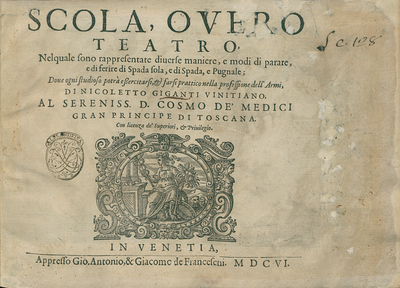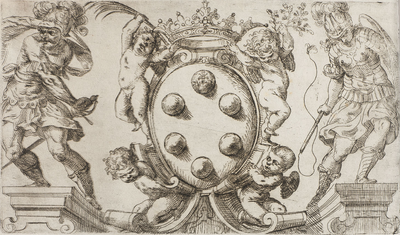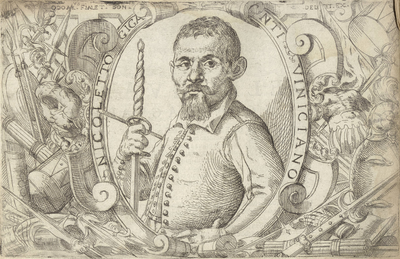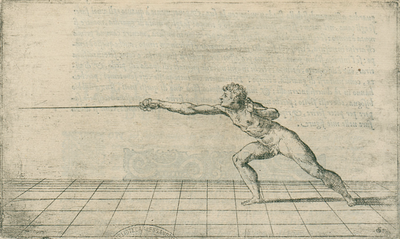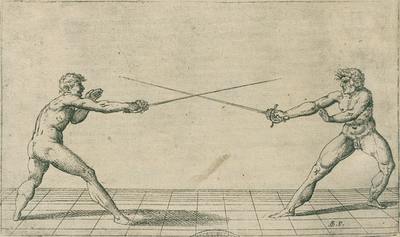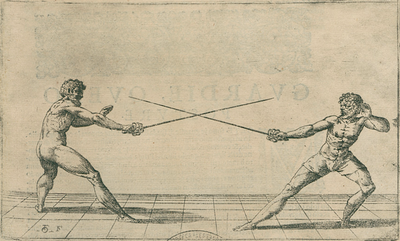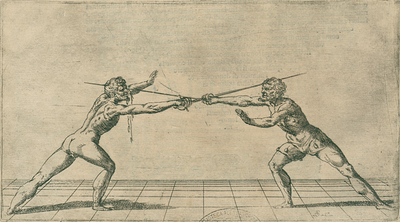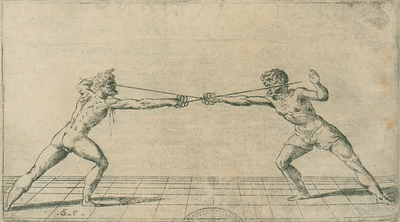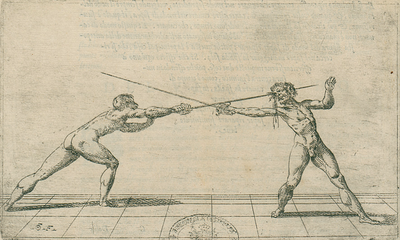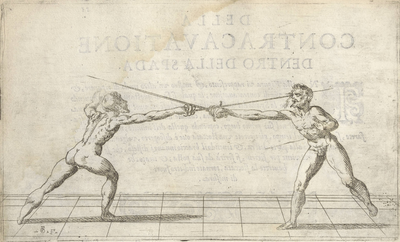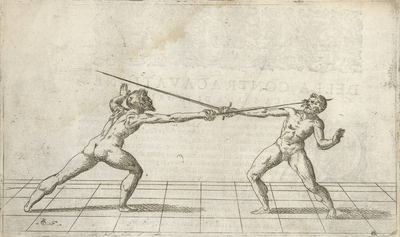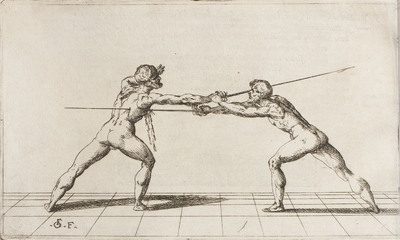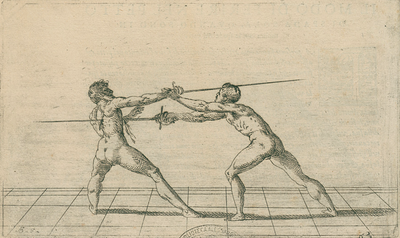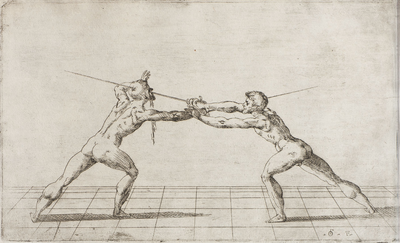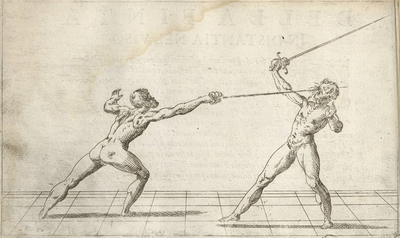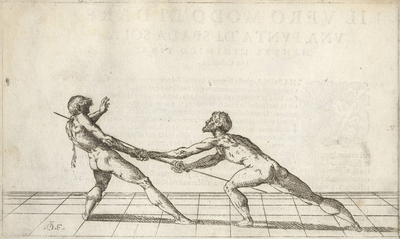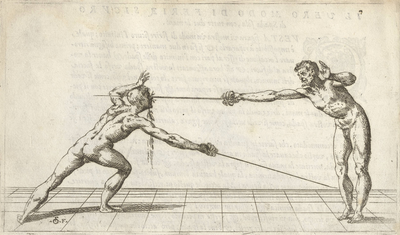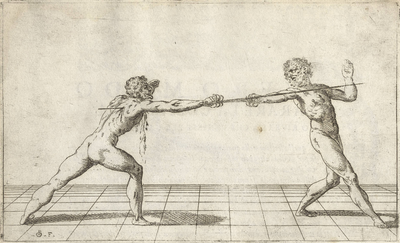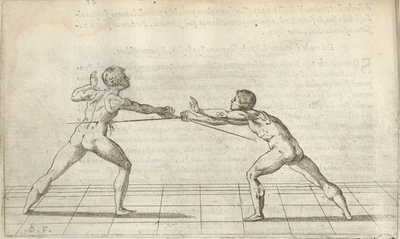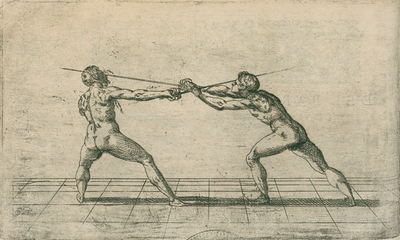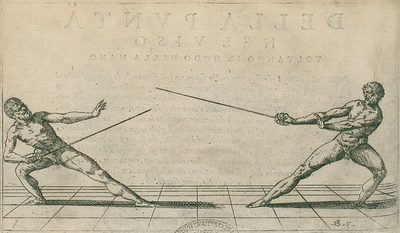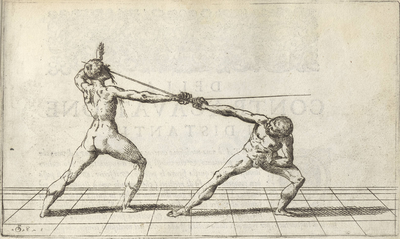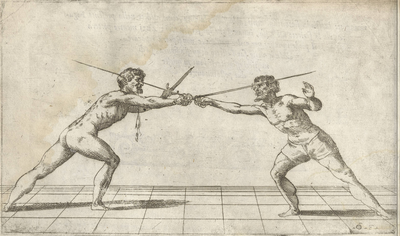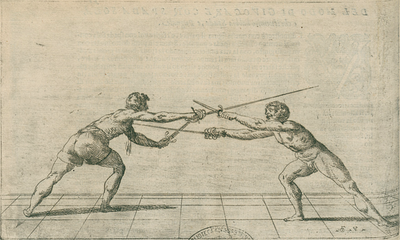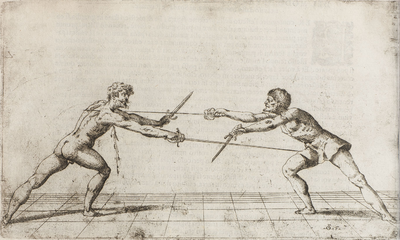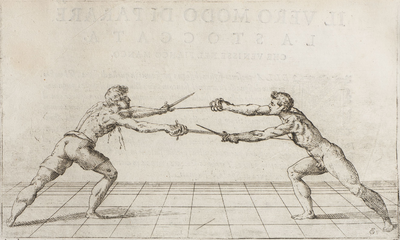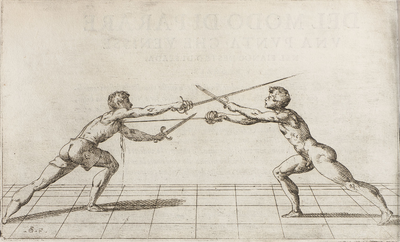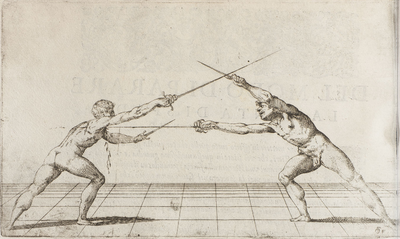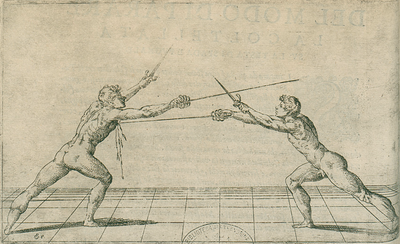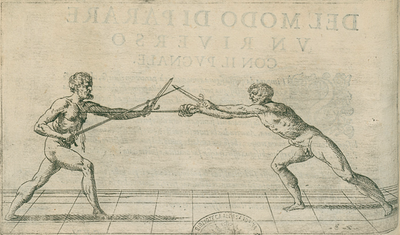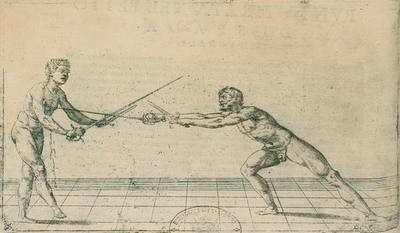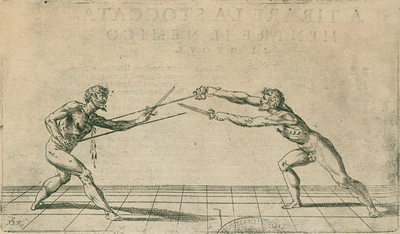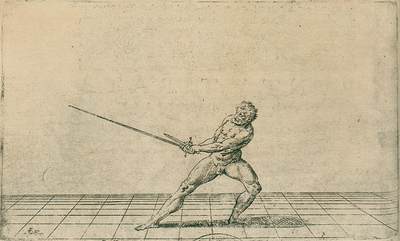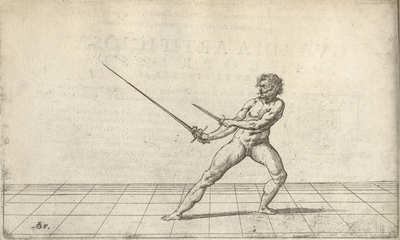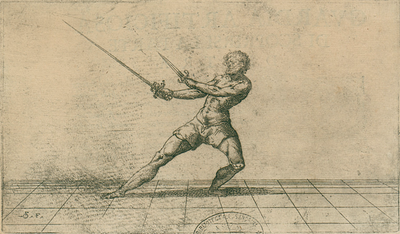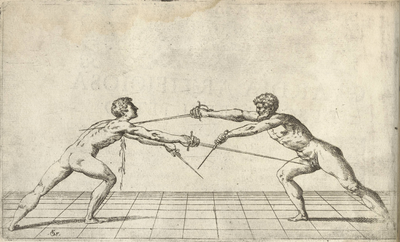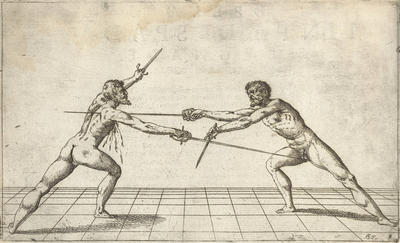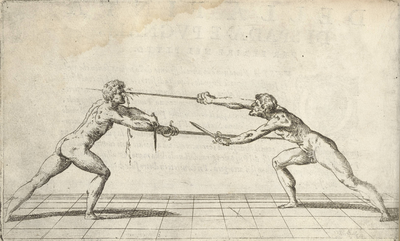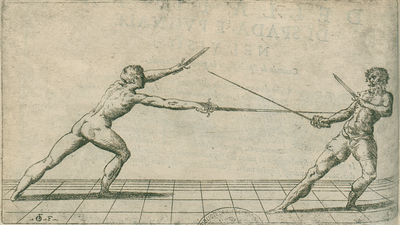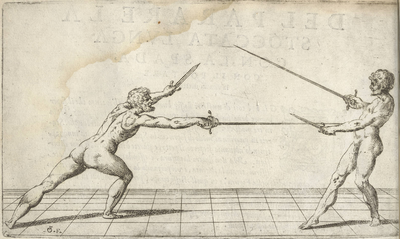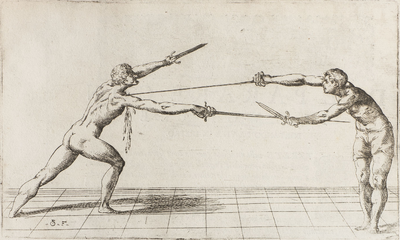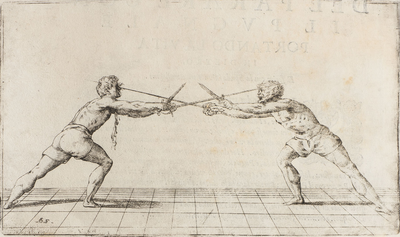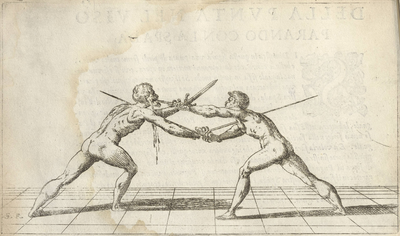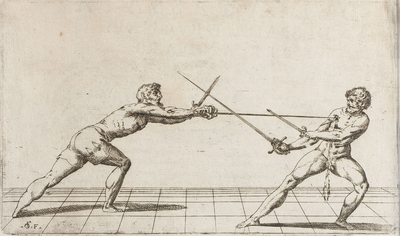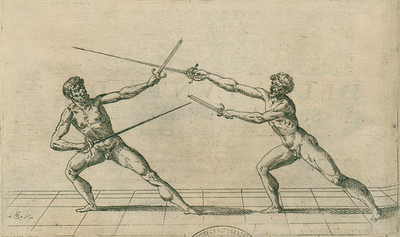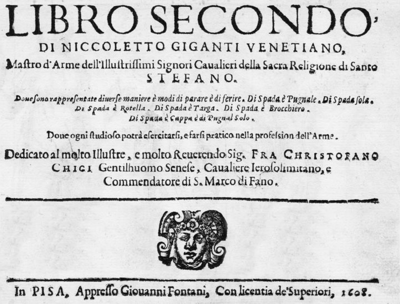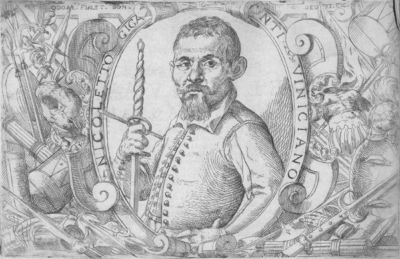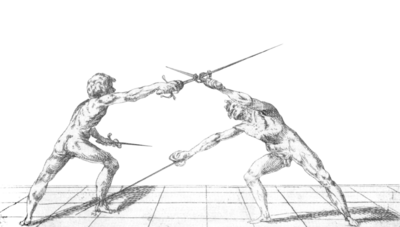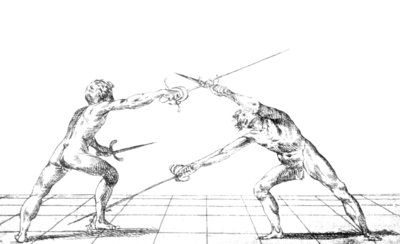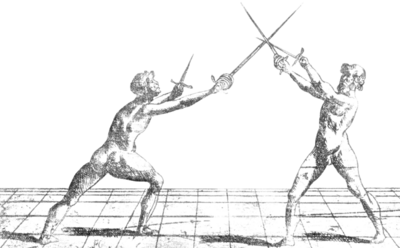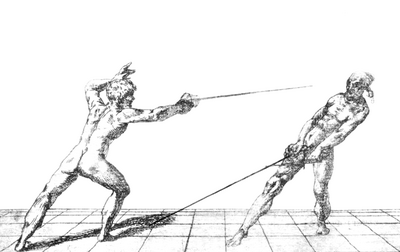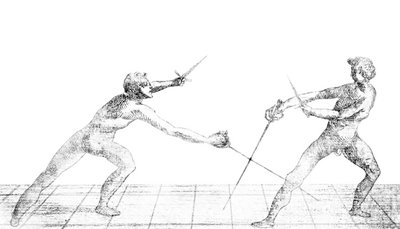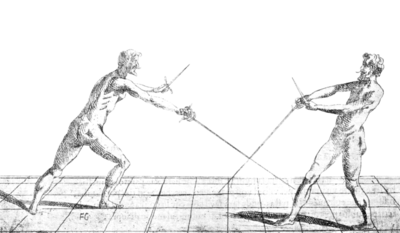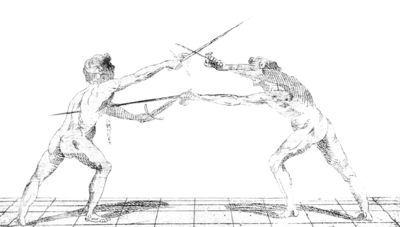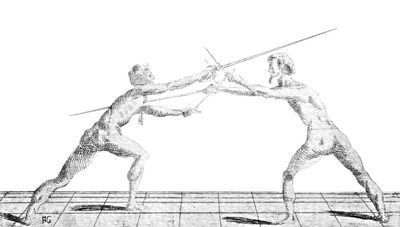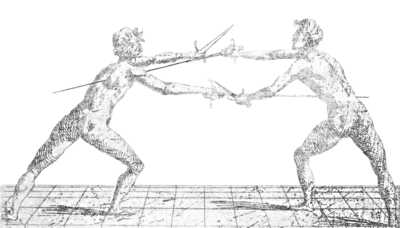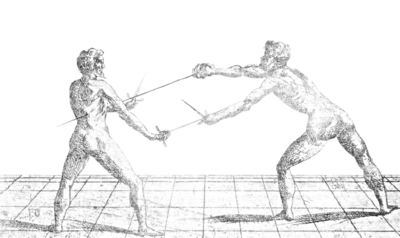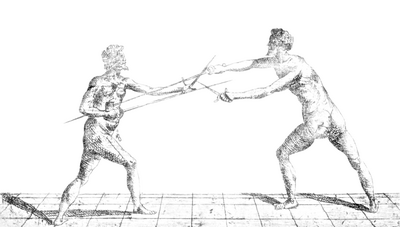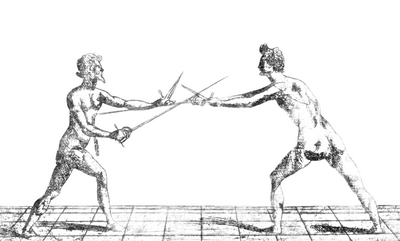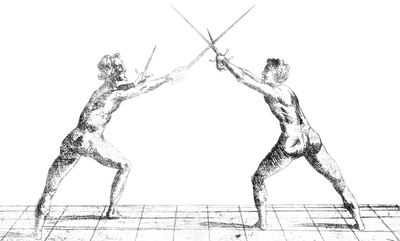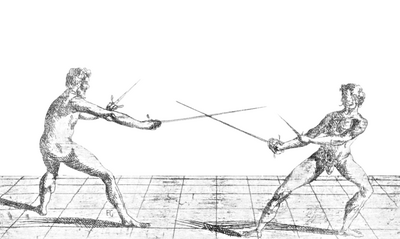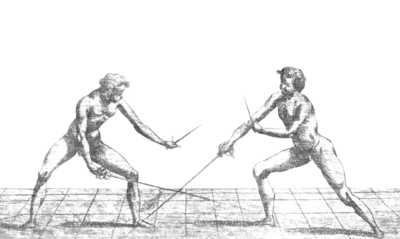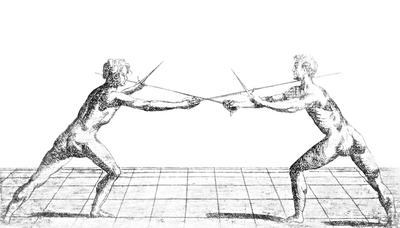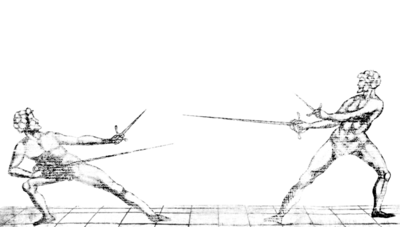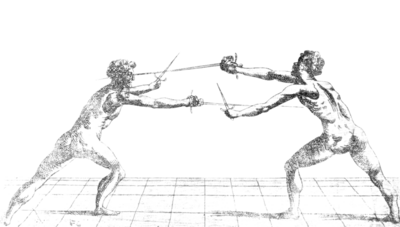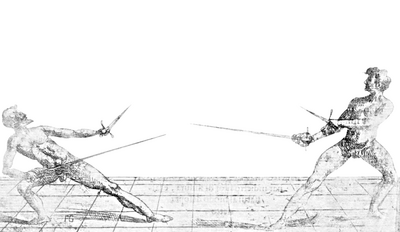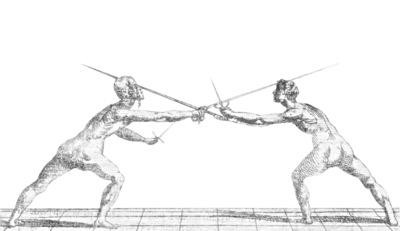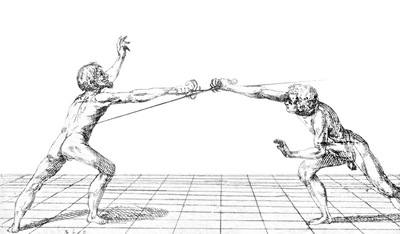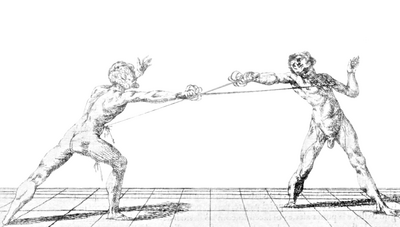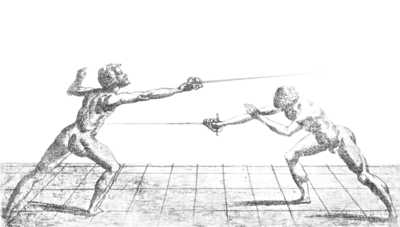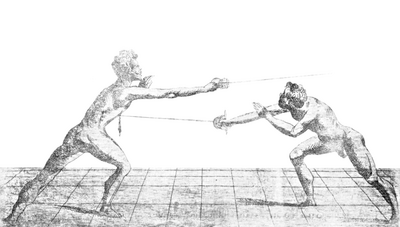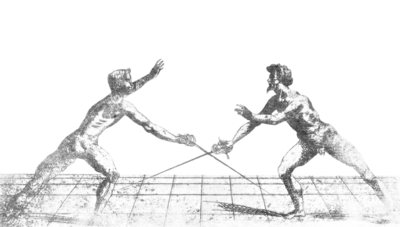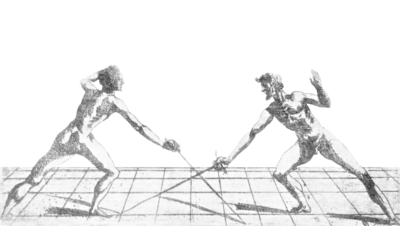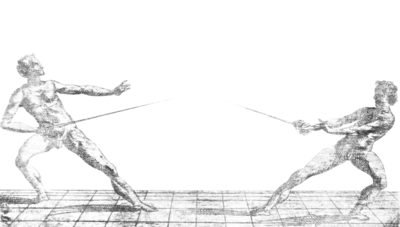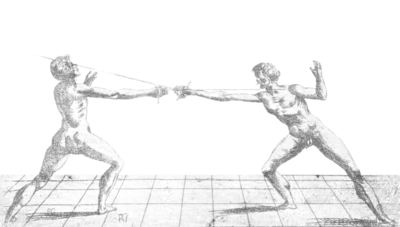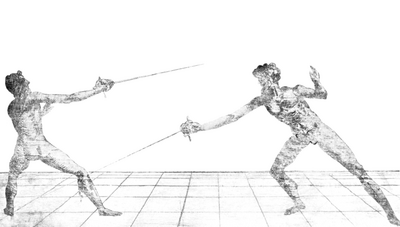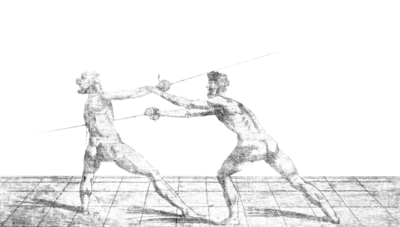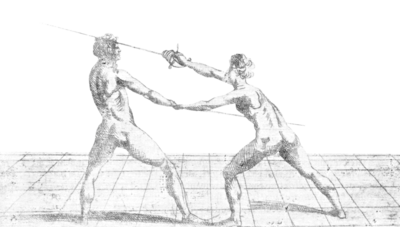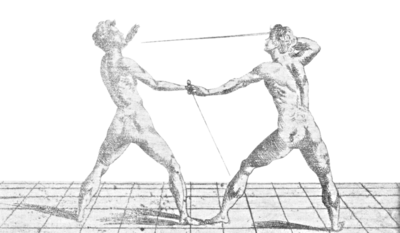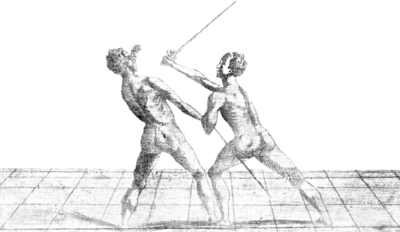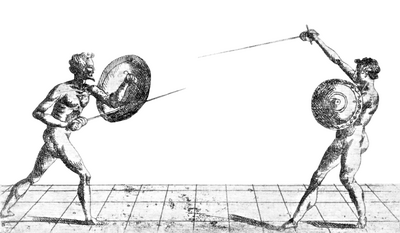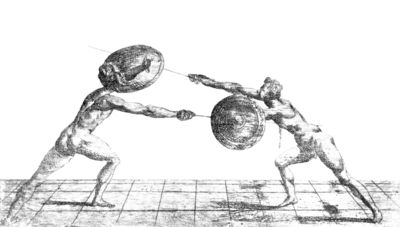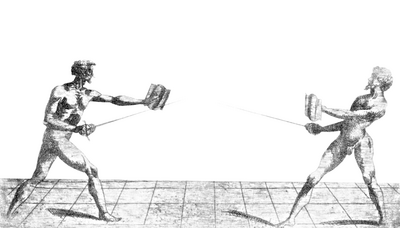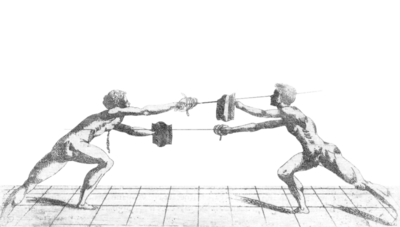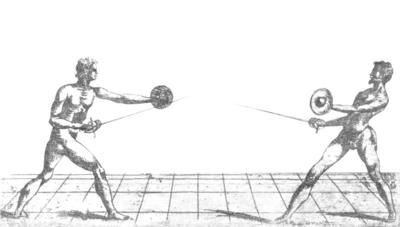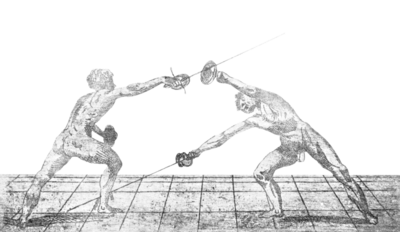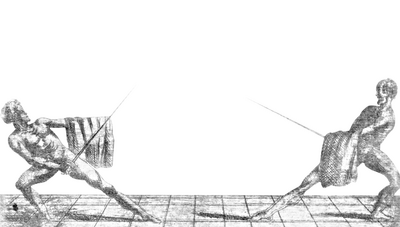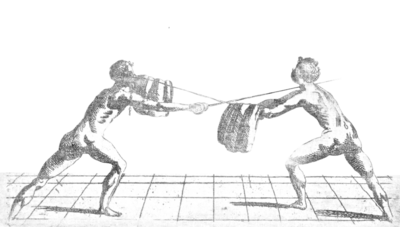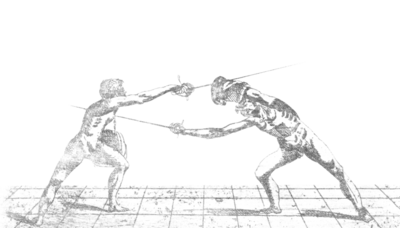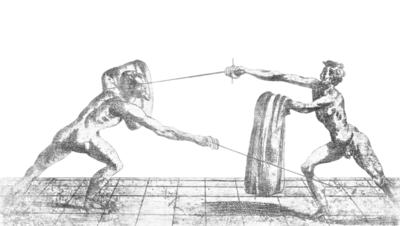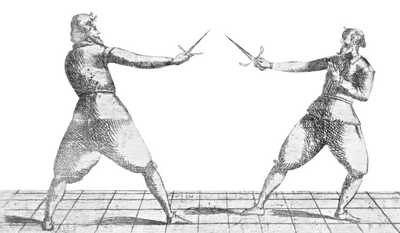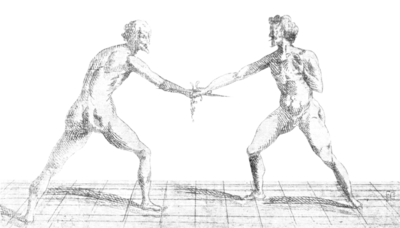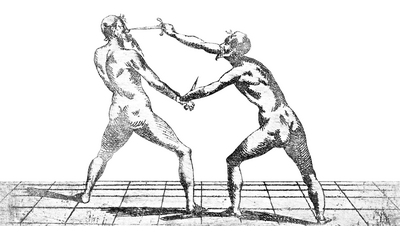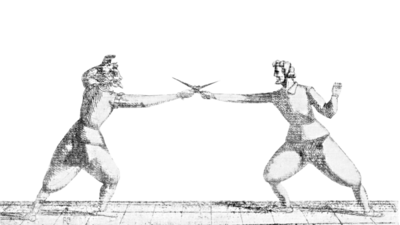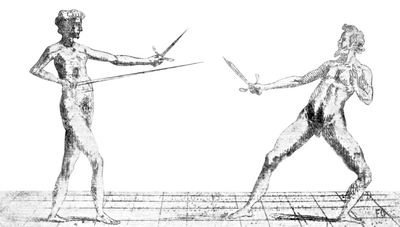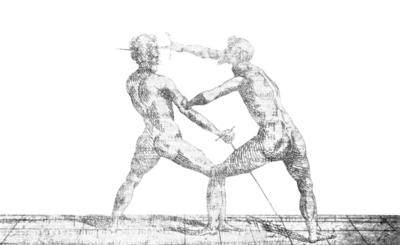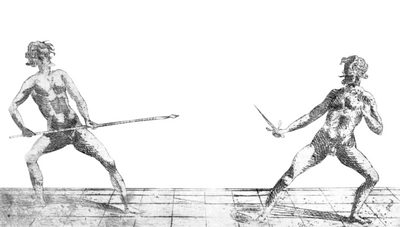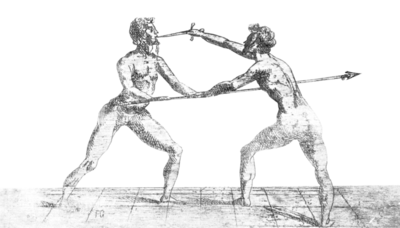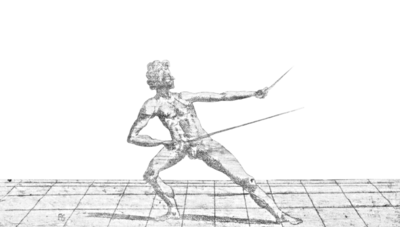|
|
You are not currently logged in. Are you accessing the unsecure (http) portal? Click here to switch to the secure portal. |
Nicoletto Giganti
Treatise
Giganti, like many 17th century authors, had a tendency to write incredibly long, multi-page paragraphs which quickly become hard to follow. Jacob de Zeter's 1619 dual-language edition often breaks these up into more manageable chunks, and so his version is used as the template for these concordances.
A copy of the 1628 printing of the first book that was extensively annotated by a contemporary reader now resides in the Österreichische Nationalbibliothek. Its annotations are beyond the scope of this concordance, but they have been transcribed by Julian Schrattenecker and Florian Fortner, and incorporated into Jeff Vansteenkiste's translation in a separate document.
First Book
Dedication
Illustrations |
First Edition (1606) [edit] |
German Translation (1619) [edit] |
French Translation (1619) [edit] | |
|---|---|---|---|---|
School, or Theatre In which different manners and methods of parrying and wounding with the single sword and sword and dagger are represented; Where every scholar will be able to exercise and become practised in the profession of arms |
[i] SCOLA, OVERO TEATRO, Nelquale sono rappresentate diverse maniere, e modi di parare, e di ferire di Spada sola, e di Spada, e Pugnale; Dove ogni studioso potrà essercitarsi, & farsi prattico nella professione dell’Armi, |
[ii] Newe Fechtkunst Oder Schawplatz, darauff allerhand Arten zuversetzen vnd zuschlagen mit dem Rapier allein, vnd mit dem Rapier vnd Dolchen zusamen, vorgestellet, vnd mit Kupfferstücken erklehret. Allen Liebhabern dieser Adelichen Kunst erstlich in Jtalianischer Sprache publiciret |
[ii] Escrime Novvelle OV THEATRE, AVQVEL SONT REPRESENTEES DIVERSES MANIERES DE PARER ÉT DE FRAPER D'ESPEE SEVLE, ET D’ESPEE BT POIGNARD ensemble, demonstrees par figures entaillees en cuiure. Publié EN FAVEVR DE CEVLX QVI SE DELECTENT EN CE tresnobli exercice des armes. | |
By Nicoletto Giganti, Venetian, To the Most Serene Don Cosimo de’ Medici, Great Prince of Tuscany' |
DI NICOLETTO GIGANTI VINITIANO, AL SERENISS. D. COSMO DE’ MEDICI GRAN PRINCIPE DI TOSCANA. |
Durch Nicolottum Giganti von Venedig. |
PAR NICOLOT GIGANTI VENETIEN; | |
Jetzunder in vnsere Teutsche Sprache vbersetzet Durch Jacob de Zeter. |
ET TRADVICT EN LANGVE FRANCOISE PAR IACQVES DE ZETER. | |||
With license and privilege of the Superiors In Venice, |
Con licenza de’ Superiori, & Privilegio. IN VENETIA, |
FRANCOFVRTI |
Frankcofurti | |
To the Most Serene Don Cosimo de Medici, Great Prince of Tuscany, my only Lord Just as iron extracted from the rough mines would be useless had it not received shape suited to human armies from industrious art, thus the same in the hands of the strong soldier can be of little profit if, accompanied by studious and wise valour, the way is not made clear for every difficult and triumphant success. In this way to a point, since the Good Shepherd welcomes the operation, and because almost all the noblest things proceeding from our actions receive appropriate material from His hands which, refined and dignified by the industry of the spirit, achieve miraculous and powerful effects. I am stunned to silence now that this tempering is wonderfully displayed in the excellence and illustrious greatness of Your Most Serene Highness. You retain the natural greatness returned to its peak from the invincible glorious works of Your ancestors, not only in the ancient and royal histories, but reflecting all the light of the present and past splendour in yourself, adorning them with your own virtues so that everyone admires that most divine temper, and with wonderment says that such a Most Serene Lord is no less fitting to that Most Serene State than such a Most Serene State to that Most Serene Lord. However, I will merely say that just as this proposition is demonstrated clearly in all the arts, so it is perceived evidently in exercising arms. Discussing the strength of steel, even if it is employed by a strong arm and agile body, if it is not conferred with observed rules and exercised study, it is shown to be perilous and of little valour, whereas if the art can be recognized as a wise captain and obeyed as a bold minister, they make marvelous prowess of it. Your testament serves as a clear example to us in which Heaven, needing to grant every level of perfect quality, as in the most complete illumination of the present age, has in the noblest proportion of stature, puissance, and vigour joined agility, promptness, and strength in order to draw with its highest ingenuity the finesse of industry, advice, time, and art that is able to make a Most Complete and Illustrious Captain a Most Serene and Singular Prince. |
[iii] AL SERENISSIMO DON COSMO DE’ MEDICI GRAN PRINCIPE DI TOSCANA unico mio Signore. SI come il ferro dalle rigide minere sotratto inutile riuscirebbe, se dall’arte industre non riceveste forma accommodata a gli essercitii humani: Così l’istesso nelle mani del forte soldato riesce di poco frutto, se da studioso, & accorto valore accompagnato non s’apre la strada ad ogni difficile, & vittorioso successo. In questo modo a punto, perche, l’eterno fattore si compiace di operare. Perche [iv] quasi tutte le più nobil cose, procedenti da gli effetti nostri ricevono accomodata materia dalle sue mani, la quale poi raffinata, & illustrata dall’industria dell’animo fà riuscire effetti mirabili, e postenti. Taccio hora che questo temperamento meravigliosamente si dimostri nell’Eccelse, & illustri grandezze di Vostra Altezza Sereniss. la quale, non solo nelli antichi, & regii annali tiene le naturali grandezze ridotte al colmo da invitte opre gloriose de gli Avi suoi, ma in se stessa reflettendo tutto il lume del presente, & del passato splendore così gli adorna con le proprie virtudi , che ogn’un ammira le divinissime tempre, & con stupore dice non meno convenirsi tal Sereniss. Signore a quel Sereniss. Stato, che tal Serenissimo Stato a quel Serenissimo Signore: Ma dirò solo, che il detto proposto, si come in tutte le arti si dimostra chiaro; così si scerne evidentemente nell’armeggiare, & trattar la forza del ferro, il quale benche da forte braccio, & agil corpo sia essercitato, se però con osservate regole, & essercitato studio non vien accordato, e periglioso si mostra, e di poco valore: Ove, che se la possa riconosce l’arte per duce accorta, e le obedisce come ministra ardita, ne riescono meravigliose prodezze. Ci serve per essempio chiaro il testimonio di lei, nella qual dovendo il Ciel accordare ogni colmo di perfetta qualità come in compitissimo lume dell’età presente, hà in nobilissima proportione di statura, di poderosità, di fangue congionta l’agilità, la prontezza, la forza, per trarne con l’altissimo ingegno suo la finezza dell’industria, [v] dell’aviso, del tempo, e dell’arte, che possono far compitissimo & Illustrissimo Capitano un Serenissimo, & singolarissimo Principe. |
|||
Wherefore I, recognizing and admiring with humblest affection the mature splendour of Your young and happy years, and reading in the face of the world the secure hopes and fruits of the future age, adoring that hand from which Italy and the entire world is taking safe rest and glorious protection, to that I offer and consecrate with humble dedication this small, I will certainly not say fruit, but work, of my labours, that will, therefore, have to please You, being on a subject You enjoy. In that, it will be dignified to bend Your Most Serene eye in order that many of your highest rays pass over where the baseness of my ingenuity with the exercise of this art that I have dealt with for twenty-seven years does not arrive. Let this work, humble in of itself, present itself happily to the view of the World. It will be effected with the action of my devotion, together with the fruit of your Most Serene mercy, who serving being the full glory, I pray that Heaven makes me a worthy, even lowest servant. In Venice February 10, 1606.
|
Onde io riconoscendo, & ammirando con humilissimo affetto il maturo splendore de gli freschi, & felici anni suoi; & legendo nella fronte del mondo le sicure speranze, & frutti dell’età futura; Adorando quella mano dalla quale l’Italia, e il Mondo tutto, è per prender sicuro riposo, e gloriosa protettione; a quella porgo, e consacro con humil dedicatione questo poco non dirò già frutto, ma fatica delle mie fatiche, che perciò solo le doverà gradire, essendo di materia da lei gradita; Nel quale si degnerà piegar l’occhio suo Serenissimo, acciò , ove la bassezza del mio ingegno con l’esercitio di quest’arte, che per anni 27. vò trattando, non arriva; trapassi tanti del suo altissimo raggio, che facci comparire l’opra in se humile, felicemente alla vista del Mondo; & sarà insieme effetto della mia devotione, & frutto della Sereniss. benignità sua, Alla qual essendo somma gloria il servire, pregherò il Cielo che mi facci degno, benche infimo servitore. Di Venetia a’ 10. Febraro 1606.
|
Introduction
Illustrations |
First Edition (1606) [edit] |
German Translation (1619) [edit] |
French Translation (1619) [edit] | |
|---|---|---|---|---|
To the Lord Readers, Almoro Lombardo, Son of the Most Renowned Lord Marco. Desiring to write on the subject of arms, although the author does not mention that it is a science, to me it appears a necessary thing, Lord Readers, to treat with what share it has, and of which name it should be adorned so that everyone knows its greatness, dignity, and privilege. Thus, before any scholar of this most noble science reads and discusses the most learned and easy observations of the valorous and knowledgeable expert, Nicoletto Giganti, in order to observe the rule and general precept of a person who wants to address anything, I will come to the definition and then to the general division of this word “science”. From these two things it will finally be recognized by everyone that this beautiful profession shows us it is a science. Science, therefore, is a certain and manifest knowledge of things that the intellect acquires. It is of two sorts—that is, speculative and practical. Speculative is a simple operation of the intellect around its appropriate object. Practical only consists in actual workings of the intellect. Speculative is divided in two parts—that is, in real speculative and rational speculative. Real aims at the reality of its object, which shows its essence on its exterior. Rational consists in those things that only the intellect administers and does not extend itself further to other goals. |
[vii] ALLI SIG. LETTORI, ALMORO LOMBARDO fù del Clarissimo Signor Marco. VOLENDOSI scrivere nella meteria dell’armi, benche l’auttore non facci mentione, che scentia ella si sia, pur à me pare cosa necessaria, ò Signori Lettori di trattare che parte ella habbia, & di qual nome ella s’adorni, & ciò perche ciascuno conosca quale sia la grandezza, la dignità & il privilegio suo. La onde prima che alcuno studioso di questa nobilissima scienza legga, & discorra le dottissime, e facilissime osservationi di questo valoroso, & intendente professore Nicoletto Gigantil io per osservare la regola, & il precetto generale di chi vuole trattare di cosa alcuna, verrò alla diffinitione, & poi alla divisione generale di questa voce Scienza, dalle quali due cose finalmente potrà venire in consideratione à ciascuno, che scienza questa bella professione ci mostri. La Scienza adunque è una certa, & manifesta cognitione delle cose, che l’intelletto acquista: & questa è di due sorti, cioè Speculativa, & Prattica. La Speculativa è una semplice operatione dell’intelletto circa il suo proprio oggetto. La Prattica solo consiste nelle attuali operationi dell’intelletto. La Speculativa si divide in due parti, cioè in Speculativa reale, & in Speculativa rationale. La reale mira alla realtà dell’oggetto suo, il quale dimo- [viii] stra nell’esteriore l’essentia sua. La rationale consiste intorno à quelle cose, che solo l’intelletto gli somministra, nè più in oltre vuole, che l’esser suo s’estenda. |
[iii] Almorus Lompardus dem günstigen Leser. Gvnstiger lieber Leser, ob schon der Autor so sich von Vbung der Waffen zuschreiben vnderstanden, nicht anzeigt was es für eine Scientia oder Wissenschafft sey, so hab ich es gleichwol für eine notthurfft angesehen, daß etwas davon gesagt würde, darauß jederman berichtet würde, in was Würden sie zu halten, wie hoch sie zu achten, vnd mit was Priuilegien sie begabet vnd gezieret sey. Damit derhalben die Liebhaber dieser Adelichen Kunst etwas davon wissen, ehe sie zu diesen nützlichen und leichten Lectionen vnseres dapferen vnd wol versuchten Nicolotti Gigantis kommen, habe ich diesen geringen Discurs darvber wöllen anstellen, vnd damit die allgemeine Reguln vnd præcepta, darauff die sehen müssen, so ordentlich von etwas schreiben wöllen, in acht genommen werden, will ich an der Definition anfangen, davon ich auff die general Diuision des Wortes Scientie wil komme̅: auß welchen beyden Puncten man desto leichter wird vernehmen können, was vns in dieser löblichen Scientia wird fürgestellet. Es ist aber die Scientia eine gewisse Wissenschafft deren dingen die man mit dem Verstand begriffen hat, vnd wird in zweyerley sorten abgetheilet, nemlich in Speculatiua̅ und Practicam, die Speculatiua ist eine gemeine Operation des Verstandes, nach seine̅ eigne̅ obiecto. Die practica aber bestehet in de̅ wircklichen operationibus des Verstands. Die Speculatiua wird in zwey Theil getheilet: nemlich in Speculatiuam Realem, vnd in Speculatiuam Rationalem. Die Realis sihet auff die Eigenschafft ihres obiecti, welches sein Wesen eusserlich erzeiget. Die Rationalis gehet mit denen dingen vmb, welche ihr von dem Verstand werden vorgebracht, vnnd gehen nicht weiter als sich derselbigen wesen erstrecket. |
[iii] A’more Lombard au Lecteur. AMy Lecteur, combien que l’Auteur, voulant escrire de l’exercice des armes, ne fait aulcune mention quelle science c’est, si m’a il semblé vne chose necessaire d’en dire quelque chose, & monstrer quelle est sa dignité, & de quel nom elle est ornée, afin qu’vn chascun cognoiste quelle est sa grãdeur, sa dignité, & le priuilege d’icelle. Dont desuãt que les amateurs de ceste tant noble fcicnce, deuant de discourrir & l’exercer es tresdoctes & tresfaciles leçons de ce valeureux & bien experimenté professeur d’icelle Nicolot Giganti, en soyent aduertis, j’en ay voulu faire quelque petit discours. Et pour obseruer la reigle & les preceptes generaulx de ceulx, qui vueillent traicter de quelque chose, ie commenceray de la definition, & de là viendray à la diuision generale du mot de science, desquelles deux choses on viendrà tant plus facilement à la consideration de ce, qu’en ceste belle science nous est proposé Or la science est vne certaine & manifeste cognoissance des choses acquises par l’entendement. Et ceste est de deux soites, ascauoir speculariue & practique. La speculatiue est vne simple operation de l’entendement, selon son propre obiect. La practique consistees operations actuelles de l’entendement. La speculatiue est diuisée en deux parties, ascauoir en speculatiue reele, & en speculatiue rationele. La reele regarde la realiré de son obiect, lequel monstre son essence à l’exterieur. La rationele est empeschée à l’entour de ces choses qui luy sont subministrees par l’entendement, & ne passe plus oultre que son estre s’estend. | |
Physics is a real speculative science that only aims at moving and natural things, like the elements. Mathematics is a real speculative science that only extends as far as the continuous and the discrete—continuous such as lines, circles, surfaces—the measures of which arithmetic deals with. Grammar, rhetoric, poetry, and logic are rational speculative sciences. |
La Fisica è una scienza reale speculativa, che solo mira alle cose mobili, e naturali, come à gli elementi. La matematica è una scienza Speculativa reale, che solo estende l’esser suo in quanto continuo e discreto; continuo come intorno alle linee, à i circoli, alle superficie; & le misure di questa tratta l’Arithmetica. La Grammatica, la Retorica, la Poesia, la Logica sono scienze speculative rationali. |
Die Physica ist eine Scientia Realis speculatiua, als welche allein auff bewegliche vnd natürliche ding sihet: Als auff die Elementa. Die Mathematica ist auch eine Scientia Realis speculatiua, welche auff die quantitates continuas oder discretas sihet. Die quantitates continuæ seynd die linee, circuli vn̅ superficies, deren Messungen durch die Arithmeticam gezeiget werden. Die Grammatica, Rhethorica, Poesis, Logica & c. seynd auch Scientiæ speculatiuæ reales. |
La Physique est vne sciẽce reele speculatiue, qui ne regarde qu’aux choses mobiles & narurelles, comme aux Elements. La Mathematique aussi est vne science speculatiue reele, laquelle est empeschée es quantitez ou cõtinues ou discretes. Les continues sont les lignes, cercles, & superficis, dont les mesures sont traictees par l’Arithmetique. La Grãmatique, Rhetorique, Poesie, Logique &c. sont sciẽces speculatiues rationeles. | |
Practical science is further divided in two: active and productive. Ethics, politics, and economics are active. Productive can be separated into seven others, called mechanical, which are woolcraft, agriculture, soldiery, navigation, medicine, hunting, and metalworking. |
La Scientia prattica, si divide ancor ella in due, in Attiva, e Fattiva; Attiva è l’Etica, la Politica, e l’Economica; la Fattiva poi si divide in sette altre, le quali si chiamano mechaniche, e sono queste il Lanificio, l’Agricoltura, il Soldato mercenario, la Navigatione, la Medicina, la Caccia, e l’arte Fabrile. |
Die Scientia Practica wird auch in zwey getheilet: nemlich in Actiuam, vnnd Factiuam, die Actiua begreifft die Ethicam, Polytciam, vnd Oeconomicam. Die Factiua wird in sieben andere getheilet, so Mechanice genennet weren: nemlich, das Wollwerck, Ackerbaw, Kriegswesen, in betrachtung der besoldeten Soldaten, die Schiffahrt, die Artzney, die Jagt, und die Zimmerkunst. |
La sciẽce pratique est aussi diuisée en deux, ascauoir l’Actiue & la Factiue. L’Actiue cõprend l’Ethique, la Politique & l’Oeconomique. La Factiue est diuisée en sept aultres, nommees Mechaniques, ascauoir ??? anifice, l’Agriculture, la Milice, pour le regard du soldat mercenaire, la Nauigation, la Medicine, la Chasse, & l’art fabrile. | |
Now, in order to come to what I promised above about this noble science, I will go over its qualities and nature, discussing whether it is speculative or practical science. I say that, in my opinion, it is speculative, and prove it with diverse reasons. There is no doubt that it is science because it is not acquired if not through the operation of the intellect, from which it springs. That it is speculative is certain, as it does not consist in more than the simple knowledge of its object, as I will further demonstrate below. The object of this science is nothing more than parrying and wounding. The knowledge of those two things is a work of the intellect, and experts of this science do not with intelligence extend it further than the knowledge of them. They cannot be understood at all unless one first has knowledge of tempi and measures, nor feints, disengages, or resolutions without knowledge of tempi and measures. These are all operations of the intellect. Moreover, the intellect does not reach beyond this understanding because, as I have said, the aim of this profession is understanding parrying and wounding. We will see whether it is real speculative or rational speculative science, however. Thinking on this, it cannot be rational, and the reason is this: Even though it is an operation of the intellect, it nevertheless extends further, wherefore I find it to be real speculative science. Real, because the knowledge of its aim is shown to us outwardly by the intellect, since the understanding of wounding and parrying, along with tempi, measures, feints, disengages, and resolutions, despite being operations of the intellect, cannot be understood if outwardly. This outward expression consists in the bearing of the body and sword in the guards and counterguards, which all consist of circles, angles, lines, surfaces, measures, and of numbers. These things, which must be observed, can be read about in Camillo Agrippa and in many other experts of this science. Note that, just as those operations of the intellect without an exterior operation cannot be shown, so these exterior operations cannot be understood without the prior operations of the intellect, in a way that this science, which derives from the intellect, cannot be understood if not outwardly. Neither can it be outwardly understood without operations of the intellect. These operations seek to understand the greatness, excellence, and perfection of this profession, and will always be seen united. As there will never be sun without day, nor day without sun, never will there be those without these, nor these without those. In the end we see that it is real speculative science. This science of the sword, or of arms, is a real speculative mathematical science—of geometry, and arithmetic. Of geometry because it consists in lines, circles, angles, surfaces, and measures, and of arithmetic because it consists in numbers. There is no motion of the body that does not produce an angle or constraint, no motion of the sword that does not travel in a line, no guard or counterguard that does not proceed by number. The observations of these things all depend on knowledge of tempi and measures, whence I conclude that this most noble science is speculative real mathematical—of geometry and arithmetic—as I said a little above. |
Hora per venire a quello c’ho di sopra promesso circa a questa nobil scienza, andrò sopra le qualità, e la natura sua discorrendo, cioè s’ella sia scientia Speculativa, o Prattica. Io per opinione mia dico, & lo provo con diverse ragioni ch’ella è Speculativa. Et che sii scienza non v’è dubio alcuno, perche questa non s’acquista se non mediante l’operatione dell’intelletto, dalla quale essa nasce; ch’ella sia Speculativa è cosa certa poiche non tonsiste in altro, che nella semplice cognitione dell’oggetto suo, come andrò mostrando più a basso: Et l’oggetto di questa scienza altro non è, che il riparare, & il ferire; il saper delle quali due cose, è opera dell’intelletto; nè il professore di questa scienza più in oltre s’estende con l’ingegno, che nella cognitione di queste due cose, lequali non potrà alcuno sapere se prima non havrà la cognitione de’ tempi, e delle misure, ò di Finte, ò di Cavatione, ò di risolutioni senza cognitione de’ tempi, e delle misure, & queste sono tutte operationi dell’intelletto, & fuori di questa cognitione l’intelletto non s’estende più in oltre; perche come ho detto il fine di queste professione è saper riparare; ma vediamo s’ella sÿ speculativa reale, ò speculativa rationale. Io vado considerando, che rationale non può essere, & la ragione è que- [ix] sta, perche se ben ella è operatione dell’intelletto; nondimeno più in oltre si diffonde; perilche trovo ella esser speculativa reale. Reale, perche la cognitione del suo fine ci vien mostrata dall’intelletto esteriormente; poiche il saper ferire, & il saper riparare con i tempi, con le misure, finte, cavationi, e risolutioni, benche siano operationi dell’intelletto, non perciò si possono conoscere, se non esteriormente, e questo esteriore consiste nel portamento del corpo, & della Spada nelle guardie, e nelle contraguardie, ilche tutto consiste ne i circoli, negli angoli, nelle linee, nelle superficie, nelle misure, e ne i numeri; lequali cose, come che s’habbino à osservare, si potrà leggere in Camillo Agrippa, & in molti altri professori di questa scienza. Ma notate, che si come quelle operationi dell’intelletto senza una operatione esteriore non si possono mostrare: così queste operationi esteriori non si possono conoscere senza le prime operationi dell’intelletto, in maniera che questa scienza non si può conoscere, che derivi dall’intelletto, se non esteriormente; nè si può conoscere esteriormente senza operatione dell’intelletto, le quali operationi à voler conoscere la grandezza, eccellenza, e perfettione di questa professione, sempre si vedranno unite; e come non sarà mai Sole senza giorno, nè giorno senza Sole, non saranno mai quelle senza queste, nè queste senza quelle. Resta che noi vediamo, che scienza Speculativa reale ella sia. Questa scienza della Spada, ò dell’armi, è una scienza Speculativa real Mathematica, & è di Geometria, & Arithmetica; di Geometria perche consiste in linee, circoli, angoli, superficie, e misure. Di Arithmetica, perche consiste in numeri; non è moto del corpo, che non facci angolo, o vincolo; non è moto della Spada, che non camini per linea; non è guardia, nè contraguardia, che non vadi per numero; l’osservationi delle quali cose tutte dipendono dalla cognitione de’ tempi, e delle misure; onde concludo, che questa nobilissima scienza sia Speculativa reale Mathematica, di Geometria, & Arithmetica, come poco di sopra hò detto. |
Damit ich nun zu dem komme so ich droben von dieser Adelichen Wissenschaft versprochen, will ich von deroselbigen quali- [iv] tet vnd Natur discurriren, vnd zeigen ob sie eine Scientia Speculatiua, oder Practica sey, vnd auff daß ichs kurtz mache, sage ich, vnnd beweise es auch mit vnderschiedlichen gründen daß sie eine Scientia Speculatiua sey. Dann daß es eine Scientia, ist ausser allem zweiffel, dieweil sie allein durch die Operation des Verstandes wird zu wegen gebracht, als auß welcher sie hero rühret und entspringet. Daß sie eine Speculatiua ist auch gewiß, sintemahl sie nur in einer simplici vnd schlechten Wissenschaft ihres obiecti bestehet, wie hernachmahls mit mehrernsoll erwisen werden. Es ist aber das obiectum dieser Scientæ nit anders, als daß man wisse mit Vortheil zu schlagen vn̅ zuversetzen, welche Wissenschaft eine Wirkung ist des Verstands. Vnd gehet der Professor dieser Scientiæ nicht weiter als auff die Wissenschaft dieser zweyer stück, welche niemand kann wissen, wann er sich nicht auff die Zeit vnnd das Maß verstehet, es sey in Ficten, Drähungen des Rapiers, oder in freyen Stössen, welche alle durch den Verstand werden ins werck gerichtet, vn̅ gehet derselbige auch nicht weiter als auff seinen, vorgesetzten Zweck, nemlich daß man wol versetze vnnd schlage. Last vns nun auch besehen ob sie eine Speculatiua Realis, oder Rationalis sey. Allda befind ich daß sie nicht kan eine Speculartiua Rationalis sein. Die Vrsach ist diese, nemlich, daß ob sie schon eine Wirckung des Verstands ist, so erstrecket sie sich doch nicht weiter: Derhalben man muß bekennen daß sie eine Scientia Speculatiua Realis sey. Realis sage ich, dieweil vns die Erkündigung ihres Zwecks eusserlich durch den Verstand gezeiget wird: wie dann die Wissenschafft recht zu schlagen, vnd zu versetzten, mit Zeit und Maß in Ficten, Wendungen, vnd gleichen Stichen, wie wol sie eine Operatio des Verstandes ist, gleich wol nicht anders als eusserlich kann erkennet werden: vnnd besiehet in Stellung vnnd bewegung des Leibs vnnd des Rapiers, wie dann auch in den Huthen vnnd Gegenhuhten: welche es dann mit Circulis, Angulis, Lineis, Superficiebus, Menturis vnd Numeris zuwegen gebracht wird, dauon man, wie sie in acht zunehmen, die Schrifften Camilia Agrippæ vnnd andere so hievon geschrieben, lesen mag. Mercket aber daß wie diese Operationes des Verstandes nit ohne eine eusserliche Wirckung können gezeiget werden: also kann man auch diese eusserliche Wirckung nicht erkennen ohne die erste oder innerliche operation des Verstandes. Also daß man nit erkennen kann, daß diese Scientia von dem Verstand herkomme, als an der eusserlichen Wirckung, vnnd gemelte eusserliche Wirckung kan auch nicht erkennet werden ohne die operation des Verstandes. Welche operationes zur anzeigung der hohen Excellentz vnd Vollkomenheit dieser Profession sich allzeit beyeinander finden lassen: vnd wie man keinen Tag ohne Sonne, vnd keine Sonne ohne Tag findet, also wirdt man auch diese opertiones nimmer von einander geschieden finden. Nun ist noch vberig daß wir auch besehen, vnd welche Sciencias Speculatiuas Reales sie gehöret. Da sage ich weiter, daß sie eine Sc. Spe. Realis sey so zur Mathematica, nemlich der Geometria vnd Arithmetica gehöret. Zur Geometria, dieweil sie mit Lineis, Circulis, Angulis, Superficiebus, vnd Mensuris vmbgehet. Zur Arithmetica, dieweil sie auch ihre gewisse Zahlen hat, vnd ist keine bewegung des Leibs, die nicht einen Angulum oder Circulum mache: auch keine bewe- [v] gung der Waffen, die nicht in einer Linien geschehe. Deßgleichen ist auch keine Huth noch Gegenhuth die nicht ihre Zahlen in sich habe, deren aller betrachtung von der Wissenschaft der Zeit vnd der Mensur herrühret. Dannenhero ich schliesse, daß diese Adeliche Scientia sey Speculatiua Realis, so zur Mathematica nemlich der Geometria vnnd Arithmetica gehöret, wie droben gemeldet worden. |
Or mainrenãt pour venir à ce que dessus i’ay promis, quãt à ceste noble sciẽce j'iray diseourrãt sur sa qualité & nature, pour veoir si elle est science speculatiue ou practique. Et pour estre court, je dis & le preuue par diuertes raisons, qu’elle est vne science speculatiue. D’estre vne science, il l’ya point de doubte, veu qu’elle ne s’acquiert, sinon moyennant l’operanon de l’entendemẽt, de laquelle elle prẽd son origine & naissance. D’estre speculatiue, c’est vne chose asseurée, veu qu’elle ne conliste en aultre chose, qu’en vne simple [iv] cognoissance de son obiect, comme je le monetreray cyapres. Et l’obiect de ceste science n’est aultre chose que le paret & le fraper, la science desquelles choses est vn’oeuure de l’entendement Aussi ne s’estend le professeur de ceste science plus auant, de la cognoissance de ces deux choses, lesquelles nul ne peult scauoir, s’il n’a l’intelligence des temps, & des mesures, foit es feintes, ou es cauations, ou es poinctes resolues, qui toutes sont operations de l’entendement, lequel aussi ne l’estend plus oultre, qu’à sa fin proposée, ascauoir de bien parer & fraper. Mais voyons aussi si elle est speculatiue Reele, ou speculatiue Rationele, le trouue qu’elle ne peult estre rationele. La raison qui m’y conferme est celle cy ascauoir que combien elle est vne operation del’entendement, toutes fois elle l’espand plus auant. Dont il fault confesser qu’elle est speculatiue reele. Reele dis ie, pource que la cognoissance de la fin nous est monstrée à l’exterieur par l’entendement: puis que le scauoir fraper, & le scauoir parer, auec temps, auec mesures, en feintes, en cauations, & en resolutions, combien que ces sont operations de l’entendement, ne se peuuent toutes fois cognoistre qu’à l’exterieur, consistant au portement du corps & de l’espee es gardes & contregardes. Chose qui consiste en cercles, angles, lignes, superficies, mesures, & nõbres, desquelles, cõmẽt elles doibuẽt estre obseruees, on pourrà veoit les escripts de Camille Agrippa, & plusieurs aultres Professeurs de ceste science. Mais notez, que cõme ces operations de l’entẽdemẽt ne se peuuẽt mõstrer sans vne operation exterieure; ainsi ne peult on cognoistre ces operations exterieurs, sans les premieres operations de l’entendement. De forte qu’on ne peult cognoistre que ceste science piouient de l’entendement, sinon à l’exterieur: & l’exterieur derechef ne se peult cognoistre sans l’operation de l’entendement: lesquelles operations, pour monstrer la grandeur, excellence & perfection de ceste profession, se trouueront tousiours conioinctes: & comme iamais on ne verrà Soleil sans iour, ne ioui sans Soleil, ainsi ne seront ces operations separees. Reste que nous voyons de quelle sorte des sciences speculatiues reeles elle soit. Ie dis doncques dauantage, qu’elle est vne science speculatiue Reele, Mathematique, de Geometrie & Arithmetique. De Geometrie, pource qu’elle consiste en lignes, cercles, angles, superficies & mesures. D’Arithmetique, pource qu’elle comprend aussi certains nombres. Et n’y a mouuement de corps, qui ne face angle ou cercle: ne mouuement d’espee, qui ne chemine par ligne: aussi n’y a il garde, ne contregarde, qui ne vaye par nombres: L’obseruation de toutes, lesquelles choses dependẽt de la cognoissance des tẽps, & des mesures. Dontje conclus, que ceste tresnoble science est speculatiue, Reele, Mathematique, de Geometrie & d’Arithmetique, comme il a estè dict dessus. | |
Perhaps some inquisitive person arguing over this could say that the science of arms is a practical science with this reason: Practical science being a science that extends not only to the knowledge of its own object but to its operation, and the science of the sword being a science that applies not just to the knowledge of, but the operation of it, this science is therefore practical and not speculative. To this objection I respond: All things have some operation from nature. Our operations are of three sorts: Some are internal, and these exist in pure and simple intellect and derive from a rational speculative science. Some are internal and external, and these have a commonality inside and outside the intellect and arise from a real speculative science. Some are completely external, and these exist entirely outside the intellect and depend on a practical science. They are either active or productive. Speculative productive real science is no different from practical science other than in this: Real speculative science, even though it operates outwardly in its object, it nevertheless furnishes the understanding of that in the intellect. Practical science not only cannot operate on its object if not outwardly, but also cannot even come to understand it if not outwardly. The science of arms obtains the knowledge of its object in the intellect and, even though it operates outwardly, cannot be said to be practical science. Rather, it is speculative real science. |
Ma potrebbe forse qualche curioso argomentando sopra questa dire, che la scienza dell’- [x] armi fusse una scienza prattica, con questa ragione che essendo la scienza prattica, una scienza laquale non solo s’estendi nella cognitione del suo proprio oggetto, ma nell’operar in esso; & la scienza della Spada essendo una scienza, che non solo versi nella cognitione, ma nell’operatione di essa, che perciò questa scienza è Prattica, e non Speculativa. Alla qual oppositione rispondo; tutte le cose hanno dalla natura qualche operatione. Et trè sono le sorti delle nostre operationi; alcune sono interne, & queste hanno l’esser suo nel puro, e semplice intelletto, e derivano da una rational Speculativa; alcune sono interne, & esterne, & queste hanno una communanza nell’intelletto, e fuori, e nascono da una speculativa reale; alcune sono affatto esterne, e queste hanno l’esser loro fuori dell’intelletto affatto, e dipendono da una scienza prattica, & sono ò attive, ò fattive: la scienza speculativa fattiva reale non è differente dalla scienza Prattica in altro ch’in questo, che la Speculativa reale, se ben opera esteriormente nell’oggetto suo; serva però la cognitione di quello nell’intelletto, e la scienza Prattica, oltre che non può operar se non esteriormente nell’oggetto suo, non può etiam Dio venire alla cognitione di esso se non esteriormente la scienza dell’armi hà la cognitione dell’oggetto suo nell’intelletto, se bene opera esteriormente, non si può dire ch’ella sia Prattica, ma scienza Speculativa reale. |
Hie möchte aber ein Vorwitziger einwenden, daß diese Scientia armoru̅ nach meinen vorangezogenen Gründen, viel eygentlicher eine Scientia Practica zu nennen: Sintemahl ich droben gesagt, daß die Scientia Practica nicht allein sihet auf die Erkündigung ihres eygenen obiecti, sonder auch auf die operation: vnnd dieweil die Wissenschafft das Rapier zu führen, nicht nur auff sich selbst, sondern fürnemlich auff die operation sihet, so folget gewiß daß wann man eygentlich davon will reden, sie eine Scientia Practica vnnd nicht Speculatiua zu nennen. Darauff ich antwort, daß all ding von Natur jhre sonderliche operation haben. Nun seynd aber alle Operationes dreyerley. Dann etliche seynd jnnerlich, vnnd haben jhr Wesen allein im Verstand, vnd kommen von einer Speculatina Rationli her. Etliche seynd jnnerlich vnd eusserlich vnnd haben ihr Wesen beydes jnnerhalb vnd ausserhalb des Verstands, vnd entstehen von einer Speculatiua reali. Etliche seynd allein eusserlich, vnd haben jhr Wesen allein ausserhalb dem Verstand: vnd entstehen auß einer Scientia Practica, seynd auch entweder Actiuæ oder Factiuæ. Die Sc. Spec. Realis Factiua, ist darin von der Practica vnderschieden, daß die Speculatiua realis, wiewol sie eusserlich in jhren obiecto wircket, so behelt sie doch die Wissenschafft desselbigen in jhrem Verstandt: die Scientia Practica aber beneben dem daß sie nur eusserlich in jhren obiecto kan wircken, kan auch nicht anders als eusserlich zur erkündigung desselbigen kommen. Derhalben auch die Scientia armorum, welche die erkündigung jhres obiecti im Verstandt hat, wiewol sie eusserlich wircket, gleichwol nicht kan eine Scientia Practica, sonder muß eine Sciehnia speculatiua realis, genennet werden. |
Mais vn curieux me pourroit respondre là dessus, que la science des armes est plus proprement vne science pratique, par les raisons de moy mesme alleguees dessus, ou je dis, que la science practique non seu- [v] lement s’estend sur la cognoissance de son propre obiect, mais aussi sur son operation: Et la science de l’espee, estant vne science versante non seulement en la cognoissance, mais principalement en l’operation: il s’ensuit, que pour pailer proprement, elle est vne science practique, & non speculatiue. A laquelle obiection je responds, que toutes les choses ont de nature quelque operation. Or toutes nos operations sont de trois sortes. Car quelques vues sont interieures: & celles-cy ont leur estre au pur & simple entendement, & prouienent d’vne speculatiue rationele. Aulcunes sont & interieures & extérieures: & celles-cy ont leur estre, & au de dans & au dehors de l’entendement, & prouienent d’vne speculatiue reele: Aulcunes sont simplement exterieures: & celles-cy ont leur estre seulement au dehors de l’entendement, & dependent d’vne science practique, estants ou actiues ou factiues. La science speculatiue reele factiue n’est differente de la practique, si non que la speculatiue reele, combien qu’elle opere exterieurement en son obiect, reserue toutes fois la cognoissance d’iceluy en l’entendement: Et la science practique, oultre ce qu’elle ne peult operer, sinon exterieurement en son obiect, elle ne peult aussi paruenir à la cognoissance d’iceluy, sinon extetieurement. Dont aussi la science des armes, ayant la cognoissance de son obiect en l’entendement, combien qu’elle opere exrerieurement, ne peult toutes fois estre dicte pratique, ains vne science speculatiue reele. | |
We have therefore seen that it is a science and that it is mathematics—of geometry and arithmetic—since it consists in numbers, lines, and measures. The author does not make mention of this in his observations so that learned persons and those with no study may acquire some profit from him. From these figures and his renowned lessons, therefore, without learning to understand the multiplicity of lines, circles, angles, and surfaces which would instead confuse the mind of the reader that does not understand these studies, giving him no instruction, everyone will without doubt or effort learn to understand tempi, measures, resolutions, feints, disengages, and the method of parrying and wounding. |
Habbiamo adunque veduto che scienza ella si sia, & è Mathematica di Geometria & Arithmetica, perche ella consiste numeri, linee, e misure, delle quali l’auttore non fà mentione nelle osservationi sue, perche da lui le persone dotte, e quelle di nessuno studio qualche frutto acquistano, onde ciascuno dalle presenti figure, e dalle lettioni sue noti, che senza imparare a conoscere la multiplicità delle linee, de’ circoli, de’ angoli, di superficie, le quali più tosto confunderebbono la mente del Lettore, che non havrà la cognitione di questi studÿ, ne gli darebbono ammaestramento alcuno; imparerà a conoscere senza dubbio, e senza fatica i tempi, e le misure, e le rissolutioni, le finte, le cavationi, & il modo di saper riparare, e di saper ferire. |
Haben also erwisen was dieses eigentlich für eine Scientia sey, vnnd daß sie zur Mathematica, nemlich der Geometria vnd Arithmetica gehöre, als welche mit Numeris, Lineis vnd Mensuris vmbgeh, deren aber der Autor in seinen Lectionen nicht gedencket, auff daß nicht allein die Gelehrten sondern auch die einfeltigen desto mehr nutzen darauß empfangen, in dem er in seinen Lectionen, ohne weitläufftige beschreibung der vielfältigen Linien, Circuln, Anglen vnd Superficien, dardurch der Leser mehr bestürtzet als berichtet, wie man beydes die Zeit vnnd das Maß soll verstehen vnd gebrauchen, damit man in Wendungen, Ficten, vnnd ledigen Stössen mit Vortheil verletzen vnd schlagen könne. |
Nous auons doncques monstre quelle est ceste science, ascauoir Mathematique de Geometrie & Arithmetique, comme consistante en nombres, lignes & mesures. Desquelles l’Auteur ne fait aulcune mentiõ en ses obseruations, a fin que non seulement les personnages doctes, mais aussi les in doctes en puissant racueillir plus de fruict, monstrant en ses leçons & figures, sans opereuse description de la multiplicité des lignes, cercles, angles & superficies, qui pourroint plustost confondre & retarder le lecteur quel’auancer, comment on cognoistrá les temps & les mesures, pour es cauations feintes & resolutions pouuoir parer & fraper auec auantage. | |
As for learning circles, lines, and other things mentioned above, every studious person will come to understand them with practice. I will always advise everyone to apply himself to the study of letters before this profession, because someone who has studied to understand the necessary things around this science will better profit and become more excellent and perfect, greatly reducing his time to acquire the understanding of the aforesaid things: guards and counterguards, subtle and obvious. He who has not studied will not achieve so easily and, even though he can learn, will not acquire the understanding of this science without length of time and continuous exercise. |
[xi] Circa poi saper conoscere i circoli, e le linee, e l’altre cose dette di sopra ogni studioso da se stesso con l’essercitio di questa venirà in cognitione di esse; e sempre consigliarò ogn’uno, che s’applichi prima allo studo delle lettere, che a questa professione, perche più profitto farà colui, che haverà studiato per la cognitione c’haverà delle cose necessarie circa questa scienza, e si farà più eccellente, e più perfetto, & con brevità di tempo assai maggiore, per l’acquisto, che può fare conoscendo le sopradette cose delle guardie, delle contraguardie, così coperto, come discoperto; ilche quello che non haverà studiato, non ottenerà così facilmente; ilquale se bene potrebbe imparare, non perciò acquisterà senza lunghezza di tempo, e continuo essercitio la cognitione di questa scienza. |
Was die Circulos, Lineas, vnd andere droben gemeldte Sachen anlanget, wirdt sich der fleissige Liebhaber leichtlich durch die Vbung darin finden, vnnd will ich auch selbst denen so sich hierzu wöllen begeben, gerahten haben daß sie [vi] von den studijs der Freyen künsten anfangen, dann welcher gestudiret, wirdt durch die Wissenschafft vieler Sachen so auch hierzu gehören, in geringerer zeit alles fassen vnd perfecter darin werden, als einer so nicht gestudiret hat. Welcher ob er sie schon auch fassen möchte, so muß er doch mehr Zeit und Arbeit darauff wenden, vnd wirdt doch nicht so wol in der Kunst gegründet sein. |
Quant aux cercles, lignes & aultres choses dessus dictes, l’amateur estudieux & diligent en paruiendrá facilement à la cognoissance par l’exercice. Et quant à may je conseillerois à tous ceulx, qui se vueillent addonner à cest exercice, qu’ils commencent par l’estude des bonnes lettres. Carceluy qui aurá estudiè, par la cognoissance qu’il aurá des choses appertenantes à cest’art, s’auancerá en moins de temps, & deuiendrá plus parfaict en toutes les particulieritez requises, que celuy qui n’a pas estudiè, lequel combien qu’il la pourroit aussi apprendre, si y fauldroit plus de temps & plus d’exercice: & toutesfois ne será fa cognoissance si bien fondée. | |
How great is the dignity and esteem of this profession? What decorum does it seek? What reputation, and how much honour is it due? Under what obligation is someone who carries the sword and makes a profession of it? I say its dignity and consideration entirely derive from its qualities, by the division of which they can be understood. This science of the sword is separated into three parts, and the first is divided in two: natural and artificial. Natural is a demonstrative discourse man makes use of naturally in parrying and wounding, since he proceeds with those goals extracting what mother nature administers to him for his needs with his own ingenuity. This is what many men of courage and spirit have shown great measure of in their contentions with men of great art and knowledge. |
Questa professione di quanta dignità sia, & di quanta consideratione, e che decoro ricerca, & che riputatione, & quanto honer le si deve, & in che obligo sia uno, che porti la Spada, & ne facci professione, dirò la dignità sua, & la sua consideratione tutta derivar dalle qualità sue, delle quali con la divisione dell’istessa si può venire in cognitione. In trè parti si divide questa scienza della Spada; la prima si divide in due, in naturale, & artificiosa: La naturale è un discorso demostrativo, del quale l’huomo si serve naturalmente, e nel riparare, e nel ferire; impercioche con il proprio ingegno egli và con quei termini cavando, che la maestra natura per necessità della persona gli somministra, e di quì è, che molti huomini di core, e di animo hanno mostrato gran paragone di questa nelle loro questioni con huomini di grand’arte, & di molto sapere; |
Endtlich was die Dignitet dieser Profession belanget, vnnd wie hoch dieselbige zu halten, mit was glimpff vnnd bescheidenheit sie zu vben, was für Ehre jhr gebühre, vnnd wie der verpflichtet so die Wehr tregt vnnd sich darzu bekennet: Sage ich, was erstlich die Dignitet vndd Würde belanget, daß dieselbige von jhren qualitäten herrühret, welche aber auß deroselbigen abtheilung zuerkenne̅. Nun wird die Scie̅tia armoru̅ in drey Theil getheilet, deren dz erste zweyerley ist, ne̅lich, Naturalis, vnd Artificalis. Die natürliche, ist ein beweißlicher Difcurs damit sich der Me̅sch natürlicher weise beydes im versetzen vnnd im schlagen behillft, vnnd suchet nach seinem eigenen Verstande die mittel so jhm die Natur zu seiner Defension vnnd zur Offension des Gegentheils an die handt gibt. Wie man offtermals mit Verwunderung sihet, daß ein dapfferer vnnd vnerschrockener Mann in einem Streit, einen schlegt der für einen guten Meister gehalten worden. |
[vi] Au reste, quelle soit la dignité, & consideration de ceste profession, quelle bienseance & gracey foit requise, quelle reputation & honneur luy soit deue, & fïnalement quelle soit l’obligation de celuy qui porte espee & en fait profession: le dis quant à la dignité & consideration, que le tout deriue de ses qualitez à la cognoissance, desquelles on paruient par la diuision d’icelle. Or est la science de l’espee diuisee en trois parties: Desquelles la premiere se diuise en deux, ascauoir en naturelle & artificieuse. La naturelle est vn discours demonstratif, duquel l’homme se sert naturellement tant au parer qu’au fraper, cerchant de son propre enrendement les moyens subministrez de la nature tant pour sa defense, que pour offenser son ennemy: de quoy souuent on voit l’experience en vn homme courageux, qui en vne querelle vient au dessus de tel qui estoit reputé pour grand maistre en cest’art. | |
The artificial is that which with ingenuity and long use and practice finds different manners of parrying and wounding using the above noted things, encompassed by short rules and extraordinary methods. Accordingly, coming to some occasion, a man extracts the proper terms of safety from this. In his lessons, the author shows great understanding of those two qualities and the reader will be fully satisfied with them. |
l’Artificiosa, e quella, la quale con l’ignegno, e con il longo uso, & essercitio ritrova sotto regole corte, & impossibili modi, diverse maniere di saper riparare, e di saper ferire con le cose di sopra nominate: onde venendo a qualche occasione, l’huomo cava da questa i veri termini della sicurezza della sua persona, delle quali due qualità l’auttore mostra nelle sue lettioni grandissima cognitione, & il lettore di esse ne resterà a pieno sodisfatissimo. |
Die künstliche ist die so durch den Verstandt vnd die Vbung in gewisse Reguln vnnd mittel fasset, wie man ohne Gefahr mit Zeit vnnd Maß versetzen vnnd schlagen soll, dannenhero der Mensch in einem Streit die mittel nimpt, seine Person zuverwahren, vnd zeiget der Autor dieser beiyden qualiteten, eine sonderliche Wissenschaft in seinen Lectionen, daran jhm der Leser kann genügen lassen. |
L’Artificieuse est celle, qui auec l’entendement & exercice comprend soubs certaines reigles les moyens de scauoir parer & fraper sans danger auec temps & mesures: dont l’homme tombant en quelque querelle, emprunte les vrays moyens d’asseurer sa personne. Desquelles deux qualitez l’Auteur monstre en ses leçons vne tresgrande cognoissance, dont le lecteur s'en trouuerá entierement satisfaict. | |
The second part is this: The artificial science of the sword is divided in two: demonstrative and practised. Demonstrative is that which shows the proper method and term of parrying and wounding, firm-footed just as with the pass, when one must bind the enemy, and when one must draw back by way of those lines, circles, or circumstances you remember from above, through which the intellect governs and imparts the various and multiple postures and counterpostures of the body. Practised is the same demonstrative which, now that we have acquired it, we apply to the understanding of a thousand warnings. There is no difference between them except that demonstrative is self-contained and practised serves the understanding of various things. |
La seconda parte è questa, che la scienza della Spada artificiosa si divide in due [xii] in Demostrativa, & in Essercitata: la Demostrativa è quella, la quale dimostra il vero modo, e termine di saper riparare, e di saper ferire così di piede fermo, come di passata, e quando si deve stringere l’inimico, e quando si deve portar a dietro per quelle linee, e per quei circoli, e per quelle circonstantie di sopra rammentate, per le quali si và l’intelletto regolando, e comparte le posture, e le contraposture del corpo varie, e moltiplici: L’essercita è l’istessa Demostrativa, la quale, poiche habbiamo acquistato, applichiamo alla cognitione di mille avvertimenti, in altro non è differente l’una dall’altra, se non che la Demostrativa è inquanto se stessa, e l’essercitate è in quanto serve alla cognitione di diverse cose. |
Das andere Theil ist dieses, da die künstliche Wissenschafft des Rapiers widervmb in zwey Theil getheilet: in Demonstratiuam vnd Exercitatam. Die Demonstratiua zeiget wie man recht versetzen vnnd schlagen soll, es sey gleich in festem Fuß, oder im Schrit: Jtem wann man an Gegenth. setzen, oder sich widervmb zurück begeben soll: Es sey in Linien, oder Circuln, oder andern droben gemeldten Vmbständen, nach welchen sich der Verstand richtet, vnnd die vnderschiedliche Stellungen oder Gegenstellungen vornimpt. Die Exercitata ist die Demonstratiua, wie die zu allerhand Sachen vnd Fällen wirdt applicirt: vnnd ist kein vnderschied darzwischen, als daß die Demonstratiua für sich selbst ist: die Exercitata aber zur Wissenschafft vieler andern Sachen dienlich ist. |
La seconde partie est cellecy, ascauoir, que la Science autificieuse de l’espee se diuise en deux: En Demonstratiue & Exercitée La Demonstratiue est celle, qui demonstre le vray moyen de scauoir parer & fraper, tant de pied ferme, que de passade, & quant on doibt ferrer l’ennemy, ou quand on se doibt retirer, par ces l’gnes, cercles & circonstances dessus mentionnees, selon lesquelles l’entendement se va reiglant, & compartit les diuerses postures & contrepostures du corps. L’Exercitée est la mesme Demonstratiue, laquelle acquise, est appliquée à la cognoissance de plusieurs aduertissemẽts, & n'ya difference de l’vne à l’aultre, sinon que la Demonstratiue est a part soy, mais l’Exercitée sert à la cognoissance de plusieurs choses. | |
The third part is this: The demonstrative science of the sword is divided in two: the first demonstrative consists of uncomplex terms—that is, simple terms—or composite, which combine multiple demonstrative terms of various circumstances, such as being outside of measure, with the arms open, the weapons high or low. These are called uncomplex terms—that is, terms not understood by the enemy. They are called simple because they are natural. They are called composite because they contain many considerations. These are divided into first and second concepts. First concepts are real things that are first grasped by the intellect, like parrying and wounding, and these function in first intention. Second concepts are formed by the intellect, and they produce our second intention, knowledge, in order to be capable of wounding and parrying. These are produced by means of the first, for as soon as our intellect has learned this aim of wounding and parrying, it immediately reasons out how it can be done in different manners and with different methods. The second demonstrative consists in complex terms—that is, terms that combine multiple demonstrative terms—and these terms, either united at measure or separate at a distance, demonstrate their purpose, like how being in guard with the weapons closed demonstrates, either at a distance or at measure of the body’s posture (or counterposture, which is the point of that), how many things can be done with that. For this reason, it is seen how highly regarded this beautiful science is for its qualities and the terms it contains. |
La terza parte è questa, che la scienza Demostrativa della Spada si divide in due: la prima Demostrativa consiste ne termini incomplessi, cioè, in termini semplici, ò composti, che uniscono in se più termini per se stessi Demostrativi di varii accidenti, e sono questi come l’esser fuori di misura, con le braccia aperte, le armi alte, overo basse, i quali termini si dimandano termini incomplessi, cioè termini non intesi dal nemico; si dicono semplici, perche sono naturali; si dicono composti, perche hanno in se molte considerationi, & questi si dividono ne i primi, & ne i secondi concetti: Gli primi concetti sono le cose reali, che sono prime apprese dall’intelletto, come il riparare, & il ferire, & questi vanno nella prima intentione; Gli secondi concetti formati dall’intelletto sono, e questi fanno la seconda nostra intentione, il sapere, per potere e ferire, e parare; i quali si fanno mediante i primi; impercioche l’intelletto nostro subito che hà appresso questo fine di ferire, e di riparare, tosto discorre come possi ciò fare con diverse maniere, e con diversi modi: La seconda Demostrativa consiste ne’ termini complesi, cioè, in termini che uniscono in se più termini per se stessi demostrativi, i quali termini o uniti in misura, ò separati in distantia demostrano il fine loro, come l’esser in guardia chiuso nell’armi dimostra ò in distnaza, ò in misura della postura del corpo, ò contrapostura il fine di quella, quale [xiii] sia, & quante cose si possino con quella operare; perilche si vede di quanta consideratione sia questa bella scienza per le qualità sue, e per gli termini che contiene. |
Das dritte Theil ist dieses, daß die Scientia Demonstratiua des Rapiers, widerumb in zwey Theil getheilet. Die erste Demonstratiua bestehet in terminis in complexis, das ist, in terminis simplicibus oder compositis, so noch ander terminos mehr in sich begreiffen, so für sich selber auß vielen Zufälle̅ beweißlich seynd, als dz man ausser dem Maß ist, mit auffgespanten Armen, mit erhabenen oder gesenckten Waffen, welche termini incomplexi, das ist, dem Gegentheil vnverstendliche termini genennet werden, auch werden sie simplices genennet, dieweil sie natürlich seynd: vnnd compositi, dieweil sie auff vnderschiedliche weise bedacht werden. Vnd werden diese in primos vnd secundos getheilet. [vii] Die Primi seynd die Fassungen der Sachen so man mit dem Verstand hat begriffen, alsda seynd das versetzen vnd das schlagen, vnd diese gehören zu der ersten vnnd vornehmbsten Intention. Die secundi seynd die conceptiones, so in dem Verstand gemacht werden, als da ist die rechte Wissenschaft zu versetzen vnnd zu schlagen: vnnd kommen auß den Primis, sintemahl wann der Verstand weiß, daß man versetzen vnnd schlagen muß, so fengt er also bald an zu discurriren, wie vnnd auss was weise solches recht zuthun seye. Die andere Demonstratiua bestehet in terminis complexis, das ist, die viel andere terminos so für sich selbst erweißlich seynd, begreiffen: welche entweder in Maß vereiniget, oder in Distantz vnderschieden, jren Zweck weisen: als wann man in der Huth ligt, vnnd sich verwahret, damit zeiget man es sey in Distanz oder im Maß, beydes durch die Stellung oder durch die Gegenstellung, was man damit kan, oder gedencket zu verrichten. Dannenhero sihet man was von dieser löblichen Scientia zu halten, nemlich auß den qualiteten, vnnd terminis so darinnen verfasset. |
La troisiesme partie est cellecy: Que la science Demonstratiue de l’espee est derechef diuisée en deux: La premiere Demõstratiue consiste es termes incõplex, cest à dire, en termes simples, ou composez, lesquels comprennent en soy plusieurs aultres termes d’eux mesmes demonstratifs de diuers accidents, comme d’estre hors de mesure, auec les bras ouuerts, les armes haultes ou basses: qui sont appellez termes incomplex, cest à dire, termes non entendus de l’ennemy: Aussi sont ils appellez simples, pource qu’ils sont naturels, & composez, pource qu’ils ont des considerations diuerses. Et ceulx cy sont diuisez en premiers, & en seconds. Les premiers, sont les conceptions des choses reeles apprises par l’entendement, comme sont, le parer & le fraper. Et ceulx cy sont de premiere ou principale intention. Les seconds sont les conceptions formecs de l’entendement: & ceulx cy font la seconde [vii] intention, qui est le scauoir du parer & du fraper: qui procede des premiers: veu que l’entendement, ayant compris la fin du parer & du fraper, discourt comment cela se puisse faire en diuerses manieres. La seconde Demonstratiue consiste es termes Complex, cest à dire, en termes qui comprennent en eulx plusieurs termes demonstratifs d’eux mesmes: lesquels termes ou vnis en mesure, ou separez en distance, demonstient leur fin: comme d’estre en garde, clos es armes demonstre ou en distance, ou en mesure, ou de la posture, ou contre posture du corps, la fin à laquelle on tend, & quelles sont les choses qu’on peult operer par icelle. Dont on voit de quelle consideration est ceste tant belle science, par les qualitez & termes qu’elle comprend. | |
And so, this is of great dignity because it is real speculative mathematics—of geometry and arithmetic—and for the many qualities it is found to contain. Thus, I say that it requires decorum and reputation matching its own. It is also to be considered, o Readers, that this science is predominantly found in royal courts and with every prince, studied in the most famous cities by barons, counts, knights, and persons of great quality. This is for no other reason than because, just as it is noble, it excites and inflames our spirits to great things, to heroic feats and actions to measure up to the virtue of the spirit, the valour of the body, the vigour, the strength, and the skill of the person. It always requires an equal match and allows no impugnment of them. It wants to be understood and learned, but not professed, not taken up for every folly. It avoids the disputes of villainous persons. It does not do all that it can but shows itself at the time and place. It shirks the practices of excess and is of few words. It desires a serious comportment, an alert eye, an honoured dress, and a noble practice. This is enough about its decorum and reputation. |
Questa dunque così come è di gran dignità, perche sia Speculativa reale Mathematica, di Geometria, & Arithmetica, e per tante parti quante sotto di se trova, così dico ricerca decoro, & reputatione, nè altro sarà il decoro, e la reputatione di essa, se non questa. E da considerare, ò Lettori, che questa scienza per il più si trova nelle corti regali, e d’ogni Principe; nelle Città più famose studiata da Baroni, da Conti, da Cavalieri, & da persone di qualità grandi; e non per altro, se non perche, così come è nobile, eccita, & infiamma gli animi nostri alle cose grandi, all’imprese, & alli atti heroici, à far paragone della virtù dell’animo, del valore del corpo, della gagliardia, della fortezza, & della destrezza della persona. Questa sempre ricerca parità, non permette, che gli sia fatto incarco; vuol’ esser conosciuta, & intesa, ma non professa, non per ogni follia s’adopra; fugge la contesa delle persone vili; non fà tutto quello che può; si mostra à tempo, e luogo; schifa le prattiche delle crapule; poche parole; vuol un caminar grave, un occhio vivo; un vestir honorato, & una pratica nobile; & questo è quanto al decoro, & reputatione sua. |
Wie sie derhalben hoher Würden als eine Sc. fpec. realis zur Mathematica nemlich der Geometria vnd Arithmetica gehörig, vnnd so viel denckwürdige Stück in sich begreifft, also sage ich ein grosser glimpf vnnd reputation darzu erfordert, wie dann solche darauß erscheinet, daß sie gemeinlich in Fürsten und Herren Höfen, deßgleichen in grossen vnnd berühmbten Stätten wirdt gefunden, allda sich meisten theils Fürstliche, Rittermäsige vnnd Adeliche Personen darinn vben, vnnd solches vmb keiner andern Vrsachen willen, als daß, wie sie Adelich ist, vnd die Adeliche dapffere Gemüther zu hohen vnd Heroischen Empresen anreitzet: Also wil auch ein jeder die Dapferkeit seines Gemühts, die Stärcke vnnd zierliche Beschaffenheit seines Leibs, vnnd die dexteritet vnnd Geschwindigkeit seiner Person damit beweisen. Sie erfordert allezeit eine freundliche Gleichheit, vnnd kann keinen Gewalt leyden. Sie will bekant vnnd gesehen sein: vnnd zeiget sich doch nicht vmb einer jeden liederlichen Vrsachen willen. Sie reibet sich nicht an verächtliche Personen, vnnd thut nicht allzeit was sie kan, sonder lest sich zu rechter Zeit vnnd Ort sehen. Sie meidet die Trunckenheit: macht wenig wort, trit mit sonderlicher Grauitet vnnd wackerem Aug herein, kleidet sich erbarlich, ist einer freundlichen vnnd Adelichen conuersation. |
Comme doncques elle est de grande dignité. Estant speculatiue reele Mathematique de Geometrie d’Arithmetique, & contenant en soy tant des parties remarquables. Ainsi dis je quelle requiert vne grande bienseance & reputation. Laquelle se demonstre en ce, que ceste science se trouue principalementes courts Royales & des Princes, & es villes plus fameuses & renommees: Ou elle est estudiée & exercée des Barons, Contes, Cheualiers, & aultres personnes de grande qualité. Et ce non pour aultre raison, sinon, que comme elle est noble, excite & enflambe les esprits aux choses grandes & aux actes & emtreprises heroiques: ainsi vn chascun y desire de demõstrer la vertu de son esprit, la valeur & force du ccrps, & la gaillardise & dexterité de sa personne. Elle requiert tousiours vne amiable esgualité, & ne peult souffrir aulcun tort ou oultrage. Elle desire d’estre cognue & entendue: mais ne se monstre point tousiours à toute legiere occasion. Elle fuit la contention auec personnes viles: & ne fait pas tousiours tout ce qu’elle peult; ains se monstre en temps & lieu propre. Elle fuit l’yurõgnerie: fait peu des parolles, chemine auec grauité, & vn oeil vif. Elle ayme l’habit honorable, & est d'amiable & noble conuersation. Et voyci quantà la bienseance & reputation de ceste science. | |
In regard to the honour it is due, it is to be noted that the observance of all said things is an honour to this profession. It remains only to say what obligation someone who carries the sword is under. We will pass over the terms of these “duellists” who, along with having badly understood said profession, I say that with many of their propositions they also degrade it and have reduced it to such an unhappy state that it not only casts aside the virtuous life, human discourse, and every reason that such a science demands but, forgetting the great God, and themselves as a consequence, their unjust aims only possess it for the damnation of their spirits, abandoning the divine church for their diabolical thoughts. |
Quanto all’honore che le si deve, è da avertire, che l’osservanza di tutte le dette cose è honore alla detta professione; resta solo dire, in che obligo sia colui, che porta la Spada: tralascieremo i termni di questi Duellisti, i quali così come hanno mal intesa la detta professione, così dico con molti loro proposti l’avviliscono; & l’hanno ridotta à così infelice stato, che non sol messa da parte la vita virtuosa, che ricerca una tanta scienza, & l’human discorso, & ogni ragione; ma obliando il grande Iddio, & se stessi per conseguire i loro ingiusti fini, la possedono solo per dannatione delle anime loro, postponendo il divin culto alli loro diabolici pensieri. |
Vnd dieses ist den Glimpff vnnd reputation belangend, sie gebührende Ehre betreffent, soll man wissen, daß die obseruation aller vorgemeldeter Stück, jhr zu sonderlichen Ehren gereichen. Ist also allein vberig daß ich die Pflicht zeige deren so die Wehre tragen, vnnd sich dieser Profession annehmen wöllen. Alda ich nichts will zu thun haben mit den verächtlichen Duellisten, welche wie sie diese Profession nicht recht verstehen, also jhr auch eine geringe Ehre anthun, vnnd haben es dahin gebracht, daß wie sie alle Tugend so bey dieser Adelichen Scientia erfordert, vnd sich aller Ehre gleichsam begeben, ja alle Gottesfurcht hindan gesetzet, damit sie zu jhre bösen vnd verfluchten Ende mögen kommen: also dienet sie jhnen auch nirgend anders zu, als zu jrem zeitlichen vnd ewigen Verderben: |
Quant à l’honneur qui luy est deu, il fault estre aduerty que l’obseruation de toutes les choses susdictes tend à l’honneur d’icelle: Et ne reste quede dire quelle est l’obligation de celuy qui porrel’espee. Nous ne ferons icy mention de ces Duellistes communs quasi infames, lesquels, comme ils or?mal entendu ceste profession, ainsi aussi luy font ils peu d’honneur, l’ayants reduicte en vn si pauure & miserable estat, que comme ilsont non seu ement abandonné coute la vertu requiseen vne noble science, & se sont esloignez de tout discours humain, mais aussi reiecté la craincte de Dieu, pour s’atterrerà leurs malheureux desseings, ainsi aussi ne ieur fert elle à aultre chose, qu’à leur ruine & condamnation. | |
This profession, o Readers, places someone who practises it the under obligation to understand that it desires to be used in four occasions: The first for faith, then for country, for defence of one’s own life, and finally for honour. It always wishes to be a champion of reason, never taken hold of in order to do wrong, and someone who does so injures this profession. Neither will a man of honour ever have held onto a wrong in order to fight but will only do so for the said things. It is necessary to have occasion because fighting without one is a thing of the foolish and drunk. |
[xiv] Questa professione, o Lettori, mette in obligo chi l’essercita di quanto intenderete; è da considerare, che questa vuol’esser usata in quattro occasioni; nella prima per la Fede, poi per la Patria, per difesa della propria vita, & finalmente dell’honore, e questa vuol’esser difensora sempre della ragione, nè mai s’appiglia al torto; e colui che s’appiglia al torto, fà ingiuria à questa professione; nè un’ huomo d’honore sarà mai tenuto per il torto à comvattere, ma ben per le cose dette; bisogna haver occasione, perche il combattere senza occasione è cosa da pazzi, & da ubriachi. |
Dieses aber günstiger Leser, ist die Pflicht deren so sich dazu bekennen wöllen, nemlich daß sie sich in vier Fällen deroselbigen gebrau- [viii] chen. Erstlich zu beschützung des Glaubens: darnach des Vatterlands, zum dritten jhrer selbst, vnd endlich zu erhaltung der Ehren. Vnd soll sich keiner zu vnrecht gebrauche̅ lassen, sondern sich allein in vertheidigung einer rechte̅ Sachen wagen. Dann wer eine vnrechte Sache damit gedencket zu handhaben, der thut auch dieser Profession gewalt. So wirdt sich auch kein Biderman dahin bewegen lassen, daß er einer vnbillichen Sachen, auch ohne Gefahr beywohne: Aber in einer gerechten Sachen, sonderlich in vorgemeldten Fällen, wird er keine Gefahr schewen. Beneben dem so muß man auch eine Vrsach haben ehe man zu den Waffen greiffet: dann sich ohne Vrsach zu balgen vnd zu schlagen, gebühret nur den Narren vnd Trunckenbolden. |
L’obligation doncques, amys lecteurs, de celuy quis’y exerce, est de l’en seruir en quatre occasions. Premierement pour la Foy: secondement pour la Patrie. Tiercement pour la defense de soy mesme: & [viii] finalement pour la manutention de l’honneur. Et ne se doibt iamais appliquer au tort ou à l’iniustice, ains seulement à la defense d’vne iuste cause. Et celuy qui pretend de defendre vne cause iniuste, fait iniure aussi mesme à ceste profession. Et ne permettrà iamais homme de bien qu’il soit contrainct de s’entremesler en quelque querelle iniuste; ains se hazarderà volontiers pour la defense de la iustice, & principalement es occurrences sus dictes. Ioint qu’il fault qu’il yayt quelque iuste occasion ou raison. Car de combattre sans raisfon est le faict des fols & des iurognes. | |
Some, as soon as they have acquired some beginning of this, are wont to put the sword at their side and, using a thousand insolences, detain, wound, or sometimes kill some miserable person, believing themselves to have acquired honour and fame. They do evil because, more than harming the nobility of this, which must not be employed without reason, they offend the just God and themselves. In order not to become tedious I will not continue, but only exhort each person to study such a noble and real science, beseeching him to heed the underwritten observations of our noble expert and to practise them, because with a short period of time no small profit will be acquired, observing how much this befits his own honour, glory, and greatness. |
Sogliono alcuni come hanno acquistato qualche principio di questa, ponersi la Spada al lato, & usar mille insolentie, ò con far stare, ò con ferire, & tal volta ammazzare qualche misero, credendosi d’acquistare honore, e fama; & fanno male, perche oltre che fanno oltraggio alla nobilità di questa, la quale non deve esser messa in uso se non con ragione, offendono il giusto Iddio, & se stessi. Non sarò più longo per non venire à tedio, ma solo essorto ciascuno à studiare così nobile, & real scienza, pregandolo à poner mente alle infrascritte osservationi di questo nostro intelligente professore, & essercitarsi in esse, perche non brevità di tempo sarà per non poco frutto acquistarsi, osservando quanto à questa si conviene, à honore, gloria, & grendezza di se stessi. |
Man findet etliche, welche wann sie ein wenig in die Fechtschul gegucket, sich also bald an die Schwinge gürten, vnd vnderstehen sich allerhand Muthwillen zu vben mit auffhaltung, stumpfierung vnd verletzung deren so jhnen begegnen; vnnd lassen sich beduncken es sey jnen eine grosse Ehre: betriegen sich aber nur selbst, dann beneben dem dz sie dieser Adelichen Kunst gewalt thun, welche sich nicht ohne erhebliche Vrsach herfür thut, erzürnen sie Gott, vnd bringen nichts anders zu wegen, als daß sie sich beydes bey Gott, vnnd bey den Menschen verhast machen. Alhie wil ich abbrechen auff daß ich den Leser nit vber maß auffhalte: allein will ich nachmahls die Adeliche Gemühter ermahnet haben, daß sie auff die vorgestellete lectiones vnsers Autoris gute achtung geben, deren nutzen sie ohne zweiffel werden befinden: vnd sich fürsehen daß sie der Kunst nicht mißbrauchen, sondern sich also dabey verhalten daß sie Ehre vnnd Rnhm damit erlangen. |
Il y a aulcuns, lesquels ayants acquis quelque commencement en ceste science, se mettent l’espee au costé, & sont mil insolences d’arrester, d’irriter, blesser, voyre de tuer aulcunes sois vn passãt, se faisant à croire, que c’est vn moyen de s’acquerir reputation ou de se faire redoubter: mais ils se trompent grandement, car oultre ce qu’ils font tort à l’excellence de ceste art, laquelle ne se doibt iamais deployer sans raison, ils offensent Dieu, & ne s’acquierent aultre chose qu’vne iuste haine & de Dieu & des hommes. Ie ne seray plus long pour n’ennuyer le Lecteur, seulement l’exhorte les nobles esprits, de prendre garde aux tresbelles leçons & obseruations de nostre Auteur, & s’y exercer diligemment, asseurez qu’ils y profiteront en peu de temps: & qu’ils se gardent d’en abuser, ains s’y comportent en sorte qu’ils en ayent louange & honneur. |
Clearance and copyright
Illustrations |
First Edition (1606) [edit] | |
|---|---|---|
COPY The underwritten Most Excellent Lord Captains of the most Illustrious Council of Ten have belief from the Lord Reformers of the Studio of Padua through the report of the two elected for such, that is, of the Reverend Father Inquisitor and of the Secretary of the Senate Zuane Maravegia, with oath, that in this book titled School, or Theatre by Nicoletto Giganti, Venetian, nothing contrary to the law is found, it is worthy of print, and they grant it licence to be printed in this city.
|
[xv] COPIA GLI Eccellentiss. Signori Capi dell’Illustriss. Consiglio di Dieci infrascritti, havuta fede dalli Signori Reformatori del Studio di Padova per relation delli duoi à ciò deputati, cioè del Rever. Padre Inquisitore, & del Circonsp. Secretario del Senato Zuane Maravegia con giuramento, che nel libro intitolato Scola, overo Teatro, di Nicoletto Giganti Venetiano, non si trova cosa alcuna contraria alle leggi, & è degno di Stampa, concedono licentia, che possa esser Stampato in questa Città.
| |
December 23, 1605, in Senate The power is granted to our faithful Nicoletto Giganti, Venetian, that other than him or someone at his behest, it is not permitted for the space of the next thirty years to venture to print in this city, nor any other city, land, or place of our domain, nor printed elsewhere to conduct or sell in our domain the book composed by him, titled School, or Theatre, under pain of losing the printed or conducted works, which are by the aforesaid Nicoletto Giganti, and being obliged to observe what is required by our law in matters of printing, of paying three hundred ducats: A third to our arsenal, a third to the magistrate that makes the execution, and the other third to the complainant. |
[xvi] 1605. a 23. di Decembre in Senato CHE sia concessa facultà al fedel nostro Nicoletto Giganti Venetiano, che altri che lui, ò chi haverà a causa da lui, non possi per il spatio d’anni trenta prossimi venturi stampar in questa Città, nè in cadaun’altra Città, Terra, & luogo del Dominio nostro, nè altrove stampato condur, overo vender in esso Dominio Nostro il Libro da lui composto, intitolato Scola, overo Teatro, sotto pena di perder le Opere stampate, overo condotte, le quali siano del sopradetto Nicoletto Giganti, & di pagar ducati trecento, un terzo de’ quali sia dell’Arsenal nostro, un terzo del Magistrato, che farà l’essecutione, & l’altro terzo del denuntiante; essendo obligato osservar quanto è disposto dalle leggi nostre in materia di Stampe. |
Rapier
Illustrations |
First Edition (1606) [edit] |
German Translation (1619) [edit] |
French Translation (1619) [edit] | |
|---|---|---|---|---|
[01] Fechtschul: Darinnen angezeiget wie man auff vnterschiedlich weisen das Rapier allein, oder beneben dem Dolchen beydes zum außschlagen vnnd zum treffen, gebrauchen soll. Deß Nicolai Gigantis von Venedig. |
[01] Ecole ou Théâtre: Auquel sont représentées diverses manières de se servir de l’épée seule, ou accompagnée du poignard, tant pour détourner que pour donner le coup. De Nicolas Giganti Vénitien | |||
[1] Guards and Counterguards It is necessary for someone wishing to become an expert on the science of arms to understand many things. To give my lessons a beginning, I will first begin to discuss guards and counterguards, or postures and counterpostures, of the sword. This because, coming to some incident of contention, it is first necessary to understand this to be able to secure oneself against the enemy. To position oneself in guard, therefore, many things must be observed, as seen in my figures: Standing firm over the feet, which are the base and foundation of the entire body, in a just pace, restrained rather than long in order to be able to extend, holding the sword and dagger strongly in the hands, the dagger now high, now low, now extended, the sword now high, now low, now on the right side, in place in order to parry and wound so that the enemy, throwing either a thrust or cut, can be parried and wounded in the same tempo, with the vita disposed and ready because lacking its disposition and readiness it will be an easy thing for the enemy to put it into disorder with a dritto, a riverso, a thrust, or in some other manner, and even if such a person were to parry, they would remain in danger. It is advised that the dagger should guard the enemy’s sword because if the enemy throws, it will parry that, and that the sword should always aim at the uncovered part of the enemy so that he is wounded when throwing. This is all the artifice of this profession. Moreover, it must be noted that all motions of the sword are guards to those who know them, and all guards are good for the practised person, as, on the contrary, no motion is a guard to those who do not understand any, and they are not good for those who do not know how to use them. |
[02] DELLE GUARDIE, E CONTRAGUARDIE. VOLENDO alcuno farsi professore della scientia dell’armi, gli è necessario conoscere molte cose, & per dare à queste mie lettioni principio, comincierò prima à trattare delle guardie, e contraguardie, ò vogliamo dire posture, & contraposture della spada; & questo, perche venendosi à qualche accidente di questione, è necessario conoscere prima questo per poter si contra l’inimico assicurare. A volersi dunque metter in guardia hanno da esser molte cose osservate, come si vede in queste figure mie; & è lo star fermo sopra i piedi, che sono base, & fondomento di tutto il corpo, in un passo giusto, & più presto ristretto che longo, per il poter crescere: tener la spada, & il pugnal forte nelle mani: il pugnale hora alto, hora basso, hora disteso; la spada hora alta, hora bassa; hora al destro lato in atto sempre di riparare, e di ferire, si che tirendo l’inimico, ò di punta, ò di taglio possi riparare, & ferire in un istesso tempo, con la vita disposta e pronta; perche mancando la dispositione, & la prontezza di quella, facil cosa sarà all’inimico il poterla porre in disordine, ò con un dritto, ò con un riversicco; ò con una punta, ò in altra maniera; e quel tale benche riparasse rimarebbe in pericolo. Egli è avertire che il pugnale guardi la spada nemica, per- [03] che se il nemico tira, quello pari, & che la spada miri sempre la parte discoperta del nemico; si che tirando resti l’inimico ferito. Et questo è tutto l’artificio di questa professione. Di più si deve notare che tutti li moti della spada sono guardie à chi li sà conoscere; & tutte le guardie perchi essercita sono buone; come all’incontro à chi non intende nessono moto e guardia; & perchi non le sà usare, non sono buone. |
Von Huthen vnd Gegenhuthen. WElcher sich der Profession der Wissenschafft der Waffen will annehmen, muss vieler Sachen gute Wissenschafft haben. Darumb ich auch zum Anfang dieser meiner Lectionen, erstlich von den Huthen vnd Gegenhuthen will nach notthurfft handeln (Es seynd aber dieses nichts anderes als die Stellungen vnd Gegenstellungen des Rapiers) wie denn dieses das erst ist, daß man in einem zufaͤlligen Streit, soll vnnd muß in achtung nehmen, auff daß man fuͤr des Gegentheils Wehren sicher sey. Wenn man sich aber recht will in die Huth legen, muss man viel ding fleissig in acht nehmen, wie denn in nachfolgenden Figuren gnugsam zu sehen. Nemlich daß man die Fuͤß, welche die basis vnnd das Fundament des gantzen Leibs seynd, fest stelle: in einem gebuͤhrlichen Schrit halte, ehe kurz als zu lang auff das man ihn mehren koͤn= [02] ne, dz Rapier vnnd den Dolchen fest in der Hand halten, bald hoch bald nider, bald außgestrecket: dz Rapier sonderlich bald hoch, bald nider, bald auff die rechte Seite, bald auff die lincke, wie es denn die Gelegenheit ein Streich ab zukehren, oder zu thun geben moͤchte, also dz wann der Gegentheil einen Stich, oder einen Haw thete man ihn abkehren vnd gleich mit in einer Zeit treffen koͤnne: mit einer hurtigen vnd gewissen Stellung des Leibs. Dann solte es an Hurtigkeit vnd gewißheit der Stellung fehlen, so wuͤrdt es den Feind leicht in eine Vnordnung bringen, entweder durch ein zwerchen, oder einen stracken Hieb, oder durch einen Stich oder irgendt auf eine andere weise, dz ob man ihn schon wolte abkehren oder außschlagen, so blieb man doch allzeit in der gefahr. Vnd muss man dahin bedacht sein, dz der Dolchen allezeit auff des Gegentheils Rapier sehe, den Streich welchen der Gegentheil wolte thun auff zufangen: dz Rapier aber soll auff dz entbloͤste Theil des gemelden Gegentheils gerichtet sein, also dz wann man einen Streich fuͤhret, er damit getroffen werde, darinnen denn die ganze Kunst dieser Profession bestehet. Darnach muss man auch mercken dz alle bewegungen des Rapiers Huthen seind, dem der sie recht kan erkennen, vnd dz alle Huthen gut vnd dienlich seynd, dem der sie recht weiß zugebrauchen: hergegen aber dient kein bewegen zur Huth dem, der sich nit darauf verstehet: wie sie dem auch nit dienet, der jrer nit weiß zugebrauchen. |
Des gardes & contregardes. CElui qui prétend de se faire professeur de la science des armes, a besoin de la connaissance de plusieurs choses. Dont pour donner commencement à ces miennes leçons, je traiterais premièrement des gardes & contregardes, c’est à dire des postures & contrepostures, de l’épée, pour ce que c’est la première chose, à laquelle survenant quelque occasion de querelle, il faut avoir égard, pour se pouvoir assurer de l’ennemi. Pour donc se mettre en garde, il y a beaucoup de choses à observer, comme on peut voir es figures suivantes: A savoir de se mettre à pieds fermes, iceux étant la base et fondement de tout le corps en pas juste, plutôt restreint que trop long pour le pouvoir accroître: tenir l’épée & le poignard bien ferme [02] en la main, tantôt haut, tantôt bas, tantôt étendu: l’épée aussi, tantôt haute, tantôt basse, tantôt du côté dextre, tantôt au senestre, selon que l’occasion de détourner ou de donner le coup se présente, de sorte que l’ennemi tirât de la pointe ou de taille, on le puisse détourner & blesser en même temps, avec la vie, ou le corps disposé et prompt. Pour ce la disposition & promptitude du corps faillant, ce sera chose facile à l’ennemi, de le mettre en désordre, ou par une traverse, ou par un coup droit, ou par un coup de pointe, ou par quelque autre manière, en sorte que combien on voudrait reparer, ou détourner le coup, on demeurerait toutefois en danger. Et faut être averti, que le poignard doit garder l ‘épée de l’ennemi, pour parer le coup que l’ennemi voudrait donner: & que l’épée regarde toujours la partie découverte de l’ennemi, en sorte qu’en tirant le coup il en demeure blessé. Et en ceci consiste tout l’artifice de cette profession. Puis faut-il aussi noter que tous les mouvements de l’épée sont des gardes à celui qui les peut connaître: & que toutes les gardes sont bonnes à celui qui s’en sert dextrement: Mais au contraire nul mouvement sert de garde à celui qui ne s’y entend: & ne peut être bon à celui qui n’en sait faire. | |
[2] This profession requires nothing more than science and practice. Practised, it bestows the science. Placing oneself uncovered in guard is artifice and done so that the enemy disorders himself when throwing and ends up in danger. Placing oneself covered is also artifice because, binding the enemy, it is possible to wound. In this way, it can be understood that every guard aids those who understand and know, and no guard is valuable to those who do not understand or know. This is enough about guards. |
Questa professione altro non ricerca che scienza, & essercitio, & questa essercitata dona la scienza. Il mettersi discoperto in guardia è artificio, e questo si fà perche l’inimico tirando si metta in disordine, & resti in pericolo: come anco il mettersi coperto è artificio, perche stringendo l’inimico possi ferire; di maniera che si può intendere, che ogni guardia gioua à chi intende, & conosce; & à chi non intende, & conosce, nessuna guardia vale; & questo è quanto alle guardie. |
Diese Profession erfordert nichts anders als Wissenschafft vnd Vbung, vnd kompt gemelde Wissenschafft aus der Vbung vnd ist eine Kunst dz man sich bloß in die Huth kan legen, welches zu diesem ende geschihet, dz der Gegentheil verlocket, sich mit Gefahr wage einen Streich zu thun. So ist es auch eine Kunst, sich in eine bedeckte Huth zu legen, also dz man ohne Gefahr an Gegentheil setzen, vnd ihn treffen koͤnne darauß man abzunehmen, dz alle Huth dem nutzlich ist, der sie verstehet: vnd den nichts hilfft, so deren keinen verstand hat, vnd dieses von der Huth. |
Cette profession ne requiert autre chose que science et exercice: & étant exercée donne la science. C’est un artifice de se mettre en garde à découvert: & se fait afin que l’ennemi voulant donner le coup, se mette en désordre & danger. Aussi est-ce un artifice de s’y mettre à couvert, en sorte que serrant l’ennemi on le puisse atteindre. Donc on s’aperçoit, que toute garde est utile à celui qui l’entend, & ne profite à rien à celui qui ne l’entend point. Et voici quant aux gardes. | |
[3] As for counterguards, it is advised that someone who has knowledge of this profession will never position himself in guard but will seek to position himself in a counterguard. Wanting to do so, know this: One must position oneself outside of measure—that is, at a distance—with the sword and dagger high, strong with the vita, with a firm and stable pace, then consider the guard of the enemy. Afterwards, approach him little by little, binding with the sword to be safe—that is, almost resting your sword on his so that it covers it—because he will not be able to wound if he does not disengage the sword. The reason for this is that in disengaging he performs two actions: First, he disengages, which is the first tempo, then wounding, which is the second. While he disengages, he can come to be wounded in many ways in the same tempo before he has time to wound, as will be seen in the figures of my book. If he changes guard due to the counterguard, it is necessary to follow him with the sword forward, with the dagger alongside always securing his sword, because in the first tempo he will always have to disengage the sword and necessarily ends up wounded. Neither will it ever be possible for him to wound if not with two tempi, and from those parrying will always be a very easy thing. This is enough about guards and counterguards. |
Quanto alle contraguardie è d’avertire, che uno c’haverà cognitione di questa professione, mai si metterà in guardia, ma cercherà di mettersi contra le guardie; & volendosi mettere contra alle guardie, è d’avertire questo; che bisogna mettersi fuora di misura, cioè in distantia, con la spada, & il pugnal alto, forte con la vita, & con il passo fermo, e saldo; poi considerar la guardia del nemico; di poi andarlo pian piano con la spada stringendo alla sicuratione della sua, cioè con l’appoggiar la spada quasi alla sua, si che la copra, perche non possi ferire, se non cava la spada: la ragione è questa, che cavando lui fa due effetti: prima cava; ecco il primo tempo, poi ferisce ecco il secondo; mentre egli cava in quell’istesso tempo può restar ferito in molte maniere, come si vedrà nelle figure di questo mio libro, prima che habbi tempo di ferire; se egli si muta di guardia per la contraguardia bisogna seguirlo con la spada inanzi, e con il pugnal longo assicurando sempre la spada sua, perche egli sempre nel primo tempo, c’haverà à cavar la spada habbi à restar ferito, ne possi lui mai ferire, se non con due tempi; dalli quali ripararsi sarà sempre facilissima cosa: & questo è quanto alle guardie, e contraguardie. |
Die Gegenhuth belangend: Jst zu mercken daß der so diese Profession recht verstehet, sich nimmer auff die Huth wirdt legen, sondern sich befleissen daß er sich in der Gegenhuth verhalte. Sich aber in die Gegenhuth zulegen, muß man in acht nemmen das man ausser dem maß, dz ist in der Weite halte, mit dem Rapier vnnd Dolchen in der hoͤhe, den Leib fest vnnd in steifen vnnd gewissen Schritt, [03] darnach muß man des Gegentheils Huth bedenken, vnnd allgemach mit dem Rapier an ihn setzen, doch daß man fuͤr seinem versichert sey: nemlich daß man das Rapier auff Gegentheils Rapier halte, vnd es also decke, daß er keinen Streich thun kan er wende es dann, dessen dieses die Vrsach ist: daß wann er sein Rapier wendet, bringt er zweyerley Zeit zu: die Wendung fuͤr sich selbst, welche die erste Zeit: darnach der Streich: welches die andere ist, vnd vnder dessen daß er es wendet, kan er auf vielerhand weise beschaͤdiget werden (wie man in den Figuren dieses meines Buchs sehen wird) ehe er die zeit hat gemelten Streich zufuͤhren, wenn er sich aber auß der Huth in die Gegenhuth begibt: so muß man jhm mit vorgehaltener Wehr nachfolgen vnd sich allzeit vor seinem Rapier versichern, mit der lenge des Dolchens: also das man jhn in der ersten Zeit der wendung seines Rapiers erreiche, vnd er seinen Streich ander als in zwoen Zeiten fuͤhren koͤnne, fuͤr welchen man sich leichtlich versehen kan, welches von Huthen vnd gegenhuthen gnug sey. |
Quant aux contregardes: Faut noter que celui qui a la connaissance de cette profession, jamais ne se mettra en garde, mais tâchera de se mettre en contregarde. Et pour se mettre en contregarde, il faut être averti, de se mettre hors de mesure, c’est à dire, en distance, avec l’épée et le poignard haut, la vie forte, & le pas ferme & assuré. Puis faut considérer la garde [03] de l ‘ennemi; en après le serrer peu à peu, de l’épée avec assurance de la sienne, à savoir en joignant l’épée à celle de l’ennemi, en la couvrant en sorte qu’il ne puisse donner coup, s’il ne cave ou tourne l’épée. Et en voici la raison: s’il tourne l’épée, il fait deux temps: le premier est, le tour même, qui est le premier temps, puis il donne le coup, qui est le second. Et cependant qu’il tourne, il peut être blessé de plusieurs manières (comme on verra es figures de ce mien livre) devant qu’il aie le temps de pouvoir donner le dit coup. Mais s’il change de garde en contregarde, il le faut suivre avec l’épée au devant, & s’assurer toujours de son épée avec le long du poignard: en sorte que toujours au premier temps du tour de son épée, il puisse être atteint, & ne puisse donner coup sinon en deux temps: desquels on se pourra reparer très facilement: Ce qui suffira quant aux gardes & contregardes. | |
[4] Tempo and Measure It is not through knowing how to position oneself in a guard or counterguard, nor how to throw a thrust, an imbroccata, a mandritto, or a riverso, nor how to turn the wrist, nor how to carry the body well, nor how best to control the sword, that a person can be said to know how to parry and wound. Rather, it is by understanding tempo and measure. Someone who does not understand these, even though he parries and wounds, could not be said to understand how to parry and wound, because such a person can err and incur a thousand dangers in parrying as in wounding. |
[04] DEL TEMPO, ET DELLA MISURA. NON per sapersi metter in guardia, overo contro alla guardia, nè per saper tirar una punta, un’imbroccata, un mandritto, ò un riverscio; nè per saper far nodi di mano, nè per portar bene il corpo, nè per meglio dominar la spada, si può dire di saper riparare, & di saper ferire: ma per conoscer il tempo, & la misura, le quali chi non conosce, benche ripara, & benche ferisca, non si può dire di sapere e riparer, e ferire; perche così nel riparare, come nel ferire può errare, & incorrere in mille pericoli. |
Von der Zeit vnd dem Maß. ZUm recht vnd wohl abkehren vnd schlagen, ist es nicht gnug, daß man sich wohl wisse auf die Huth zu legen, oder einen Stich, Haw oder Zwerghaw thun, oder einlauffen vnd dem Gegentheil die Haͤnde binden: sondern dieses wird darzu erfordert, nemlich daß man sich wol auf die Zeit vnd auff das Maß verstehe, vnnd welcher sich darauff nicht verstehet, wiewol er außschlegt, vnd wie hurtig er zuschlaegt, von dem kan man doch nit sagen, dass er wohl außschlagen vnd schlagen koͤnne: Sintemal er beydes im abkehren, vnd im schlagen manchen Fehler kan begehen, dardurch er in tausenderley gefahr moechte gerathen. |
Du temps & de la mesure. CE n’est point pour bien pouvoir se mettre en garde ou contregarde, ne pour savoir bien tirer l’estoc, une mandritte & traverse, ne pour savoir nouer les mains ou manier bien l’épée, qu’on est estimé de bien reparer & frapper: ainsi pour bien s’entendre au temps & à la mesure. Et celui qui ne s’y entend, combien qu’il repare, & combien qu’il frappe, si ne peut-on dire, qu’il sache bien reparer & frapper, pour ce que tant au frapper qu’au reparer il peut commettre quelque erreur, & encourir en mille dangers. | |
[5] Having therefore discussed guards and counterguards, it remains to discuss tempo and measure in order to then know how to accommodate a recognition of when one must parry and wound. |
Havendo dunque trattato delle guardie, e contraguardie, resta trattare del tempo, & della misura, per sapersi poi accommodar à conoscer quando si deve riparare, e ferire. |
Demnach ich derhalben von der Huth vnd Gegenhuth gnugsamen Bericht gethan, erfordert es die notthurfft daß ich auch von der Zeit handele, auff daß man sich so wol in dem abkehren als auch in dem schlagen wisse zurichten. |
Ayant donc traité des gardes et contregardes, s’ensuit que je traite aussi du temps, pour s’y pouvoir accommoder sachant quand on doit reparer ou frapper. | |
[6] Measure, then, means when the sword can reach the enemy. When it cannot, it is called being out of measure. |
La misura dunque s’intende quando con la spada si può arrivar l’inimico; & quando non si può, s’intende esser fuor di misura. |
Durch das Maß verstehet ein solches spacium oder distantz darin man den Gegentheil koͤnne erreichen, vnd wenn man so weit davon [04] stehet, daß man jhn nicht erreichen kan, so nennet man es, sich ausser dem maß halten. |
Par la mesure on entend tel espace ou distance, qu’on puisse atteindre l’ennemi de l’épée: & quand on se [04] tient plus loin, & on ne le peut plus joindre on se dit être ou se tenir hors de mesure. | |
[7] Tempo is recognized in this way: If the enemy is in guard, one needs to position oneself outside of measure and advance with one’s guard, securing oneself from the enemy’s sword with one’s own, and put one’s mind on what he wishes to do. |
Il tempo si conosce in questo modo: se l’inimico è in guardia, bisogna mettersi fuor di misura, & andar con la sua [05] guardia assicurandosi dalla spada nemica con la sua, & poner mente à quanto egli vuol fare: |
Die Zeit versteht man auff nachfolgende weise. Wenn der Gegentheil in der Hut ligt, so muß man sich ausser dem Maß halten, vnd in seiner eignen Huth sich mit seiner Wehr fuer Gegentheils Rapier versichern, vnd vnder dessen gute achtung darauff geben, was er thun koͤnne oder woͤlte. |
Le temps se connaît en cette manière: Si l’ennemi est en garde, il se faut mettre hors de mesure, & se tenant aussi sur la sienne, s’assurer avec son épée de celle de l’ennemi, & bien prendre garde à ce qu’il veut ou peut faire: | |
[8] If he disengages, in the disengagement he can be wounded, and this is a tempo. If he changes guard, while he changes is a tempo. If he turns, it is a tempo. If he binds to come to measure, while he walks before he arrives at measure is a tempo to wound him. If he throws, parrying and wounding in one tempo is also a tempo. If the enemy stands still in guard in order to wait and you advance to bind him and throw where he is uncovered when you are at measure, it is a tempo. This is because in every motion of the dagger, sword, foot, and vita, such as changing guard, is a tempo in the way that all these things are tempi—because they contain different intervals. While the enemy makes one of these motions, he will certainly be wounded because while one moves one cannot wound. It is necessary to learn this in order to be able to wound and parry. I will be demonstrating more clearly how one must do so in my figures. |
se egli cava, nel cavare si può ferirlo, e questo è tempo: se egli si muta di guardia, mentre si muta è tempo: se egli gira, è tempo: se egli stringe per venir in misura, mentre camina prima ch’arrivi in misura, è tempo di ferirlo: se tira, riparar e ferir in un tempo, anche questo è tempo: se l’inimico stà in guardia fermo per aspettare, andar à stringerlo, e come sete in misura tirar, ove è discoperto, è tempo; perche in ogni moto di pugnale, di spada, di piede, & di vita, come mutarsi di guardia, è tempo. Di maniera che tutte queste cose sono tempi; perche hanno in sè diversi intervalli; & mentre l’inimico farà uno di questi moti, senza dubbio bisogna, che resti ferito; perche mentre si muove, non può ferire. Et questo è necessario sapere per poter ferire, & riparare; il che più distintamente andrò mostrando, come si debba fare nelle mie figure. |
Wenn er die Hand wendet, so ist es eine Zeit darin er kan geschlagen werden: Endert er die Huth, so ist auch die Enderung eine Zeit: wendet er sich, so ist es abermals eine Zeit: Nahet er herbey auff daß er in das maß komme, so ist auch solches herbey rucken, ehe er dahin kompt eine Zeit darinnen er kan geschlagen werden. Fuͤhret er einen Streich es sey zum Stechen oder zum Hawen, so ist es abermals eine Zeit darin man abkehren vnd schlagen kan auff ein mahl: ligt er in der Huth vnd wartet, so ist es eine Zeit darin man auff jhn rucket, vnd innerhalb dem maß jhn antrifft da er sich entbloͤsset. Mit einem wordt: alle bewegung des Dolchens, des Rapiers, des Fusses, vnd des Leibs, als wenn man sich in die Huth leget, ist eine Zeit, deren man zum vortheil gebrauchen kan. Dann in solchen bewegungen finden sich gewisse interuella oder Zeiten, in welchen der Gegentheil also auffgehalten wird, dz er vnder dessen ohne zweiffel kann vbereilet werden. Dann in dem er sich beweget, kan er nicht schlagen. Vnd dieses ist beydes das Maß vnd die Zeit darauff man sich wol muß verstehen, wenn man recht abkehren vnnd schlagen will, wie in folgenden Lectionen vnd Figuren klaͤrlicher soll gezeiget werden. |
S’il cave, c’est un temps auquel on peut le frapper: s’il change de garde, ce changement est un temps: s’il se tourne, c’est un temps: s’il s’approche pour venir en mesure, cependant qu’il chemine devant d’y parvenir, c’est un temps, auquel il peut être frappé: S’il tire le coup soit d’estoc ou de taille c’est encore un temps de parer & frapper ensemble: s’il se tient en garde pour attendre, c’est aussi un temps, auquel il faut le serrer & le frapper. Etant en mesure ou on le trouvera découvert. Or tout mouvement de poignard, d’épée, de pied, & de corps, comme quand on se met en garde, est un temps duquel on se peut servir. Car il y a en ces mouvements certains intervalles, esquels l’ennemi étant empêché sans doute peut être prévenu et frappé: Vu qu’en se mouvant il ne peut frapper. Et voici la mesure & le temps, desquels il faut avoir bonne intelligence pour bien pouvoir parer & frapper. Ce qui sera montré plus distinctement es leçons et figures suivantes. | |
[9] The method of throwing the stoccata Now that we have discussed guards, counterguards, measures, and tempi, it is necessary to demonstrate and make understood how one must carry the vita in order to throw a stoccata and escape, since, wishing to learn this art, it is first necessary to know how to carry the vita and throw long stoccate, as seen in this figure. All lies in throwing long, brief, strong, and immediate stoccate, withdrawing backward outside of measure. To throw the long stoccata, one must position oneself in a just and strong pace, short rather than long in order to be able to extend and, in throwing the stoccata, stretch the sword arm, bending the knee as much as possible. The proper method of throwing the stoccata is, after being positioned in guard, it is necessary to throw the arm first, then extend forward with the vita in one tempo so that the stoccata arrives and the enemy does not perceive it. If the vita were brought forward first, the enemy could notice it and, availing himself of the tempo, be able to parry and wound in one tempo. |
[07] Del modo di tirar la Stoccata. HORA che trattato habbiamo di guardie, & contraguardie, di misure, e di tempi, è cosa necessaria dimostrare, & dare ad intendere come s’habbi à portar la vita per tirare una stoccata, & salvarsi; poiche à voler imparare quest’arte è necessario il saper prima portar la vita, & tirar le stoccate longhe, quanto si vede in questa figura: & il tutto stà nel tirare le stoccate longhe, & preste, & forti, & subbito, ritirarsi in dietro fuori della misura. A tirare la stoccata longa, bisogna mettersi con un passo giusto, & forte, più tosto curto, che longo, per poter crescere, & nel tirar la stoccata allongar il braccio della spada, inchinando il ginocchio quanto si può. Il vero modo di tirar la stoccata è che doppo l’essersi messo in guardia, bisogna prima tirar il brazzo, & poi crescer inanzi con la vita in un tempo, che così la stoccata arriva, che’l nemico non se ne avvede; che se prima si portasse inanzi la vita, il nemico se ne avvederebbe, & così servendosii del tempo potrebbe riparare, & ferire in un tempo. |
[05] Wie der Stich zufuͤhren. DEmnach bißhero gnugsam von den Huthen vnd Gegnhuthen, Maß vnd Zeit gehandelt worden, ist es noͤthig, daß man auch wisse wie man den Leib stellen soll, daß man einen Stich geben vnnd sich also bald saluieren koͤnne. Denn wer diese Kunst recht will lernen, der muss zu forderst wissen, wie er den Leib stellen, vnnd einen Stich in die weite geben soll, wie man ihn bey gefuͤgter Figuren sihet. Denn hierin bestehet auch das meiste, daß man nemlich einen Stich in die Lenge, vnnd geschwind geben, vnnd sich wider auß dem maß zu ruck ziehen koenne. Wenn man nun einen Stich in die Lenge geben will, so stellet man sich in einem gewissen festen Schritt, ehe kurtz als zu lang, daß man in mehren koͤnne, vnnd im Stich den Arm mit dem Rapier hinauß strecken mit gebogenem Knie so viel als muͤglich, vnnd ist dieses die rechte manier einen Stich zu geben daß nach dem man sich verhuthet, man den Arm vnnd den Leib in einer Zeit herfuͤhr thue, daß man den Gegentheil erreiche er er sichs versihet. Dann wann man den Leib zuerst wolte herfuͤr thun, wuͤrde es der Gegentheil gewahr, vnd koͤnte die Zeit zu seinem Vortheil nehmen, daß er miteinander abkehre vnd schluͤge. |
[05] Comment on tire d’estoc. APrès avoir traité à suffisance des gardes, contregardes, mesures & temps, il est nécessaire de montrer & donner à entendre, comment il faut porter la vie pour tirer une estocade, & se sauver. Car pour bien apprendre cet art, il faut premièrement bien savoir porter la vie, & tirer l’estoc de loin, comme on le voit en cette figure: Et c’est en quoi le principal consiste, à savoir, au tirer de l’estoc long, vite, fort, subit, & se retirer hors de la mesure. Or pour tirer la stoccade longue, il se faut mettre en pas juste et ferme, plutôt court que long, pour le pouvoir accroître, & en tirant la stoccade, étendre la main de l’épée, pliant le genou autant qu’on peut. La vraie manière de tirer d’estoc est, qu’après s’être mis en garde, on étende ou avance le bras & le corps en même temps, en sorte que l’ennemi en soit atteint devant qu’il s’en puisse donner de garde. Car si on avançait la vie, l’ennemi s’en apercevrait, & se servant du temps, il pourrait parer & frapper en même temps. | |
[10] In withdrawing backward, one must first bring back the head, since behind the head will follow the vita, and afterwards the foot. Bringing the foot back first and leaving the head and vita forward keeps them in great danger. |
Nel ritirarsi indietro bisogna prima portar indietro la testa, poiche dietro alla testa seguirà la vita, & doppo il piede, che portando prima indietro il piede restando la testa, & la vita inanzi, restano in gran pericolo. |
Jm zu ruck ziehen, muß man den Anfang mit dem Kopff machen, dann wann man denselbigen zucket, so folget der gantze Leib, danach zeucht man auch den Fuß hindersich. Dann wann man erst den Fuß wolte zu ruck ziehen, so wuͤrde der Kopff vnnd der Leib nit ohne Gefahr dafornen bleiben. |
Pour se retirer en arrière, il faut faire le commencement de la tête. Car la retirant tout le corps la suit: & puis le pied est aussi retiré. Car si on retirait le pied premièrement, la tête et le corps demeureraient avancés non sans danger. | |
[11] Therefore, to learn this art well, one must first practise throwing this stoccata. Knowing this, the rest will be learned easily, and not knowing it, the contrary. Be advised, Lord Readers, that in my lessons I will place this method of throwing the stoccata many times where appropriate. This I know makes the lessons better understood. It is not said of me that I say one thing many times. |
A voler dunque imparar bene quest’arte, bisogna essercitarsi prima à trare questa stoccata, che sapendo questa facilmente imparerà il resto, come per lo contrario non sapendo, avvertendo Signori elettori, che questo modo di tirar la stoccata la remetterò molte volte in nelle mie lettioni secondo verrà il tempo: questo saccio per dar ad intender melglio la lettione, che non mi sia detto, che dico molte volte una cosa. |
Wenn man derhalben die Wissenschafft recht will fassen, so muss man sich wol auf diesen Stich vben, vnnnd wenn man denselbigen wol gelernet, wird man daß vbrige leichtlich begreiffen, wie auch im Gegentheil, wenn man diesen nicht kan, wirdt man sich im vberigen vergeblich bemuͤhen, welches denn die Vrsach ist, guͤnstiger Leser daß ich ihn in folgenden Lectionen offt widerumb auff die Bahn bringe, [06] noch dem es die Gelegenheit erfordert, damit man denselbigen in seinen vielfaͤltigen Vnderscheiden desto besser verstehe, vnnd nit von noͤhten sey, daß man mir vorwerffe das ich ein Ding ohne Vrsach zu offt widerhole. |
Pour donc bien apprendre cette science, il se faut exercer à bien tirer cette stoccade, laquelle étant bien apprise, tout le reste se comprendra tant plus facilement, comme au contraire, sans l’avoir bien à commandement, on se travaillera en vain au reste. C’est pourquoi, amis Lecteurs, que je la répèterais souventefois es leçons suivantes, selon que l’occasion se présentera, à fin qu’elle soit tant mieux comprise avec [06] toutes ses diversités, & ne soit pas besoin de m’objecter, que je redis souvent la même chose. | |
[12] Why begin with the single sword In this, my first book of arms, I intended to discuss only two kinds of weapons—that is, the single sword and the sword and dagger— setting aside discussion of some others. If it pleases the Lord, I will publish on all sorts of weapons as soon as possible. Because the sword is the most common and frequently used weapon of all, I wanted to begin with it, since one who understands playing with the sword well will also know a little of how to handle every other kind of weapon. Since it is not customary in every part of the world to carry the dagger, targa, or rotella, and as fighting with the single sword often occurs, I urge everyone to learn to play with the single sword first, in spite of everything that one might have in frays, such as the dagger, targa, or rotella, since occurring, as it many times does, that the dagger, targa, or rotella falls from his hand, it would be possible for a man to defend himself and wound the enemy with the single sword, and because one who is practised in playing with the single sword will know how to parry and wound just as well as if he had sword and dagger. |
Perche cominci dalla Spada sola. IN questo mio primo libro d’armi ho proposto di trattare di due sorti d’armi solo; cioè di spada sola, & spada e pugnale, reservando di trattare in alcuni altri che piacendo al Signore, manderò in luce quanto prima d’ogni sorte d’armi. Et perche la spada è la più commune & la più usata arma di tutte le altri, ho voluto cominciare da essa: poiche chi sà bene giocar di spada, saprà anche maneggiare qualche poco ogni altra sorte di armi. Ma poiche non si usa in ogni parte del mondo à portare il pugnale, la targha, ò la rodella; & occorrendo molte volte à combattere à spada sola; io essorto ogn’uno ad imparar prima à giocar di spada sola, con tutto che nelle questioni havesse il pugnale, ò la targha, ò la rodella; poiche occorrendo, come spese volte avviene, che cadendo di mano il pugnale, targha, ò rodella, si possi l’huomo difendere, & ferire l’inimico con la sola spada; poiche chi s’essercita à giocar di spada sola, saprà così bene riparare, & ferire, come s’havesse spada, & pugnale. |
Warvmb der Autor den Anfang an dem Rapier mache. DEmnach ich mir vorgenommen in diesem ersten Buch allein von zweyerley Waffen zu handeln, nemlich vom Rapier allein, oder vom Rapier vnd Dolchen mit einander; hab ich woͤllen den Anfang an dem Rapier machen, dieweil es das gemeinste vnnd braͤuchlichste Waffen ist: vnd die Tractation von andern Waffen, in andere Buͤchern, welche, geliebts Gott, in kurtzen sollen publicirt werden, versparen, vnnd welcher auch wol weiß mit dem Rapier vmbzugehen, der wird auch leichtlich verstehen, wie er alle andere Waffen anzugreifen, vnd sich damit behelffen soll. Dieweil aber der Dolchen vnd der Buckler oder Schild nicht vberal gebraͤuchlich, ja es sich offter mahl zutraͤgt, das man sich vnversehens mit dem Rapier allein behelffen muss, will ich alle Liebhaber dieser Kunst ermahnet haben, dass sie vor allen dingen lernen, wie sie das Rapier allein recht gebrauchen sollen wie wol sie sonsten wuͤsten, daß sie in allen vorfallenden Streitien den Dolchen vnd Schild haben koͤnten, auff daß (wie es den wol geschehen kan) wenn jhnen der Dolch oder Schild auß der Hand fiele, sie sich mit dem Rapier allein behelfen koͤnnen. Beneben dem daß welcher, das Rapier allein wol weiß zu gebrauchen, eben so viel beydes im abkehren vnd schlagen, damit wird außrichten, als wenn er den Dolchen dabey hette. |
Pourquoi l’Auteur commence par l’épée. AYant proposé de traiter en ce premier livre de deux sortes d’armes seulement, à savoir de l’épée seule, ou de l’épée et du poignard ensemble: j’ai voulu faire le commencement par l’épée, d’autant que c’est l’arme plus commune et usitée: réservant le traité de plusieurs autres armes pour un autre livre, lequel j’espère de publier, s’il plait à Dieu en bref. Et celui qui sait bien manier l’épée, saura aussi aucunement manier toutes les autres sortes d’armes. Mais d’autant qu’on ne se sert partout du poignard & de la rondache: voire advenant souvent qu’il se faut aider & défendre de l’épée seule, je veux bien avertir les amateurs de cette science d’apprendre devant toute chose, de bien apprendre à jouer de l’épée, combien qu’il serait assuré d’avoir le poignard & la rondache en les querelles à son commandement, afin, que comme il advient, le poignard ou la rondache lui tombant de la main, il se puisse défendre & se servir de l’épée seule. Joint que celui qui sait bien manier l’épée seule, s’en servira aussi bien & au parer & au frapper, comme s’il avait aussi le poignard. | |
|
|
[13] Guards, or Postures Many are the guards of the single sword, and many still the counterguards. In my first book I will teach no more than two sorts of guards and counterguards, which you will be able to avail yourself of for all lessons of the figures of this book. Therefore, before coming to do what you desire, you must go to bind the enemy outside of measure, securing yourself from his sword by placing your sword over his in a way that he cannot wound you if not with two tempi: One will be the disengage of the sword, the other wounding you. You will arrange yourself in this way against all the guards, either high or low, according to how you see your enemy arranged, always taking care not to give him ease and opportunity to wound you in a single tempo. You will do this if you take care that the point of his sword is not toward the middle of your vita so that, pushing his sword forward quickly and strongly, he cannot wound you. Therefore, cover the enemy’s sword with yours as you see in this figure so that the enemy’s sword is outside of your vita and he cannot wound you if he does not disengage his sword. Arrange yourself with your feet strong, stable with your vita, with your sword arm extended and strong in order to parry and wound, as the figure shows you. If you were to see the enemy in a high or low guard and did not position yourself in a counterguard and secure yourself from his sword, you would be in danger even if your enemy had lesser science and lacked practice compared to you, since you could produce an incontro and both wound each other, or he could put you on the defensive, or rather, in obedience, with feints or disengages of the sword or other things that are possible. If you secure yourself from the enemy’s sword as I said above, he will not be able to move or perform any action that you will not perceive and be able to defend from with ease. |
[10] GUARDIE, OVERO POSTURE. MOLTE sono le guardie di spada sola, & molte ancora le contraguardie. Io in questo mio primo libro non ne insegnerò altro, che due sorti di guardie, & contraguardie; delle quali voi vene potrete servire per ogni lettione delle figure di questo libro. Prima adunque che si venga à fare quanto havete nell’animo, dovete andare à stringere l’inimico fuori di misura assicurandovi dalla sua spada col mettere la vostra sopra la sua, in modo che non vi possi ferire se non con due tempi, uno sarà il cavar della spada, & l’altro il ferirvi; & in questa maniera vi accommodarete contra tutte le guardie, ò alte, ò basse, secondo che vedrete accommodato il vostro nemico; avertnedo sempre di non dare commodità, & occasione al nemico, che vi possa ferire d’un tempo solo; & questo sarete se avertirete che la punta della sua spada non sia per mezo la vostra vita, acciò spingendo egli presto, & forte inanzi la sua spada, non vi possi ferire. Coprirete adunque la spada del nemico con la vostra, come vedete in questa figura, si che la spada nemica sia fuori della vostra vita, & non vi possi ferire, se non cava la sua spada, vi accommodarete con li piedi forti, saldo con la vita, con il braccio della spada disteso, & forte per riparere, & ferire, come vi mostra la [11] figura; che se voi vedete il nemico in una guardia alta, ò bassa, & che voi non vi metteste contra quella sua guardia, & non vi assicuraste dalla spada nemica; sareste in pericolo, abenche il vostro nemico havesse minor scientia, & manco prattica di voi: poiche potreste fare dell’incontro, & ferirvi ambodue: overo egli vi potrebbe mettere in parato, overo in obedienza, con finte, ò con cavate di spada, ò altre cose che si possono fare; che se vi assicurarete dalla spada nemica, come ho detto di sopra,egli non si potrà muovere, ne fare atto alcuno, che voi non vene avvediate, & habbiate commodità di ripararvi. |
[07] Von Huthen, oder Stellungen. ES seynd vielerlei Huthen in dem Rapier allein, wie auch nicht wenig Gegenhuthen. Jn diesem Buch aber will ich nur zweyerley Huthen vnd Gegenhuthen zeigen, deren man in allen den andern Lectionen, so in diesem Buch sollen vorgestellet werden, soll zu erinnern haben. Ehe jhr derhalben ewer vornehmen ins Werk richtet, solt jhr allgemach an den Gegentheil ausser dem Maß ansetzen, vnnd euch fuͤr seinem Rapier versichern, in dem jhr das ewrige allezeit auff seins haltet, dass er keinen Streich fuͤhren koͤnne, er brauche dann zwo Zeiten darzu, nemlich daß er die Wehr drehe, welches die eine, vnd den Streich fuͤhre, welches die andere Zeit ist, vnd solt euch also gegen seine Huth legen, sie sey hoch oder nider, wie ihr sehen vnd befinden werdet, dz er sich darin leget vnd helt, vnd sollt euch allezeit fuͤrsehen dz jhr dem Gegentheil keine gelegenheit noch anlaß gebet,, dz er euch in einer Zeit allein schlagen koͤnne, welches jr erhalten werdet, wann jr darfuͤr seydt, daß sein Rapier strack auff ewren Leib zu stehe, dz er euch wenn er sich schnell herfuer thete erreichen koͤnte. Solt derhalben sein Rapier allezeit mit dem ewrigen decken, wie jhr in beygestelter Figur sehet, also dz sein Rapier von euch abstehe vnd euch nicht erreichen koͤnne, es werde dan gewendet. Allda jr euch auff den Fuͤssen gewiß vnd mit dem Leib fest solt halten, den Arm auch mit dem Rapier steiff vnd stark fuͤr euch herauß halten, dz jhr da es die notthurfft erfordert auff einmal abkehren vnd schlagen koͤnt, wie in der Figur zu sehen. Findet jr den Gegentheil in einer hohen oder nideren Huth, vnd setzet auch nicht darwider in die Gegenhuth, vnd versichert euch auch nit fuͤr seinem Rapier, so wuͤrdet jr euch in grosse Gefahr setzen, wann schon der Gegentheil beedes in Wissenschafft vnnd in der Vbung geringer were als jhr: dann jhr moͤgtet auff einander stossen vnnd euch beyde verwunden: oder koͤnte er euch auffhalten, oder in gehorsam bringen, durch ficten oder Wendungen seines Rapiers, oder durch andere mittel die er moͤchte fuͤr die Hand nehmen. Wenn jhr aber fuͤr seinem Rapier, wie droben vermeldet versichert, so wird er sich nicht regen, oder nichts ver- [08] richten koͤnnen, daß jhr sein nicht gewahr werdet vnnd gnugsame Zeit habet euch zum besten zu reparieren. |
[07] Des gardes ou Postures. IL y a beaucoup des gardes sur l’épée seule, comme aussi des contregardes. Mais en ce livre, je ne montrerais que deux sortes, tant des gardes, que des contregardes, desquelles on se pourra servir en toutes les autres leçons qui seront proposées en ce livre. Devant donc d’effectuer votre dessein, vous irez serrant l’ennemi hors de mesure, vous assurant de son épée par la vôtre, la mettant & tenant sur la sienne, en sorte qu’il ne puisse donner coup sinon en deux temps, à savoir en tournant l’épée qui sera l’un, & en donnant le coup, qui sera l’autre. Et vous accommoderez en cette manière contre toutes les gardes, basses ou hautes, selon que vous verrez que l’ennemi l’accommode, étant toujours averti de ne donner à l’ennemi commodité ni occasion qu’il vous puisse battre en un seul temps. Ce que vous ferez, si vous vous gardez que la pointe de son épée ne vaye jamais droite sur votre corps, en sorte que s’avançant subitement il ne vous atteigne. Vous couvrirez donc l’épée de l’ennemi avec la vôtre, comme vous voyez en cette figure, en sorte que l’épée de l’ennemi soit au dehors de votre vie, & ne vous puisse toucher si elle ne cave, ou est tournée, ou vous vous tiendrez assuré sur vos pieds, le corps ferme, avec le bras de l’épée étendu, & raide pour pouvoir parer & frapper, comme il est montré en la figure. Si [vous] voyez l’ennemi en une garde haute ou basse, & ne vous mettez contre cette sienne garde, & ne vous assurez de son épée, vous vous trouverez en grand danger, combien que l’ennemi serait moindre & en la science & en la pratique: vu que vous pourriez rencontrer & blesser tous deux; ou bien il vous pourrait arrêter, ou mettre en obéissance par feintes ou cavades de son épée, ou par autres choses qu’il pourrait entreprendre. Mais vous étant assuré de son épée comme j’ai dit dessus, il ne se pourra mouvoir ou faire [08] aucun acte, sans être aperçu de vous, & qu’ayez & temps & occasion de vous reparer. |
[14] These figures here are two guards with the swords forward and two counterguards covering the sword. One is made going to bind the enemy on the inside and the other going outside, as these figures show you and as I will go about showing you in the subsequent lessons. |
Queste figure che quì sono, saranno due guardie con le spade inanzi, & due contraguardie con il coprir la spada; una si fà andando à stringere l’inimico di dentrovia, & l’altra andando di fuori, come vi mostrano queste figure, & come io vi andrò mostrando nelle seguenti lettioni. |
Diese Figuren zeigen zwo Huthen mit vorgewendeten Wehren, vnd zwo Gegenhuthen darin die Rapier von einander gedecket werden. die eine geschicht daß man inwendig an Gegentheil ansetze, die andere aber das man ihn von aussen hero suche, wie jhr in den Figuren sehet, vnnd in folgenden Lectionen weiter soll gezeiget werden. |
Ces deux figures feront deux gardes, avec les épées au devant, & deux contregardes en couvrant l’épée ennemie. L’une se fait en serrant l’ennemi dedans voye (vous ?), l’autre le cherchant par dehors, comme vous voyez en ces figures, & sera encore démontré es leçons suivantes. | |
[15] Explanation of Wounding in Tempo This figure teaches you how to wound your enemy in the tempo that he disengages his sword. You will do this by approaching to bind the enemy outside of measure, placing your sword over his to the inside as the figure of the first guard shows you[1] so that he will not be able to wound you if he does not disengage the sword. Then, in the same tempo that he disengages to wound you, push forward your sword, turning your wrist in the same tempo, so that you wound him in the face as seen in the figure. In the case that you were to attempt to parry and then wound, it would not be successful, since the enemy would have time to parry and you would be in danger, but if you enter immediately forward with your sword in the tempo that he disengages his, turning your wrist and parrying, the enemy will have difficulty defending himself. |
[13] DICHIARATIONE DI FERIR DI TEMPO. VI insegna questa figura à ferire il vostro nemico nel tempo, ch’egli cava la sua spada; & questo farete andando à stringere il nemico fuori di misura, ponendo la vostra spada sopra la sua di dentro via, come vi mostra la figura della prima guardia, si che egli non potrà ferirvi, se non cava la spada; & voi allhora in quell’istesso tempo, ch’egli cava per ferirvi, spingete innanzi la vostra spada, voltando in un medesimo tempo il nodo della mano, che lo ferirete nel viso, come si vede nella figura. Che se per caso voi volesti riparare, & poi ferire, non si riuscirebbe; poiche l’inimico haverebbe tempo di riparare, & voi sareste in pericolo: ma se voi nel tempo, ch’egli cava la sua spada; entrate subito innanzi con la vostra, volgendo il nodo della mano, raparando; l’inimico difficilmente potrà rapararsi. |
[09] Declaratio wie man einen Streich mit der Zeit fuͤhret. DIese Figur lehrt wie man den Gegentheil soll schlagen vnder dessen daß er sein Rapier wendet zu welchem ende dann man ausser dem Maß an ihn setzet: vnd haltet ewer Rapier auff das seine, inwartz wie jhr in der Figur der ersten Huth sehet, so wird er nicht schlagen koͤnnen, er wende dann zuvor sein Rapier. Alsdann eben in derselbigen Zeit da er es wendet euch zuschlagen, solt jhr ewer Rapier herfuͤr thun, vnnd die Faust gleich mit wenden, so werdet jhr jhn in das Angesicht treffen, wie man in der Figuren sihet. Vnd wann er vielleicht zu erst wolte auß schlagen, vnd darnach schlagen, so wuͤrde es auch schwerlich gelingen, sintemal der Gegentheil gnugsame Zeit wuͤrde haben sich zuverwahren vnd bliebet jhr in der Gefahr. Wann jhr aber eben in der Zeit da er sein Rapier drehet an jhn setzet mit ewerem, vnd drehet die Faust damit jhr ihn abkehret, so wird er sich schwerlich verhuthen koͤnnen. |
[09] Déclaration comment il faut frapper en temps. CEtte figure vous enseigne comment vous frapperez l’ennemi cependant qu’il tourne son épée. Et le ferez en l’allant serrer hors de mesure, mettant votre épée sur la sienne par dedans, comme vous voyez en la figure de la première garde, ainsi qu’il ne pourra frapper sans tourner son épée. Et alors en ce même temps qu’il la tourne pour vous frapper, vous avancerez votre épée en tournant le nœud de la main, & le frapperez au visage, comme on voit en la figure. Et si par aventure vous voudriez premièrement parer, & frapper en après, la chose ne vous pourrait succéder, vu que l’ennemi aurait le temps de reparer, et vous demeureriez en danger: mais si au temps qu’il cave de son épée, vous le serrez subitement avec la vôtre, tournant le nœud de la main, & reparant, l’ennemi se pourra difficilement aussi reparer. | |
[16] This done, the enemy wounded or not, to secure yourself return backward outside of measure with your sword over that of the enemy, never abandoning it. |
Fatto che haverete questo, & ferito che sia, o non sia l’inimico; voi per assicurarvi ritornate indietro fuori di misura con la vostra spada sopra quella dell’inimico, non abbandonandola mai. |
Wann jhr dieses gethan, es sey gleich der Gegentheil getroffen oder nicht, so solt jhr also bald euch zuverhuͤthen zuruck weichen ausser dem Maß, vnd ewer Rapier auff Gegentheils Rapier halten, vnd dasselbige mit nichten verlassen. |
Ayant fait ceci, & l’ennemi étant atteint ou non, vous retirerez pour vous assurer, hors de mesure, tenant toujours votre épée sur celle de l’ennemi sans l’abandonner jamais. | |
[17] In the case that the enemy does not disengage his sword in order to wound you, I want you to advance to bind him inside of measure and immediately throw a thrust at him where he is uncovered, returning backward outside of measure and resting your sword over his. |
Et per caso l’inimico non cavasse la sua spada per ferirvi, voglio che andiate à stringerlo dentro della misura; & di subito gli tiriate una punta ove è discoperto; ritornando in dietro fuori di misura, appoggiando la vostra sopra la sua. |
Wuerde aber vielleicht der Gegentheil sein Rapier nicht wenden euch zuschlagen: so will ich daß jhr solt an ihn setzen innerhalb dem Maß, vnd jhm einen Stich geben da er sich entbloͤsset, vnd euch also bald widerrumb zuruck thut, vnd vnder dessen nicht vergesset, wie gemelt, ewer Rapier auff Gegentheils Rapier zuhalten. |
Mais si par aventure l’ennemi ne tournait son épée pour vous frapper, je veux que vous l’alliez serrer au dedans de la mesure, & lui donner subitement un coup d’estoc, ou il sera découvert, & vous retirer subitement tenant toujours, comme je l’ai dit, votre épée sur la sienne. | |
[18] The Proper Method of Going to Bind the Enemy and Strike Him while he disengages the sword From this figure you learn that if your enemy is in a guard with the sword on the left side, high or low, you approach him to bind him on the outside of his sword from outside of measure, with your sword over his so that it barely touches it, with a just and strong pace, with your sword ready to parry and wound, and with an alert eye, as you see in the second figure of the guards and counterguards.[2] You being arranged in this way, your enemy will not be able to wound you with a thrust if he does not disengage the sword. While he disengages, turn your wrist and in the same tempo throw a stoccata at him as the fourth figure teaches you. Having thrown this stoccata, in the same tempo immediately return backward outside of measure, resting your sword over his so that if he were to attempt to disengage anew, you will throw the same stoccata at him again, turning your wrist as above and returning outside of measure. As many times as he disengages, that many times you will use the same method of turning your wrist and throwing the stoccata at him. |
[15] IL VERO MODO D’ANDAR A STRINGER IL NEMICO, E DARGLI, mentre cava la Spada. IMparate da questa figura, che se il vostro nemico fusse in una guardia con la Spada alla parte sinistra, alta, overo bassa, andatelo à stringere di fuoravia della sua Spada fuori di misura, con la vostra Spada sopra la sua, tanto che à pena la tocchi, con un passo giusto, e forte; con la vostra Spada in atto di riparare, & ferire, con l’occhio vivo, come vedete nella seconda Figura delle guardie, & contraguardie. Et stando voi in questo modo accommodato, il vostro nemico non vi potrà ferire di punta, se non cava la spada, & mentre egli cava, voltate il nodo della mano, & in un medesimo tempo tirateli una stoccata, come v’insegna la quarta figura; & tirato che gli haverete questa stoccata, subito in un medesimo tempo ritorniate indietro fuori di misura pogiando la vostra spada sopra la sua; occioche se egli volesse di novo cavare, gli tornerete à tirare la medesima stoccata volgendo il nodo della mano, come di sopra, tornando fuori di misura: & tante volte che egli caverà, tante altre usare il medesimo modo di volger il nodo della mano, & tirarli la stoccata. |
[10] Die rechte weise an Gegentheil zu setzen vnd jhn zu treffen indem er sein Rapier wendet. LErnet auß dieser Figur, wie jhr, wann der Gegentheil in einer Huth lege mit seinem Rapier auff der lincken Seiten, hoch oder nider, jhr im solt zusetzen, außwendig seines Rapier vnd ausser dem Maß: nemlich also daß jhr ewer Rapier auff das seine haltet, doch daß sie kaum einander beruͤhren, in einem rechten vnd festen Schrit, vnd haltet ewer Rapier fertig beides zum abkehren vnd zum schlagen mit einem wackeren Aug, wie jhr in der zweiten Figur der Huth vnd Gegenhuth sehet, vnd wann jhr euch auff solche weise haltet, so kan euch der Gegentheil mit der Spitzen nicht zukommen, es sey dann daß er sein Rapier drehe, vnd in dem er drehet, so wendet jhr auch die Faust, vnd auch gleich einen Stich auff jhn in einer Zeit, wie jhr dann bey der vierdten Figur seyd berichtet worden, vnd wann jhr gemelden Stich gethan habet, solt jhr euch also bald vnd auch in einer Zeit zu ruck vnd ausser dem Maß begeben, vnd gleichwol ewer Rapier auff Gegentheils Rapier ruhen lassen auff daß wann er widervmb wolte drehen, jhr jhm auch widervmb den vorigen Stich mit wendung der Faust, wie zuvor bieten koͤnt, vnd euch auch widervmb ausser dem Maß zu ruck thun, vnd so offt als er drehen wird, so offt solt jhr wie gemeldet die Faust wenden vnd auff jhn zu stechen. |
[10] Le vrai moyen de serrer l’ennemi & le Frapper, cependant qu’il tourne L’épée. APprenez de cette figure, que si votre ennemi était en une garde avec l’épée au côté senestre, haute ou basse, comment vous l’irez serrer au dehors de son épée, hors de mesure, tenant votre épée sur la sienne, ainsi qu’à peine elle ne la touche, au pas juste et fort, & que votre épée soit en (acte ?) de parer & de frapper avec l’œil bien vif, comme vous voyez en la seconde figure des gardes & contregardes. Et vous tenant en cette manière, l’ennemi ne vous pourra frapper de la pointe, s’il ne cave ou tourne l’épée. Et cependant qu’il la cave tournez le nœud de la main, & tirez lui une estocade en même temps, comme vous est enseigné en la quatrième figure. Et après avoir tiré ladite estocade, vous vous retirerez subitement & en même temps en arrière & hors de mesure, appuyant votre épée sur la sienne afin que s’il voulait caver derechef, vous lui puissiez tirer une autre estocade, tournant, comme auparavant, le nœud de la main, & vous retirant derechef hors de mesure. Et autant de fois qu’il cavera, autant de fois vous lui tirerez cette estocade, en tournant comme il a été dit, le nœud de la main. | |
[19] Much practice is required to perform this play well, since from this one learns to parry and wound with great skill and speed. Take care to always be balanced with your vita and to parry strongly with the forte of your sword because, if your enemy throws strongly at you, parrying strongly will make him disconcerted and you will be able to wound him where he is uncovered. This must be the first lesson that one learns with the single sword, since all the others that I have placed in this book arise from it. Knowing how to do this in tempo teaches you to parry all the cuts and resolute thrusts that can come for the head, which I will teach hand in hand in the subsequent lessons. |
A voler far bene questo giuoco, bisogna essercitarsi molto, poiche da questo si impara il saper riparare, & ferire con destrezza, & prestezza grande; Avvertendo di star sempre saldo con la vita, & di riparare forte con il forte del- [16] la vostra spada; poiche se l’inimico vostro vi tirerà forte, riprarando voi forte, egli resterà disconcertato, & lo potrete ferire, ove sarà disoperto. Questa, doverà esser la prima lettione, che si deve imparare di spada sola; poiche da questa nascono tutte l’altri, che ho posto in questo libro; & sapendo fare questa à tempo, vi insegna à riparare tutte le coltellate, & tutte le punte rusolute, che posono venire per testa, come insegnerò di mano in mano nelle seguenti lettioni. |
Dieses Spiel recht zu treiben, muß man sich fleissig vben, als auff der rechten Manier dardurch man lernet wie man hurtig vnd in grosser Geschwindigkeit beydes abkehren vnd schlagen soll, vnder dessen muß man zusehen, daß man fest vnd gewiß stehe, die Abkehrung mit gnugsamer stercke, auff der stercke seines Rapiers thue. Dann wann Gegentheil einen starken Streich fuͤhret, vnd jhr kehret jhn mit gleicher [11] Staͤrcke ab, so verschlaͤgt er sich also dz jr jhn leichtlich treffen werdet da er sich entbloͤsset, vnd soll dieses die erste Lection sein, die man auff dem Rapier allein soll lernen, als auß welcher alle die andern so in diesem Buch verfasset herfliessen: vnd wann jhr dieselbigen recht vnnd in der Zeit gebrauchet, so koͤnt jhr alle Haw vnd Stich so gegen dem Haupt gehen leichtlich abkehren, wie hernachmbls in folgenden Lectionen weiter soll gezeiget werden. |
Pour bien jouer ce jeu, il se faut diligemment exercer comme étant le moyen principal, par lequel on apprend à parer & frapper avec dextérité, & grande vitesse. Cependant il faut être averti, de se tenir toujours ferme sur le corps, & reparer avec force, sur le fort de votre épée. Car si l’ennemi tire puissamment, & vous le reparez de même, il sera mis en dés [11] ordre, en sorte que vous pourrez frapper ou il se sera découvert. Et ceci sera la première leçon qu’on doit apprendre en l’épée seule, d’autant que d’icelle proviennent toutes les autres que j’ai comprises en ce livre. Et vous en sachant bien servir, & en temps, vous verrez comment il faut parer tous les coups tant de taille que de pointe, qui viennent résolus devers la tête, comme je montrerais de main en main es leçons suivantes. | |
[20] The Proper Method of Disengaging the Sword The two figures placed above taught to wound the enemy while he disengages his sword. Because I would not leave a thing in my lessons that is not more than clear, I want to show you the method of disengaging the sword. Note, however, that your enemy being positioned in whichever sort of guard he wants, you having gone to bind him, throw a stoccata at him where he is uncovered and, if he knows as much as you, your swords will always be equal. I want you then to disengage the sword under the hilt of that of the enemy, quickly turning your wrist and throwing a thrust where you find him uncovered in the same tempo. This is the proper and safe method to disengage the sword and wound in one tempo. If you were to disengage your sword without turning your wrist, you would give the enemy a tempo and place to wound you, as you will see quite well in practising and trying it yourself. If the enemy were to parry, disengage again in the aforesaid way, always turning your wrist. As many times as he parries, disengage just as many other times in the above way, which is safest, then throw the stoccata at him in the tempo that you disengage. This method of disengaging is no less necessary than what was taught in the explanation of the previous figure on the method of parrying, since this is the main thing required in handling the single sword. Therefore, I exhort everyone to practise these two things well since, being at measure against the enemy, as soon as it is the tempo to disengage the sword, one should know how to disengage quickly and well, and as soon as it is the tempo of parrying, know how to parry similarly well. |
DEL VERO MODO DI CAVAR LA SPADA. IN queste due figure, c’habbiamo messo quì di sopra, insegnato habbiamo à ferire l’inimico, mentre cava la sua spada. Et perche non resti cosa in queste mie lettioni, che non sia più che chiara, voglio mostrarvi il modo di saper cavar la spada. Però notate, che essendo il vostro nemico accommodato in qual si voglia sorte di guardia, & andato che sarete à stringerlo, tirategli una stoccata ove è discoperto: & se egli saprà tanto, quanto voi, sarete sempre con le spade del pari. Ma voglio, che voi allhora caviate la spada sotto li fornimenti di quella dell’inimico, volgendo il nodo della mano con prestezza, e tirando una punta in un medesimo tempo. Ove lo ritrovate discoperto, che questo è il vero, & sicuro modo di saper cavare la spada, & ferire in un tempo. Che se voi cavaste la vostra spada senza volger il nodo della mano, dareste tempo, & loco all’inimico di ferirvi; come nell’essercitarvi, & provarvi lo vederete benissimo. [17] Et se l’inimico riparasse, tornarete à cavare nel modo sopradetto, volgendo sempre il nodo della mano, & quante volte egli riparerà, tante altre cavare nel modo di sopra, il quale è sicurissimo, & poi tirargli la stoccata in quel medesimo tempo, che cavate. Et questo modo di cavare non è manco necessario di quello, che habbiamo insegnato nella dechiaratione della anteposta figura del modo di saper riparar; poiche questa è la principal cosa, che si ricerca nel saper maneggiar la spada sola. Si che essorto ogn’uno à essercitarsi bene in queste due cose, poiche essendo in misura contra l’inimico, come è tempo di cavare la spada, la sappia cavar presto, & bene; & come è tempo di riparare, saper ripare similmente bene. |
Die rechte Weise das Rapier zu wenden. IN beyden vorher gesetzten Figuren hab ich gezeiget wie man den Gegentheil soll schlagen in dem er sein Rapier wendet. Damit aber in diesen meinen Lectionen nichts befunden werde das nicht mehr als gnug erklaͤret sey: so will ich auch die weise zeigen, wie man das Rapier recht vnd ohne Gefahr wenden oder drehen soll. Merket derhalben: wann ewer Gegentheil in einer Huth ligt, die sey gleich wie sie woͤlle, vnd jhr auff ihn angesetzet, so solt jhr jhm vnerschrocken einen Stich bieten gegen dem Ort da jhr jhn entbloͤset findet, vnd ist er euch gleich, oder so wol in dieser Wissenschafft gevbet als jr, so werdet jr euch auch allezeit in gleichen Rapieren finden damit jhr jm aber vorkommet, will ich, daß jhr alsdann ewer Rapier mit einem drehen vnder das Gefaͤß des Gegentheils Rapier bringet: nemlich also dz jhr ewere Faust geschwind wendet, vnd jhm gleich in einer Zeit den Stich bietet, gegen dem Ort den jr entbloͤst sehet. Welches dann die beste vnd sicherste weise ist, daß man das Rapier wenden vnd gleich mit schlagen kan in einer Zeit. Wann jr aber ewere Wehr also wendet, daß jhr die Faust nicht auch mit wendet, so gebet jhr dem Gegentheil Zeit vnnd gelegenheit euch zuschlagen, wie jhr dann solches gewißlich in der Probierung vnnd fleissigen Vbung befinden werdet. Wuͤrde aber der Gegentheil abkehren, so solt jhr ewer Wehr auch widervmb auff vorgemelte weise, nemlich daß jhr die Faust mit wendet, drehen, vnd den Stich bieten welches jhr so offt solt thun als er wird abkehren, welches dann auff das leichste kann geschehen, vnd ist auch am sichersten, daß jhr [12] eben in der Zeit da jr wendet, den Stich bietet. Es ist auch diese Weise zu wenden nicht weniger noͤthig als die so ich in der declaration der vorhergehenden Figur von dem abkehren gezeiget hab: wie es dann das vornembste ist das im Rapier allein erfordert wird. Erinnere derhalben alle Liebhaber dieser Kunst, dz sie sich in diesen beyden fleissig vben, auff daß wann sie gegen dem Feind in dem Maß stehen, sie zu rechter Zeit koͤnnen wenden vnnd abkehren, wie es die notthurfft erfordert. |
La vraie manière de caver, ou tourner l’épée. ES deux figures qu’avons mises dessus, ais-je montré, comment on frappera l’ennemi, cependant qu’il cave son épée: Et afin qu’il n’y aie rien en ces miennes leçons, qui ne soit plus claire, je veux aussi montrer le moyen de bien savoir caver l’épée. Par quoi notez, que votre ennemi s’étant accommodé en une garde, de quelconque sorte qu’elle soit, & vous l’aurez serré, vous lui tirerez une estocade au lieu que vous trouverez découvert. Et s’il sera autant avancé que vous en cette science, vous demeurerez toujours égaux avec les épées. Mais alors je veux que vous caviez, ou tourniez votre épée sous la garniture de celle de l’ennemi, tournant vitement la main, & lui tirant une estocade en même temps, vers le lieu que vous trouverez découvert. Et celui ci est le vrai & sûr moyen, de savoir tourner l’épée & frapper en un même temps. Et si vous cavez votre épée sans tourner le nœud de la main, vous donnerez temps & lieu à l’ennemi de vous frapper: comme vous le trouverez très bien en vous éprouvant & vous exerçant. Et si l’ennemi reparait, vous retournerez au caver en la manière susdite, tournant toujours le nœud de la main, ce que vous ferez toutes & quantes qu’il reparera, qui est le plus [12] assuré & le plus facile, tirant l’estocade en même temps que vous cavez. Et cette manière de caver n’est moins nécessaire, que celle que j’ai enseigné en la déclaration de la figure précédente du reparer, étant la chose principale qui est requise au maniement de l’épée seule. Dont j’avertis tous les amateurs de cette science, de se bien exercer en ces deux choses, afin qu’étant en mesure contre l’ennemi, & en temps de caver l’épée, ils la sachent caver bien & promptement: & en temps de parer, ils le fassent aussi comme il est requis. | |
[21] The Counterdisengage Inside of the Sword In this figure,[3] I depict and show you another method of parrying and wounding—by way of counterdisengage. It is done in this way: Having covered your enemy’s sword so that if he wishes to wound you, he must disengage, while he disengages, I want you also to disengage so that your sword returns to its first position, covering that of the enemy. But, in disengaging, availing yourself of the tempo, throw a stoccata at him where he is uncovered, turning your vita a little toward the right side and holding your arm stretched forward so that if he comes to wound you, he will wound himself of his own accord. Having thrown the stoccata, return backward outside of measure. |
[19] DELLA CONTRACAVATIONE DENTRO DELLA SPADA. IN questa Figura vi represento, & mostro un’altro modo di riparere, & ferire per via di contracavatione; la quale si fà in questo modo, che havendo voi coperto la Spada del vostro inimico, si che se vi vuol ferire, gli bisogna cavare; voglio che mentre egli cava, caviate ancora voi, si che la vostra spada torni nel suo primo luogo, coprendo quella dell’inimico; ma nel cavar che farete, servendovi del tempo, gli tirerete una stoccata ove è discoperto, volgendo la vita alquanto verso alla parte destra, & tenendo il braccio innanzi disteso, che se egli vi viene per ferirvi, si ferirà da sua posta; & tirato che haverete la stoccata, tornate indietro fuori di misura. |
Vom Gegendrehen inwendig des Rapiers. IN dieser Figur lehre vnd zeige ich eine andere Art abzukehren vnnd zuschlagen, durch die Gegenwendung oder Drehung welche auff nachfolgende weise zu werck gehet: daß wann jhr des Gegentheils Rapier also gedecket, daß wann er schlagen will, er zu vor muß wenden: alsdann will ich daß in dem er wendet, jhr auch mit wendet, also das ewer Rapier widerum an seine vorige Stelle komme, vnd allezeit Gegentheils Rapier decke. Im wenden aber, solt jhr der Zeit gebrauchen vnd jhm gegen dem entbloͤsten Ort den Stich bieten, alda jhr den Leib ein wenig auff die rechte Seite lencket, vnd den Arm also außgestrecket behaltet, dz wo er einlieffe vnd euch schlagen wolte, er sich selbst in ewerem Rapier verwunde. Nachdem jhr aber den Stich gebotten, solt jhr euch widervmb zuruck vnd ausser dem Maß begeben. |
De la contrecavation au dedans de l’épée. EN cette figure je montre & enseigne une autre sorte de parer & frapper par le moyen de la contrecavation: laquelle se fait en la manière suivante: qu’ayant couvert l’épée de l’ennemi, en sorte que voulant frapper il faut qu’il cave: Et alors cependant qu’il cave, je veux que vous caviez aussi, en sorte que votre épée retourne en son premier lieu, couvrant toujours celle de l’ennemi: mais en cavant, & vous servant du temps, vous lui tirerez une estocade, ou vous le trouverez découvert retirant le corps quelque peu devers le côté droit, & tenant le bras toujours étendu, en sorte que s’il s’approche pour vous frapper, il se blesse soi-même. Et après avoir donné l’estocade, vous vous retirerez arrière & hors de mesure. | |
[22] The Counterdisengage of the Sword on the Outside This method of wounding[4] by means of an outside counterdisengage is similar to the inside counterdisengage, only there is a difference: Your enemy being in guard and you coming to bind, being outside of measure, you must position yourself in a counterguard, securing yourself from his sword on the outside and making the enemy resolve himself to disengage. While he disengages, you disengage again in the same tempo, turning the point of your sword under his along with your wrist, resting the forte of the edge of your sword and going along its edge, holding your arm long and extended, loosening the vita and lengthening the pace, as seen in the figure, so that you come to wound him without him perceiving it. |
[21] DELLA CONTRACAVATIONE DELLA SPADA DI FUORI. QUesto modo di ferire per via di contracavatione di fuori, è simile alla contracavatione di dentro: & solo vi è differenza, che stando l’inimico vostro in guardia, & venendovi à stringere; voi essendo fuori di misura, poner vi dovete contro la sua guardia, assicurandovi dalla sua spada di fuori, facciate che l’inimico si risolva di cavare; & mentre egli cava, voi nel medesimo tempo cavare ancora, girando la punta della vostra spada sotta alla sua, & insieme il nodo della mano, & poggiando il forte del filo della vostra spada, & caminando il filo di essa, portando il braccio lungo, & disteso, & snodando la vita, & allungando il passo, come si vede nella figura; che così voi lo venirete à ferire, che egli non se ne avvederà. |
[13] Von der Gegendrehung außwendig deß Rapiers. DIese Art den Streich zufuͤhren durch die Gegendrehung so außwendig des Rapiers geschiehet, ist der vorigen da man inwendig gegen dem Feind drehet fast gleich: vnd hat nur diesen vnderscheid daß wann der Gegentheil in der Huth ligt, vnd auf euch ansetzet: so must jhr euch ausser dem Maß in die Gegenhuth legen, vnd euch also fuͤr seinem Rapier von aussen her versichern, daß er sich zum drehen resoluieren muͤsse. Alsdann in dem er wendet, solt jhr auch eben in derselbigen Zeit wenden, vnd die Hand also mit drehen, daß die Spitze ewers Rapiers vnder seins komme, alda jhr dann mit außgestrecktem Arm vnd gantzem Leib euch auff ewer Rapier legen, vnnd mit gemehrtem Schrit nachsetzen, wie jhr in der Figuren sehet, so werdet jhr ihn ohne zweifel treffen ehe er es gewahr wirdt daß er abkehren moͤchte. |
[13] De la contrecavation de l’épée par dehors. CEtte sorte de frappe par le moyen de la contrecavation par dehors, est semblable à la contrecavation par dedans: ayant seulement cette différence, que votre ennemi étant en garde, & vous venant serrer: vous étant hors de mesure, vous devez mettre à l’encontre de sa garde, & vous assurant de son épée par dehors, fassiez qu’il prenne la résolution de caver: Ou cependant qu’il cave, vous caverez aussi en même temps, tournant la pointe de votre épée sus la sienne, avec le tour du nœud de votre main, vous vous appuierez sur le fil de votre épée, & le suivrez avec le bras étendu, & le corps aussi de même, avec le pas croissant, comme vous voyez en la figure, vous le frapperez sans faute, devant qu’il s’en puisse apercevoir pour reparer. | |
[23] Be advised, though, that if the enemy throws the sword strongly, wishing to disengage yours so that the enemy does not reach and wound you, you must hold your vita back in your disengage so that you stay safe. Supposing the enemy had thrown strongly, he would disconcert himself and come to be wounded on your sword and you will stay superior to him, being able to wound him where you see fit, taking care to always hold your sword outside of your vita so that he cannot wound you. |
Ma avvertite, che tirando l’inimico forte la spada, & volendo voi cavare la vostra, acciò la spada nemica non vi giunga, & vi ferisca, bisogna che nel cavare, portiate la vita indetro, che così restarete sicuro: & supposto che l’inimico habbi tirato forte, egii si disconcerta; & verrà così à ferirsi dalla vostra spada; & voi allhora gli restate superiore potendolo ferire, ove vi parerà; avvertendo sempre di tener la vostra spada fuori della vostra vita, acciò non vi possa ferire. |
Dieses aber muͤsst jhr hiebey in acht nehmen, daß wann der Gegentheil einen starken Ansatz thut vnd jhr drehen woͤlt: jhr euch im Drehen zuruck begebet, daß er euch mit seinem Rapier nicht erreiche vnnd jhr sicher seyd: benben dem, daß Gegentheil, so mit gewalt ansetzet, sich auß seinem Vortheil begeben, alß daß entweder er sich selbst in ewerem Rapier verletze, oder euch gnugsame gelegenheit gebe jhn zu schlagen wohin jr woͤllet, doch must jhr wol bedencken daß jhr sein Rapier allezeit außwendig ewers Leibs haltet, daß jhr nicht davon getroffen werdet. |
Mais il faut être averti, que si l’ennemi donne un coup raide: & vous voulez caver: il faut qu’en cavant vous vous retiriez arrière, afin que ne soyez atteint de son épée: & vous soyez assuré. Joint que l’ennemi ayant tiré avec force, il se sera mis en désordre, en sorte qu’ou il se blessera soi-même en votre épée, ou bien vous donnera l’avantage de le pouvoir frapper ou bon vous semblera. Ayant bonne mémoire de tenir toujours son épée au dehors de votre corps, afin que n’en soyez atteint. | |
[24] Explanation of the Feint, Making a show of disengaging the sword with your wrist The ways of wounding are various and, consequently, my lessons are also various. Do not at all expect me to recount all things that are possible in this profession, however. Those being infinite, my work would be too long and bring tedium to its Readers. However, I will untangle those things that to me appear most beautiful, artificial, and useful, from which arise many others easier and less artificial. |
[23] DELLA FINTA DICHIARATIONE Far vista di cavar la spada con il nodo della mano. VArie sono le maniere di ferire, & per conseguenza varie saranno ancora le mie lettioni, ma non aspetti alcuno, ch’io vadi tutte le cose raccontando, che in questa professione si possono fare, poiche essendo infinite, l’opera mia sarebbe troppo lunga, & apportarebbe a i Lettori tedio; però andrò sciogliendo quelle cose, che à me pareranno più belle, più artificiose, & più utili, dalle quali nascono molte altre più facili, & meno artificiose. |
[14] Erklaͤrung der Ficten, Vnd Erstlich da man sich lest sehen als wolte man Rapier vnd die Faust mit einander drehen. ES seynd vnderschiedliche weisen zu schlagen, derhalben werden auch meine Lectiones vnderschiedlich seyn. Doch soll niemandt daraufff warten, daß ich alles vorbringe was in dieser Profeßion kan geschehen: dann wie dieselbige Faͤlle gleichsam vnendlich, also wuerde auch mein Buch dermaßen aufffwachsen, daß der Leser mehr beschwerung als Bericht daraus befuͤnde. Will derhalben also verfahren das ich nur die Stuͤcklein fuͤrnehme, so meines erachtens am schoͤnsten, kuͤnstlichsten vnd nutzesten seynd: auß welchen hernach andere, so leichter vnnd geringer seynd entstehen. |
[14] Déclaration des feintes, Et Premièrement du semblant de caver l’épée Avec le nœud de la Main. Les manières de frapper sont diverses, donc aussi il y aura de la diversité en mes leçons. Mais que personne n’attende, que j’y raconte toutes les choses qui se peuvent faire en cette profession: car icelles étant infinies, mon livre croîtrait aussi en infini, ou pour le moins en telle grandeur, que le lecteur en serait plutôt chargé qu’instruit. Donc je procèderais choisissant toujours celles là, qui me sembleront les plus belles, plus artificieuses, & plus utiles: & desquelles naissent plusieurs autres plus faciles, & qui ont moins d’artifice. | |
[25] Therefore, among all the methods of wounding with artifice, in my opinion the feint exceeds all others. This is nothing more than hinting at doing one thing and doing another. It is done in different ways, and they are these: I want you to position yourself standing on the right side, with the sword forward and your right arm extended in order to give your enemy occasion to come bind you. As he comes to measure with you, observe whether he wants to wound you from a firm foot or instead with a pass. You will recognize this at the disengage you perform with the sword. Disengage the sword with your wrist and feign throwing a thrust at his face but throw wide of the enemy’s sword so that it does not find yours. If the enemy does not parry, throw it resolutely so that you wound him. If he parries, in his parrying redisengage the sword and wound as you see in this figure, where the enemy carelessly wounds himself. In redisengaging, take care that you do not let the sword be found because then your plan would fail, and, in disengaging, bring the head and vita back a little in order to see what the enemy does because if he were to throw and you had not pulled back, he could produce an incontro and you would wound each other. Moreover, you must be advised to run with the right edge of your sword along the edge of the enemy’s sword, turning the inside of your wrist upwards in wounding with your sword over the debole of that of the enemy. As soon as the stoccata is given, either resolute or feinted, return backward outside of measure, securing yourself as I showed you above. |
Fra tutti i modi dunque di ferire artificiosamente, la finta, per opinione mia, ogn’altro eccede; la quale altro non è se non accennare di fare una cosa, & farne un’altra; & questo si fà in diversi modi, & sono questi. Voglio che vi poniate in piedi, & in lato destro, con la spada innanzi, col braccio dritto disteso per dar al vostro nemico occasione di venirvi à stringere; & come egli viene in misura con voi, guardate s’egli vuole ferirvi di piede fermo, o pur passare; e lo conoscerete al cavar, che farete della spada; & cavate la spada con il nodo della mano, & fingete di tirargli una punta al viso; ma tirate largo dalla spada nemica, acciò quella non trovi la vostra; se l’inimico non ripara, taratela ressoluta, che lo ferirete; mà se egli ripara, nel suo riparare voi ricavate la spada, & ferite come [24] vedete in questa figura, ove l’inimico inavedutamenta si và à ferire: ma avvertite, che nel ricavare non vi lasciaste ritrovar la spada, perche vi riuscirebbe vano il pensiero, & nel cavar portar la testa, e vita indietro alquanto, per veder ciò che opera l’inimico; perche s’egli tirasse, & voi non vi ritiraste indietro, fareste un incontro, & tutti due vi ferireste. Di più bisogna avvertire di caminare con il filo dritto della vostra spada per lo filo della spada nemica, volgendo il polso all’insù nel ferire della vostra spada sopra il debole di quella del nemico, & subito data la stoccata, ò risoluto, ò finta, tornare à dietro fuori di misura, assicurandovi, come di sopra vi dimostrai; |
Vnder allen Weisen aber kuͤnstlich zuschlagen ist die Ficta, wie mich beduncket, die fuͤrtrefflichste, dieselbige ist nichts anders, als dz man sich anlaße als wolte man ein ding thun, vnnd tut also baldt ein anders, welches aufff vnderschiedliche weisen geschiehet. Will derhalben, das jr euch fest stellet, etwas auff die rechte seyte, mit außgestrecktem Rapier vnd Arm, damit jhr Gegentheiln vervrsachet an euch zu setzen, vnd wann er zu euch in des Maß kommen, so sehet ob er mit stehendem Fuß oder im Schritt vermeint zu schlagen: welches jhr leichtlich an dem drehen seynes Rapiers werdet vermerken: Alsdann solt jhr auch ewer Rapier mit der Faust wenden vnd euch anlaßen, als woltet jhr jm einen Stich in das Angesicht geben. Jhr muͤßet aber den Streich etwas abwegs von seynem Rapier fuͤhren, auff dz er ewer Rapier nicht antreffe: vnnd wann Gegentheil nit außschlaͤgt, moͤcht jhr resolut fortfahren, so werdet jhr ihn gewiß treffen. Schlegt er aber aus, so sollt jhr also bald ewer [15] Rapier widerumb wenden, vnd jhm nachtrucken, wie jhr in dieser Figur sehet, darin sich der Gegentheil vnversehens selbst verletzet. Sehet euch aber wol fuͤr daß Gegentheil in gemeldtem drehen ewer Rapier nicht antreffe: Dann es wuͤrde euch ewer vornehmen nicht angehen: vnd daß jhr im drehen, den Kopff vnd den Leib etwas zu ruck ziehet, vnd sehet was Gegentheil moͤchte vorhaben. Dann solte er auch stoßen, vnd jhr wichet nicht zu ruck, so moͤchte jhr also auffeinander geraten, das jhr beyde verwundet wuͤrdet. Weiter muß man auch in acht nehmen, daß man mit strackem Rapier gegen des Gegentheils Rapier kehre, vnd den Stoß etwas ubersich fuͤhre, daß man auff die flaͤche des Rapiers des Gegentheils komme vnd dz man so bald, als der Streich es sey gleich in einer ficta oder resolut, geschehen, widerumb zu ruck vnd ausser dem Maß weiche sich zu verwahren. |
Or entre toutes les manières de frapper artificieusement, la feinte, selon mon opinion, est la plus excellente. Laquelle n’est autre chose, que de faire semblant de vouloir faire une chose, & incontinent d’en faire une autre. Et ceci se fait en diverses manières. Je veux donc, que vous vous mettiez en pied, & sur le côté dextre, avec l’épée avancée, le bras droit & étendu, pour donner occasion à l’ennemi de vous venir serrer. Et quand il sera venu avec vous en mesure, regardez s’il prétend de frapper à pied ferme, ou au pas: ce que vous connaîtrez au caver qu’il fera de son épée, alors vous caverez aussi votre épée en tournant le nœud de la main feignant de lui vouloir tirer une estocade au visage: mais il faut tirer loin de l’épée de l’ennemi, afin qu’il ne trouve la votre: & si l’ennemi ne pare, vous la tirerez résolument, car vous l’atteindrez sans faute, [15] Mais s’il pare, vous recaverez en ce même instant votre épée, & frapperez, comme vous voyez en cette figure, en laquelle l’ennemi se blesse à l’improviste soi même. Mais soyez avertis qu’au recaver l’ennemi ne trouve votre épée: car alors la chose ne vous succèderait; &qu’au caver, vous retirerez la tête & le corps quelque peu, pour voir l’opération de l’ennemi. Car s’il tirait, & que vous ne vous retiriez en arrière, vous feriez une rencontre en laquelle vous demeureriez tous deux blessés. D’avantage il faut aussi être averti de caver avec le fil droit de votre épée, par le fil de l’épée ennemie, tournant le pouls en haut, en frappant de votre épée sur le plat ou le débile de celle de l’ennemi: & de vous retirer ou assurer hors de mesure, comme il a été dit, aussitôt que vous aurez tiré l’estocade, soit feinte ou résolue. | |
[26] The feint is therefore performed in this way: First the sword is presented to either the face or chest of the enemy, then the arm is extended without stepping. Whence, if the enemy attempts to parry, you disengage the sword in the same tempo, accompanying it forward with the step so that you wound him unawares. |
la Finta dunque si fà in questa maniera. prima si mostra la spada, ò al viso, ò al petto dell’inimico, & si slonga il braccio senza far passo: ove se l’inimico và à riparare, voi nell’istesso tempo cavate la spada, & accompagnatala innanzi col passo, che lo ferirete inavedutamente; |
Die Ficta geschihet auff diese Weise. Erstlich beut man die Spitze gegen des Gegenteils Angesicht oder Brust, mit ausgestrecktem Arm vnd vnbewegtem Schritt, vnd wann sich der Gegentheil vnderstehet abzukehren, so wendet jhr also bald ewer Rapier, vnd drucket demselbigen mit fortgesetztem Schrit nach, allda jhr ihn treffe ehe er es gewahr wihrd. |
La feinte se fait en cette manière: Premièrement on montre l’épée devers la face, ou devers la poitrine de l’ennemi, avec le bras étendu, sans mouvoir le pas: Et si l’ennemi se met à reparer, vous tournez en même temps votre épée, & avançant le pas vous l’atteindrez sans être apperçu. | |
[27] If he does not attempt to parry, extend the pace and strike him. This is the method of wounding by feint. |
ma s’egli non và à riparare, crescete il passo, & gli darete; & questo è il modo di ferire di Finta. |
Schlaͤgt er aber nicht auß, so sollt jhr eweren Schritt fortsetzen, vnd ihn schlagen vnd dieses ist die Weise mit einer Ficta zuschlagen. |
Et s’il ne pare, vous croiserez le pas & le frapperez. Et voici la manière de frapper par feinte. | |
[28] Even though they appear similar, the following two figures are nevertheless different from each other because they contain different methods of feinting. Although they contain almost the same end to their wounding, and it would have sufficed to place a single figure with which to discuss and teach different methods of feinting in order to wound, in order to show clearly the different ways of feinting I wanted to put two of them here that differ widely from each other, which I show you in their explanations. |
[25] LE due seguente figure, benche paiano simili, sono però differenti tra loro, poiche hanno in se diversi modi di fingere, se bene hanno in se quasi un medesimo fine per ferire; & se bene havrebbe bastato mettervi una sola figura, sopra la quale si potesse discorere, & insegnare diversi modi di fingere per ferire; pure per mostrare evidentemente il diverso modo di fingere, ho voluto ponerne quì due più differenti trà loro; ilche vi dimostro nelle loro dichiarationi. |
Die zwei nachfolgenden Figuren seynd zwar einander fast gleich, ist aber doch ein vnderscheid darzwischen, vnd zeigen zweyerley Arten zu fingieren, darin man gleichwol auff einerley Weise schlegt, vnd ob es schon gnug waͤre gewesen, wann ich nur eine gesetzet hette. Darvber man allerhand discuriren, vnd vnderschiedliche Ficten zeigen koͤnte: so habe ich doch zu mehrer Erklaͤrung solcher Ficten, derselben zwo wollen hiehero setzen, so am meisten vnderschieden seynd, wie jhr in der declaration sehen werdet. |
Les deux figures suivantes, combien qu’elles se ressemblent, si sont elles diverses, montrant deux manières de feindre, avec quasi un même dessein de frapper. Et encore que ce fût assez d’y mettre seulement l’une, sur laquelle on pouvait découvrir, & montrer diverses manières de feindre pour donner le coup: toutefois pour montrer clairement la diversité des feintes, j’en ai voulu mettre deux des plus différentes; comme vous verrez en la déclaration. | |
[29] Method of Wounding the Chest with the Single Sword When They[5] Are At measure with the swords equal The present figure is an artificial way of wounding the enemy in the chest and securing oneself from his sword so that he cannot offend while you pass to wound him. It is done in this way: It is necessary to place oneself in guard with the sword forward on the left side and, if the enemy comes to bind you and cover your sword with his, let him come until he is at measure with you. Disengage when he is at measure with you, putting your sword inside of his and directing the point toward the enemy’s face. If he does not attempt to parry, wound him resolutely, running with the right edge of your sword on the edge of his as I said above, turning your wrist and bringing your body across somewhat. If the enemy comes to parry and wound you while you disengage, however, do not throw the thrust but hold it a little outside, and in the same tempo that he wants to parry and wound, redisengage your sword under the hilt of his, aiming at the enemy’s chest so that you strike him there safely, extending a little with the sword as you see in the present figure, |
[27] IL MODO DI FERIRE NEL PETTO DI SPADA SOLA, QUANDO SONO IN misura con le spade dal pari. LA presente figura è un artificiosa maniera di ferire l’inimico nel petto, & assicurarsi della sua spada, che non possa offendere, mentre che passate per ferirlo; & si fa in questa maniera: bisogna mettersi in guardia con la spada dal lato manco innanzi: & se l’inimico viene à stringervi, & coprire la vostra spada con la sua; lasciatelo venir per insino che egli si ritrova in misura con voi; & come è in misura con voi; voi cavate mettendo la vostra spada dentro della sua, drizzando la punta verso il viso dell’inimico; & s’egli non và à riparare, lo ferite risoluto, caminando come ho detto di sopra con il filo dritto della vostra per lo filo della sua, volgendo il polso, e portando il corpo al traverscio alquanto. Ma se l’inimico, mentre cavate, viene al riparo, & à ferirvi; non tirate la punta: ma tenetela alquanto fuori, & nell’istesso tempo ch’egli vuol riparare & ferire, ricavate la spada vostra sotto i fornimenti della sua, & fate, che miri il petto dell’inimico, che così gli darete nel petto sicuro, crescendo alquanto con la spada, come vedete nella presente figura, |
[16] Wie man mit dem Rapier allein innerhalb dem Maß, vnd gleich im Rapier in die Brust schlegt. IN gegenwaͤrtiger Figur wird fuͤrgestellet eine kuͤnstliche Art den Gegentheil in die Brust zutreffen, vnd sich also fuͤr seinem Rapier zu verwahren, daß er euch weder verhindern noch verletzen kan wann jhr herzu ruckt jhm den Streich zu geben, vnd gehet an auff nachfolgende weise. Jhr mußt euch in die Huth legen, vnd das Rapier auff der Linken Seyten bieten, vnd so als dann Gegentheil an euch setzet vnnd sich vnderstehet ewer Rapier mit dem seynen zu decken, so laßt ihn herzu kommen, biß er mit euch in dem Maß stehet, alsdann drehet ewer Rapier das inwartz des seinen komme, vnd dem Angesicht des Gegentheils die Spitze biete: vnd wann er nit abkehret so laßt sie frei hinan gehen, daß wie droben gesagt worden, ewer Rapier strack gegen des Gegentheils Rapier herstreiche mit gewendentem Stoß, vnd dem Leib ein wenig in die querre gelencket. Wann aber Gegentheil, in dem jhr ewere Rapier drehet, wolte mit einander abkehren vnd schlagen, so sollt jhr an euch halten, vnd die Spitze ewers Rapiers etwas außwartz kehren, vnd eben in der Zeit, darin er kehren vnd schlagen will, wendet ewer Rapier vnder Gegentheils Gefeß, also daß es die Spitze gegen desselbigen Brust biete, allda jhr jhn auch gewißlich werdet treffen, wann jhr den Schrit fortan setzet mit ewerem Rapier, wie jhr in der Figur sehet. |
[16] Comment on frappe en la poitrine de l’épée seule, étant en mesure & égal en l’épée. EN la présente figure est proposée une manière artificieuse de frapper l’ennemi en la poitrine, & de s’assurer de son épée, en sorte qu’il ne vous puisse empêcher ou frapper, cependant que vous passez pour lui donner le coup, qui se fait en la manière suivante. Il se faut mettre en garde avec l’épée avancée au côté senestre. Et si l’ennemi vous viens serrer, & veut couvrir votre épée de la sienne, laissez le approcher jusqu’à ce qu’il soit en mesure avec vous; Et y étant venu, vous caverez mettant votre épée au dedans de la sienne, montrant la pointe devers la face de l’ennemi; & s’il ne se met à parer, frappez le résolument, cheminant comme j’ai dit dessus, avec le fil droit de votre épée par le fil de la sienne tournant le pouls, & tirant le corps un peu de travers. Mais si l’ennemi, cependant que vous cavez, vient à reparer, & frapper, ne tirez point l’estocade, ains tenez la pointe de votre épée quelque peu au dehors, & au même temps qu’il veut parer & frapper, recavez votre épée sous les garnitures de la sienne, en sorte qu’elle regarde sa poitrine, & ainsi vous l’atteindrez assurément, en croisant le pas avec l’épée, comme vous voyez en la figure. | |
[30] taking care to disengage and redisengage it in the same tempo, never holding it still so that the enemy does not find it. In the movement he makes in order to parry, pass to him with your vita on the outside, taking care to place your hand on the hilt of his sword. This pass produces this effect: It removes his ability to wound you and you can wound him how and where you wish and please. |
avertendo di cavarla, & ricavarla in un tempo medesimo, non la tenendo mai ferma, acciò l’inimico non la travi; & nel andar ch’egli mostra al parato, voi passateli con la vita adosso di fuori, avertendo di poner la mano all’else della spada; la qual passata fa questo effetto, che gli toglie il potervi ferire, & voi potete ferir lui, come & dove vi pare, & piace. |
Dabei jhr must in acht nehmen daß jhr das Rapie in einerley Zeit drehet vnd wider drehet, das ist, daß jhr es nicht stillhaltet, auff das es der Gegentheil nicht antreffen koͤnne: vnd indem er fort rucket sollt ihr euch auch außwartz gegen ihm thun vnd die Hand auff seynes Rapiers Kreuz werfen, allda jr diesen Effect werdet befinden nemlich, daß ihr jhm die macht benehmt euch zuschlagen, vnd werdet jhr jhn doch schlagen koͤnnen wie vnd wo es euch gefaͤllig ist. |
Etant averti de la caver & l’épée en même temps, (sans la tenir ?) ferme, afin que l’ennemi ne la vienne trouver, & cependant qu’il passe avant, vous vous avancerez aussi au dehors, étant la main sur les gardes de son épée, ou vous trouverez cet effet, que vous lui ôterez le pouvoir de vous frapper, & vous le pourrez frapper là ou vous voudrez. | |
[31] The Pass by Means of Feint at a Distance This is a way of passing at the enemy with artifice so that he does not perceive it, and it is highly regarded for the effect it illustrates, as seen in the present figure where one passes with a feint and proceeds to wound the enemy. It is done in this way: It is necessary to see in which guard your enemy positions himself and how he is arranged and go to bind him in guard, directing the point of your sword at his face. If you see that he stays waiting and doesn’t move when you find yourself almost at measure, strongly throw a thrust at his face as figure number [7][6] shows. If he does not parry strongly, you produce the effect of figure number [8]</ref>The figure number is missing in both the 1606 and 1628 printings. Jakob de Zeter’s 1619 German/French version refers to Figure 8.</ref> and have no need to perform other feints, but if he parries, you will both be with your swords equal. Immediately return backward outside of measure and put yourself in the same guard as at first and, when you are almost at measure, feign throwing the same thrust at his face. While he attempts to parry it, disengage the point of your sword under the hilt of the enemy’s with your wrist, being sure to keep the enemy’s sword outside of your vita. Then, in the same tempo, pass, running with your sword over the hilt of his, accompanying it with the left hand and immediately putting it over the hilt of the enemy sword so that he cannot give you a riverso in the face, so that without doubt you will wound him, since he does not see your goal. This done, leap out of measure and replace the sword within that of the enemy, securing yourself in the above way and, beating his sword, you will wound him again with two or three resolute and irreparable thrusts. |
[29] DELLA PASSATA CON FINTA IN DISTANZA. QUESTA è un artificiosa maniera di passare adosso all’inimico, si che non se n’avveda; & è di gran consideratione per l’effetto che mostra, come si vede nella presente figura, ove si passa con una finta, & si và à ferire l’inimico; & si fà in questo modo. Bisogna vedere in che guardia si pone l’inimico vostro, & come s’è accomodato, andate à stringerlo in guardia drizzandogli la punta della vostra spada verso il viso; & come vi ritrovate quasi in misura, & che vedete, ch’egli stà aspettando, e non si muove, tirategli forte una punta al viso, come dimostra la figura num.... & s’egli non ripara forte, farete l’effetto della figura num.... ne haverete da far altre finte; ma se egli ripara, sarete ambidue con la spada del pari, & subito tornate indietro fuori di misura, & ponetevi nella medesima prima guardia, & come sete quasi in misura, fingete di tirargli al viso la medesima punta; & mentre egli và à ripararla, cavate co’l nodo della mano per sotto l’else della spada del nemico la punta della vostra spada, havendo riguardo di tenervi la spada nemica fuori della vita, & poi nell’istesso tempo passate, caminando con la vostra spada sopra i fornimenti della sua, accompagnandovi la mano sinistra; & subito ponerla sopra ll’else della nemica spada, acciò non vi dia un rovescio nella faccia, che senza dubio lo ferirete, che non se n’avvederà punto; & fatto questo saltarete fuori di misura, & rimettete la spada entro quella del nemico, assicurandovi nel modo di sopra, e battendo la sua spada, tornarete à ferirlo di due, ò trè punte risolute, & irreparabili. |
[17] Von Fortruckung mit einer ficta in der Distantz.
Dieses ist eine kuͤnstliche Art auff den Gegentheil zurucken, daß er dessen sich nicht versehe, vnd ist sehr hoch zu halten, von wegen der Wirckung die sie mit sich bringet, wie man dann in gegenwertiger Figur kan sehen, darinn man siehet wie man mit einer ficta fortrucket, vnd den Gegentheil unversehens schlegt. Sie geschiehet auff nachfolgende Weise: Jhr must in acht nehmen in was Huth sich Gegentheil leget, vnd wann er sich darinnen helt, so solt jhr auff ihn ansetzen auch in ewerer Huth, vnnd die Spitz ewers Rapiers gegen seinem Gesicht bieten: vnnd wann jhr euch bey nahe in dem Maß befindet, vnd sehet das er ewer stillstehend wartet, so solt jhr einen steiffen Stich auff seyn Gesicht zu thun, allda jhr den Effekt der sibenden Figur verrichten werdet, vnd wann er nicht stark abkehret, so habt jhr den Effekt der achten Figur, vnd beduͤrfft keiner andern Ficten, kehret er aber ab, so findet jhr euch gleich im Rapier: solt euch derhalben alsobald widervmb zuruck thun außer dem Maß vnd euch widerumb in die vorige Huth legen, vnd wann jhr widerumb beynahe in dem Maß seyd: solt jhr euch widerumb anlassen als woltet jhr einen Stich gegen dem Gesicht bieten, vnd in dem er denselbigen abkehret, solt jhr mit der Faust also drehen, das die Spitze eweres Rapiers vnder des Gegentheils Gefeß komme, vnd dahin bedacht seyn dz jhr seyn Rapier von ewerem Leib abhaltet. Rucket also schnell fort vnd laßt ewer Rapier auff Gegentheils Gefeß hergehen, thut auch die linke Hand herbey, vnd leget dieselbige auff gemeldes Gefeß, auff das er euch nit einen Zwerchstreich damit in das Gesicht gebe, so werdet jhr in ohne zweiffel treffen, ehe er sich dessen versiehet. Darnach solt jhr ausser dem Maß zuruck springen, vnd ewer Rapier inwarts des Gegenth. Rapiers legen vnd euch auff vorgezeigte Weise versehen, oder Gegentheils Ra= [18] pier vndersich stossen vnd jhm zween oder drey geschwinde Stich geben, die er nicht wird koennen abkehren. |
[17] De la passade auec vne feinte en distance.
CEcy est vne maniere artificieuse de courrir fus à l’ennemy, en sorte qu’il ne s’en apperçoibue: & est de grande consideration pour l’effect: qu’elle monstre, comme on voit en la figure presente, ou on passe auant auec vne feinte & vient à frapee l’ennemy. Elle se fait en la maniere suiuante: Il vous fault considerer en quelle garde l’ennemy se met, & comme il s’y será accommodé, vous l’irez serrer en garde, dressant la poincte de vostre espee deuers son visage: & comme vous vous trouuerez quasi en mesure, & voyez qu’il vous attend, sans se mouuoir, vous luy tirerez vne stoccade forte deuers la face, ou vous ferez l’effect de la figure septiesme: & s’il ne repare roidement, vous ferez l’effect de la figure huictiesme, & n’aurez besoing d’aultre feinte. Mais s’il repare, vous vous trouuez tous deulx esgaulx en l’espee: dont vous vous retirerez subitement en arriere & hors de mesure, & vous remetterez en garde comme au parauant: & quãd vous serez derechef quasi en mesure, vous feindrez tirer derechef la poincte deuers la face: & cependant qu’il la và reparer, vous cauerez auec le neud de la main, en sorte que la poincte de vostre espee se tourne soubs les gardes de celle de l’ennemy, ayant esgard de tenir l’espee ennemie au dehors de vostre corps, & passez auant en mesme temps, tenãt vostre espee sur la garniture de la siene, l’accompaignant de la main gauche, laquelle vous ietterez subitement sur les gardes d’icelle, afin qu’il ne vous en donne vne trauerse en la face. Sans doubte vous l’attein drez sans estre apperceu. Ce qu’ayãt faict, vous sarderez hors de mesure, remettant vostre espee au dedãs de celle de l’ennemy, & vous en asseurant en la maniere sus- [18] dite, ou abattant son épée, vous retournerez à le frapper de deux ou trois pointes résolues, lesquelles il ne pourra empècher. | |
[32] The pass by means of feint over the point of the sword This is another, not commonly used, kind of disengage and feint which produces the effect of the previous two figures. It is done so: One must put oneself in guard with the sword to the left side, with the arm extended and long. Letting the enemy come to bind you in the described way, disengage your sword over the point of his when he is at measure. If you see that he does not parry, throw at him strongly and resolutely, as I have said to you, which will not require other feints. If he parries, though, do not stop the sword but avoid the guard of his sword, pass in the above way, and wound him in the chest, withdrawing afterwards as said. |
Della Passata con Finta sopra la punta della spada. QUesta è un’altra sorte di cavatione, & di finta non troppo messa in uso, la quale viene à far l’effett odi queste due anteposte figure: & si fà così; Bisogna mettersi in guardia con la spada al lato sinistro, con il braccio disteso, & lungo; & lasciar che l’inimico venga à stringervi nel modo descritto; & come egli è in misura, cavate la spada vostra sopra la punta della sua; & se vedete, ch’egli non ripara, tarategli voi forte, & risoluto, come v’ho detto, che non vi occorrerà far altra finta; ma se egli ripara, voi non vi fermate con la spada; ma scapolate il guarnimento della spada nemica, & passate con il modo di sopra, e lo ferirete nel petto, ritirandovi poi come s’è detto. |
Von fortrucken mit einer ficta auff der Spitzen des Rapiers. Dieses ist eine andere Art einer Drehung vnd Ficten, so nit so sehr braͤuchlich, vnd hat doch eben die operation so in beyden vorher gesetzeten Figuren gezeiget worden. Geschiehet aber auff nachfolgende weise. Man muß sich in die Huth legen, mit vorgesetztem Rapier auff der linken Seiten, vnd ausgestrecktem Arm so viel muͤglich, vnd laßt also den Gegentheil auff vorgemelte Weise an euch setzen, wann er aber zu euch in dz Maß kompt, so wendet ewer Rapier auff seines Rapieres Spitze: vnd wann jhr sehet das er nicht abkehret, so solt jhr den Streich lassen fortgehen, wie zuvor gemeldet worden, da jhr auch keiner anderen Ficten beduͤrfft, wird er aber außschlagen, so must jhr ewer Rapier nicht still halten, sondern dasselbige vnder Gegentheils Gefeß drehen, vnnd auff vorgemeldte Weise fortrucken, so trefft jhr jhn gewiß in die Brust: vnd begebet euch hernach zuruck, wie auch gnugsam angezeiget worden. |
De la passade avec une feinte sur la pointe de l’épée. Ceci est une autre sorte de cavation & feinte, qui n’est trop usitée, laquelle vient à faire l’effet des deux figures précédentes; & se fait en la manière suivante. Il se faut mettre en garde avec l’épée avancée au côté senestre, & le bras étendu autant qu’on peut, laissant approcher l’ennemi pour vous serrer en la manière susdite; & comme il vient en mesure, tournez votre épée sur la pointe de la sienne; & si vous voyez qu’il ne repare, tirez fort et résolu, comme je vous l’ai dit sans autre feinte. Mais s’il repare, il ne faut tenir votre épée (coye !), ains passez la par dessous la garniture de celle de l’ennemi, & passez avant en la manière susdite, & vous lui donnerez en la poitrine; puis retirez vous comme aussi il est dit. | |
[33] The Feint to the Face at a Distance This feint is different only in that the previous feint completes its disengage under the hilt of the sword and this does so over it in order to throw at the enemy’s face. This stoccata becomes a feint if he parries and is resolute if he does not. Then the same guards, distances, and measures are observed in the rest. One likewise carries the vita and sword as seen in the figure and immediately returns outside of measure as soon as the thrust is thrown. The most important thing is knowing how to make the feint natural so that it cannot be distinguished from resolute, which is done in this way: The point is turned (for example) upward on the outside at his face and, in advancing with the point underneath the hilt of the enemy sword to wound him inside, it is necessary that the thrust wounds his face or chest with the disengage. This is what is meant by “natural feint”. However, you are advised never to perform a feint if the enemy does not parry resolutely, because you would be in danger of both wounding each other and end up in danger. |
[31] DELLA FINTA IN DISTANTIA NEL VISO. QUESTA Finta non è differente in altro, se non che la prima hà la sua cavatione sotto l’else della spada, e questa l’hà sopra per tirar’ nel viso all’inimico, la qual’ stoccata s’egli ripara, va finta, e se non ripara risoluta. Nel resto poi s’osservano l’istesse guardie, l’istesse distanze, & l’istesse misure; e parimente si porta la vita, e la spada, si come si vede nella figura, e subito tirata la punta si torna fuor’ di misura; La maggior’ importanza che sia è saper fare la finta naturale, che non si conosca dalla risoluta. La quale si fà in questa maniera. Si gira la punta (ciò sia per essempio) di sopra dalla parte di fuori al viso, e nel caminare che si fà, con la punta per sotto l’else della spada nemica per venirlo à ferir’ dentro, bisogna far che la punta ferisca con la cavatione nel viso, ò nel petto. E questa s’intende Finta naturalissima; ma avertite di non far mai finta, se l’inimico non và al parato della risoluta, perche sareste in pericolo di ferirvi tutti due & voi restare in pericolo. |
[19] Von der ficta in der Distantz daß man das Angesicht treffe. DIese Ficta ist von der vorigen nirgends in vnderschieden, als das jehne vnder Gegentheils Gefeß, diese aber vber demselbigen jhre Drehung verrichtet, auff daß sie gemelten Gegentheil in dem Gesicht erreichen moͤge: vnd wann ein solcher Stich wirdt abgewendet, so nennet man jhn eine Fictam: wird er aber nicht abgekehret so bleibt er resolut. Sonsten braucht man gleiche Huth, gleiche Distanz, gleiche Maß, vnd wird auch beydes der Leib vnd das Rapier wie in der vorigen gestellet: wie in der Figur zu sehen, vnd zeucht man auch auff gleiche Weise nach gethanem Stich zuruck. Das fuͤrnehmste aber hierin ist, daß man die Ficten auff das natuͤrlichste richte, das sie nicht von einem resoluten Streich zu vnderscheiden, vnd geschiehet auff nachfolgende Weise: Man wendet (zum Exempel) die Spitze in die hoͤhe, außwendig gegen dem Gesicht, vnd im fortsetzen so mit gemelder Spitzen geschihet, biß man vnder Gegentheils Gefeß komme, muß man es also machen, das man im drehen entweder das Gesicht oder die Brust treffe, vnd wird diese fuͤr die natuͤrlichste ficta gehalten, doch soll man keine Ficten brauchen, man sehe dann daß Gegentheil zum Streich resolut sey: dann sonst moͤchtet jhr euch beyde verletzen, da jhr vielleicht auch moͤchtet den kurtzesten ziehen. |
[19] De la feinte en distance pour donner au Visage. CEtte feinte n’est en rien différente de la précédente, sinon que celle là a la cavation par dessous les gardes de l’épée ennemie, &celle ci l’a par dessus, pour donner à l’ennemi en face. Laquelle estocade étant reparée devient une feinte; mais sinon, elle va résolue. Au reste on se sert des mêmes gardes, des mêmes distances, & des mêmes mesures: est le corps aussi, & l’épée gouvernés en la même manière, comme on voit en la figure; & se retire on après l’estoc donné hors de mesure. Mais l’importance principale est qu’on sache faire la feinte au naturel, qu’elle ne soit différente du coup résolu. Et se fait en la manière suivante. On tourne la pointe (qui servira pour un exemple) devers le haut de dehors de la face, & au chemin qu’on fait avec ladite pointe par dessous les gardes de l’épée ennemie, il faut faire en sorte, qu’en la cavation elle rencontre ou la face, ou la poitrine de l’ennemi. Et celle ci est tenue pour la feinte la plus naturelle. Mais soyez averti de ne vous servir jamais de feinte, si vous ne voyez votre ennemi sur le point d’un coup résolu. Car autrement vous serrez en danger d’être tous deux blessés: ou vous pourriez avoir du pire. | |
[34] The Proper Method to Give a Thrust with the Single Sword while the Enemy Throws a cut This figure teaches you to avail yourself of the tempo in order to give your enemy a stoccata to the face while he throws a cut at your head—when he raises his sword, he can be given a stoccata while it is in the air and before it reaches you. Note how this is done. After having positioned yourself in whichever guard you like, go to bind your enemy. When you are at measure, if the enemy throws a cut toward your head, make use of the tempo in the raising of his sword, enter forward, and push the sword at his face so that you will without doubt wound him while his sword is in the air, as you see in the figure. But, in throwing, turn your wrist and the right edge of the sword upwards, holding your arm long and high, and make the guard of your sword cover your head so that if the enemy drops his sword, you are covered and he cannot offend you. |
[33] IL VERO MODO DI DARA UNA PUNTA DI SPADA SOLA MENTRE L’INIMICO TIRA una Coltellata. V’INSEGNA questa Figura à servirvi del tempo per dare una stoccata nel viso al vostro inimico, mentre egli alza la spada, se gli può dare una stoccata, mentre la sua spada è in aria, & prima che vi giunga. Et come questo si facci, notate. Dopò l’esservi messo in che guardia vi piacerà, anderete à stringere il vostro inimico, & come sarete in misura, se l’inimico vi tirasse una coltellata verso la testa, voi nell’alzar che fà della spada, servitevi del tempo, & entrate innanzi, & tirategli della spada nel viso, che senza dubio lo firerete, mentre la spada nemica è in aria, come vedete nella figura; ma nel tirar volgete il polso in sù, & il filo dritto della spada all’insù, tenendo il braccio lungo, & alto, & facciate che le guardie della vostra spada vi coprano la testa, accioche se l’inimico calasse la sua spada, vi trovi coperto, & non vi possa offendere; |
[20] Wie man einen Streich recht soll thun, in dem das Gegentheil einen Haw thut. DIese Figur zeiget, wie man der Zeit soll wahrnehmen, daß man Gegentheiln einen Stich ins Angesicht gebe, wann er euch vermeint einen Haw auff den Kopff zuthun, vnnd jhn treffen, in dem er den Streich zucket vnnd seyn Rapier noch in der Lufft hat, ehe es kan hervnder kommen. Solches geschiehet auff nachfolgende Weise: Nach dem jhr euch nach ewerem gefallen in die Huth gelegt, solt jhr auff Gegentheil ansetzen, vnd so euch derselbige nach, dem jhr ins Maß kommen, wolte einen Haw auff den Kopff geben, solt jhr in dem er zucket, der Zeit gebrauchen, vnd jhm einen Stich geben, in das Angesicht, allda jhr jhn ohne zweiffel treffen werdet, dieweil sein Rapier noch in der hoͤhe schwebet, wie jhr in der Figur sehet Jhr muͤst aber den Stoß vbersich fuͤhren, das auch ewer Rapier vbersich gehe, vnnd den Arm etwas vbersich heben, also das jhr eweren Kopff mit ewerem Gefeß decket, auff das Gegentheils Rapier im sinken euch bedeckt finde, vnd keinen Schaden thun koͤnne. |
[20] La vraie manière de frapper d’estoc, cependant que l’ennemi frappe de taille. CEtte figure vous montre comment, vous servant du temps, vous donnerez à votre ennemi un coup d’estoc en la face, cependant qu’il vous voudra donner un coup de taille sur la tête: & cependant qu’il lève l’épée, & icelle étant encore en l’air, on l’atteindra devant qu’il la puisse abaisser. Ce qui se fait en la manière suivante: Après vous être mis en garde, telle qu’il vous plaira, vous irez serrer l’ennemi, & étant arrivé en mesure, si l’ennemivous tire un coup de taille devers la tête, vous au lever qu’il fait de son épée, vous servirez du temps, vous avançant & lui tirant d’estoc au visage, ou sans doute aucun vous l’atteindrez, cependant que son épée est encore élevée, comme vous voyez en la figure. Mais en tirant il faut tourner le pouls en haut, et faire que les gardes de votre épéevous couvre la tête, afin que l’épée ennemie descendante vous trouve couvert, & ne vous puisse offenser. | |
[35] It is necessary, however, to throw this thrust quickly. If it were not performed quickly, the enemy would parry it and wound you. After you have thrown, quickly withdraw backward outside of measure, securing yourself with your sword against that of the enemy. |
bisogna però tirare presto questa punta; che quando non si facesse presto, l’inimico la riparerebbe, & vi potrebbe ferire; & dopo che haverete tirata, presto ritiratevi indietro fuor di misura, assicurandovi con la spada vostra contra quella dell’inimico. |
Vnder dessen mercket daß solcher Stich gar geschwindt muß geschehen, dann sonsten moͤchte Gegentheil versetzen, vnd euch schlagen. Nach gegebenem Stich aber solt jhr euch widervmb zuruck begeben, mit ewerem Rapier bedecken, vnnd euch fuͤr Gegentheils Rapier verwahren. |
Cependant soyez avisé que ce coup soit fait vitement; car si cela ne se fait, l’ennemi le pourrait reparer, & vous frapper. Et après avoir donné le coup, vous vous retirerez hors de mesure, vous secourant de votre épée & vous assurant de celle de l’ennemi. | |
[36] I did not want to put all the methods of parrying cuts, which are many, in my first book. Rather, I have placed this alone for you, it appearing to me most useful and commodious for learning how to recognize the tempo and make use of it—something necessary to understand at all times. |
Io non ho voluto poner in questo mio Primo libro tutti i modi di riparar le coltellate, i quali sono molti; ma vi ho posto questo solo; parendomi questo più utile, & più commodo per saper conoscer il tempo, & servirsene di esso; il quale è necessario conoscer in ogni occasione. |
Jch habe in diesem Buch nit alle Weisen einen Hau abzukehren, deren mancherley seynd, fuͤrstellen wollen: sondern setze nur diese allein, als welche meinem beduͤncken nach die nuͤtzlichste vnd bequemste ist, dabey man die Zeit kan erkennen, vnd dieselbige gebrauchen, wie es in allen Zufaͤllen noͤhtig ist. |
Je n’ai voulu proposer en ce premier livre toutes les manières de reparer un coup de taille, lesquelles sont diverses: ainsi ai mise celle-ci seule, comme celle qui m’a semblé plus utile & commode, pour savoir connaître le temps & se servir d’icelui, comme est besoin en toutes occasions. | |
[37] The Proper Way to Safely Wound with the single sword using both hands This figure shows you a method of safely wounding the enemy which is impossible to parry. It is done in two ways: First, it is necessary to find occasion to have your sword equal with the enemy’s, yours on the outside. You then shove your sword at the enemy’s face which, if not parried strongly, strikes him in the face as seen in the fourth figure. If he parries well and strongly, extend with your left foot, putting your left hand over your sword, pressing strongly with both hands, directing the point toward the enemy’s chest and lowering the hilt of your sword as seen in the present figure, taking care to do all these things in one tempo. |
[35] IL VERO MODO DI FERIR SICURO di Spada sola, con tutte due le mani. QUESTA figura vi mostra un modo di ferire sicuro l’inimico; quale è impossibile à ripararlo; & si fà in due maniere; prima bisogna ritrovare l’occasione di esser al pari con l’inimico delle spade, & haver la vostra al difuori; & all’hora affrontate la vostra spada verso la faccia dell’inimico, ilquale se non ripata forte, lo colpite nel viso, come si vede nella quarta figura; ma se ripara bene, & forte, voi crescerete con il piede sinistro, ponendo la mano sinistra sopra la vostra spada, calcando forte con ambe due le mani, drizzando la punta verso il petto dell’inimico, abbassando i fornimenti della vostra spada, come si vede nella presente figura; avertendo di far tutte queste cose in un tempo. |
[21] Wie man mit der Wehr allein mit beeden Haͤnden vor gewiß schlagen soll. DIese Figur zeiget wie man den Gegentheil gewiß soll treffen, daß er nit außchlagen koͤnne. Geschiehet aber auff zweyerley weise. Erstlich mußt jhr gelegenheit suchen das jhr mit jhm in gleich Rapier kompt, vnnd das ewere außwendig halten. Alsdann bietet die Spitz gegen seinem Gesicht, vnd so er nicht wol vnnd mit gewalt versetzet so doͤrfft jhr frei fort rucken, wie jhr in der vierden Figur sehet. Schlaͤgt er aber stark auß, solt jhr den lincken Fuß fortsetzen, vnd die lincke Hand auff ewer Rapier legen, vnnd also mit gewalt beyder Haende gegen seine Brust fortstossen, vnd ewer Gefeß nider halten, wie jhr in der Figur sehet, da in acht zu nehmen daß alles in einer Zeit geschehen muß. |
[21] Comment on frappera assurément de l’épée seule avec les deux mains. CEtte figure vous montre une manière de frapper l’ennemi, impossible d’être reparée. Et se fait en deux sortes. Premièrement il faut trouver l’occasion d’être avec l’ennemi égal en l’épée, tenant la votre au dehors. Et alors vous présenterez la pointe devers la face de l’ennemi, & s’il ne repare bien & avec force, vous lui donnerez en la face, comme on voit en la figure quatrième; mais s’il repare bien & raidement, vous croîtrez le pas avec le pied gauche, & mettant la main gauche sur votre épée, la pousserez raidement à deux mains contre la poitrine de l’ennemi, abaissant la garniture de votre épée, comme vous le voyez en la figure, averti de faire toutes ces choses en même temps. | |
[38] Next,[7] arranged in guard in the aforesaid way but with your sword on the inside, I want you to disengage the sword as if to wound on the outside and, in the same tempo that you disengage the sword, place your left hand over your sword and beat the enemy sword with yours using the strength of both hands. That beaten away, immediately pass forward with your left foot as seen in the figure. For this to turn out well for you, be aware that it is necessary to do all these things in one tempo—that is, disengaging the sword, placing your hand on it, beating the enemy’s sword with yours, and passing forward with the left foot. Not doing these things in one tempo, you could fail and be in danger, as you would be with certain valiant men who know how to disengage the sword quickly and well. Therefore, to succeed at this, you must do it quickly and suddenly. |
Dipoi accommodato, che sarete in guardia nella sopradetta maniera; ma con la vostra spada di dentro, voglio che cavate la spada in atto di ferir di fuori; & nel medesimo tempo che cavate la spada, mettiate la mano sinistra sopra la vostra spada, & con la forza di ambe le mani battiate con la vostra la spada nemica, la quale battuta lontano, subito passiate con il piede sinistro innanzi, come vedete nella figura; Ma accioche questo vi riesca bene, bisogna avertire di fare tutte queste cose in un tempo, cioè cavar la spada, mettervi sopra la mano, & battere con la vostra la spada nemica, & passar innanzi co’l piede manco; che non facendo tutte queste cose in un tempo. Non vi riuscirebbe, & sareste in pericolo, come havreste à fare con qualche valent’huomo che sapesse cavare presto, & bene la spada; però acciò che questo vi riesca, bisogna farlo presto, & all’improviso. |
Darnach fuͤr die andere Weise: Wann jhr euch auff vorgemeldte Huth gelegt, doch daß das Rapier inwendig sey: will ich das jhr das Rapier wendet als woltet jhr außwendig ansetzen, vnnd in dem jhr es wendet, die lincke Handt daraufff leget vnnd mit gewalt Gegentheils Rapier auff die Seite außschlaget, vnnd da es gewichen, den lincken Fuß geschwindt fortsetzet, wie jhr in der Figur sehet. damit aber dieser Streich wol abgehe, muͤßt jhr in acht nehmen, daß alle diese Stuͤck, nemlich das Rapier drehen, die Hand daraufff legen, Gegentheils Rapier außschlagen, vnd den lincken Fuß fortsetzen, geschwind vnd in einer Zeit geschehen, dann sonsten moͤchte es euch nit angehen, vnd bleibet jhr vielleicht in der Gefahr, sonderlich wann jr es mit einem dapferen, geschwinden vnd gevbten Mann zu thun hettet, drumb man geschwind vnd vnversehens muß vmbgehen, wann man Ehre will einlegen. |
Pour la seconde, vous étant accommodé en garde à la manière susdite, mais avec l’épée par dedans, je veux que vous caviez l’épée comme si vous vouliez frapper par dehors, & au même temps que vous cavez, mettiez la main gauche sur votre épée, & donniez de la force de vos deux mains sur l’épée ennemie, laquelle étant repoussée au côté, vous vous avanciez subitement avec la pied gauche, comme vous voyez en la figure. Mais afin que le coup vous réussisse bien, il faut être averti que toutes ces choses, à savoir caver l’épée, mettre la main dessus, donner sur l’épée ennemie & passer avant du pied gauche, se doivent faire en un même temps: car autrement il n’y aurait point de succès, & vous demeureriez au danger. Principalement si vous aviez à faire à un homme vaillant, qui sait caver bien & subitement son épée. C’est pourquoi il y faut être hâté, & donner le coup à l’improviste. | |
[39] The Proper Method to Defend Against the Cut or Riverso that Comes at the Leg In this lesson, wherein we will discuss the mandritto or riverso cut to the leg, it is not possible for me to say anything further to teach parrying and wounding the enemy in the same tempo. Rather, I will say why the enemy ends up offending himself on the point of your sword. The enemy dropping a dritto or riverso at your leg, though, it is necessary that he lengthen his step and vita and bring his face forward. While the enemy drops to wound you, you then move your front leg, lifting it backward, and in the same tempo throw a thrust at his face so that he wounds himself of his own accord without the ability to parry, nor can he then wound you. Then (as I have said other times) return backward outside of measure. |
[37] IL VERO MODO DI PARARE LA COLTELLATA, O RIVERSO, CHE VENISSE PER GAMBA. IN questa lettione, nella quale ragionaremo della Coltellata mandritta, ò riversa per gamba, altro non posso dire per insegnare à parare, e ferire l’inimico in un’istesso tempo; anzi dirò perche l’inimico resti offeso da se stesso dalla punta della vostra spada, se non che calando l’inimico un dritto, ò un riverso per gamba, è necessario, che egli allunghi il passo, e la vita, e porti la faccia innanzi, e mentre l’inimico cala per ferirvi, voi all’hora portate la gamba dinanzi, levendola in dietro, & in un tempo medesimo tirategli la punta al viso, che da sè, senze potersi riparare, si ferisce, nè può poi ferir’ voi. Voi poi (come altre volte ho detto) tornarete indietro fuor’ di misura. |
[22] Wie man einen Haw oder Zwergstreich so nach dem Bein geschihet soll ausßchlagen. IN dieser Lektion darin von dem Haw so strack, der in der querr nach den Beinen geschihet, gehandelt wird, kan ich nichts anders sagen zur anleithung in einer Zeit zu versetzen, vnnd Gegentheil zuverletzen, als daß ich zeige wie Gegentheil sich selbst in ewere Spitze stoͤst, da er sich bucket den Haw strack oder in die querre zu thun, darzu er dann muß den Schrit fortsetzen vnd beydes den Leib vnd das Gesicht gegen euch thun, wann jhr alsdann eweren vorgesetzten Fuß zuruck ziehet vnd jhm oben her die Spitze bietet, darin er sich ohne zweiffel verletzet, kan sich auch nit wider erholen, vnd kan doch euch keinen Schaden thun. Darnach weichet jhr widervmb, wie auch ander mahl gezeigt, zuruck, vnnd auß dem Maß. |
[22] Comment il faut reparer un coup de taille ou de travers donné devers la jambe. EN cette leçon, en laquelle est traitée du coup de taille, ou droit ou traversé devers la jambe, je ne peux dire autre chose, pour enseigner comment il faut reparer & frapper en même temps, que de montrer que l’ennemi s’offensera soi-même en la pointe de votre épée, si abaissant pour donner le coup ou droit, ou de travers, ou il faut qu’il accroisse le pas, & avance le visage avec le corps, vous retirerez votre jambe avancée, & lui présentiez la pointe devers la face, ou sans faute, s’il poursuit le coup, il se blessera soi-même sans se pouvoir reparer, & ne vous pourra aucunement offenser. Ce qu’étant fait, vous vous retirerez comme autrefois il a été dit, subitement hors de mesure. | |
[40] And, since the present lesson is very artificial, it is necessary to learn it in order to be able to make use of it in such an occasion as the figure clearly shows you. |
Et si come la presente lettione, è molto artificiosa, così ancora fa di mestieri intenderla per potersi di lei servire in tale occasione, come la Figura chiaramente vi dimostra. |
Wie nun diese Lection sehr kuͤnstlich, also muß man sie auch wol verstehen, wann man derselbigen in solcher occasion will gebrauchen wie in der Figur zusehen. |
Or comme la présente leçon est fort artificieuse, ainsi la faut il bien entendre pour s’en pouvoir servir en telle occasion, comme on voit en la figure. | |
[41] The Inquartata or Slip of the Vita Knowing the inquartata, or slip, is necessary for mastering the body. However, this is not ordinarily used in schools, except by the French in order to exercise the vita. Truthfully, many are these slips, or inquartate, but I decided to show only three of them in this, my first book—in my view the safest and most beautiful, as revealed in the present figure. |
[39] DELLA INQUARTATA, OVERO SCANSO DI VITA. E Necessario il sapere l’Inquartata, overo Scanso per poter’ dominare il corpo. Ma questa ordinariamente non si usa nelle Scuole, è de’ Francesi per essercitar la vita. Molti in vero sono questi Scansi, overo Inquartate, ma io hò giudicato in questo mio primo mostrarne solo trè, al mio giudicio più sicure, e più belle, sì come nella presente figura appare. |
[23] Von der Inquartaden oder Drehung des Leibs. WAnn man die Verwendung oder Drehung des Leibs recht soll gebrauchen, so muß man alle Beschaffenheit derselbigen eigendlich vnd wol verstehen. Jst aber in den Schulen nicht sehr braͤuchlich, es sey dann bey den Frantzosen so sich am meisten zur Behendigkeit darin vben. So seynd zwar derselben vnderschiedliche Sorten, deren ich aber in diesem ersten Buch nur drey will zeigen welche die besten vnd bequembsten sein sollen, wie in gegenwertiger Figur zu sehen. |
[23] De l’Enquartade ou tournoiement du corps. IL faut savoir la raison des enquartades ou du tournoiement du corps, pour le pouvoir bien maîtriser, combien elle n’est si ordinairement usitée es écoles, si ce n’est des français pour s’exercer à l’habileté. Or y en a il de plusieurs & diverses sortes desquelles en ce premier livre je n’en montrerais que trois, qui à mon avis, sont les plus sûres, & les plus belles, comme il appert de la présente figure. | |
[42] The first of these is performed by positioning yourself in guard outside of measure with the right foot forward, with the sword long and the arm extended, standing strongly on the right side, holding the point of the sword toward the enemy’s face. Let the enemy come to bind you and when he is almost at measure, disengage the sword a little wide as a feint. In the tempo the enemy attempts to parry, redisengage the sword, returning it to its first position, running along the edge of his sword with the disengage in a way that no sooner have you have disengaged than you have wounded the enemy, because if you attempt to disengage the sword and then wound, you would be in danger, since there would be two tempi. Bring both the left leg and shoulder crosswise and, turning, produce the effect, giving him (as seen in the figure) a thrust in either the face or chest without him perceiving your goal, holding your arm stiff, with the hilt of your sword covering you, far from the sword of the enemy. Keep your eyes on his face, taking care not to turn your face with your vita, as some do, [8] because you would find yourself in danger and not see your action. After this, immediately return backward out of measure with your sword over his, securing yourself as above. |
La prima delle quali si fà co’l porsi in guardia fuor’ di misura con il piè destro innanzi, con la spada lunga, & il braccio disteso, stando forte per fianco dritto, tenendo la punta della spada alla faccia, dell’inimico; lasciate che l’inimico venga à stringervi, com’egli è quasi che in misura, cavate la spada in finta un poco larga, e nel tempo, che l’inimico vuol’parare, ricavatela, tornandola nel modo di prima, caminando con la cavatione per il filo della sua spada, dimaniera che non l’habiate si tosto cavate, che habbiate ferito l’inimico; perche se volesse cavare la spada, e poi ferire saresti in pericolo, poiche sarebbono duo tempi; e portando la gamba sinistra à traverso, e parimente la spalla manca, girando farete l’effetto, dandogli (come si vede nella figura) una punta, ò nel viso, ò nel petto, che egli non se n’accorgerà punto, tenendo il braccio duro, e con l’else della vostra spada coprendovi, lontano la spada nemica, tenendo l’occhio alla sua faccia, avvertendo di non girare la faccia con la vita, come fanno alcuni, perche vi trovareste in pericolo, e non vedreste il fatto vostro. Dopò questo tornate in dietro con la vostra spada sù la sua fuori di misura immediate, assicurandovi come sopra. |
Die erste geschiehet also: man legt sich in die Huth ausserhalb dem Maß mit dem rechten Fuß vorgesetzet, außgestreckter Wehr vnd Arm, fest auff der rechten Seiten, vnd beud die Spitze zu Gegentheils Angesicht. Wartet also, das Gegenth. an euch setze, vnnd wann er beynahe im Maß, so wendet ewer Rapier in einer weiten ficta, vnnd wann er will versetzen, so wendet es widervmb, daß wider stehe wie zuvor, vnnd setzt in solcher Wendung neben seinem Rapier auff ihn, daß so bald jhr gewendet, er getroffen werde, dann wann jhr erstlich wenden, vnd darnach ansetzen wolt, wuͤrdet jhr euch in Gefahr begeben, sintemal es zwo Zeiten seynd, darnach schwinget das lincke Bein vnd Schulter zwergs herumb, so werdet jhr den effect befinden, vnnd jhn wie in der Figur zusehen entweder in der Angesicht, oder auff die Brust stoßen, ehe er es gewahr wirdt. Jm vberigen muͤßt jhr den Arm steiff halten, vnnd euch mit ewerem Gefaͤß decken, weit von Gegentheils Rapier, vnd mit scharpffem Aug auff sein Gesicht. Euch auch huͤten daß jhr nicht auch das Angesicht von jhm wendet, wie etliche zu thun pflegen, denn solches geschihet mit Gefahr, vnd jhr koͤnnet nicht sehen was jhr verrichtet. Endlich ziehet widervmb zuruck, vnd haltet ewer Rapier auff dem seinen, wie droben gezeiget. |
La première se fait, en se mettant en garde hors de mesure, avec le pied droit avancé, l’épéelongue, & le bras étendu, se tenant fort sur le côté droit, & tenant la pointe de l’épée devers la face de l’ennemi. Attendez ainsi que l’ennemi vous vienne serrer,& étant quasi en mesure, cavez l’épée en feinte quelque peu large & au temps que l’ennemi veut reparer, recavez-la en sorte qu’elle retourne comme elle était auparavant, cheminant en la cavation par le fil de son épée, en sorte que n’ayez sitôt cavé, que l’ennemi en demeure blessé. Car si vous vouliez caver & frapper après, vous seriez en danger, pour ce que ces font deux temps; &puis lançant la jambe gauche à travers, & tournant l’épaule senestre, vous ferez l’effet, lui donnant, comme on voit en la figure, une pointe ou en la face ou en la poitrine, avant qu’il s’en apperçoive, tenant au reste le bras raide, & vous couvrant de la garniture de votre épée, loin de l’épée de l’ennemi, & l’œil bien vif devers la face; averti de ne point tourner la face comme font aucuns. Car alors vos vous trouveriez en danger, & ne verriez point votre fait. Enfin vous vous retirerez tenant votre épée sur la sienne assurant comme dessus. | |
[43] The inquartata, or slip of the vita This inquartata is no different from the first except in the way in which it wounds—that is, taking care in running along the edge of the enemy’s sword to go to wound him under the pommel of his sword, lifting the arm with the wrist, as seen in the figure, and after having turned your person, to stop yourself and not pass onto the enemy in order not to come to grips, because you would be in danger of being unable to return outside of measure and secure yourself from him. This inquartata is very difficult to parry. In fact, I will say it is impossible when it is done judiciously. |
Dell’Inquartata, overo Scanso di vita. NON è differente in altro questa Inquartata dalla prima, se non nella maniera del ferire, cioè haver’ riguardo nel caminare per il filo della spada nemrca, andandolo à ferire sotto il pomo della sua spada, alzando il braccio con il nodo della mano, come si vede nella figura, e dopò haver girato la persona fermarvi, e non trascorrere addosso all’inimico, per non venir con lui alle prese, perche andareste in pericolo, rispetto al poter tornare fuori di misura, & assicurarvi da quello. Questa Inquartata è difficilissima à ripararsi, anzi dirò impossibiie, quandoche è fatta con giudicio. |
[24] Die zweite Art. Zwischen dieser vnd der vorigen ist kein vnderscheid, als in der Weise zu schlagen: nemlich daß mann neben Gegenth. Rapier herstreichet, vnd jhn vnder desselbigen Knopf, mit erhabenem Gefaͤß trifft, wie in der Figur zusehen. Nach wendung des Leibs haltet still vnd setzet nicht weiter an Gegenth., damit jhr jm nicht zu nahe kommet allda jr euch in Gefahr moͤchtet befinden, dieweil jhr nicht ausser dem Maß rucken vnd euch verwahren koͤnt. Diese Drehung kan schwerlich versetzet werden, ja vnmuͤglich ist es dz sich Gegenth. darfuͤr huͤte, wann sie mit gutem Verstand geschihet. |
[24] La seconde manière de tourner le corps. Celle-ci n’est pas différente de la première, sinon en la manière de frapper; à savoir de cheminer par le fil de l’épée ennemie, & le frapper sous le pommeau de son épée, élevant le bras avec le nœud de la main, comme on voit en la figure. Et après avoir tourné le corps, vous arrêter sans courir sus à l’ennemi, pour ne point venir aux prises avec lui, ou vous seriez en danger, pour ne pouvoir retourner hors de mesure & vous assurer. Cette enquartade est difficile à reparer, voire impossible quand elle est faite avec jugement. | |
[44] The Third Inquartata, or slip of the vita This third inquartata is the most beautiful and safe of all. It is done in this way: Place yourself in guard as in the other two, holding the sword along the right side with your arm extended and firm. While the enemy comes to bind you with his sword over yours, disengage the sword with a turn of your wrist when you are at measure. If he does not parry, strike him in the face and produce the effect of the figure without needing to do more. If he parries, though, you find yourself with your swords equal. Strongly affront your sword onto his so that he also affronts and, disengaging as he does, run under the hilt of his sword with the disengage, turning your body as above, and wound him in the chest, which he will not perceive. The effect of the present figure produced, you will return outside of measure, securing yourself as in the other lessons. |
[40] DELLA TERZA INQUARTATA, o Scanso di vita. QUesta Terza Inquartata è la più bella, e più sicura di tutte, la quale si fà in questa maniera. Ponetevi in guardia, come nell’altre due, tenendo la spada per fianco destro, con il braccio disteso, e fermo: & come l’inimico viene à stringervi con la sua spada sopra la vostra, e che sete in misura; cavate la spada con il giro del nodo della mano: se egli non ripara, gli date nel viso, e farete l’effetto della figura, nè vi occorrerà far altro. Ma se egli ripara, vi trovate con le spade del pari: all’hora affrontate forte la vostra sopra la sua spada, accioche egli ancora affronti, e come egli affronta; voi cavando caminarete con la cavatione di sotto l’else della sua spada, girando il corpo, come sopra, lo ferirete nel petto, che egli non se n’accorgerà: e fatto l’effetto della presente figura, poi tornarete fuori di misura, assicurandovi, come nell’altre lettioni. |
Die dritte Art. Diese dritte Drehung ist wol die schoͤnste vnd gewisseste vnder allen, vnd geschieht also: leget euch in die Huth wie zuvor, vnd haltet das Rapier mit steiffem vnd gestrecktem Arm auff die rechte Seite, vnnd so Gegenth. an euch setzet, daß er seyn Rapier auff dz ewrige helt, vnd also in das Maß kompt, so wendet ewere Faust: vnnd so er nicht versetzet, so koͤnt jhr jhn in das Gesicht stossen, wie in der Figur zu sehen, allda auch nichts anders zu thun. Versetzet er aber, so stehet jhr in gleichen Wehren: vnnd alsdann setzet ewer Rapier mit gewaldt auff das seine, damit er euch dergleichen tue: Alsdann wendet ewer Rapier, daß es vnder sein Gefaͤß komme, vnnd drehet den Leib wie droben, so werdet jhr jhn in die Brust treffen, ehe er es gewahr wird, vnd wenn jhr also den Effekt dieser Figur erlanget, solt jhr euch widervmb ausser dem Maß begeben vnnd verwahren wie in andern Figuren gezeiget worden. |
La troisième manière de tourner le corps. Cette troisième enquartade est la plus belle & plus assurée de toutes et se fait ainsi: Mettez vous en garde, comme aux précédentes, tenant l’épée du côté droit, avec le bras étendu & ferme. Et si l’ennemi vous vient serrer avec son épée sur la vôtre, ou étant en mesure, cavez l’épée en tournant le nœud de la main; & s’il ne repare, vous lui donnerez en la face, faisant l’effet montré en la figure, sans besoin de faire autre chose. Mais s’il repare, vous vous trouvez égaux es l’épées; Et alors vous affronterez votre épée avec force sur la sienne, afin qu’il fasse aussi le même. & se faisant, vous caverez, & en cavant cheminerez par dessous la garniture de son épée tournant le corps, comme dessus, & le frapperez en la poitrine, sans être apperçu. Et après avoir eu l’effet de la présente figure, vous vous retirerez hors de mesure, & vous assurerez, comme il a été dit es autres figures. | |
[45] An artificial method to strike the chest, affronting the swords In the previous lessons I showed the method of the inquartate—that is, how the swords are affronted on the outside in order to come to wound the enemy on the inside. Now I will briefly say how the swords are carried on the inside and wound on the outside. As you meet with the enemy, affront strongly with the edge of your sword, holding the point toward his face with your forte over the enemy’s sword. If he is weaker than you, give him a stoccata in either the face or chest that he cannot parry. If he is stronger than you, feeling how much your sword is affronted, disengage your sword under his hilt so that his falls downward and he similarly takes a thrust from which he cannot defend himself. In the same tempo, pass without any danger and, placing your left hand on his hilt, wound him with three or four thrusts that cannot be avoided. Then, return outside of measure, securing yourself as above. |
D’un modo artificioso di dar nel petto affrontando le spade. NElle passate lettioni hò dimostrato il modo dell’Inquartate, cioè come si affrontino le spade di fuori per venir à ferire di dentro l’inimico: hora come si portino le spade di dentro, e si ferisca di fuora, dirò brevemente. Come sete accozzati con l’inimico; affrontate forte con il taglio della vostra spada, tenendo la punta alla faccia, e co’l forte sopra la spada nemica: Se avverrà ch’egli sia men forte di voi, gli darete una stoccata, ò nella faccia, ò nel petto, che non può ripararla, ma se egli è più forte di voi, sentendo quanto la vostra spada affronta, cavate la spada di sotto l’else della sua, che la sua cade in terra, ed egli parimente tiene una punta dalla quale non può [41] difendersi, & in quell’istesso tempo passate senza alcun pericolo, e ponendo la mano sinistra all’else della sua, lo ferite di trè, o quattro punte, che non può schivarle. Poi tornate fuor di misura, assicurandovi, come sopra. |
[25] Eine kuͤnstliche Weise mit auffgesetzeter Wehre, Gegentheil in die Brust zustoßen. IN vorgehenden Lectionen habe ich gezeigt wie man den Leib wendet, vnd die Rapier ausserwarts auffsetzet, daß man Gegenth. inwartz treffe: jetzunder aber will ich auch zeigen wie man inwartz auffsetzet, das Gegenth. außwartz getroffen werde. Wann jhr nun mit Gegenth. ins Maß kommen, so setzet mit der Schneiden ewers Rapiers steiff an, vnnd haltet es mit gewalt auff seinem Rapier, daß die Spitze gegen seinem Gesicht stehe, vnnd so er schwaͤcher ist als jhr, so koͤnt jhr jhm leichtlich einen Stoß ins Angesicht oder in die Brust geben, welchen er nicht abkehren kan. Ist er aber sterker, welches jhr in auffsetzung der Wehre koͤnt merken, so wendet ewer Rapier vnder sein Gefeß, vnnd gebet jhm gleich einen Stoß mit, welchen er eben so wenig als den vorigen wirdt außschlagen koͤnnen: allda jhr auch in einer Zeit koͤnt ohne Gefahr zu jhm kommen, das jhr ewere lincke Hand auff seyn Gefeß leget, vnnd drei oder vier vnvermeydliche Stich geben koͤnnet. Darnach weicht ausser dem Maß vnd verwahret euch wie droben vermeldet. |
[25] Une manière artificieuse de donner en la poitrine, en affrontant les épées. ES leçons précédentes épées j’ai montré les forces des enquartades, c’est à dire, comment les épées sont affrontées par dehors, pour frapper l’ennemi au dedans. Ici je montrerais aussi comment on affronte les épées au dedans pour frapper au dehors. Etant approché de l’ennemi, affrontez le raidement avec le tranchant de votre épée tenant le fort d’icelle sur l’épée de l’ennemi, & la pointe devers la face. S’il advient qu’il soit plus faible que vous, vous lui donnerez une estocade en la face, ou en la poitrine, laquelle il ne pourra reparer. Mais s’il advenait qu’il fût plus fort, ce que vous sentirez en l’affront des épées, cavez la votre sous la garniture de la sienne qu’elle s’abaisse, & lui tirez quant en quant une estocade, de laquelle semblablement il ne se pourra reparer; & passerez en ce même temps sans aucun danger, jusqu’à jetter votre main gauche sur les gardes de sont épée, pour lui tirer trois ou quatre pointes inévitables. Puis retirez vous hors de mesure, vous assurant comme dessus. | |
[46] The method of playing single sword against single sword with resolute thrusts In schools, there are many who resolutely come throwing thrusts, imbroccate, and cuts when they assail the enemy, giving no tempo and always throwing with fury and very great impetus. These things ordinarily confound and disorder every beautiful player and fencer, for which reason it is necessary to know how to defend oneself in such an occasion. |
Del modo di giucar di Spada sola contro Spada sola, di punte risolute. SOn molti, che nelle Scuole, quando vogliono assalire l’inimico, vengono risoluti tirando Punte, Imbroccate, Coltellate, nè danno tempo alcuno tirando sempre con furia, & impeto grandissimo; le quali cose sogliono per ordinario mettere in disordine ogni bel giuocatore, e schermitore; Perilche è necessario sapere in tal occasione il modo di defendirsi. |
Wie man das Rapier allein gegen Rapier allein zu freyen Stichen drehet. MAn findet deren viel, welche wann sie auff eine Schul kommen, so fallen sie jhren Gegentheil an mit einerm dapferen, ja vngestuemen Hawen vnnd Stechen, dardurch auch offtermahl die besten Fechter verstuͤrzet, nicht mehr wissen woran sie sich halten sollen, derhalben ich es fuer eine notthurfft geach= [26] tet an zuzeigen, wie man mit solchen Dremmeln soll begegnen, vnnd sie halten moͤge. |
De la manière de caver de l’épée seule, contre épée seule à pointes résolues. IL y en a plusieurs, lesquelles entrant es écoles quand ils veulent assaillir l’ennemi, lui tirent résolument d’estoc & de taille, avec grande furie & impétuosité, dont ordinairement les plus beaux escrimeurs & joueurs d’épée sont mis en tel désordre, qu’ils ne savent à quoi l’attenir. Dont m’a semblé [26] nécessaire démontrer ici, comment on se doit en yelle occasion. | |
[47] It is necessary that you place yourself in guard against the enemy sword with yours ready to defend, outside of measure, in a pace that is restrained rather than long. In the tempo that he throws a thrust, imbroccata, stoccata, or other similar blow at you, beat his sword with the forte of yours and, immediately lengthening your step, throw him a thrust and wound him in the chest or face and quickly return backward with the lead foot to where you were before, resting your sword on his in order to secure yourself from it, in a way that he cannot wound if he does not disengage. If the enemy disengages, turning your wrist to the outside, beat his sword again with the forte of yours and, lengthening your pace, throw him a thrust and wound him, then quickly return backward with the foot as above, likewise securing yourself from his sword with yours. If he redisengages again, always repeat doing the same. |
Bisogna, che vi poniate alla guardia della Spada nemica con la vostra in atto di difesa, e fuor’ di misura, in un passo più tosto ristretto che lungo: e nel tempo, che egli vi tira o Punta, o Imbroccata, o Stoccata, o altro colpo simile, battete con il forte della vostra, la spada nemica, e subito allunganda il passo tirategli una punta, e lo ferirete, o nel petto, o nella faccia, e tosto tornate indietro con il piede dinanzi, ove eravate prima, appoggiando la vostra spada alla sua per assicurarvi da quella; di maniera, che egli non vi possa ferire, se non cava: e se cava, voi volgendo i nodi della mano in fuora, tornate à battere con il forte della vostra la spada nemica, & allungando il passo, tirategli una punta, e feritelo, e tosto tornate à dietro con il piede, come sopra, assicurandovi parimente con la vostra dalla sua spada, e se torna di nuovo à ricavare, e voi sempre tornate à fare il medesimo. |
Leget euch derhalben in die Huth, fuͤr Gegentheils Rapier, vnnd haltet das ewrige fertig zur Defension, vnd solches ausser dem Maß in einem kurzen Schrit: vnd wann er zudreschet, so setzet die sterke ewers Rapiers auff das seine, vnd gebet jm also bald einen Stich mit gemehrtem Schrit, welcher jhm ohne zweiffel in das Gesicht, oder in die Brust wird gehen. Darnach begebet euch widerumb in ewere vorige Stelle, vnd haltet ewer Rapier auff das seine, daß jhr vor demselbigen sicher seyd, vnnd er euch nicht koͤnne zukommen, es sey dann daß er es wende, vnd so er wendet, so drehet jhr auch die Faust ausserwartz, dz ewer Rapier widerumb auff das seine komme, vnd gebet jhm mit vermehrtem Schrit widerumb einen Stich wie zuvor, vnd ziehet darnach den fortgesetzten Fuß wider zuruck, vnnd verwahret euch fuͤr seinem Rapier, welches jhr solt thun, so offt als er sein Rapier drehen will. |
Il faut donc que vous vous mettiez en garde de l’épée ennemie, avec la vôtre en acte de défense, & ce hors de mesure, en un pas plutôt restreint que long, & en temps qu’il donne le coup d’estoc ou de taille, vous donnerez du fort de votre épée sur celle de l’ennemi, & accroissant quant & quant le pas, tirez lui une pointe, de laquelle il sera touché, ou en face, ou en la poitrine, & vous retirez subitement en votre premier lieu, appuyant votre épée sur la sienne, pour vous assurer d’icelle, en sorte qu’il ne vous puisse nuire, s’il ne cave. Et s’il cave, vous, en tournant le nœud de la main au dehors, frapperez derechef du fort de votre épée sur la sienne, & accroissant le pas l’atteindrez comme auparavant, & retirerez le pied que vous aviez avancé, vous rassurant avec votre épée de la sienne. Et s’il retourne à recaver, vous ferez toujours la même. | |
[48] This lesson is more useful than beautiful and contains two tempi which you can make before the enemy has time to make one of them: the first is the parry, the other the wound. Since they have been examined, you have understood. |
Questa lettione è più utile, che bella, & hà in se due tempi, i quali voi potete far prima, che l’inimico habbia tempo di farne uno: L’uno de i quali è il riparo, l’altro è il ferire. I quali, come si osservino, havete inteso. |
Diese Lektion hat mehr nutzens als lustens, vnd begreifet zwo Zeiten, welche jhr koͤnt anlegen ehe Gegentheil einer gebraucht. Die eine ist in versetzen, vnd die andere im schlagen, von welchen jhr droben gehoeret, wie man sich derselbigen gebrauchen soll. |
Cette leçon est plus utile que belle, ayant en soi deux temps, lesquels vous pourrez appliquer, devant que l’ennemi se serve d’un seul. L’un desquels est de reparer, & l’autre de frapper. Desquels vous avez entendu dessus comment il se faut servir. | |
[49] Parrying Stoccate that Come at the Chest with the Single Sword Seen in this figure is the safe method of parrying thrusts that come at your chest and then wounding the chest. It is done in different ways because some pass at a distance, others stand at measure, and others inside the measure, but someone who understands tempo and knows how to parry well, as my figure shows you, will defend against all these methods. Therefore, note that being with your enemy with your swords equal, if he passes in order to wound you in the chest, it is necessary to follow his sword with yours in the same tempo, lowering, however, the point of yours by raising your wrist, parrying with the same and passing with your left foot toward his right side, taking yourself away from his sword. Wound him in the chest, holding your left hand over the hilt of his sword, and then, the stoccata given, disengage the sword in the way described above, returning backward outside of measure. |
[43] DEL PARAR LE STOCCATE CHE VENGONO NEL PETTO DI SPADA SOLA. SI vede da questa Figura il modo sicuro di parare le punte, che vengono nel petto, & il ferire nel petto, ilche si fà in diversi modi, perche altri passano in distanza; altri stanno in misura; altri dentro la misura: Ma chi havrà cognitione del tempo; e saprà ben parare come la mia figura dimostra, parerà in tutti i modi. Onde notate, ch’essendo voi con il vostro nemico con le spade del pari, e che egli passasse per ferirvi nel petto; fà di mestieri, che voi in quel tempo medesimo seguitiate con la vostra la sua spada, abbassando però la punta della vostra, con alzar in nodo della mano, e parare con la medesima, e passare con il piè manco verso la parte destra, togliendovi via dalla sua spada, e feriretelo nel petto, tenendo la vostra man manca sopra i fornimenti della sua spada. Dato poi che haverete la stoccata, cavarete la spada al modo descritto di sopra, tornando in dietro fuori di misura. |
[27] Wie ein Stich gegen der Brust mit dem Rapier allein abzuwenden. IN gegenwertiger Figur wird beydes gezeigt nemlich wie der Stoß gegen der Brust zu thun, vnd wie er abzuwenden sey. Es geschieht aber solches auff vnderschiedliche Weisen. Dann etliche thun es in der Distantz vnnd im Schritt: andere halten sich im Maß, vnd andere ausser dem Maß, welcher aber guten Verstand hat auff die Zeit, vnd sich derselbigen mit glimpf weiß zu gebrauchen wie in der Figur zu sehen, der wird alle gemelde weisen leichtlich koͤnnen außschlagen. Zur Instruktion aber merket, daß wann jhr im Rapier allein, mit Gegentheiln in gleichen Wehren stehet, vnd er fortsetzet auff daß er euch einen Stoß in die Brust gebe: so must jhr seinem Rapier, mit dem ewrigen in der selbigen Zeit folgen, vnnd die Faust erheben, daß die Spitze etwas vnder sich gehe, vnd euch mit dem lincken Fuß auff die rechte Seite begeben, damit jhr seynem Rapier weichen: so werdet jhr jhn in die Brust treffen vnd ewere lincke Hand auff sein Gefaͤß legen koͤnnen. Nach gegebenem Stich, solt jhr ewer Rapier widervmb vorgemelder Massen wenden, vnd euch ausser dem Maß begeben. |
[27] Comment on pare l’estocade, tirée ver la poitrine, d’épée seule. EN la présente figure est montré tant la manière de tirer l’estocade d’épée seule vers la poitrine, que de la reparer. Or ceci se fait en diverses manières. Car aucuns passent en distance, autres se tiennent en mesure, &autres au dedans d’icelle. Mais celui qui aura la connaissance du temps & la dextérité de s’en servir, comme il est montré en la figure, pourra facilement reparer toutes les manières susdites. Notez qu’étant d’épée égale avec l’ennemi, & qu’icelui passe pour vous frapper en la poitrine, il faut que vous suiviez en même temps son épée de la vôtre, abaissant votre pointe en élevant le nœud de la main, & pariez avec la même, passant du pied gauche devers le côté droit, & vous retirant de son épée. Et ainsi vous l’atteindrez en la poitrine, tenant votre main gauche sur les garnitures de son épée. Et après avoir tiré cette estocade, vous caverez votre épée en la manière susdite, et vous retirerez hors de mesure. | |
[50] The Thrust to the Face Turning Your Wrist With this figure you are taught a very beautiful method of wounding your enemy’s face. It consists entirely in seizing the occasion of being with the swords equal and causing your enemy to be in the motion of parrying by giving him the suspicion that you want to disengage the sword. In the same tempo, turning your wrist, put your left hand on the guard of his sword and extend with the foot in one tempo so that you strike him in the face, as you see. Performing it properly, it cannot be parried. Having struck, extend with your left hand over the hilt of the enemy’s sword and, redisengaging the sword, you can give him two or three stoccate wherever you wish. Then, return backward outside of measure, always holding your sword over theirs, as above. |
[45] DELLA PUNTA NEL VISO VOLTANDO IL NODO DELLA MANO. VI s’insegna con questa figura un bellissimo modo di ferire nel volto il vostro nemico: & il tutto consiste nel pigliare l’occasione, di stare con le spade del pari, facendo stare il vostro nemico in moto di parare, mettendogli sospetto di voler cavare la spada: e voi in un tempo medesimo, voltando il nodo della mano, metterete la mano sinistra alla guardia della sua spada, e crescerete con il piede in un tempo, che gli darete nel viso, come vedete; nè è possibile, che si ripari, facendola voi giusta; Dato che haverete, creserete con la mano manca sopra gli finimenti della spada nemica: e ricavando la spada, potrete tirargli due, o trè stoccate, ove vorrete. Poi tornarete in dietro fuori di misura, tenendo sempre la vostra su la sua spada, come sopra. |
[28] Vom Stich gegen dem Angesicht mit gewendter Faust. DIese Figur zeiget eine artige Weise den Gegentheil ins Angesicht zu treffen, vnd bestehet alles darin daß man gelegenheit suche, mit Gegenth. in gleiche Wehren zukommen, vnd jhn dahin bringe daß er sich im versetzen halte, vnd in dem Argwohn daß jhr ewer Rapier moͤchtet wenden. Alsdann solt jhr die Faust geschwind wenden, mit dem Schrit fortsetzen, vnnd ewere lincke Hand auff sein Gefaͤß legen, so werdet jhr jhn in das Angesicht treffen, vnd kan er mit nichten versetzen, wann jhr es recht angreiffet, vnnd das noch mehr ist, wann jhr nach gegebenem Stich, die Handt noch auff seinem Gefaͤß haltet, so koͤnt jhr jhm mit Drehung eweres Rapiers, noch zween oder drey andere geben wohin jhr wollet. Darnach solt jhr euch zuruck ausser dem Maß thun, vnd ewer Rapier alle Zeit auff Gegentheils Rapier halten, wie jhr droben vnderrichtet worden. |
[28] De l’estocade devers la face en tournant le nœud de la main. CEtte figure montre un très beau moyen de frapper l’ennemi en face. Et le tout consiste en ce qu’on prenne l’occasion de venir aux épées égales avec l’ennemi, le faisant tenir en mouvement de parer, par le soupçon qu’il prendra du cavement de votre épée. Et alors tournant le nœud de la main, vous jetterez la main senestre sur les gardes de son épée, & croiserez le pas du pied gauche, dont il sera atteint en la face, sans pouvoir parer, si vous vous y comportez dûement. Voire après lui avoir donné cette estocade, si vous (avancez ?) encore la main sur les garnitures de l’épée ennemie, vous lui pourrez, en recavant votre épée, donner encore deux ou trois coups, là ou il vous plaira. En après vous vous retirerez hors de mesure, tenant toujours votre épée sur celle de l’ennemi, comme il a été enseigné dessus. | |
|
|
[51] The Counterdisengage at a Distance These[9] are one and the same counterdisengage at a distance against someone who has their left foot forward and wishes to pass with an inquartata. With these figures I wanted to show you the postures and the wound so that it can be thoroughly understood. It is necessary (when someone is coming to bind you with their left foot forward) that you stand in guard as you see in this figure, giving your enemy a chance to throw at your chest. If he is a valiant man, he will quickly pass with his foot and strongly turn his wrist in the manner of the inquartata in order to defend himself from your sword. In the same tempo that he passes, redisengage the sword under the hilt, lowering your vita as you see in the present figure so that you wound him in the face before he wounds you. In fact, he is unable to parry while he carries his foot forward to pass. In order to produce the effect of this figure on occasion, it is necessary to practise well the two figures placed above. |
[48] DELLA CONTRACAVATIONE IN DISTANTIA. QUESTA è una medesima contracavatione, in distanza d’uno, che fusse in piè manco, & che volesse passare d’Inquartata. Hò voluto dimostrarvi con questa figura le posture, & il ferire. & acciò si possa ben comprendere, fà di mestieri (che venendo uno à stringervi in piè manco,) che stiate in guardia come vedete in questa figura, dando campo al vostro nemico di tirarvi nel petto. S’egli sarà velent’huomo, passerà con il piede presto, & volterà forte il nodo della mano, à modo d’Inquartata, per riprararsi dalla vostra spada: e voi nel medesimo tempo, che passa, [49] ricavarete la spada sotto i finimenti, abbassando la vita, come vedete nella presente figura, che lo ferirete nel viso, innanzi che lui ferisca voi: Anzi mentre porterà il piede innanzi per voler passare, e non si potrà riparare. Ma à volte far l’effetto di questa figura, fa di mestieri essercitarsi bene in queste due poste innanzi. |
[29] Von Gegendrehung in der Distantz. ES ist nur einerley Gegendrehung in der Distantz wann man sich auff dem lincken Fuß helt, als wolte man sich mit dem gantzen Leib wenden. Derhalben ich in diesen Figuren beydes die Stellungen, vnd wie man schlagen soll zeigen wollen, damit man aber die Sach recht verstehe, so must jhr, in dem Gegenth. an euch setzet, euch in der Huth halten, wie jhr in der 18. Figur sehet, vnnd jhm Raum geben daß er die Spitze gegen der Brust biete, derhalben er auch wann er ein dapferer Mann, den Fuß geschwind wirdt fortsetzen, vnd die Faust wenden, alß wann den den gantzen Leib drehen wolte, damit er ewer Rapier außschlage. Alsdann solt jhr in derselbigen Zeit darin er fortsetzet ewer Rapier vnder seyn Gefaeß drehen, vnnd euch ein wenig ducken, wie jhr in der 19. Figur sehet, so werdet jhr auch den effect derselbigen befinden, vnd jhn in die Brust treffen, ehe er euch erreichen kan. Ja dieweil er seynen Fuß fortsetzet, kan er auff keinerley Weise versetzen. Es erfordert aber dieses Stuͤck eine fleissige Vbung in beyden vorgesetzeten Stellungen. |
[29] De la contrecavation en distance. C’Est une même contrecavation en distance, de celui qui se tenant sur le pied gauche, voulu passer comme pour une enquartade. Dont en cette figure, j’ai voulu montrer & les postures & les manières de frapper. Et pour les bien comprendre, il faut que l’ennemi vous venant serrer du pied gauche, vous vous teniez en garde, comme vous voyez en la figure 18, donnant place à l’ennemi pour tirer un coup devers la poitrine, dont, s’il est homme vaillant, il passera subitement le pied, & tournera le nœud de la main rudement, en manière d’enquartade, pour se reparer de votre épée. Mais vous, au même temps qu’il passe, recaverez l’épée dessous les garnitures, en abaissant le corps comme vous voyez en la figure 19, ou vous trouverez l’effet de la dite figure, le frappant au visage, devant qu’il ne puisse vous atteindre. Voire cependant qu’il avancera le pied pour passer, il ne le pourra en aucune manière reparer. Mais pour parvenir à cet effet, il est nécessaire de s’exercer en grande diligence en ces deux postures proposées. |
[52] The Method of Playing with the Single Sword, while the enemy has sword and dagger With this figure, I will show you parrying and wounding with the single sword against an enemy who has sword and dagger. Stand with your right foot forward in a just pace, with your vita back, holding the sword forward, ready to parry and wound when there is a tempo. It is necessary that you are not first to throw because you would be in danger, since, in throwing, your enemy could parry your stoccata with his dagger and, if he were a valiant man, you would not be able to parry his. If you stand in guard as I said above, however, ready to parry, showing fear of him so that he throws in disarray, when he throws you will parry strongly with the forte of your sword and throw the stoccata at his face because he will throw at you strongly and long and, while throwing, his dagger will remove itself so that you can strike him safely. Having struck, immediately return backward outside of measure, holding your sword in his in the way described above. Do the same as many times as he throws, taking care, however, not to throw at his chest, which would not be safe because someone who has sword and dagger will be much bolder than someone who has the single sword, and thus, thinking to give you as many stoccate as he likes, he will disconcert himself in order to throw at you first, not thinking of anything else. If you stand in guard judiciously, though, you can parry safely and strongly and always wound your enemy in the face, then safely return outside of measure with your sword over his. If your enemy were to disengage the sword to the inside, turn your wrist and parry and throw strongly, as I said. |
[51] DEL MODO DI GIUCARE CON SPADA SOLA, e che il nemico habbia Spada, e Pugnale. VI dimostrerò con questa figura il parare, e’l ferire voi con spada sola contro al nemico c’habbia spada e pugnale. Starete in piedi dritto innanzi con un passo giusto, con la vita indietro tenendo la spada innanzi pronta à parare, e ferire quando sarà il tempo. & non bisogna esser primo à tirare, perche sarete in pericolo, poiche tirando il vostro inimico potrebbe parare con il pugnale la vostra stoccata, e voi non potresti parare la sua, se egli fusse valent’huomo; ma se voi starete in guardia, come hò detto di sopra in atto di parare, mostrando temerlo, accioche egli tiri sconsertato, voi mentre che lui tira, parerete gagliardo con il forte della vostra spada, e tirerete la stoccata al viso; perche egli vi tirerà forte, e longo, e in tirando il suo pugnale, si allontanarà, si che voi gli darete sicuro, e subito dato, tornerete in dietro fuori di misura, tenendo la vostra nella sua spada al modo descritto di sopra; e quante volte, ch’egli tirerà, voi farete il medesimo; avertendo però di non tirargli al petto, che non sarebbe sicura, poiche colui, che hà spada, e pugnale, sarà molto più ardito contro quello, che si ritrovi spada sola, e così pensando egli darvi quante stoccate, ch’ei vuole, verrà sconsertato à tirarvi innanzi non pensando à cosa alcuna: ma voi se starete in guardia con giudicio, potrete parare sicuro, e forte, e ferire il vostro nemico sempre nel viso, e tornar sicuro con la vostra spada sopra la sua fuor di misura. Ma se il vostro nemico cavasse la spada di dentro; voi voltando il nodo della mano pararete, e tirerete forte, come hò detto. |
[30] Wie man das Rapier allein gebrauchen soll, da das Gegentheil Rapier vnd Dolchen hat. IN dieser Figur ist zu sehen wie man beydes im versetzen vnnd im schlagen das Rapier allein gegen Rapier vnnd Dolch brauchen soll. Solt derhalben den rechten Fuß vorsetzen, in einem zimlichen Schrit mit hinderhaltenem Leib, vnnd fertigem Rapier zum versetzen vnd zum schlagen da es die gelegenheit vnd die Zeit gebe. Sehet euch aber fuͤr daß jhr nicht den Anfang machet mit stossen, damit jhr euch nicht in Gefahr bringet, Dann es moͤchte Gegenth. eweren Stoß mit seinem Dolchen außschlagen, vnd koͤntet euch fuͤr dem seynen nicht verwahren. Wann jhr euch aber in der Huth haltet, wie vermeldet, vnd zum versetzen fertig, als wann jhr euch foͤrchtet, so setzet er desto muhtiger an, brauchet auch weniger Vorsichtigkeit, als der so sich beduncken lest er habe den Vortheil in der Hand, vnnd wann er also ansetzet, solt jhr stark außschlagen vnnd jhm die Spitz gegen dem Angesicht bieten. Dann er wird mit gewalt, vnnd in die Lenge stossen: vnd in dem stossen seinen Dolch so weit abwenden, daß jhr jm ohne Gefahr koͤnt zukommen. Nach gegebenem Stich thut euch zuruck auß dem Maß, vnd haltet ewer Rapier inwartz deß seinen, auff droben vermeldte Weise. Dasselbige solt jhr thun, so offt als er stossen wirdt. Doch das jhr nicht nach seiner Brust stosset, allda jhr keinen gewissen Streich thun koͤnt. Sintemal der so Rapier vnnd Dolch hat gemeinlich muͤhtiger ist gegen dem Rapier allein, vnnd lest sich beduncken, er koͤnne so offt stossen als er woͤlle: vnd waget es derhalben desto frischer hinan, als der so sich nirgen fuͤr zubefahren hat, vnder deßen aber da jhr euch mit gutem bedacht in der Huth haltet, koͤnt jhr beydes seine Stich außschlagen, vnd jhn ins Angesicht stossen, vnnd euch ausser dem Maß begeben ohne einige Gefahr. Vnnd wann Gegentheil seyn Rapier inwartz drehete, so solt jr mit gewender Faust versetzen, vnd also dapfer vorgemelder massen zu stoßen. |
[30] Comment on jouera de l’épée seule, contre l’ennemi ayant épée & poignard. EN cette figure voit-on comment on s’aidera de l’épée seule, tant au parer qu’au frapper contre un adversaire ayant épée & poignard. Vous mettrez donc le pied droit devant en un pas juste & le corps retiré tenant toujours l’épée prète, pour parer & frapper quand il sera temps. Et gardez vous d’être le premier au tirer, de peur de vous mettre en danger. Car l’ennemi pourrait parer votre estocade de son poignard & vous ne pourriez parer la sienne, tirée avec force. Mais si vous vous tenez en garde, comme j’ai dit au dessus en acte de parer, comme si vous le craigniez, il tirera tant plus hardiement & avec moindre prudence, comme celui qui se persuade d’être aux avantages, dont cependant qu’il tire, vous parerez gaillardement du fort de votre épée, & lui tirerez une estocade au visage. Car il tirera avec force, & de loin, & en tirant éloignera son poignard, en sorte que vous pourrez le frapper sans danger. Et le coup donné, vous vous retirerez hors de mesure, tenant votre épée au dedans de la sienne, en la manière dessus dite. Et toutes les fois qu’il tirera, vous frez de même. Averti toutefoisde ne tirer devers la poitrine ou le coup ne serait assuré, vu que celui qui a épée & poignard est ordinairement plus hardi contre celui qui n’a que l’épée seule & le faisant à croire, de vous pouvoir tirer autant des estocades qu’il voudra, s’avancera à l’assuré sans autre crainte. Dont vous vous tenant avec jugement sur vos gardes, pourrez & parer ses coups & le frapper au visage & vous retirer, tenant votre épée sur la sienne hors de mesure, sans danger. Et si votre ennemi cavait l’épée au dedans, vous parerez en tournant le nœud de la main, & tirerez gaillardement en la manière susdite. | |
[53] If you see that he wants to fly upon you, pull yourself backward and throw at him in the tempo that he moves to come forward. If you were to find yourself in guard with your sword in his and he would like[10] to first parry with the dagger and then wound, in the tempo that you see him lower the dagger in order to parry, immediately disengage the sword above the dagger in the way described in figure number …[11] Immediately afterward, return outside of measure with your sword over his. |
E se vedrete, ch’egli vogli fogarvisi addosso, voi tirandovi indietro, gli tirerete in quel tempo, ch’ei si muove per venire innanzi, e se voi vi ritrovaste in guardia con la vostra nella sua spada, e che vorreste prima parare con il Pugnale, e poi ferire, in quel tempo, che voi vedete, ch’egli abbassa il Pugnale per parare; e voi subito cavarete la spada di sopra al pugnale al modo descritto nella Figura Num..,. Subito poi tornarete fuor di misura con la vostra sopra la sua spada, |
Vermerket jhr aber daß er wolte einlauffen so thut euch zuruck, vnnd bietet jhm die Spitze eben in der Zeit darin er sich herfuͤr thut. Befindet jhr euch aber in der Huth inwartz des Gegenth. Rapier, vnd woltet erstlich den Dolch abkehren, vnd danach stossen wann jhr sehet daß er den Dolchen zum versetzen hervnder senket, so solt jhr geschwind ewer Rapier drehen, daß es vnder dem Dolchen komme wie in der 21. Figur gezeiget wird, vnd euch also bald ausser dem Maß begeben, da jhr ewer Rapier auff das seine haltet. |
Et si vous voyez qu’il vous veult courrir sus, en vous reculant, luy tirerez vne stoccade, au mesme temps qu’il se mouue pour s’auancer. Si vous vous trouuiez en garde auec vostre espee au dedans de la siene, & que vueillez premierement parer du poignard, & fraper apres, au temps que vous voyez qu’il abbaisse le poignard pour parer; vous cauerez subitement l’espee au dessus du poignard, en la maniere proposée en la figure 21. & vous retirerez incontinent hors de mesure, auec vostre espee sur la siene. | |
[54] Take care, however, not to throw if he stays in guard and you do not by chance see some tempo which allows you to do so without him wounding you, as described above when tempo and measure were discussed. If he stands in guard waiting, either out of fear or, instead, with art in order to deceive you, stay outside of measure with your sword over his and seek to parry and wound safely according to the occasion. |
avertendo però, che se egli stesse in guardia non tirare, se à sorte voi non vedreste qualche tempo, che quando tiriate, egli non vi possa ferire, come è descritto di sopra, quando si tratta del tempo, e della misura. Se egli stà in guardia aspetteando, o per paura, overo con arte per ingannarvi starete fuor di misura, con la vostra sopra la sua spada, e cercherete di parare, e ferire sicuro, secondo l’occasione. |
Doch solt jhr in acht nehmen daß jhr nicht stosset so lang er in der Huth ligt, es seye den daß jhr eine Zeit ersehen, dardurch er verhindert, wie droben davon der Zeit vnd Maß gehandelt, vermeldet worden. Ligt er aber in der Huth entweder aus Forcht oder dz er sich nur dessen anlasse, euch zu verleiten, so solt jhr euch ausser dem Maß, mit ewerem Rapier auff dem seinen halten, vnd also auff gelegenheit warten, daß jhr ohne Gefahr versetzen vnd schlagen moͤget. |
Aduerty toutes fois de ne tirer s’il le tient en garde, si ce n’est que vous voyez quelque temps auquel il soit ernpesché, cependant que vous luy tirez, comme il a este dict dessus, au traicté du temps & de la mesure. S’il se tient en garde, ou par peur, ou par feintise pour vous decebuoir; vous vous tiendrez hors de mesure auec vostre espee sur la siene, & cercherez les moyens de parer & fraper sans danger, selon que l’occasion se presenterá. |
Rapier and Dagger
Illustrations |
First Edition (1606) [edit] |
German Translation (1619) [edit] |
French Translation (1619) [edit] | |
|---|---|---|---|---|
[55] The Method of Parrying the Stoccata that Comes at your face from the right side with sword and dagger To achieve the effect of the present figure, it is necessary to stand in guard as you will learn. I say it is necessary to stand in a just and strong pace, holding the weapons ready to parry and wound, with the dagger guarding against the enemy sword and your sword ready to wound where it is most convenient. If you see that your enemy wishes to wound you with a thrust to your face, parry with the edge of the dagger and wound the enemy in the right shoulder in the same tempo. Doing so in one tempo, it will be difficult for him to parry. In order to produce the effect that he cannot parry, it is not enough to simply understand these things, but it is also necessary to know how to put them into effect—that is, in the same tempo to stand strongly in guard with the right foot forward, the left foot strong on the ground supporting all the body, as always holding the right foot back in order to quickly extend forward and backward according to the occasion, always holding the point of your sword toward the face or chest of the enemy, the dagger’s height in proportion to the enemy sword, inclining the vita back rather than forward, standing with an alert and vigilant eye, a bold heart, and without one bit of fear of the enemy. If (while you stand in this guard) your enemy comes to throw a thrust or imbroccata at your face, throw a stoccata at his face, parrying with the dagger in the same tempo so that you produce the effect of the figure. Be sure that you parry strongly and safely, turn your head and vita a little, and while he throws at you, parrying strongly, throw your stoccata in the same tempo. If you were to parry first, then throw, it would not be possible because your enemy could withdraw his arm and body and be in tempo to parry, and your life would be in danger, but if you parry and wound in the same tempo, you give him the stoccata under the flank of the sword while he comes forward. It is difficult for him to parry when you do it justly and in tempo, taking care that when you throw the stoccata you keep your left foot firmly and strongly on the ground, and that you bring your vita backward as soon as you have thrown, returning outside of measure. |
[53] DEL MODO DI PARARE LA STOCCATA, CHE VENGA nel viso dalla banda dritta di Spade, e Pugnale. PER conseguire l’effetto della presente figura, Fa di mestieri stare in guardia, si come intenderete: bisogna dico stare in passo giusto, forte, tenendo l’armi pronte per parare, e ferire, con il pugnale alla guardia della spada nemica, e la vostra spada pronta à ferire, dove più tornarà commodo; e se vedrete, che’l vostro nemico voglia ferirvi di punta nella faccia, parete con il taglio del pugnale, e ferite in un istesso tempo l’inimico nella spalla destra, che facendolo in un tempo, difficilmente si può parare. Et à voler far l’effetto, ch’egli non si possa riparare, non basta solo conoscer’ queste cose; ma bisogna ancor’ saperle mettere in effetto, cioè in un’istesso tempo star forte in guardia, con il piè destro innanzi, con il piè manco forte in terra sostentandovi tutta la vita, tenendo il piè di dietro come in varia per poter crescere volecemente innanzi, e in dietro secondo l’occasione, tenendo sempre la punta della vostra spada al viso, ò al petto delll’inimico, & il pugnale alto, à proportione della spada nemica, pendendo più tosto la vita indietro, che innanzi, stando con l’occhio vivo, e desto, con il cuore ardito, senza punto temere l’inimico. Et se (mentre state in questa guardia) il vostro nemico venisse à tirarvi una punta, ò imbroccata alla faccia; voi allhora parando con il taglio del pugnale, tarategli in un medesimo tempo una stoccata, che farete l’effetto della figura. Ma avertite di parare forte, e sicuro, e voltare alquanto la testa, e la vita, e mentre ch’egli vi tira, voi all’hora parando gagliardo, tirarete in un istesso tempo la vostra stoccata. Perche se voi paraste prima, e poi voleste tirare, non poteste; poiche il vostro nemico porterebbe indietro il braccio, e la vita, e sarebbe à tempo à parare; e voi sareste in pericolo della vitta. Ma se voi parate, e ferite in un istesso tempo, gli darete la stoccata, mentre che egli viene innanzi, sotto’l fianco della spada, che come voi la fate giusta, e à tempo, difficilmente si può riparare; avertendo come havete tirato la stoccata, tener fermo, e forte il piè manco in terra, e subito tirata che l’habbiate, portarete la vita in dietro, tornando fuori di misura. |
[32] Wie man mit Rapier vnnd Dolchenen einen Stich so gegen dem Gesicht kommet soll abkehren. DAmit man den effect gegenwertiger Figur erlange, muß man auff nachfolgende Weise in der Huth halten. Man muß sich in einen zimlichen festen Schritt stellen mit fertigen Waffen zum versetzen vnd schlagen, da es die gelegenheit gibt: der Dolchen aber muß allezeit auff Gegenth. Rapier sehen, vnd so er euch die Spitz gegen dem Angesicht beut, solt jhr mit der Schneiden des Dolchens versetzen, vnnd jhn in einer Zeit vnder die rechte Achsel stossen, welchen er so in einer Zeit geschihet schwerlich wird koͤnnen abkehren. Daß man jhn aber dahin bringe, daß er nicht koͤnne versetzen, ist nicht gnug daß man diese Stuͤck wisse, sondern man muß sie auch hurtig wissen zugebrauchen: nemlich daß man in gewisser Huth lige, den rechten Fuß vorsetze, den lincken aber also stelle, daß der gantze Leib daraufff ruhe vnnd gleichwol nach gelegenheit koͤnne vor sich oder hindersich gerucket werden, die Spitze allezeit auff Gegenth. Angesicht oder Brust halten, den Dolchen erheben nach erforderung: mit dem Leib mehr hindersich als vor sich hangen, mit wackerem Aug vnd vnerschrockenem Hertzen auff Gegenth. zu rechter Zeit ansetzen. Vnd wann euch der Gegentheil in solcher Huth die Spitze oder einen Haw nach dem Angesicht boͤte so solt jhr mit der Schneiden des Dolchens versetzen, vnd in einer Zeit jhm einen Stoß geben, so werdet jhr den effect dieser Figur befinden. Sehet aber zu das jhr gewiß versetzet, vnd das Haupt vnd den Leib ein wenig zu ruck ziehet. Vnd wann er stoͤst, solt jhr stark versetzen vnd gleich mit auch stossen. Dann so jhr erstlich woltet versetzen vnd darnach stossen, wuͤrdet jhr nichts außrichten, sintemahl Gegenth. den Arm vnd Leib wuͤrde zuruck [33] ziehen, vnnd gnugsame Zeit zum versetzen haben, da jhr dann in der Gefahr bleibet. Wann jhr aber in einer Zeit versetzet vnd stosset, so erlanget jhr ihn vnder seinem Rapier, in dem er sich herfuͤr thut, vnd wann solches mit Geschwindigkeit vnnd zu rechter Zeit geschiehet, so kan sich der Gegenth. schwerlich verhuͤten. Nehmet aber in acht, daß jhr euch nach geschehenem Stoß fest auff dem lincken Fuß haltet, damit jhr euch in eil ausser dem Maß begeben koͤnnet. |
[32] Comment on doit parer l’estocade, venant contre la face, d’épée & poignard. POur obtenir l’effet de la figure présente, il se faut tenir en garde en la manière que vous entendrez. Il se faut tenir en un pas juste et ferme, avec les armes promptes pour parer & frapper, quand la comodité se présente, & le poignard sur la garde de l’épée ennemie. Et si vous voyez que l’ennemi vous veut tirer une estocade contre la face, vous parerez du tranchant du poignard, & le frapperez en même temps sous l’aisselle droite. Ce que faisant dans un même temps, il s’en pourra parer difficilement. Mais pour parvenir à cet effet, qu’il ne puisse parer, il ne suffit de connaître ces choses, mais il y faut aussi de la dextérité pour s’en servir, à savoir qu’en un même temps on se tienne en ferme garde, avec le pied droit devant le pied gauche bien ferme soutenant tout le corps, & toutefois en sorte que l’occasion s’offrant on le puisse hâtivement avancer ou reculer, tenant toujours la pointe de votre épée contre la face, ou la poitrine de l’ennemi, & le poignard haut selon la position de l’épée ennemie. Le corps pendant plutôt en arrière qu’au devant, l’œil vif & veillant, & le cœur hardi sans aucune crainte de l’ennemi. Et si vous tenant en telle garde l’ennemi vous tirait un coup d’estoc, ou de taille devers la face, vous le reparant du tranchant du poignard lui tirerez en même temps une estocade, ou vous trouverez l’effet de cette figure. Mais soyez avertis de parer sûrement, retirant quelque peu la tête & le corps. Et cependant qu’il tirera vous parant gaillardement tirerez votre estocade [33] en même temps. Car parant premièrement, & voulant après donner le coup vous ne feriez rien, pour ce que l’ennemi retirant le bras & le corps, aurait aussi le temps de parer, & vous demeureriez en danger. Mais si vous parez & tirez en même temps, vous lui donnerez l’estocade cependant qu’il avance, sous le côté de l’épée. Et le faisant avec dextérité & en temps, il s’en pourra difficilement défendre. Averti qu’ayant donné l’estocade, vous teniez ferme du pied gauche pour vous pouvoir retirer subitement hors de mesure. | |
[56] Having thrown, to return backward safely it is first necessary to bring the head, then the vita backward, then the leg will come of its own accord. If you were to pull your leg first, your head would go forward, your life would be in danger, and you would not be able to return outside of measure. Throwing a long and strong stoccata without knowing how to return backward with your life is worthless. |
A tornare in dietro sicuro, bisogna, tirato che havete, portar prima la testa in dietro, e la vita, che poi verrà la gamba da se stessa, perche se voi tiraste prima la gamba, la testa anderebbe innanzi, e voi sareste in pericolo della vita; e non potreste tornar fuora di misura; che’l tirare una stoccata lunga, e forte, e non saper tornar’ in dietro con la vita, non val niente. |
Damit jhr euch ohne Gefahr zuruck thut, must jhr nach geschehenem Stoß erstlich den Kopff vnnd den Leib zuruck ziehen, welchem alsdann das Bein auch nachfolget. Dann soltet jhr erstlich das Bein zuruck ziehen, so bliebe der Kopff dafornen vnd der gantze Leib in Gefahr, ehe er ausser dem Maß kehme, vn: ist kein nutz daß man einen langen vnd starken Stoß thut, vnd sich nicht ausser dem Maß begeben kan. |
Pour vous retirer assurément, il faut, après avoir donné le coup, retirer premièrement la tête & le corps, qui seront suivis de la jambe. Car si vous retiriez la jambe premièrement, la tete demeurerait avancée, & tout le corps en danger, sans pouvoir retourner hors de mesure. Et de tirer une estocade longue & raide, en sorte qu’on ne se puisse retirer, ne vaut rien. | |
[57] In order to produce the effect of the figure, it is necessary to practise so that when you see that your enemy wishes to throw, you throw in that tempo so that your stoccata arrives before his, even if he is first to throw. |
E per voler far l’effetto della figura, fa di mestieri pigliare la prattica, che mentre voi vedete, che il vostro nemico vuol tirare; tirate in quel tempo voi, che arriverà prima la vostra, che la sua stoccata, se bene egli è il primo à tirare. |
Damit man aber den effect dieser Figur erreiche, muß man sich fleissig darin vben, daß man die Geschwindigkeit erlange: also das wann man gewahr wird, das Gegentheil will stossen, man auch gleich mit stosse, mit versicherung das jhr jhn zu erst werdet treffen, ob er schon im stossen der erste gewesen. |
Or pour parvenir à l’effet de cette figure, il en faut apprendre la pratique, en sorte que voyant que l’ennemi veut tirer, vous tiriez aussi en même temps, assuré que vous l’atteindrez le premier, encor qu’il soit le premier au tirer. | |
[58] The Proper Method of Parrying the Stoccata That Comes Toward Your Left Flank In the present figure, it is necessary to place yourself like in that above should your enemy intend to throw at your left flank. Stand with your dagger guarding against his sword and, in the tempo that he throws, parry with the edge of the dagger and wound him in the sword shoulder in the same tempo. In fact, throw your stoccata quicker than he throws his so that, keeping your eye and mind alert and your vita withdrawn, in the tempo you see that he wants to throw his, you throw your own at his shoulder and parry his in that tempo. He will not be able to parry yours because you wound in the tempo that he comes forward, as seen in the figure. The stoccata thrown, return backward outside of measure in the same way as in the first figure of sword and dagger.[12] |
[55] IL VERO MODO DI PARARE LA STOCCATA, CHE VENISSE NEL FIANCO MANCO. NELLA presente figura, bisogna porsi come in quella di sopra, se’l vostro nemico designasse tirarvi nel fianco manco; starete con il vostro pugnale alla guardia della sua spada: & in quel tempo, che egli tira, parar con il taglio del pugnale, e ferir l’inimico nella spalla della spada in un tempo istesso, anzi tirate più presto la vostra, che egli tiri la sua stoccata, stando attento con l’occhio, e con la mente, raccolto nella vita, & in quel tempo, che vedete, che egli vuol tirare la sua, tirarete la vostra nella spalla, & pararete in quel tempo la sua, che egli non potrà parar la vostra: perche ferirete in quel tempo, che egli viene innanzi, come si vede nella figura. Tirata la stoccata, tornate in dietro fuori di misura, nel modo istesso della prima figura di Spada, e Pugnale. |
[34] Wie man einen Stoß gegen der lincken Seiten versetzet. ZVm effect gegenwertiger Figur solt jhr euch wie zuvor gemeldet in die Huth legen, vnd so jhr vermerckt das Gegenth. euch in die Lincke Seite zustossen vorhat, solt jhr eweren Dolchen gegen seinem Rapier halten, vnd indem er stoͤst, mit der Schneiden des Dolchens versetzen, vnnd gleich mit ewerem Rapier auch zu stossen. Jhr must euch aber etwas eilen, daß jhre eweren Stoß vor jhm verrichtet, vnd ein offenes Aug auff ihn halten. Auff solche Weise wird jhm ewer Stoß in die Brust gehen, vnd werdet seinen abkehren, da er doch eweren Stoß auff keinerley Weise, wirdt außschlagen koͤnnen. Sintemal jhr jhn eben in der Zeit werdet treffen, darinnen er sich herfuͤr thut, wie man in der Figur sihet. Nach geschehenem Stoß, werdet jhr euch wider ausser dem Maß begeben, wie droben in der ersten Figur von Rapier vnd Dolchen gezeiget worden. |
[34] Comment on parera l’estocade venant contre le côté gauche. POur l’effet de la figure présente, vous vous mettrez en garde comme en la précédente. Et vous appercevant que l’ennemi a dessein de vous frapper au côté gauche, vous vous tiendrez avec votre poignard devers la garde de son épée, & au même temps qu’il tire, vous parerez du tranchant du poignard, & frapperez l’ennemi de votre épée en un même temps. Mais il se faut hâter pour tirer votre estocade, devant qu’il tire la sienne, ayant l’œil ouvert et attentif, & ainsi vous lui tirerez la votre en l’épaule, & parerez la sienne, au même temps qu’il la voudra tirer, sans pouvoir aucunement empêcher la votre. Car vous frapperez au même temps qu’il avancera, comme on voit en la figure. Le coup donné, vous vous retirerez hors de mesure, en la manière décrite dessus en la première figure d’épée & poignard. | |
[59] The Method of Parrying a Thrust that Comes at Your Right Flank with Sword and Dagger As you see in this figure, if you are in the same guard described above and your enemy comes to bind you with the sword low in order to wound you in the right flank, it is necessary that you raise your sword arm and stand in third guard[13] for an imbroccata with the point of your sword toward his face or chest, with the dagger a little low and the arm extended to guard against the enemy sword. As the enemy throws the thrust at your flank, parry and throw an imbroccata at his sword shoulder in the same tempo so that you see the effect of the figure. Actually, when you see you see that your enemy intends to throw the thrust, it would be better to throw yours earlier so that you wound him more easily. The stoccata, or rather, imbroccata, given, immediately return backward outside of measure. |
[57] DEL MODO DI PARARE UNA PUNTA, CHE VENISSE NEL FIANCO DESTRO DI SPADA, E PUGNALE. IN questa figura, come vedete, se voi foste in questa guardia medesim come sopra è descritta, e che’l vostro nemico vi venisse à stringer con la spada bassa, per ferirvi nel fianco dritto, bisogna che voi alciate il braccio della spada, e state in guardia terza per imbroccata con la punta della vostra spada, verso il suo viso, overo il petto, & con il pugnale alquanto basso, con il braccio alla guardia della spada nemica. E come il nemico tira la punta nel fianco, e voi parate, e tirate per imbroccata nella spalla della spada nemica in un istesso tempo, che parate, che vedrete l’effetto della figura. Anzi sarebbe meglio, come vedete il vostro nemico, che vuol tirare la punta, tirare innanzi la vostra, che più facilmente lo ferirete; e subito data la stoccata, overo imbroccata, tornare indietro fuor di misura. |
[35] Wie ein Stoß gegen der rechten Seiten abzukehren. IN dieser Figur (wie jhr sehet) da in gleicher Huth, wie in dem vorigen, der Gegentheil mit gesenktem Rapier an euch setzet in meynung euch in die rechte Seite zu stossen, solt jhr lernen, wie jhr eweren Arm mit dem Rapier erheben, vnd euch in der dritten Huth als gegen einen Zwergstoß solt halten, daß die Spitze eweres Rapiers gegen dem Gesicht oder der Brust Gegenth. stehe, vnd der Dolchen auff dessen Rapier sehe. Vnd also wann Gegenth. seinen Stoß gegen ewere Seite thut, solt jhr versetzen vnnd in gleicher Zeit einen Zwergstoß gegen seiner Schulter thun: so werdet jhr den effect dieser Figur befinden. Doch were es besser, daß wann jhr Gegenth. vorhaben merket, jhr jhm mit ewerem Stoß zuvor kompt, alda jhr jhn leichter werdet antreffen. Nach gegebenem Stoß, solt jhr euch widerumb zuruck ausser dem Maß begeben. |
[35] Comment on pare la pointe qui vient contre le côté droit. EN cette figure, comme vous voyez, étant en la même garde décrite es précédentes, & l’ennemi vous venant serrer avec le bras abaissé, pour vous frapper au côté droit, vous apprendrez d’élever le bras de l’épée, & de vous tenir en la troisième garde d’ébrocade ou traverse, avec la pointe de votre épée vers la face ou la poitrine, & le poignard quelque peu abaissé, & le bras devers la garde de l’épée ennemie. Et ainsi l’ennemi tirant la pointe devers votre côté, vous parerez & tirerez une traverse devers son épaule, en même temps, ou vous trouverez l’effet de la figure. Toutefois il vaudrait mieux que voyant le dessein de l’ennemi de tirer sa pointe, vous le préveniez de la vôtre, de laquelle vous le rencontrerez plus facilement. Le coup donné, vous vous retirerez hors de mesure. | |
[60] These are the four kinds of wounding and parrying with the stoccata and imbroccata, and they proceed in the same way—that is, parrying and wounding in the same tempo, in carrying the feet always taking care to extend a little with the right foot as you throw the stoccata and to keep the left strong on the ground. Be advised that keeping the left foot on the ground will seem difficult to you at first, but with practice you will easily succeed. |
Queste sono le quattro sorti di ferire, e parare di stoccata, & imbroccata, & tutto vanno in un medesimo modo, cioè parare, e ferire in un istesso tempo; e nel portar de’ piedi, avertire sempre, come tirate la stoccata, crescere alquanto con il piè destro, tenendo il piè manco forte in terra. Avertite, che à tener forte il piede manco in terra vi parrà difficile nel principio, ma con l’esercitio vi riuscirà facile. |
Dieses seynd also die vier fuͤrnembste Weisen beydes einen Stich vnnd einen Zwergstoß abzuwenden: welche alle auff einerley Art geschehen, nemlich daß man in einer Zeit versetze vnd schlage. Jn bewegung aber der Fuͤß muß man in acht nehmen, daß man im stossen den rechten Fuͤß vorsetze vnd sich fest auff dem Lincken halte, damit man sich auff demselbigen geschwind koͤnne zuruck thun. Welches zwar anfangs etwas schwer scheinet, aber durch fleißige Vbung erleichtert wirdt. |
Et voici les quatre sortes de donner, ou de reparer tant les estocades que les traverses, qui se font par un même moyen, à savoir de parer & frapper en même temps. Et au mouvement des pieds, il faut être averti qu’en tirant l’estocade on avance le pied droit, tenant ferme du pied gauche, pour se pouvoir sur icelui retirer promptement. Chose qui semble bien quelque peu difficile au commencement, mais elle est facilitée par le diligent exercice. | |
[61] The Method of Parrying the Thrust of Sword and Dagger at Your Face In order to put into effect everything that is shown to you by this figure, it is necessary that you stand in the same guard and, seeing the enemy coming to throw a stoccata at your face, parrying with the edge of your dagger, to push the stoccata at his flank earlier, in one tempo, so that you produce this effect. Take care, however, when you see the point of your enemy’s sword toward your face, to hold the dagger a little wide from it, giving him occasion to throw at you, and to parry with the dagger and turn your head a little in order to pull it away from his sword when he throws. In the tempo that you parry, wound him with a thrust in the flank that is uncovered and closest to wound. As soon as you have wounded, return backward in the described way. |
[59] DEL MODO DI PARARE LA PUNTA DI SPADA, E PUGNALE NEL VISO. PER voler mettere in effetto tutto quello che per questa figura vi si dimostra, fà di mestieri, che voi stiate in questa medesim guardia, e vedendo venire l’inimico à tirarvi una stoccata all faccia; parando con il tagli del Pugnale, gli spingerete innanzi la stoccata nel fianco in un tempo, che farete questo effetto. Avertendo però, quando vedrete la punta della spada nemica alla vostra faccia, di tenere il Pugnale alquanto largo da quella dandogli campo à tirarvi: & quando vi tirarà, pararete con il Pugnale, e voltarete alquanto la testa per tirarsi via dalla sua spada: & in quel tempo che voi pararete, lo ferirete di punta nel fianco, che sarà scoperto, e il più vicino à ferire. Subito che haverete ferito, tornarete in dietro al modo descritto. |
[36] Wie mit Rapier vnd Dolchen ein Stoß gegen dem Angesicht abzuwenden. ZVe erhalthung des effects so in dieser Figur vorgestellet, solt jhr euch erstlich in vorgemelde Huth legen: vnnd da jhr merkt daß Gegentheils meynung euch einen Stich in das Gesicht zu geben, solt jhr denselbigen mit der schneiden des Dolches abwenden, vnnd in derselbigen Zeit jhm einen Stoß in die Seite geben, allda jhr den erwuͤnschten effect befinden werdet. Doch solt jhr in acht nehmen, das wann jhr die Spitze Gegentheils auff ewer Gesicht gerichtet sehet, jhr eweren Dolchen etwas weit von demselbigen abhaltet, als wann jhr jhm Raum darzu geben woltet, vnnd wann er stoͤst, so versetzet mit ewerem Dolchen, vnnd wendet das Haupt ein wenig ab von seinem Rapier, vnd gebet jhm eben in der Zeit darin jhr versetzet, einen Stich in die neheste vnnd entbloͤste Seite. Darnach begebt euch zuruck, auff vorgemelde Weise. |
[36] Comme on repare d’épée & poignard l’estocade venant contre la face. POur mettre en effet tout ce qui est montré en cette figure, il faut premièrement que vous vous teniez es gardes susdites, & voyant que l’ennemi prétend vous tirer une estocade devers la face, vous lui parerez du tranchant du poignard & lui tirerez en même temps une estocade au côté, ou vous trouverez l’effet désiré. Toutefois il faut être averti que quand vous verrez la pointe de l’épée ennemie dressée devers votre face, vous teniez votre poignard quelque peu éloignée d’icelle, comme en lui faisant place. Et quand il tirera vous parerez de votre poignard & tournerez quelque peu la tête pour le retirer de son épée. & au même temps que vous parerez, lui donnerez de pointe au côté qui sera découvert, & le plus exposé au coup. Puis vous retirerez en la manière susdite. | |
[62] The Method of Parrying the Cut on the Head with Sword and Dagger As you see, from this figure one learns to parry cuts that come at the top of the head with the dagger. It is necessary to position oneself in the guard of the first lesson[12] and, if your enemy comes throwing a cut upon your head, to meet it with your dagger edge and in the same tempo throw a thrust at the enemy’s face, extending forward a little with your right foot. Do these three things together so that you see the effect of the figure. For a great cut, it would be better to kill it so that it does not have half the strength. While your enemy lifts the sword to throw the cut, throw your stoccata at his face so that he must draw his head back a little and clamp his eyes shut, and you will remove the strength of the cut. To produce this effect, it is necessary to be bold and unafraid of the sword or the enemy, to understand parrying with the dagger well, and to understand how to throw a straight and long stoccata well. Watch that you do not parry the cut with the flat of the dagger, as a strong cut would cast it from your hand and wound you on the head. If you parry with the edge, holding the arm extended, there will be no danger.69 Having thrown the thrust, return backward outside of measure, as above. |
[61] DEL MODO DI PARARE LA COLTELLATA SU LA TESTA DI SPADA E PUGNALE. SI impara da questa figura, come vedete à parar le Coltellate con il Pugnale, che venissero alla volta della testa: Bisogna mettersi in guardia della prima lettione; e se il vostro nemico venisse tirandovi una Coltellata sù la testa, andategli incontro con il vostro Pugnale di taglio, & in quel tempo medesimo, tirare la punta al viso dell’inimico, e crescere alquanto con il piè dritto innanzi: Fate queste trè cose insieme, che vedrete l’effetto della figura. E meglio sarebbe per gran coltellata, che venisse, farla morire, che non habbia la metà della forza. Mentre che il vostro nemico alza la spada per tirare la Coltellata tirategli la vostra stoccata nel viso, che gli bisognerà ritirare alquanto la testa in dietro, e serrerà gli occhi, e le torrete la forza della Coltellata. A voler fare questo effetto, fa di mestieri esser ardito, non haver paura della spada, ne dell’inimico; saper parare bene con il pugnale; saper tirar bene una stoccata dritta, e lunga; e guardare di non parare la Coltellata con il piano del Pugnale, che se fusse una Coltellata forte vi getterebbe il Pugnale di mano, e vi ferirebbe sù la testa. Ma se parate con il taglio, tenendo il braccio disteso, non vi è pericolo. Tirato che haverete la punta, tornarete indietro fuori di misura, come sopra. |
[37] Wie mit Rapier vnd Dolchen ein Haw so von oben herab kompt abzuwehren. IN dieser Figur sihet man, wie ein Haw so oben herab kompt nach dem Kopff mit dem Dolchen abzuwenden. Leget euch in die Huth der ersten Lection; vnnd so euch Gegenth. einen Haw nach dem Kopff thete, solt jhr mit der Schneiden ewers Dolchens versetzen, vnd gleich mit einen Stoß nach seinem Angesicht thun, darzu ihr den rechten Fuß etwas must fortsetzen, vnd so jhr diese drey stuͤck mit einander vnd in einer Zeit verrichtet, werdet jhr ohne fehl, den in dieser Figur gezeigten effect befinden. Jn solchem Fall aber ist am besten, das man den Streich toͤde, daß er seine meiste Krafft verliere, dieweil er noch in der Lufft schwebet. Welches auff nachfolgende Weise zu wegen zubringen, dieweil er sein Rapier zum Streich erhaben, solt jhr jhm den Stich ins Gesicht geben, dardurch er vervrsacht den Kopff zu ruck zuziehen, vnd auch wol die Augen zuzuthun, dardurch sein Streich nicht allein vngewiß, sondern auch gantz krafftlos gemacht wirdt. Solchen effect aber zuerlangen, muß man ein Hertz fassen daß man sich fuͤr Gegenth. nicht foͤrchte: auch muß man mit dem Dolchen wol wissen zu versetzen, vnnd einen starcken, langen Stich zuthun: vnd sich huͤten daß man nicht mit der fleche des Dolchens versetze. Dann mit einem starken Streich, schluͤge man auch den Dolchen auß der Hand, vnd fiele auch der Streich auff den Kopff, da hergegen, so jhr mit der Schneiden versetzet, jhr dessen keine Gefahr habt. Darnach begebet euch widerumb wie zuvor gemelt zuruck, vnd auß dem Maß. |
[37] Comment on repare d’épée & poignard le coup de taille venant sur la tête. DE cette figure voit-on la manière de parer du poignard le coup de taille venant devers la tête. Vous vous mettrez en la garde de la première leçon, & si l’ennemi vient à vous tirer une coutelade devers la tête, vous la rencontrerez du tranchant de votre poignard & tirerez en même temps une estocade devers la face, avançant quelque peu le pied droit pour accroître le pas. Et si vous faites ces trois choses ensemble, ou en même temps, vous verrez sans aucune faute l’effet proposé en cette figure. En telle occurrence, le meilleur est d’amortir le coup, combien raide, en sorte qu’il perde la plus grande partie de sa force cependant qu’il est encore en l’air. Ce que vous ferez en la manière suivante. Cependant que l’ennemi élève son épée pour donner le coup, vous lui tirerez votre estocade au visage, dont il sera contraint de retirer quelque peu la tête, même en serrant les yeux, dont son coup non seulement sera incertain, mais il perdra aussi toute sa force. Mais pour obtenir cet effet il faut être hardi, & sans aucune peur de l’épée ennemie, bien savoir parer du poignard, bien savoir tirer l’estocade droite & longue, & se garder de ne point parer du plat du poignard. Car si la coutellade descendait avec sa force, & vous abattrait le poignard de la main, & sans doute vous tomberait sur la tête là ou si vous parez du tranchant, il n’y aurait pas de danger. Le coup donné, vous vous retirerez hors de mesure, comme dessus. | |
[63] The Method of Parrying a Riverso with the Dagger As you see, from this figure one learns how to parry a riverso that comes at the face. It is necessary to place oneself in the guard of the first lesson[12] with the dagger high and strong. When you see the riverso coming, go to meet it with the edge of the dagger and, in the same tempo, extend a little with the right foot, throwing the stoccata at his uncovered flank so that you see the effect of the figure. |
[63] DEL MODO DI PARARE UN RIVERSO CON IL PUGNALE. SI impara da questa figura, come vedete à parare un riverso, che venisse verso la faccia: Bisogna porsi in guardia della prima lettione con il Pugnale alto, e forte: e come vedete venir il riverso; andiate ad incontrarlo con il taglio del Pugnale, & in un tempo crescer alquanto con il piede dritto, ti randogli la stoccata nel fianco, che sarà discoperto, che vedrete l’effetto della figura. |
[38] Wie ein Zwerghaw mit dem Dolchen abzuwenden. JN dieser Figur siehet man wie ein Zwergstreich gegen dem Gesicht abzuwenden, leget euch in die Huth der ersten Lection mit erhabenem vnd steiffem Dolchen, vnd so jhr den Zwergstreich sehet kommen, versetzet mit der Schneiden des Dolchens, vnd gebet jhm mit versetzung des rechten Fuß einen Stoß gegen der entbloͤsten Seiten, allda jhr ohne zweiffel den effect vorgestelter Figur befinden werdet. |
[38] Comment on doit parer une traverse avec le poignard. ON apprendra de cette figure la manière de parer une traverse, venant devers la face. Vous vous mettrez donc en la garde de la première leçon, avec le poignard haut & ferme, & voyant venir la traverse, vous la rencontrerez du tranchant du poignard, & accroissant quelque peu le pas du pied droit, lui tirerez une estocade devers le côté, que vous trouverez découvert, & ainsi verrez sans doute l’effet de la figure proposée. | |
[64] Be aware that all six of these figures[14] are one and the same method. It is necessary to parry and wound in one tempo, however. If you were to delay an instant from parrying to wounding, you would not produce the effect. In order to produce the effect, it is necessary to drill and practise, and, the stoccata given, to immediately return backward outside of measure. |
Avertendo, che tutte sei queste figure sono d’una maniera. Ma bisogna parare, e ferire in un tempo; che se voi tardaste punto dal parare al ferire, non fereste l’effetto. A far questo effetto, bisogna essercitarsi, a far prattica, e subito data la stoccata, tornare in dietro fuor di misura. |
Mercket das diese sechs Figuren alle einerley Art seynd: man muß aber in einer Zeit versetzen vnd schlagen, vnnd so jhr euch nur umb ein geringes zwischen dem versetzen vnnd schlagen auffhaltet, werdet jhr nichts außrichten. Must euch derhalben fleissig vben daß jhr es hurtig verrichten koͤnnet, vnd euch auch also baldt ausser dem Maß zuruck begeben. |
Remarquez que ces six figures sont toutes d’une même sorte mais il faut parer & frapper en un même temps. Et si vous detenez tant soit peu entre le parer & frapper, vous ne ferez rien qui vaille. C’est pourquoi il s’y faut diligemment exercer, pour en acquerir la pratique & se retirer subitement après le coup donné hors de mesure. | |
[65] Be advised that these six lessons are the most important and beautiful in fencing, but it is necessary to perform them well, to hold the dagger strongly, and when you see the sword come against you, with the thrust as with the cut, to meet it with the dagger and in the same tempo throw the stoccata where the enemy is uncovered. |
Egli è d’avertire, che queste sei lettioni sono le più importanti, e le più belle, che nella Scrimia si ritrovino: ma bisogna fargli bene tenere il Pugnal forte, e come vedete la spada venire contro di voi, così di punta, come di taglio, andarla ad incontrare con il Pugnale, & in quel medesimo tempo tirare la stoccata, ove il nemico sarà discoperto. |
Jhr must auch in acht nehmen, daß diese sechs Lectionen die fuͤrnembsten vnd besten seynd in der Fechtkunst: man muß sie aber wol lernen verrichten. Sonderlich aber, daß man den Dolchen fest halte, vnd wann man den Streich sihet kommen, mit demselbigen versetze, vnd gleich mit dem Rapier zustosse nach dem Ort den man entbloͤsset befindet. |
Il faut être averti que ces six leçons sont les plus importantes & les plus belles qui se trouvent en escrime. Mais il les faut bien apprendre, pour les bien effectuer. Principalement faut-il tenir le poignard ferme, & voyant venir l’épée ennemie contre vous, soit de taille ou d’estoc, le rencontrer avec le poignard, & tirer l’estocade en même temps devers le lieu que vous trouverez découvert. | |
[66] Thrust Thrown at the Chest with the Sword and Dagger The first quality that someone who delights in the profession of arms must have is the knowledge of how to approach to bind the enemy, give a stoccata to him, and return to guard outside of measure. To do this, it is necessary to understand the counterguards and to know how to throw the stoccata where you see your enemy is uncovered. If his chest were slightly uncovered, it would be necessary to approach slowly to bind him, with the sword low, holding the point toward the enemy’s chest, the dagger guarding against his sword. When you are at measure, throw the sword first, then the vita, and after the foot so that you see the effect of this figure. This is because if you throw the sword arm and then the vita you will give him the stoccata in the chest and he will not perceive it. Otherwise, if you were to move the vita first and then throw the stoccata, you would be in danger, since he could see it and be able to parry and respond in the same tempo. Having thrown the stoccata, immediately pull yourself back outside of measure, standing in guard with your weapons ready to parry and wound because the enemy, seeing himself wounded, will disconcertedly throw either a thrust or cut at you. You will then parry and wound in one tempo as described in the first six figures.[14] The importance of this figure consists in (after having thrown) knowing how to return outside of measure. In order to do so safely, it is necessary (as has been said above) to bring your head back first so that the vita will come, and the leg, because if you were to pull your leg first, you would be in danger of either falling or your enemy wounding you, since your head would go forward. This is one of the principal things that you should learn. |
[65] PUNTA TIRATE NEL PETTO DI SPADA, E PUGNALE. LA prima parte, che deve havere colui, che si diletta far professione d’armi, è il saper andare à stringere il nemico, dargli una stoccata, e tornare in guardia fuor di misura. A voler far questo fa di mestieri havere conoscimento del contrario delle guardie, e saper tirare la stoccata, ove vedrete ch’il vostro nemico è scoperto; perche se egli fusse un poco scoperto nel petto, bisogna andare à stringerlo piano, con la spada bassa, tenendo la punta verso il petto dell’inimico; e con il pugnale alla guardia della sua spada, e come sarete in misura, tirarete prima la spada, poi la vita, e dopò il piede, che vedrete l’effetto di questa figura. Perche se voi tirate il braccio della spada, e poi la vita gli date la stoccata nel petto, che egli non se n’avvede. Il contrario fareste, se voi moveste prima la vita, e poi tiraste la stoccata; poiche egli se n’avvederebbe, e potrebbe parare, e rispondere nel medesimo tempo, e all’hora voi saresti in pericolo. Subito poi, che haverete tirata la stoccata, vi tirarete in dietro fuor di misura, stando in guardia con le vostr’armi atte à parare, e ferire, perche il nimico vedendosi ferito verrà sconcertato à tirarvi, o di punta, o di taglio; voi all’hora pararete, e ferirete in un tempo, come è descritto nelle sei prime figure. Ma l’importanza di questa figura consiste,(che dopò haver tirato) nel saper tornare fuori di misura; & per tornar sicuro, bisogna, (come s’e detto di sopra) portare prima indietro la testa, che verrà la vita, e la gamba, perche se voi tiraste prima la gamba, stareste in pericolo, ò di cascare, ò che il vostro nemico vi ferisse: poiche la testa anderebbe innanzi; Si che questa sia una delle principali cose, che impariate. |
[39] Wie der Stich gegen der Brust mit Rapier vnnd Dolchen zu wenden. DAs fuͤrnembste so an einem der Lust hat zur Vbung der Waffen erfordert wirdt, ist daß er wisse auff Gegenth. anzusetzen, auff jhn zustoßen, vnnd sich widerumb ausser dem Maß zuruck zu begeben. Solches aber zuverrichten muß man der Gegenhuth gute Wissenschaft haben, vnnd im stossen gegen dem entbloͤsten Ort geschwind sein: vnnd wann man jhn ein wenig entbloͤst sihet, muß man allgemach mit gesencktem Rapier an jhn setzen, vnnd die Spitze gegen seiner Brust halten, den Dolchen aber auff die Huth seines Rapiers richten, vnnd wann jhr also ins Maß kompt, solt jhr erstlich mit dem Rapier, darnach mit dem Leib, vnnd endlich mit dem Fuß fortsetzen, allda jhr den effect dieser Figur befinden werdet, vnnd ihn in die Brust treffen ehe er es gewahr wirdt. Hergegen aber, wann jhr erstlich mit dem Leib fortsetzet, vnnd hernach den Stoß woltet thun, wuͤrdet jhr nichts außrichten: dann es wuͤrde Gegentheil ewer gewahr, vnnd nicht vnderlassen zuversetzen, auch im gegenstossen nicht saͤumich sein: da jhr dann nicht ohne Gefahr weret. Darnach so baldt jhr den Stoß gethan, solt jhr euch ausser dem Maß begeben, vnnd mit fertigen Waffen zum versetzen vnnd schlagen, in die Huth legen. Dann so Gegentheil befindet daß er getroffen, wirdt er mit gewalt, sich zu raͤchen mit hawen vnnd stechen an euch setzen, welchen jhr versetzen vnnd gleich mit die Spitze bieten solt, wie jhr in vorigen Figuren angewiesen. Die fuͤrnembste Jmportanz aber dieser Figur bestehet darin, daß man sich nach gegebenem Stoß ausser dem Maß wisse zu thun. Vnd damit solches ohne Gefahr geschehe muß man erstlich, wie gemelde: den Kopff vnnd darnach den Leib zuruck ziehen. Dann so [40] jhr den Anfang machet mit dem Fuß, so seydt jhr in Gefahr entweder zu fallen, oder an dem noch vorstehenden Kopff getroffen zu werden, vnd ist dieses das vornembste welches jhr wol vnd fleissig solt lernen. |
[39] Pointe tirée d’épée & poignard devers la poitrine. LE point principal requis en celui qui se delecte de la profession des armes, est de savoir aller serrer l’ennemi, lui donner une estocade & se retirer promptement en garde, hors de mesure. Or pour ce faire, il faut avoir connaissance du contraire des gardes, & savoir promptement tirer l’estocade devers le lieu que l’on trouve découvert. Et le voyant quelque peu découvert en la poitrine, il le faut aller serrer peu à peu, avec l’épée basse, tenant la pointe devers ladite poitrine de l’ennemi & tenant le poignard devers la garde de son épée, venu en mesure, vous tirerez premièrement l’épée puis le corps, & en après le pied, ou vous verrez l’effet proposé en cette figure. Car avançant premièrement le bras de l’épée & puis le corps, vous l’atteindrez en la poitrine devant qu’il s’en apperçoive. Mais au contraire, si vous avanciez premièrement le corps, & tiriez après l’estocade, vous ne feriez rien, pour ce que l’ennemi s’en apercevant ne faudrait de parer & de répondre en même temps, ou vous ne seriez sans danger. Puis aussitôt que vous aurez donné l’estocade, vous vous retirerez hors de mesure, vous tenant en garde, avec les armes prètes pour parer & frapper. Pour ce que l’ennemi se sentant blessé se jettera sur vous pour se revenger de pointe & de taille, lequel vous parerez & frapperez en même temps, comme vous avez été enseigné es six figures précédentes. Et pour se faire sûrement, il faut, comme il a été dit dessus, retirer premièrement la tête, laquelle sera suivie du corps & de la jambe. Car si vous commencez la [40] retraite par la jambe, vous serez en danger, ou de tomber, ou d’être atteint de l’ennemi en la tête qui demeure avancée. Et voici la chose principale que vous aurez à bien apprendre. | |
[67] Throwing the Stoccata While the Enemy Moves The principal things in fencing are the recognition of measure and tempo, which we discuss in this figure. As soon you have the sword in hand when you go against your enemy, go to bind him with your eyes alert and the weapons ready to parry and wound. In that tempo, take heed of whether he wishes to be the first to wound or not. If you see that he wants to be first, give him a tempo so that he throws and throw at him while parrying in the same tempo, as above. If you see that he fears you and stands in guard in order to wait, however, approach him little by little to bind on the side where he is uncovered and when you are at measure, holding the dagger forward to guard against his sword, first throw the point, then the vita, and after the foot, always holding the dagger forward so that if the enemy were to throw in the same tempo you are able to parry and he does not produce an incontro, striking you both. Having thrown, return backward outside of measure in the described way. When you approach to bind him, it is necessary that he does one of three things: Either he throws, stands solidly in order to parry, or moves to one side or another in order to take himself outside of measure. If he throws or holds firm when you are at measure, it is therefore necessary to perform it in the way described in the present lesson. If he were to move, though, either withdrawing, or here, or there, or in any way he wishes, throw the stoccata at him strongly and quickly while his foot is in the air[15] because while he moves, he cannot wound you in the tempo that you throw. Then return outside of measure as usual. |
[67] A TIRARE LA STOCCATA, MENTRE IL NEMICO SI MUOVE. NElla Scrimia le cose principali, sono il sapere conoscere la misura, e il tempo, delle quali in questa figura ragioneremo. Come voi havete la spada in mano, che andate contro il vostro nemico, andate à stringerlo con l’occhio vivo, con l’armi pronte per parare, e ferire. In quel tempo avertite se egli vuol’ essere il primo à ferire, ò nò. E se vedete, che egli voglia essere il primo; dategli tempo, ch’egli tiri; e voi intanto andando alla parata gli tirerete nel medesimo tempo, come sopra. Ma se vedete ch’egli vi tema, & che stia in guardia per aspettare, andatelo pian piano à stringere dalla parte, ove egli è scoperto; e come sete in misura, tenendo il Pugnale innanzi alla guardia della sua spada, tirarete prima la punta, poi la vita, e dopò il piede, tenendo sempre il Pugnale innanzi, accioche se il nemico tirasse in quel medesimo tempo, possiate parare, che non fusse un incontro, e darvi ambidue. Tirato che havete, tornate indietro fuori di misura al modo descritto. Et perche bisogna, che quando voi andate à stringerlo, che faccia una di queste trè cose, ò che tiri, ò che stia fermo per parare; ò che si muova ò da una banda, ò dall’altra per tiorsi fuori, bisogna se tira, ò se stà fermo quando sete in misura, che voi faciate al modo descritto nella presente lettione. Ma se egli si movesse, ò si ritirasse ò in quà, ò in là, ò in qual si voglia modo; voi tirategli forte, e presto la stoccata, mentre che tiene il piede in varia. Perche mentre, ch’ei si muove non vi può ferire nel tempo, che voi tirate. Poi tornate fuori di misura al solito. |
[41] Wie ein Stoß zu geben indem sich Gegentheil wendet. DIe Wissenschaft der Zeit, des Maßes, vnnd des rechten Gebrauchs derselbigen, ist wol das fuͤrnembste so in der Fechtkunst wird erfordert. Derhalben ich allhie noch ein mahl etwas eigentliches davon zuhandeln vorgenommen. Wann jhr nun die Waffen gefast dem Gegenth. damit zubegegnen, so solt jhr mit fleissiger auffsicht an jhn setzen, vnd ewere Waffen zum versetzen vnd schlagen fertig halten, vnd habet gute achtung daraufff ob er im schlagen will der erst sein, oder nicht, vnd da jhr merket daß er der erst sein will, so gebet jhm zeit daß er einen Stoß fuͤhre welchen jhr solt versetzen, vnnd also bald auch mit stoßen wie jhr droben gelehret worden. Vermercket jhr aber daß er auß Forcht in der Huth bleibt liegen, vnd ewer wartet, so solt jhr gemach an jhn setzen, gegen dem Ort, da jhr jhn bloß sehet, vnd so jhr ins Maß kommen, so haltet den Dolchen gegen der Huth seynes Rapiers, vnd setzet also fort, erstlich mit dem Rapier, darnach mit dem Leib, vnnd endlich auch mit dem Fuß: vnnd haltet den Dolchen allzeit vor, auff daß wann Gegentheil in derselbigen Zeit auch stiesse, jhr also kont versetzen, das jhr nicht zu beiden Seiten getroffen wuͤrdet. Nach geschehenem Stoß must jhr euch vorgemelder Maßen widerumb zurck begeben, vnnd dieweil er notwendig in dem jhr an jhn setzet, der drey eins thun muß, nemlich daß er entweder stosse, oder daß er sich stelle zum versetzen, oder aber sich auff eine oder die andere Seite ausser dem Maß rucke, so solt jhr euch, da er stiesse, oder sich zum versetzen stellet, vorgemeldter Maßen verhalten: wann er sich aber auff eine, oder die andere Seite beweget, so solt jhr einen geschwinden vnnd starken Stoß auff jhn thun, die- [42] weil er noch mit dem Fuß schwebet. Dann in solcher werender bewegung kan er euch, in dem jhr den Stoß thut, nicht schaden, darnach must jhr euch widerumb nach Gewohnheit ausser dem Maß begeben. |
[41] Comment on tire l’etocade, cependant que l’ennemi se mouve. LA connaissance du temps & de la mesure, & de s’en servir promptement, est la chose principale qui est requise en l’escrime. C’est pourquoi j’en parlerais encore une fois, & quelque peu plus en particulier. Ayant donc l’épée en main pour rencontrer l’ennemi, vous l’irez serrant avec l’œil vif, & les armes disposées au parer, & au frapper. Et regardez s’il voudra être le premier au frapper ou non. Et voyant qu’il veut être le premier, donnez lui du temps qu’il tire, & vous tenant sur la parade, tirez lui aussi votre estocade en même temps, comme il a été dit dessus. Mais si vous vous appercevez qu’ayant peur de vous, il se tient en garde & vous attend, vous l’irez serrer peu à pêu devers la part que vous verrez découverte, & étant arrivé en mesure, avançant le poignard devers la garde de son épée, lui tirerez premièrement la pointe, puis le corps & en après le pied, tenant toujours le poignard avancé, afin que si l’ennemi tirait en même temps, vous le puissiez parer, en sorte que vous ne vous rencontriez & blessiez tous deux. Le coup donné il se faut retirer hors de mesure, en la manière susdite. Et d’autant qu’il faut, que quand vous l’allez serrer, il fasse l’une de ces trois choses, à savoir qu’il tire, ou qu’il se tienne ferme pour parer, ou qu’il se mouve vers l’un ou l’autre côté, pour se retirer hors de mesure, vous vous comporterez, s’il tire, ou s’il se tient ferme, selon l’ordre donné en la leçon présente. Mais s’il se meut, se retirant de ça ou de là, ou en quelconque manière qu’il voudra, vous lui tirerez une [42] raide & subite estocade, cependant qu’il a le pied encore au branle. Car durant ce sien mouvement, il ne vous peut frapper au même temps que vous lui tirez l’estocade. Puis vous vous retirerez hors de mesure, à l’accoutumée. | |
[68] Thrust Thrown Over the Dagger In order to strike someone who holds the dagger low with a stoccata, it is necessary (as seen in this figure) to approach to bind him on the dagger side, and when you are at measure first throw the sword, then the vita, raising your wrist a little as you see in the figure in order to produce the effect. Then, return backward in the way described in Figure [21][16] |
[69] PUNTA TIRATA SOPRA IL PUGNALE. A Voler dare una stoccata à un che tenga il Pugnale basso, bisogna (come si vede in questa figura) andarlo à stringere dalla parte del Pugnale; e come sarete in misura, tirarete prima la Spada, e poi la vita, con alzare alquanto il nodo della mano, come vedete nella figura, che farete l’effetto. Poi tornarete indietro al modo descritto della ..... figura. |
[43] Einen Stoß vber den Dolchen zu thun. WAnn man einem so den Dolchen senket einen Stich darvber will geben, so muß man, wie in gegenwertiger Figur zusehen, auff der Seiten des Dolchens an ihn setzen, vnd so jhr ins Maß kommen, so setzet erstlich mit dem Rapier, darnach mit dem Leib hinan, vnd erhebet die Faust ein wenig, wie jhr in der Figur sehet, so werdet jhr auch den effect derselbigen befinden. Darnach thut euch widerumb auß dem Maß, nach dem Bericht der 17. Figuren. |
[43] Pointe tirée par dessus le poignard. POur donner une estocade à celui qui tient le poignard abaissé, il le faut, comme on le voit en la figure présente, aller serrer du côté du poignard, & étant arrivé en mesure, tirez premièrement l’épée, puis le corps levant quelque peu le nœud de la main, comme vous le voyez en la figure, & vous trouverez aussi l’effet d’icelle. Puis retirez vous hors de mesure en la manière décrite en la figure 27. | |
[69] It is very difficult to defend against someone who is practised at first throwing the sword, then the vita, afterwards quickly returning backward in the way described in lesson [27],[17] who knows how to approach to bind with tempo, throwing where the enemy is uncovered when at measure. This is because he is necessarily uncovered somewhere, as the sword and dagger cannot cover everything, and it is necessary to approach to bind him in the described way where he is uncovered. |
Uno, che sia essercitato à tirare prima la Spada, e poi la vita, e dopò questo tornare indietro presto al modo descritto nella ..... lettione, e che sappia andara à stringere con tempo, e come è in misura, tirare dove il nemico è scoperto, è molto difficile à pararsi, poiche bisogna, che sia scoperto in qualche parte, poiche la Spada, & il Pugnale non lo possono coprire tutto: e dove è discoperto, bisogna andarlo à stringere al modo descritto. |
Das fuͤrnembste ist, daß man sich vbe erstlich mit dem Rapier, darnach mit dem Leib hinan zusetzen, vnd sich widerumb ausser dem Maß zurucken. Jtem das man mit der Zeit wisse an Gegenth. zusetzen, vnnd jhm an entbloͤstem Ort den Stoß zu geben, darfuͤr er sich schwerlich verhuͤten kan: als welcher sich nit allenthalben mit seinen Waffen kan bedecken, vnd sich derhalben an einem Ort muß bloß geben, allda jhr vorgemelder massen moͤget an ihn setzen. |
Le principal est qu’on soit exercé à tirer premièrement l’épée, & puis le corps, & se retirer hors de mesure en la manière susdite. Item qu’on sache serrer l’ennemi avec temps, & arrivé en mesure, lui tirer l’estocade devers le lieu ouvert, de laquelle bien difficilement il se pourra garder. Et nécessairement faudra qu’il se découvre en quelque lieu, ne se pouvant couvrir partout de son épée & poignard. Vous l’irez donc serrant en la manière susdite. | |
[70] Many are the guards that can be made, because every method of holding the sword is a guard, as has been said, and all the guards are good to someone who recognizes tempo and measure. In battle, someone who knows how to make guards with artifice will always deceive the enemy. |
[71] Molte sono le guardie, che si possono fare, perche ogni modo di tenere la spada è guardia, come si è detto: e tutte le guardie sono buone, à chi sà conoscere il tempo, e la misura: E quello che in guerra saprà far guardie con artificio ingannerà sempre l’inimico. |
Von den Huthen ins gemein. ES seynd vielerhand Huthen deren man sich kan gebrauchen. Dann es werden alle weisen die Waffen zufuehren, fuͤr Huthen gehalten, wie auch droben gemeldet worden. Vnd seynd alle Huthen dienlich dem welcher weiß die Zeitten zu vnderscheiden vnd sich recht in das Maß zurichten, wie dann auch im Krieg, der so seine Wachten auffs beste weiß zuversehen, seinen Feind leichtlich betriegen vnd vbereilen kan. |
Des gardes en général IL y a plusieurs sortes des gardes desquelles on se peut servir, vu que toutes les manières de tenir l’épée sont réputées comme garde, ainsi qu’il a été dit dessus. Et toutes les gardes sont bonnes à celui qui sait connaître le temps & la mesure. Comme aussi en la guerre, celui qui sait conduire les gardes avec artifice, trompera facilement son ennemi. | |
[71] Artificial Guard Uncovering the Left Side The artificial guards are infinite, but I will only place three of them in this, my first book, so that it will be a light and path for the learned to make as many guards as they wish. |
GUARDIA ARTIFICIOSA DI SCOPRIRSI LA PARTE SINISTRA. LE Guardie con artificio sono infinite; ma io in questo mio primo libro ne porrò trè sole, che sarà una luce, e strada à gli intendenti di fare quante guardie vorranno. |
[44] Eine kuͤnstliche Huth mit entbloͤsung der lincken Seiten. DIe kuͤnstliche Huthen seynd beinahe vnzehlbar; doch will ich derselbigen drey in diesem Buch vorstellen, dabey die verstendigen gnugsamen bericht werden finden, daß sie mancherley Art als sie begehren, koͤnnen zu wegen bringen. |
[44] Garde artificieuse avec découverture du côté gauche. LEs gardes artificieuses sont quasi infinies. Toutefois je n’en mettrais en ce premier livre que trois seulement, suffisantes pour donner lumière & instruction aux bons entendeurs, d’en faire tout autant des gardes qu’ils voudront. | |
[72] The proper and first method of standing in guard with artifice is this: Uncovering one part of the body while the others are completely covered so that the enemy can only wound you in one part alone, as you see in this figure where the entire left shoulder is uncovered. This is done so that the enemy will attempt to wound you in the uncovered part, and when he sets out to do so he will be in danger, since when he attempts to throw either a thrust or cut you can parry and wound him in the same tempo, extending with the foot so that it accompanies the sword while you parry. As soon as the stoccata is thrown, return outside of measure as above. |
Il vero, e primo modo di stare in guardia artificiosa è questo, scoprirsi una parte del corpo, & l’altre parti siano tutti coperte, che l’inimico non vi possi ferire, se non in una parte sola, come vedete in questa figura, ove è scoperta tutta la spalla sinistra, perche verrà l’inimico à ferirvi nella parte scoperta, e come vuol ferire, sarà in pericolo, poiche egli come vi vorrà tirare, ò di punta, ò di taglio, potrete parare, e ferire in un’ istesso tempo lui, crescendo con il piede, che accompagna la spada, mentre che parate. Subito tirata la stoccata tornate fuori di misura come sopra. |
Die rechte Weise sich in eine kuͤnstliche Huth zu legen ist, daß man einen Ort deß Leibs entdecket, doch also daß alle die andere bedeckt bleiben, vnd Gegenth. nicht mehr als an demselbigen koͤnne zu kommen, wie in gegenwertiger Figur zu sehen, darin die gantze lincke Seite bloß stehet, vnd kan doch Gegenth. nicht ohne Gefahr darzu kommen. Da so er darnach hawet oder stoͤst so koͤnt jhr versetzen vnnd gleich mit stossen, mit fortsetzung des Fusses auff der Seiten des Rapiers. Nach gegebenem Stoß weichet jhr widerumb nach vorgemeldter Lehr auß dem Maß. |
La première & vraie manière de se tenir en garde artificieuse, est de découvrir quelque partie du corps, en sorte que toutes les autres demeurent couvertes, & que l’ennemi ne puisse donner coup, sinon en un seul lieu, comme on voit en la figure présente, en laquelle vous voyez tout le côté gauche découvert. Duquel toutefois l’ennemi ne se peut approcher sans danger. Car y voulant tirer ou d’estoc ou de taille, vous parerez & le frapperez en même temps, croissant avec le pied qui accompagne l’épée, cependant que vous parez. L’estocade tirée, vous vous retirerez subitement hors de mesure, en la manière dessus dite. | |
[73] These artificial guards are for experienced and studious men who understand tempo and measure, because many things can be done in these guards. In this first especially, it is possible to approach to bind the enemy and, when at measure, that same enemy waiting, wound him where he is uncovered. If he throws, you can do many things, such as parry and wound in one tempo, parry and perform a feint, a pass, or anything that you know how to do in other guards and with which you are practised. If your enemy, standing in guard, were to throw disconcertedly, parry and wound in one tempo, or instead discordantly, and return immediately backward out of measure. This guard deceives many of those that know and do not know playing at arms because, seeing you uncovered, he will throw at that uncovered part and you, easily parrying and wounding in the way described above in the first lessons of sword and dagger, will strike him safely and easily. |
Queste guardie di artificio sono per huomini studiosi, che hanno conoscimento di tempo, e di misura, e che hanno buona prattica, perche in queste guardie si possono far molte cose, massime in questa prima si può andare à stringer l’inimico; e come sete in misura, che stesse aspettando, si può ferirlo in quella parte, che è discoperta; e se tirasse potrete fare molte cose: Come parare, e ferire in un tempo; parare, e fare una finta, una passata, o tutto quello che saprete fare in altre guardie, nelle quali sete esercitato. E se il vostro nemico stando in guardia tirasse sconcertato; voi parate, e ferite in un tempo, overo sconcertato, e subito tornare indietro fuori di misura. Questa guardia inganna molto quelli, che sanno, e che non sanno giuocare d’armi; perche vedendovi discoperto, vi tirarà à quella parte scoperta; e voi facilmente parando, e ferendo al modo descritto sopra nelle prime lettioni di Spada, e Pugnale, gli darete sicura, e facilmente. |
Diese kuͤnstliche Huthen seynd fuer die Liebhaber dieser Kunst, welche sich auff die Zeit vnd das Maß verstehen, vnd sich die Vbung nicht verdriesen lassen, vnd hat man sich derselbigen allerhand Faͤllen zugebrauchen, vnd sonderlich kan man in gegenwertiger Occurrentz, an Gegentheil setzen, vnnd wann man ins Maß kommen, kan man da er an sich hielte, jn an dem entbloͤsten Ort treffen: oder da er stiesse koͤnt jhr viel andere Ding verrichten: als versetzen vnd schlagen mit einander, oder versetzen mit einer ficta oder mit einem Trit, oder auch alles was man in einer andern geuͤbten Huth zu thun pfleget, vnnd so der Feind auß seyner Huth etwas vnvorsichtig herfuͤr stoͤst, habt jhr gelegenheit beydes zu versetzen, vnnd gleich mit in einer Zeit zustoßen, vnnd euch auch ohne Gefahr zuruck zu begeben, vnd werden zum offtermahl durch diese Huth nicht allein die Schuͤler, sondern auch wol die beste [45] Meister verleitet. Dann wann sie euch also entbloͤßt sehen, stossen sie getrost zu: da jhr aber leichtlich versetzet vnd schlaget, vnnd sie sich in der Gefahr befinden ehe sie deren gewahr werden. |
Ces gardes artificieuse sont pour les amateurs de l’art, qui ont connaissance du temps & de la mesure, & ne sont négligents à s’y exercer. Et de fait on s’en peut servir en plusieurs diverses occurrences. Et principalement en la présente, on peut serrer l’ennemi, auquel étant approché en mesure, & lui attendant, on le peut frapper au lieu découvert. Ou lui tirant, vous pouvez faire beaucoup de choses, comme parer & frapper en même temps, ou parer & faire une feinte, ou une passade, ou tout ce que vous pourriez faire en quelconque autre garde, en laquelle vous seriez exercé. Et si l’ennemi se tenant en garde, tirait desordonnéement, vous avez le moyen de parer & frapper en même temps, & de faire la retraite sûre. Cette garde [45] trompe toutefois tant ceux qui savent bien jouer aux armes que les ignorants. Car vous voyant ainsi découvert, ils font état d’y donner le coup. Mais vous parant facilement & frappant en la manière susdite, ils se trouvent au danger sans s’en apercevoir. | |
[74] Artificial Guard Uncovering the Right Side This is another artificial guard which, as you see, is completely uncovered on the right side. The rest of the vita is entirely covered so that the enemy cannot wound anywhere but your uncovered right shoulder. However, you can parry with the sword or dagger as you wish and wound with a firm foot, or instead pass with your foot, as is convenient. |
[73] GUARDIA ARTIFICIOSA DI SCOPRIRSI LA PARTE DESTRA. QUESTA è un’altra guardia artificiosa, come vedete, che è scoperta tutta la parte destra: e il resto della vita è tutto coperto, si che l’inimico non può ferire, se non dalla spalla destra scoperta; ma voi potete parare con la Spada, ò con il Pugnale, come volete, e potete ferire di piede fermo, overo passar con il piede, come vi torna commodo. |
[46] Eine kuͤnstliche Huth mit entbloͤssung der rechten Seiten. DIeses ist eine andere kuͤnstliche Huth wie jhr sehet, in welcher die rechte Seite entbloͤst stehet, vnnd doch alle andere Theil des Leibs also bedeckt bleiben, daß euch der Gegentheil nirgend kan zukommen, als an gemeldter entbloͤsten Seiten: welchem jhr gleichwol koͤnt versetzen wie jhr woͤllet mit ewerem Dolchen, vnd koͤnt beydes auff festem oder mit fortgesetzetem Fuß schlagen wie jhr woͤlt. |
[46] Garde artificieuse en découvrant le côté dextre. Cette est une autre garde artificieuse, comme vous voyez, en laquelle tout le côté droit est découvert, avec la couverture de tout le reste du corps, en sorte que l’ennemi ne vous peut toucher, sinon en l’épaule dextre qui est découverte. Mais vous le pouvez parer comme vous voulez de votre poignard & le pouvez frapper ou à pied ferme, ou bien en avançant le pied, comme bon vous semblera. | |
[75] In this guard you can perform many feints. These guards are good with those desirous to wound, who do not have the patience to wait to throw with tempo and measure, and who, when they see the enemy uncovered, come upon him without considering what he is yet able to do, often finding themselves in danger. They are also good with those who know much, since you see your actions better. This is because, him performing a feint at you, you will be able to parry it better than standing in a narrow guard, and the resolute thrusts are defended against even more easily by bringing the vita back or parrying, turning the vita, according to how quick and long the thrusts are. |
In questa guardia potete far molte finte, e sono buone queste guardia con quelli, che sono volontarosi di ferire, che non hanno patienza d’aspettare di tirare con tempo, e con misura, i quali come vedono scoperto l’inimico gli vanno addosso senza considerare quello, che egli ancora può fare: e spesso si trovovano in pericolo: sono buone ancora con quelli, che sanno assai, poiche vedete meglio il fatto vostro; perche facendovi una finta, la potrete meglio parare, che stando in una guardia stretta: & ancora le punte risolute si parano più facilmente con il portar la vita indietro, e parando, voltar la vita, secondo che le punte saranno preste, e lunghe. |
In dieser Huth koͤnnt jhr vielerhand Ficten verrichten: beneben dem daß sie sonderlich dienlich ist wider die so eilends schlagen wollen, vnnd die gedult nicht haben daß sie der Zeit in acht nehmen. Dann so bald sie Gegentheil entbloͤst sehen, woͤllen sie hinan, ohne betrachtung was er thun kan, vnnd geben sich also in Gefahr. So seynd sie auch gut zu brauchen wider einen guten Meister, als darin jhr eweren Vortheil desto besser koͤnt außsehen: vnd wann er eine fictam braucht so koͤnt jhr besser versetzen, als wann jhr in einer engen Huth ligt. Auch kan man die freye Stich leichter abwenden, wann man den Leib zuruck zeucht, vnd sich im versetzen ein wenig wendet, nach dem die Stich geschwind oder langsam fallen. |
En cette garde vous pouvez faire plusieurs feintes, joint qu’elle est singulière pour ceux qui sont désireux de frapper, & n’ont la patience de tirer avec temps & mesure. Car voyant l’ennemi découvert, ils lui courent sus, sans considérer ce qu’il peut faire, & par ainsi s’engagent souventefois. Elles sont aussi bonnes pour s’en servir contre ceux qui sont assez bons maîtres, car vous y pouvez mieux voir votre fait. & s’il fait une feinte, vous le pouvez mieux parer, qu’étant en une garde étroite. Voire les pointes résolues s’y parent plus facilement, en retirant le corps, & le tournant au parer, selon que seront les pointes ou hâtives ou longues. | |
[76] Artificial Guard Uncovering the Chest The chest is uncovered in this other guard so that your enemy cannot wound you on either the side of the sword or that of the dagger, because coming to wound you he will throw at your ribcage, that being the only thing uncovered. While he throws, parry and wound in the same tempo, either in the right shoulder or the face, these being closest to you. In this guard you can also perform feints, pass with your foot, or anything that you have learned in other guards. It is also good with the choleric, who throw resolutely and do not perform feints. It is not to be used with those who have tempo and measure and know well how to throw a resolute thrust and a feint. Instead, bind with the weapons and seek to cover the enemy’s sword with yours outside of measure, where you can safely parry and wound according to the occasion. |
[75] GUARDIA ARTIFICIOSA DI SCOPRIRE IL PETTO. IN quest’altra guardia, dove è scoperto il petto, è; perche il vostro inimico non vi possa ferire, nè dalla banda della spada, nè da quella del pugnale, perche venendo per ferirvi, vi tirarà alla volta del petto, essendo quello solo scoperto. Mentre che tira, voi parate, e ferite in un’istesso tempo, ò nella spalla destra, ò nella faccia, essendovi queste le più vicine. Potrete ancora in questa guardia far delle finte, passar con il piede, e tutto quello, che haverete imparato nell’altre guardie. E’buona ancora con coloro, che tirano risoluti, e che non fanno finte. Ma con quelli, che hanno tempo, e misura, e che sanno ben tirare una punta risoluta, e una finta, non è da usarsi, ma stringersi con le armi, e cercare di coprire con la vostra la spada nemica fuori di misura, ove potete parare, e ferire sicuro, secondo l’occasione. |
[47] Eine kuͤnstliche Huth mit entdeckung der Brust. DIeses ist auch eine Huth in welcher zwar die Brust entbloͤßt, da aber der Gegentheil keinen Schaden weder auff der Seiten des Rapiers noch auff des Dolchens Seiten thun kan. Dann will er stossen so muß er solches gegen der entbloͤsten Brust thun: in dem er aber stoͤst, solt jhr versetzen vnnd gleich in einer Zeit schlagen, entweder nach der rechten Schulter, oder nach dem Gesicht welche euch am nehesten seynd. Jhr koͤnt in solcher Huth auch vnderschiedliche Ficten gebrauchen, vnd fortschreiten, beneben allem dem das jhr in anderen Huthen gelernet habt. Sie ist auch gut zu brauchen wider die, so strack zustossen vnd sich keiner Ficten befleissen. Wider die aber so sich auff die Zeit vnnd Maß verstehen, auch wol einen stracken Stoß, oder eine Fictam fuͤhren koͤnnen, muß man sich jhrer nit merken laßen: dann wider solche ist es besser, man halte sich in den Waffen bedeckt, vnd vnderstehet euch des Gegentheils Rapier mit ewerem zu bedecken ausser dem Maß, auff das jhr nach vorfallender gelegenheit ohne Gefahr versetzen vnnd schlagen koͤnt. |
[47] Garde artificieuse en découvrant la poitrine. VOici une garde, en laquelle la poitrine est découverte, mais que l’ennemi ne vous puisse frapper ni du côté de l’épée, ni du côté du poignard. Car vous voulant frapper, il tirera vers la poitrine découverte; & cependant qu’il tire, vous parerez & le frapperez en même temps, ou devers l’épaule droite, ou en la face, qui sont les parties les plus proches. Vous pouvez aussi en cette garde, faire plusieurs gardes passant du pied, & faire tout ce que vous avez appris es autres gardes. Elle est bonne pour s’en servir contre ceux qui tirent résolument, & ne font point de feinte. Mais il n’en faut user contre ceux qui s’entendent au temps & à la mesure, & savent bien tirer une pointe résolue avec une feinte, car contre cela il vaut mieux qu’on se tienne serré aux armes, & chercher de couvrir de votre épée, celle de l’ennemi hors de mesure, ou vous pouvez frapper & parer selon que l’occasion se présente sans danger. | |
[77] The Feint with Sword and Dagger in Order to Wound Over the Dagger Just as the understanding of tempo and measure is the principal foundation of fencing, so the disengage and feint are its ornament. The disengage consists entirely in the wrist. The feint is showing the doing of one thing and not doing it. It is not possible to perform the feint without the disengage. |
[77] DELLA FINTA DI SPADA, E PUGNALE, PER FERIRE SOPRA IL PUGNALE. COSI come la cognitione del tempo, e della misura è il principal fondamento della Scrimia, così la Cavatione, e la Finta, è l’ornamento di essa. La Cavatione consiste tutta nel nodo della mano: La Finta è il mostrare di fare una cosa, e non farla. Non si può far Finta senza Cavatione. |
[48] Eine ficta in Rapier vnd Dolchen damit man vber den Dolchen herstoͤst. GLeich wie obseruation der Zeit vnnd des Maßes das fuͤrnembste Stueck in der Fechtkunst ist, also seynd auch die Wendungen vnd Ficten die Zierte derselbiger. Die Wendung bestehet in der drehung der Faust: die ficta aber darin daß man sich eines lest vermerken, vnd thut doch ein anders, vnd kan kan keine ficta ohne Wendung geschehen. |
[48] Feinte d’épée & de poignard pour frapper par dessus le poignard. COmme la connaissance du temps & de la mesure est le principal fondement de l’escrime, ainsi est la cavation & la feinte l’ornement d’icelle. La cavation consiste toute au tour du nœud de la main; la feinte, en montrer ou faire semblant de faire une chose, & en faire une autre. Et ne se peut faire une feinte sans cavation. | |
[78] One disengages above or under the guards of the sword, or over or under the point of the dagger, or inside or outside. |
Cavasi di sopra, o di sotto le guardie della Spada, o sopra, o sotto la punta del Pugnale, o di dentro, o di fuori; |
Nun wendet man entweder vnder oder vber dem Gefaeß des Rapiers, oder auch der Spitzen des Dolchens außwartz oder inwatz. |
Or cave-t-on par dessus, ou par dessous les garnitures de l’épée, ou de la pointe du poignard, ou par dedans ou par dehors. | |
[79] I cannot discuss the feint without including the disengage. The feint is a deadly deception, almost unstoppable to persons of valour and experts of this science, dropping the “almost” with those of no understanding. It is performed in this way: At times, in order to strike with a stoccata over the dagger in the chest or face of the enemy, it is necessary to bind him with the sword low under the dagger, keeping your dagger guarding against his sword, and when you are at measure, throw a resolute stoccata and then return backward. Nothing more is required if you rush at him, but if he parries, bind him again and when you are at measure throw the thrust without extending your step, staying with the vita firm underneath the dagger. While the enemy moves to parry it, in his lowering of the dagger raise the point of your sword with a turn of your wrist and then, extending your step and vita, wound him in the chest or face, which he will certainly not perceive, as you see in the figure. To have the effect it needs to be done with great speed so that he will not know if it is resolute or feigned. Be advised that in going with the point of the sword above the enemy’s dagger you must advance with the disengage so that you have disengaged and wounded in the same tempo. Then, return outside of measure, as above, securing yourself from the enemy’s sword. |
Io non posso trattare di Finta, ch’io non includa la Cavatione. La Finta è un inganno mortale, e quasi irreparabile alle persone di volore, e professori di questa scientia, e senza quasi, à quelli che non n’hanno cognitione. Questa si fà in questo modo: a volte per dare una stoccata sopra il Pugnale nel petto, o nel viso all’inimico bisogna far così, stringerlo con la spada bassa sotto il Pugnale, tenendo il vostro Pugnale alla guardia della sua Spada, e come vi trovate in misura, tirare una Stoccata risoluta, e poi tornare indietro: e se lo correte; non occorrerà altro: ma se egli para, voi tornate à stringere, e come sete in misura, tirate la Punta senza allungare il passo, stando con la vita fermo sotto co’l Pugnale. E mentre l’inimico va al parato di essa, nell’abbassare ch’egli fà del Pugnale, voi alzando la punta della Spada con il giro del nodo della mano, allungando allhora il passo, e la vita, lo ferirete, o nel petto, o nel viso, che non se n’avvede sicuramente, come vedete nella Figura. La quale accioche habbia effetto, bisogna con gran prestezza fare, perche non si conosca se sia risoluta, o finta. Et avertite, che nell’andare con la punta della Spada sopra al Pugnale nemico, habbiate à caminare con la cavatione; si che l’haver cavato, e ferito, sia in un’istesso tempo. Poi tornarete fuori di misura, come sopra, assicurandovi dall Spada nemica. |
Jch kan auch nicht von der ficta handeln es werde dann auch die Wendung darvnter begriffen. Es ist aber die ficta ein schaͤdlicher betrug, fuer welchem sich auch die aller beste Fechter nicht allezeit zum besten koͤnnen vorsehen, viel weniger aber die so nicht sehr wol erfahren seind, vnd geschihet auff nachfolgende Weise. Wann man dem Gegentheil einen Stoß auff die Brust, oder ins Gesicht will geben, muß man allgemach mit gesenktem Rapier, vnder dem Dolchen an jhn setzen, vnd den Dolchen gegen der Huth des Rapiers halten: vnnd wann jhr ins Maß kommen so stost resolut zu, vnnd gebet euch also bald wider zuruck. So jhr jhn getroffen, habt jr nichts weiters zuthun: versetzet er aber, so setzet jhr auff ein newes an, vnd wann jhr im Maß, so bietet jhm die Spitze ohne erlengerung des Schrits, mit fest stehendem Leib vnd gesenktem Dolchen: vnd indem er will mit versenktem Dolchen versetzen, solt jhr die Spitze ewers Rapiers erheben, die Faust drehen, den Schritt mehren, vnd also jhm nach der Brust vnnd dem Gesicht stossen: welches jhr vnvermerkt vnnd ohne Gefahr thun werdet, wie in der Figur zusehen. Vnd dz diese ficta jren effect erreiche, wirdt eine grosse Geschwindigkeit darzu erfordert, damit man nit erkennen koͤnne ob man resolut oder mit einer ficta stossen woͤlle, vnnd solt in acht nehmen, daß wann jhr ewer Rapier vber Gegentheils Dol [49] chen woͤlt bringen, solches in einer Wendung geschehe, da wenden vnd stossen mit einander in einer Zeit gehe. Darnach weichet widerumb ausser dem Maß wie droben vermeldet, vnd verwahret euch fuͤr Gegentheils Rapier. |
Je ne peux traiter de la feinte sans y comprendre la cavation. La feinte est une fraude mortelle, & quasi irreparable, même aux personnes vaillantes & professeurs de cette science, & à ceux qui n’en ont connaissance, du tout inévitable. Et se fait en la manière suivante: Pour donner une estocade par dessus le poignard, en la poitrine ou en la face de l’ennemi, il le faut serrer avec l’épée sous le poignard, tenant votre poignard devers la garde de son épée. & vous trouvant en mesure, tirerez une estocade résolue, & vous retirerez incontinent. Si vous l’atteignez, il n’y a autre chose à faire, mais s’il pare, vous retournerez à le serrer, & entrant en mesure, tirez la pointe sans allonger le pas, vous tenant ferme du corps avec le poignard abaissé. Et cependant que l’ennemi la veut parer abaissant le poignard, vous élèverez la pointe de votre épée en tournant le nœud de la main, & accroissant le pas, le frapperez en la poitrine ou au visage sans aucun danger sans être apperçu, comme vous voyez en la figure. Laquelle, afin qu’elle aie son effet, requiers une grande dextérité & vitesse, afin qu’on ne connaisse si elle va résolue ou feinte. Et soyez averti qu’en [49] voulant mettre la pointe de votre epée par dessus le poignard de l’ennemi, vous y alliez avec la cavation, en sorte que le caver & le frapper se fasse en même temps. En après retirez vous hors de mesure comme il a été dit dessus, vous assurant de l’épée ennemie. | |
[80] The Feint With Sword and Dagger in Order to Wound in the Chest This feint is no different from the last, except that wounds over the dagger and this underneath. It is done with the same rule as the other. In this, you must hold the sword high and, when you have bound the enemy, throw a thrust at him over the dagger, raising your sword arm a little more. This method of wounding is called “Cutting the Dagger’s Throat”.[18] No more is required if he does not parry, but if he does, you must present the point to him, no more or less, standing with your pace and foot firm, and while attempts to parry, running with the point of the sword under the hilt of the dagger, turning your wrist and extending your pace, wound him in the chest, which he will not perceive. Then, return backward outside of measure, securing yourself as above. |
[79] DELLA FINTA DI SPADA, E PUGNALE, PER FERIRE NEL PETTO. QUESTA Finta non è in altro differente dalla passata, se non che quella ferisce di sopra il Pugnale, è questa di sotto, la quale si fà con l’istesse regole di quell’altra. In questa havete à tenere la spada alta; e stretto, che haverete l’inimico, gli tirerete una Punta di sopra il Pugnale, alzando alquanto più il braccio della punta della Spada, il qual modo di ferire, si chiama Scannare il Pugnale. Se egli non para; non occorro far altro; ma se egli para, havete à presentargli la punta, ne più, ne meno, stando con il passo, e con il piede fermo; e mentre egli va al parato, voi caminando con la punta della Spada sotto l’Else del Pugnale; girando il nodo della mano, & allungando il passo, lo ferirete nel petto, che non se n’accorgerà. Poi tornerete in dietro fuor di misura, assicurandovi come sopra. |
Eine ficta im Rapier vnd Dolchen nach der Brust zustossen. ZWischen dieser vnd der vorigen ficta ist kein vnderscheid, als daß jehne vber den Dolchen diese aber vnder dem Dolchen geschihet: wird auch mit denselbigen Regulen zu wegen gebracht. Hie solt jr das Rapier hoch halten, vnd wann jhr ins Maß kommen, dem Gegenth. einen Stoß vber den Dolchen bieten, da jhr den Arm etwas hoͤher haltet als die Spitze des Rapiers: welchen Stich man den Dolchenschinder nennet. Wann er nicht versetzet, so geht ewer Stoß an, vnd habt nichts weiters zuthun. Versetzet er aber, so solt jhr jhm die Spitze widerumb wie zuvor bieten, vnd euch im Schrit, vnd auff festem Fuß halten: vnnd in dem er will versetzen, solt jhr die Faust mit dem Rapier drehen, daß die Spitze vnder des Dolchens Gefaͤß komme, vnd also mit erlangtem Schrit fortstossen, so trefft jhn jhr in die Brust ehe er es gewahr wirdt. Darnach weichet auß dem Maß, vnd verwahret euch fuͤr Gegentheils Rapier wie droben. |
Feinte d’épée & poignard pour frapper en la poitrine. CEtte feinte n’est en rien différente de la précédente, sinon que celle-là frappe par dessus le poignard, & celleci par dessous, & se fait par les mêmes règles que la susdite. Vous tiendrez ici l’épée haute, & ayant serré l’ennemi, lui tirerez une pointe par dessus le poignard, élevant le bras quelque peu plus que la pointe de l’épée, laquelle manière de frapper est dite écorcher le poignard. Sil ne pare, il n’y aura autre chose à faire. Mais s’il pare, vous lui présenterez la pointe comme auparavant vous tenant sur le pas & à pied ferme; & cependant qu’il veut parer, vous, cheminant de la pointe de votre épée sous la garniture du poignard, tournant le nœud de la main & accroissant le pas, le frapperez en la poitrine, devant qu’il puisse s’en apercevoir. En après vous vous retirerez hors de mesure, vous assurant de l’épée ennemie comme dessus. | |
[81] The Feint with Sword and Dagger at the Face Disengaging the sword over the point of the dagger To strike your enemy’s face with a stoccata at the onset, it is necessary to perform this feint which, as it is the most difficult, thus it is also the most beautiful. It is therefore necessary to bind the enemy on the sword side, holding the point toward his face on the right side, in order to see if he wants to wound or if he instead wishes to stand in guard in order to parry. If he is in guard, feign a thrust at his face, and as he goes into obedience with the dagger, turn the point of the sword over the enemy’s dagger with your wrist and wound him, which he will not perceive, since in parrying he will completely uncover himself. Having struck with the thrust, do as above. |
[81] DELLA FINTA DI SPADA, E PUGNALE NEL VISO Cavando la Spada sopra la punta del Pugnale. A Voler dare una Stoccata alla prima nel volto al vostro nemico, bisogna fare questa Finta: la quale, si come è la più difficile, così ancora è la più bella. Bisogna dunque stringere l’inimico dalla parte della Spada, tenendogli la punta della Spada al viso dalla parte destra; ad aspettare se egli vuol ferire, overo se egli vuol stare in guardia per parare, e se egli è in guardia, fingetegli una punta al viso, e come egli camina con il pugnale all’obedienza, voi co’l nodo della mano, girando la punta della Spada, sopra la punta del Pugnale nemico, lo ferirete, che egli non se n’avvedrà, poiche nel parare si scoprirà tutto. Dato che haverete la punta, farete come sopra. |
[50] Eine ficta im Rapier vnd Dolchen gegen dem Gesicht zustossen, da das Rapier vber die Spitze des Dolchens gewendet wird. WAnn jhr Gegenth. einen Stoß ins Gesicht wolt geben, muͤst jhr nachfolgende fictam gebrauchen, welche zwar etwas schwer, aber auch sehr schoͤn ist. Setzet an Gegenth. auff der seyten des Rapiers mit der Spitzen auff der rechten Seiten nach dem Gesicht gehalten: vnd wartet also ob er stossen, oder sich zum versetzen in der Huth halten will, vnd da er in der Huth bliebe, so last euch an als woltet jhr jhm nach dem Gesicht stossen: vnd da er versetzet so wendet jhr die Faust, vnd die Spitzen des Rapiers vber Gegenth. Dolchen, vnd stosset also fort, so trefft jhr jhn ehe er es gewahr wird, wie er sich dann auch gantz entbloͤst. Nach gegebenem Stoß, weichet jhr widerumb zuruck, wie droben vermeldet. |
[50] Feinte d’épée & poignard pour frapper au visage en cavant l’épée par dessus la pointe du poignard. POur donner une estocade au visage de votre ennemi, il vous faut user de la feinte suivante, laquelle comme plus difficile & aussi plus belle. Il faut donc serrer l’ennemi du côté de l’épée, lui tenant la pointe devers le visage, au côté droit; & attendez s’il veut frapper, ou s’il se veut tenir en garde pour parer. Et s’il se tient en garde, feignez de lui vouloir donner une pointe au visage, laquelle s’il veut parer, vous, tournant le nœud de la main, & la pointe de l’épée pâr dessus la pointe du poignard de l’ennemi, le frapperez devant qu’il s’en apperçoive, s’étant du tour découvert partout. Après le coup donné vous vous retirerez comme dessus. | |
[82] Parrying the Long Stoccata with the Sword by Bringing the vita back It is such a necessity to be good at parrying that I hold knowing how to do so well to be the most important thing in this profession. Now I wish to teach you three ways to defend yourself from long stoccate. Stand in guard in the above way with the sword and vita forward, keeping the chest slightly uncovered, and stand either at measure or outside of measure, but not inside measure. Being at measure, when you see the stoccata being thrown at you, bring your vita backward and parry with the sword as you see in the figure. In the same tempo (because, pulling yourself backward, you escape away from the thrust of the enemy’s sword slightly so that it does not reach you), he puts himself into disorder falling downward with his vita and it will be difficult for him to parry, whence you can lengthen your step to wound him and escape from him as above, taking care to stand strongly over your feet while you parry or return backward. |
[83] DEL PARARE LA STOCCATA LUNGA CON LA SPADA, CON IL PORTARE la vita in dietro. EGLI è così di mestieri l’esser buon paratore, ch’io tengo che il saper parare bene sia la maggiore importanza in questa professione. Hora in trè modi vi voglio insegnare à ripararvi dalle stoccate lunghe. Starete in guardia al modo di sopra con la Spada, e con la vita innanzi, tenendo alquanto scoperto il petto, e starete ò in misura, ò fuor di misura. Ma non dentro la misura, e essendo in misura, che vediate esservi, tirata la stoccata, e voi portando la vita in dietro pararete con la Spada, come vedete nella Figura, e in quell’istesso tempo (perche tirandovi in dietero, vi salvate dalla punta della Spada nemica lungi alquanto, si che non v’arrivi) egli calando con la vita in giù, si pone in disordine, e difficilmente si può parare, onde voi potrete allungando il passo ferirlo, e vi potete salvare da lui, come sopra, avertendo, che mentre parate, ò tornate in dietro, di stare forte sopra i piedi. |
[51] Wie man einen langen Stich mit dem Rapier im zuruck weichen versetzet. ES ist das versetzen so noͤhtig in dieser Profession daß ich es billich fuer das fuͤrnembste Stuͤck derselbigen halte, will euch derhalben dreyerley Weisen zeigen, wie man einen langen Stich versetzen soll. Jhr solt euch mit eweren Rapier obgesagter massen in der Huth halten, mit vorgebottenem Leib, vnnd der Brust etwas entbloͤst, in oder auß dem Maß: aber doch nit innerhalb demselbigen, vnd so jhr im Maß sehet daß Gegenth. auff euch stoͤst, solt jhr zuruck weichen vnd mit dem Rapier versetzen, wie jhr in der Figur sehet: vnd in dem er den Leib sencket (da jhr euch im zuruck weichen fuͤr jhm saluiert daß er euch nicht kan erreichen) vnnd sich vbereilet das er schwerlich kan versetzen, solt jhr widerumb fuͤrwartz schreiten, vnnd jhm den Stoß geben, wie droben gezeiget worden, doch mit bedacht daß jhr euch beydes im versetzen vnd im zuruck weichen fest auff eweren Fuͤssen haltet. |
[51] Comment on pare l’estocade longue avec l’épée en se retirant. LE parer est tant nécessaire en cette profession, que j’estime être la chose la plus importante en icelle. Je vous montrerais donc trois manières de vous reparer des estocades longues. Vous vous tiendrez en garde avec votre épée en la manière dessus dite, le corps avancé, & la poitrine quelque peu découverte, en mesure ou hors d’icelle, mais non au dedans de la mesure. Et si étant en mesure vous voyez l’estocade vous être tirée, vous retirant en arrière, parerez avec l’épée comme vous voyez en la figure, & en même temps (car vous retirant vous vous sauvez de la pointe de l’épée ennemie, en sorte qu’elle ne puisse vous atteindre) qu’abaissant le corps il se met en désordre & difficilement peut parer vous avancerez le pas & le frapperez comme il a été dit dessus; averti qu’en parant, ou vous retirant, vous vous teniez ferme sur les pieds. | |
[83] Parrying with the Dagger, Bringing the Vita Back Stand in the same guard as above, with the vita artificially forward, keeping the dagger guarding against the enemy’s sword. When you are at measure and you see him throw the thrust at you, in the same tempo parry with the dagger and bring the vita back with a withdrawal of your forward leg, keeping the sword ready to wound, as you see in the figure. Standing with the feet strong and the sword free, you can do many things before he returns to guard, since he gives you an opportunity to do them by throwing long and falling with his vita. |
[85] DEL PARARE CON IL PUGNALE PORTANDO LA VITA IN DIETRO. STARATE nella medesima guardia come sopra, con la vita innanzi con artificio, tenendo il Pugnale alla guardia della Spada nemico, e come sete in misura, e che vedete tirarvi la punta, e voi nel medesimo tempo pararete con il pugnale, e porterete la vita in dietro, con il ritirare la gamba dinanzi, e la Spada tenendo pronta per ferire, come vedete nella Figura, dove stando con i piedi forti, e la Spada libera potete far molte cose prima, che egli torni in guardia, poiche tirando lungo, e cadendo con la vita vi darà campo di farle. |
[52] Wie man im zuruck weichen mit dem Dolchen versetzet. IHr solt euch in vorgemeldter Huth halten, vnnd den Leib kuͤnstlich vorbiegen, daß der Dolchen nach der Huth Gegentheils Rapier gerichtet sey, vnd so jhr im Maß, sehet daß er euch die Spitze beut, solt jhr mit dem Dolchen versetzen, vnnd euch gleich mit zuruck begeben, daß jhr den vorgesetzten Fuß zuruck ziehet: das Rapier aber zum schlagen fertig halten, wie jhr in der Figur sehet, dann so jhr fest stehet, vnnd ewer Rapier frei habet, koͤnt jhr viel verrichten ehe er widerumb in seine Huth kompt: Sintemal, weil er einen langen Stich fuͤhret, vnd seinen Leib muß senken, so habt jhr gnugsame Zeit zu thun was jhr woͤllet. |
[52] Comment on pare du poignard en se retirant. VOus vous tiendrez en la même garde que dessus, le corps avancé avec artifice, tenant le poignard devers la garde de l’épée ennemie, & étant en mesure, & voyant qu’il vous tire la pointe, vous parerez du poignard, & en même temps retirerez le corps, en retirant le pied qui était avancé, & tiendrez l’épée prète pour frapper, comme vous voyez en la figure; car vous tenant fort sur les pieds, & avec l’épée libre, vous pourrez faire plusieurs choses, devant qu’il retourne en garde, vu que tirant au long, & abaissant le corps, il vous donnera assez de temps. | |
[84] Parrying with the Dagger, Carrying the Vita Back, and wounding with the sword in the same tempo Given that the previous two figures parried with the dagger, bringing the vita backward and then wounding, they show two tempi: One in parrying and the other in wounding. Therefore, I show you how to parry and wound in one tempo with this other figure of mine. The reason for bringing back the vita is that you disconcert the enemy and see your action better. Now then, place yourself in the same sword and dagger guard as above, with the vita bending your body forward. Forgo throwing when you are at measure, and when he throws at you it is necessary to do three things in one tempo—that is, parrying with the dagger, bringing the vita backward while pulling your front foot even with the rear, ending up curved with the body, and extending your arm, throwing the thrust at his chest. This method of parrying and wounding so deceives the enemy that it is impossible for him to defend himself. After this, return outside of measure and secure yourself as has been said. |
[87] DEL PARARE CON IL PUGNALE PORTANDO LA VITA IN DIETRO, E ferire con la Spada in un tempo medesimo. SI come nelle due prime Figure si para con il Pugnale, portando la vita in dietro, e poi si ferisce: lequali mostrano due tempi, l’uno nel parare, e l’altro nel ferire: così con questa altra mia Figura vi dimostro come si para, e ferisce in un tempo. La ragione di questo portare in dietro la vita è, che voi sconcertate l’inimico, e vedete meglio il fatto vostro. Hor dunque porretevi nella medesima guardia di sopra di Spada, e Pugnale con la vita innanzi piegando il corpo, e quando sarete in misura, lasciatevi tirare, e come, che egli vi tira; havete à far trè cose in un tempo; cioè, Parare con il Pugnale; Portare la vita in dietro, tirando il piede dinanzi uguale à quello di dietro, restando curvo con il corpo, & allungare il braccio, e tirargli la punta nel petto: il qual modo di parare, e ferire, inganna così l’inimico, che è impossibile, che egli si difenda. Dopò questo tornerete fuori di misura, e vi assicurarete, come si è detto. |
[53] Wie man mit dem Dolchen versetzet, daß man zuruck weiche, vnd gleich in einer Zeit mit dem Rapier stosse. WIe man in beyden vorgehenden Figuren mit dem Dolchen versetzet, zuruck weicht, vnnd hernach erst stoͤst, daß man zwo Zeiten haben muß, die eine zum versetzen, vnd die andere zum stossen, also sihet man in dieser, wie man in einer Zeit versetzen vnd schlagen soll, die Vrsach aber des zuruck weichens ist, daß jhr Gegentheil in Vnordnung bringet, vnd vnder dessen sehet was jhr zu thun habet. Solt euch derhalben in vorgemeldte Huth legen beydes mit dem Rapier vnd dem Dolchen, mit vorgebottenem vnd ein wenig gebogenem Leib, vnd wann jhr im Maß, so last den Gegentheil stossen, vnd wenn er stoͤst, so solt jhr drey Ding in einer Zeit verrichten, nemlich daß jhr mit dem Dolchen versetzet, den Leib also zuruck ziehet daß der vorgesetzete Fuß, dem so dahinden gestanden gleich sey, vnd den Leib ein wenig beugen, vnnd also mit außgestrecktem Arm jhm einen Stoß in die Brust gebet. Auff solche Weise zuversetzen vnd zustossen wirdt Gegentheil dermassen verleitet, daß es jhm vnmuͤglich wird sich zu verwahren. Nach gegebenem Stoß solt jhr euch widerumb auß dem Maß thun vnd euch verwahren wie droben gemeldet. |
[53] Comment on pare auec le poignard en retiranc le corps, & frapant de l’espee en mesme temps. COmme es deux figures precedentes on pare auec le poignard, retirant le corps, & frape apres l’auoir retiré, employant ainsi deux temps, l’vn au parer & l’aultre au fraper: ainsi est monstrè en la presente, comment on parerá & fraperà en vn mesme tẽps. La raison de ceste retraicte du corps est, que vous mettiez l’ennemy en desordre, & puissiez mieulx veoir vostre faict. Vous vous metterez donecques en mesme garde que dessus, auec l’espee & le poignard, auec le corps auancé & quelque peu plié, & quand vous serez en mesure, laissez l’ennemy tirer: & quand il tirerà, vous aurez à faire trois choses en vn mesme temps, ascauoir de parer auec le poignard, retirer le corps, en forte que le pied auancè soit à l’esgal de celuy qui estoit derriere, & fleschissant quelque peu le corps, auancer le bras, luy tirer vne poincte en la poictrine. Par laquelle maniere de parer & de fraper l’aduersaire est tellement trompé, qu’il est impossible qu’il s’en defende. Apres le coup donné, vous vousretirerez hors de mesure, & vous asseurerez, comm’il a estè dict dessus. | |
[85] The Thrust at the Face Parrying with the Sword Demonstrated in this figure is a thrust of the firm foot that is very useful and beautiful to those that know how to employ it and practise doing so. It is done in this way: If your enemy attempts to throw an imbroccata at your face, or a straight thrust instead, parrying with your sword, direct the point to the enemy’s face in the same tempo so that, you throwing in the same tempo that he does, he will not be able to parry with the dagger in the same tempo. If he wishes to parry with the dagger, he will bash it into his sword and end up with the thrust in his face. |
[89] DELLA PUNTA NEL VISO PARANDO CON LA SPADA. SI Dimostra in questa figura una punta di piede fermo molto utile, e bella à coloro, che la sapranno mettere in opera, e vi si essercitaranno: laquale si fà in questo modo. Se il vostro nemico vi volesse tirare una imbroccata nel volto, overo una punta dritta parando con la vostra Spada, drizzarete la punta in un’istesso tempo al volto dell’inimico, che non la potrà parare nell’istesso tempo con il Pugnale, tirando voi nel tempo, che tira egli. Perche se egli vorrà parare con il Pugnale, lo batterà nella sua spada, e resterà con la punta nel viso. |
[54] Ein Stich nach dem Gesicht da man mit dem Rapier versetzet. IN dieser Figuren sihet man einen Stich auff festem Fuß, welcher sehr schoͤn vnnd nuͤtzlich fuͤr die so sich darin vben, daß sie jhn ins Werck richten koͤnnen, wird aber auff nachfolgende Weise ins Werck gerichtet. Wann euch der Gegentheil einen Seiten Stoß nach dem Gesicht wolte thun, oder auch einen stracken Stich, so solt jhr mit dem Rapier versetzen, vnnd gleich mit nach seinem Gesicht stossen, welchen Stoß er mit seinem Dolchen nicht kan abkehren, dieweil jhr mit jhm zugleich stosset, vnnd ob er mit seinem Dolchen wolte versetzen, so wuͤrffe er denselbigen auff sein Rapier, vnd bliebe doch im Gesicht verletzet. |
[54] Pointe au visage en parant avec l’épée. EN cette figure est montrée une pointe à pied ferme, fort utile & belle pour ceux qui la sauront mettre en œuvre & s’y exerceront; & se fait en la manière suivante: si l’ennemi vous voulait tirer une embroccade devers la face, ou bien une pointe droite, vous parerez de votre épée & donnerez en même temps la pointe devers la face, laquelle il ne pourra parer de son poignard, pour ce que vous tirez en même temps qu’il tire. Et s’il voulait parer de son poignard, il ne jetterait sur son épée de sorte qu’il demeurerait atteint au visage. | |
[86] This lesson only teaches how to wound him in the face—if you attempted to throw at his chest, he would be able to parry it with the dagger. To perform it with greater artifice so that you deceive even the knowledgeable, it is necessary to uncover your left side and hold the dagger low, giving the enemy an opportunity so that he throws either at your face or over the dagger, which he will believe you will parry with the dagger. In the same tempo, parry with the forte of your sword and extend with your right foot, keeping the point of your sword toward his face, because if he attempts to parry, he bumps into his own sword and is unable to parry or wound, as in the figure. The thrust thrown, return backward outside of measure as above. |
Questa lettione non insegna, se non à ferire nella faccia, che se voi voleste tirare nel petto: egli la potrebbe parare con il pugnale. E à volerla fare con artificio, che ingannerà ancor quelli, che sapranno; Bisogna scoprirsi la parte sinistra, e tenere il Pugnal basso dando occasione al nemico, che tiri ò nel viso, ò di sopra al Pugnale, che crederà che voi pariate con il Pugnale, e voi nel tempo medesimo pararete con il forte della vostra Spada, e crescerete con il piede dritto, tenendo la punta della vostra Spada verso la faccia, perche se vuol parare, urta nella sua Spada, che non può parare, nè ferire, come nella Figura. Tirata la punta tornarete in dietro fuori di misura, come di sopra. |
Jn dieser Lection sihet man nichts anders als wie man in das Gesicht soll stossen, vnd wann man nach derselbigen wolte nach der Brust stossen, so hette Gegentheil gelegenheit mit dem Dolchen zuversetzen, vnd auff daß der Stoß artig gegeben werde, dz auch ein guter Meister verleitet werde muß man sich auff der lincken Seiten decken, vnd mit gesencktem Dolchen Gegentheiln anlaß geben nach dem Gesicht oder vber den Dolchen zustossen, in meinung jhr werdet mit dem Dolchen versetzen: Alsdann solt jhr in derselbigen Zeit mit der staͤrcke eweres Rapiers versetzen, vnd mit fortgesetztem Fuß die Spitze gegen seinem Gesicht halten, so werdet jhr jhn mit seinem Rapier so verhindert finden, daß er weder schlagen noch versetzen kan, wie in der Figur zu sehen. Nach gegebenem Stoß, weichet widerumb zuruck wie droben gemeldet worden. |
Cette leçon n’enseigne autre chose que de donner le coup au visage, & si vous le vouliez frapper en la poitrine, il aurait moyen de parer avec son poignard. Et pour donner le coup avec artifice, tel que le bon maître en soit même trompé, il se faut découvrir au côté senestre, & tenir le poignard abaissé donnant l’occasion à l ‘ennemi de tirer devers la face, ou par dessus le poignard, se persuadant que vous parerez avec le poignard, & vous parerez en même temps avec le fort de votre épée, & avancerez le pied droit, tenant la pointe de votre épée devers la face, ou vous le trouverez empêché de son épée, tellement qu’il ne pourra ni parer ni frapper, comme vous voyez en la figure. Après le coup donné, vous vous retirerez hors de mesure, comme il a été dit dessus. | |
[87] The Pass with Sword and Dagger in Order to Come to Grips and wound with the dagger in the face Coming to grips and wounding with the dagger is done in many ways and according to the situations in which a person finds himself. Many who come to grips cannot do otherwise, as is the case when the enemy is furious in passing. Others, who do not have patience in playing at the point of the sword, pass out of choler. Others pass with artifice in order to wound with the dagger. In this, my first book, I will write on only one artificial pass for wounding safely with the dagger so that your enemy will not be able to offend you with either the sword or dagger. The pass is performed in this way: It is necessary to arrange yourself in guard in a way that you end up with your entire right side uncovered and give the enemy an opportunity so that he throws resolutely, either by thrust or cut. You will then parry with your sword, passing with your foot, strongly affront his sword with yours, and put your sword inside his dagger arm, as you see in the figure, for the reason that your enemy will not be able to move either the sword or the dagger and you will be able to give him as many dagger wounds as you like. This lesson will be very safe for someone who has practised it. |
[91] DELLA PASSATA DI SPADA, E PUGNALE PER ANDARE ALLE PRESE, E ferire con il Pugnale nel viso. L’ANDARE alle prese, e ferire con il Pugnale is fà in molti modi, e secondo l’occasioni, nelle quali altri si ritrova. Molti vanno alle prese, che non possono fare di manco, secondo che l’inimico è furioso nel passare: Altri passano dalla colera, che non hanno patienza di giucare in punta di Spada. Altri passano con artificio per ferire con il Pugnale. In questo mio primo libro scriverò solo una passata con artificio per ferire con il Pugnale sicuro; e che il vostro nemico non vi possa offendere nè con la Spada, nè con il Pugnale. La qual passata si fà in questo modo. Bisogna mettersi in guardia di maniera, che resti tutta la parte destra scoperta, e date occasione all’inimico, che tiri risoluto, overo dei punta, o di taglio, voi all’hora pararete con la vostra Spada, e passando con il piede affrontarete forte la sua con la vostra Spada, e metterete la vostra Spada nel braccio del suo Pugnale, come vedete nella figura, perche il vostro nemico non potrà muovere nè la Spada, nè il Pugnale, e voi all’hora gli potrete dare quante pugnalate vorrete. Questa lettione, à chi l’haverà esercitata, è molto sicura. |
[55] Fortschreitung im Rapier vnnd Dolchen da man einlaufft, daß man dem Gegentheil mit dem Dolchen ins Gesicht treffe. MAn laufft auff vielerhand weisen ein, daß man Gegentheil mit dem Dolchen erreiche, nach vnderschiedlicher gelegenheit darin man sich befindet. Etliche lauffen ein wann sie nicht anders koͤnnen nach dem Gegentheil hitzig ist zu fortsetzen. Andere setzen fort im Zorn, vnd haben nicht die gedult daß sie lang mit der Spitzen spielen. Andere aber setzen kuͤnstlich fort, auff daß sie mit dem Dolchen schlagen. Will derhalben in diesem ersten Buch nur eine kuͤnstliche Fortsetzung zeigen, dz man ohne gefahr den Gegent. mit dem Dolchen ins Gesicht erreichen, vnd er euch noch mit seinem Rapier, noch mit seinem Dolchen beschaͤdigen koͤnne. Geschihet aber auff nachfolgende weise. Man leget sich in solche Huth, daß die gantze rechte Seite bloß stehe, vnd der Feind verleitet werde resolut darnach zu stossen oder zu hawen: als dann versetzet mit dem Rapier, vnd setzet dasselbige mit fortgesetztem Fuß, mit gewalt auff das seine, vnd wendet es also daß es in die Stange seines Dolchens komme, wie jhr in der Figur sehet, daß er weder Rapier noch Dolchen brauchen koͤnne, vnd jhr jhm so viel stoͤß koͤnt geben mit ewerem Dolchen als jr woͤllet. Diese Lection ist sehr gewiß fuͤr die so sich fleissig darin gevbet haben. |
[55] Passade de l’épée & poignard pour venir aux prises, & frapper du poignard au visage. IL y a plusieurs manières pour venir aux prises & frapper du poignard, selon la diversité des occasions esquelles on se trouve. Plusieurs viennent aux prises quand ils ne peuvent moins faire, selon que l’ennemi est furieux au passer. Les autres passent en colère n’ayant la patience de jouer de la pointe de l’épée. Les autres passent avec artifice pour frapper du poignard. Je ne mettrais donc en ce premier livre qu’une passade artificieuse pour frapper sans danger du poignard, en sorte que l’ennemi ne vous puisse offenser ni de son épée, ni de son poignard, Laquelle se fait en la manière suivante: il se faut mettre en garde, tellement que tout le côté dextre demeure découvert, & que l’ennemi aie occasion de tirer à la résolue soit d’estoc, ou de tranchant. & alors vous parerez de votre épée, & passant avec le pied affronterez raidement son épée de la votre, & mettrez votre épée au bras de son poignard, comme vous voyez en la figure, afin que l’ennemi ne puisse manier ni son épée ni son poignard, & vous lui puissiez donner autant de coups de poignard que vous voudrez. Cette leçon est fort sûre pour celui qui s’y sera exercé. | |
[88] The Thrust with the Sword and Dagger Thrown on the Side of the right shoulder Someone who wishes to be a valiant man in this profession will never place himself in guard but, standing well outside of measure instead, will consider the enemy’s guard and approach to bind him little by little where he is uncovered. When he is at measure, he will throw according to the method of the present figure in which the enemy’s right shoulder is uncovered, taking care to approach to bind him on the side of the sword. If he sees that the enemy stands in guard in order to wait, he will throw the stoccata strongly in the described way, turning the wrist on the side of the enemy’s sword, as seen. After the stoccata is thrown, return outside of measure as above. |
[93] DELLA PUNTA DI SPADA, E PUGNALE TIRATA DALLA BANDA della spalla destra. UNO che in questa professione sarà valent’huomo, non si metterà mai in guardia, ma si bene stando fuori di misura, considerarà la guardia dell’inimico, & anderà à stringerlo pian piano al luogo scoperto; & quando sarà in misura gli tirerà nel modo della presente Figura, nella quale è scoperta la spalla destra, avertendo andarlo à stringere dalla banda della spada; e se vedrà che egli stia in guardia per aspettare; tirarà forte la stoccata al modo descritto voltando il nodo della mano dalla banda della spada nemica, come si vede. Tirata poi la stoccata, tornarete fuori di misura come sopra. |
[56] Stich im Rapier vnd Dolchen nach der rechten Schulter. WElcher in dieser Profession dapfer vnd wol erfahren ist, wird sich nimmer in die Huth legen sonder auch ausser dem Maß des Gegenth. Huth in acht nehmen, vnd allgemach gegen dem entbloͤsten Ort an jhn setzen: vnnd wann er ins Maß kommen, jhm den Stoß geben, wie diese Figur zeiget, in welcher man die rechte Schulter bloß sihet. Doch muͤst jhr in acht nehmen, das jhr auff der Seiten des Rapiers an jhn setzet, vnnd so jhr merket daß er ewer in der Huth wartet so solt jhr einen starken Stich auff vorgemeldte Weise thun, da jhr die Faust vnd Rapier nach der Seiten Gegenth. Rapier wendet, wie jhr sehet, vnd das jhr nach gegebenem Stoß widerumb ausser dem Maß weichet, wie droben. |
[56] Pointe d’épée & de poignard tirée devers l’épaule droite. Celui qui sera vaillant en cette profession, ne se mettra jamais en garde, mais bien étant hors de mesure, considèrera la garde de l’ennemi, & l’ira serrer peu à peu devers le lieu découvert & étant arrivé en mesure, lui donnera le coup, en la manière de la figure présente en laquelle on voit l’épaule dextre découverte, averti de le serrer du côté de l’épée. & si vous le voyez tenir en garde pour vous atteindre, vous tirerez l’estocade en la manière susdite, tournant le nœud de la main devers le côté de l’épée ennemie, comme vous voyez. Et après avoir donné le coup, vous retournerez hors de mesure, comme dessus. | |
[89] Passing with the Foot with Sword and Dagger In my first book, this figure serves as nothing more than a demonstration. In others that I will publish, God willing, I will discuss passes of sword and dagger—that is, passing with the foot—since in this only firm-footed was discussed. This is because, if one knows how to take the tempo, all that is done firm-footed can be done with a pass of the foot. |
[95] DEL PASARE CON IL PIEDE DI SPADA, E PUGNALE. QUESTA Figura non serve ad altro, se non per una mostra ch’io fò in questo mio primo libro: ma ne gli altri, che manderò, piacendo à Dio in luce, tratterò di passate di Spada, e Pugnale, cioè passare con il piede, poiche in questo non tratto d’altro, che di piede fermo; perche tutto quello, che si fà di piede fermo, sapendo pigliare il tempo si può fare di passata con il piede. |
[57] Wie man den Fuß fortsetztet im Rapier vnd Dolchen. DIese Figur dienet nirgendt anders zu als zu einem Muster, so ich in diesem ersten Buch will vorgestellet haben: in den anderen, welche (wills Gott) ich hernach werde laßen auß gehen, will ich etwas weitlaͤufftiger zeigen, wie man im Rapier vnnd Dolchen fortsetzet, sintemal ich hierin nur zu handeln vermeint, was man auff festen Fuß zuthun habe. Dann alles was man auff festem Fuß thut, das kan man auch im fortsetzen thun, wann man die Zeit zugebrauchen weiß. |
[57] Comme on passe avec le pied en épée & poignard. CEtte figure ne sert d’autre chose que d’une montre, que je fais en ce premier livre, mais es autres que (Dieu aidant) je mettrais ci après en lumière, je traiterais plus amplement des passades d’épée & de poignard, c’est à dire comment on passe avant du pied, ne traitant en celuici que de ce qui se fait à pied ferme, par celui qui se sait servir du temps. | |
[90] After the pass is done, it is necessary to know how to disengage the sword and then escape, as you see in this figure where he passed, disengaged the sword, and can safely give the enemy as many stoccate as he likes, holding the enemy’s sword with his dagger. |
Fatta poi la passata, fà di mestieri sapere cavare la Spada, e poi salvarsi, come vedete in questa Figura, ove si vede che è passato, ed hà cavato la Spada, e gli può dare quante stoccate vuole sicure, tenendo con il suo Pugnale la spada nemica. |
Wann man aber fortgesetzet, muß man wissen das Rapier zuwenden, vnd hernach sich zu saluiren, wie in dieser Figur zusehen, darin jhr befindet, daß der so fortgesetzet, vnd sein Rapier also gedrehet, daß er ohne Gefahr so offt stossen kan als er will, dieweil er mit seinem Dolchen Gegenth. Rapier auffhelt. |
Or ayant fait la passade, il faut savoir caver l’épée, & après se sauver, comme vous voyez en cette figure, en laquelle vous voyez celui qui est passé, & a cavé l’épée, en sorte qu’il peut donner autant d’estocades qu’il veut sans danger, retenant l’épée ennemie de son poignard. | |
[91] If the enemy were to disengage the sword, it would be necessary to follow it with the dagger while wounding with the sword and, when you have given the stoccate that you wish, return backward outside of measure. Someone who knows how to take the tempo well and pass with the foot but does not know how to disengage the sword can be said to know nothing since, in passing, even though he wounds, he finds himself in danger with respect to the enemy, who still will attempt to perform his blow. This is because courageous ones are found who, though wounded, yet wish to avenge themselves. Thus infuriated, they throw in the worst possible way, and you can still end up wounded or dead. Even if, in passing, your enemy were to parry the stoccata, you would find yourself in very great danger if you did not know how to disengage the sword and were you not to know how to fight at half-sword,96 as you see in the figure, and return backward and escape as I, Our Lord God willing, will discuss in my other books. |
Ma se il nemico cavasse la Spada, bisogna seguirla con il Pugnale, e in tanto ferire con la Spada, e come haverete dato le stoccate, che vorrete, tornerete in dietro fuori di misura, perche uno, che sappia pigliare il tempo bene, e che passi con il piede, e non sappia cavar la Spada, si può dire, che non sappia niente. Poiche passando, ancorche ferisca, si truova in pericolo, rispetto che il nemico ancora vorrà fare la sua botta; perche si trovano di quegli coraggiosi, che ancora che siano feriti, vogliono essi ancora vendicarsi; e così infuriati tirano alla peggio; si che ancora voi potreste restare ferito, e morto. & ancorche passando il vostro nemico paraste la stoccata, vi trovereste in grandissimo pericolo, se voi non sapeste cavare la spada, e non sapeste combattere à mezza Spada, come vedete nella Figura, e poter tornare in dietro, e salvarsi, come in quest’altri miei libri piacendo à Dio Nostro Signore ragionerò. |
Wann aber Gegenth. sein Rapier drehet, alsdann muß man demselbigen mit dem Dolchen nachfolgen, vnd vnder dessen mit dem Rapier stossen, vnd nach dem jhr gestossen, euch widerumb aus dem Maß begeben. Dann wann einer schon die Zeit kan gebrauchen, vnnd mit dem Fuß fortsetzet, weiß aber sein Rapier nicht recht zu wenden, so ist er doch nur fuͤr einen vngeschickten Fechter zu halten. Sintemal ob er schon fortsetzet vnd schlaͤgt, so ist er gleichwol nicht ausser der Gefahr, da der Gegenth. auch seinen Stoß geben wolte: vnd findet man etliche so vnverzagt, daß ob sie schon verletzet seyn, so woͤllen sie sich gleichwol nicht vngerochen lassen, stossen derhalben mit aller gewalt widerumb zu, also daß jr moͤchtet getroffen, ja gar getoͤdtet werden. Beneben dem daß wann Gegenth. fortsetzet, ob jhr schon den Stoß abkehrt, so seyd [58] jhr doch noch in Gefahr, wann jhr nicht koͤnt ewer Rapier wenden, vnd mit halbem Rapier fechten wie in der Figur zusehen, vnd euch nicht mit Vortheil zuruck koͤnt begeben, wie mit Gottes huͤlff in meinen andern Buͤchern soll gezeiget werden. |
Mais si l’ennemi cavait l’épée, il la faut suivre avec le poignard, & cependant frapper de l’épée. Et après avoir donné les estocades que vous voulez, vous vous retirerez hors de mesure. Car celui qui sait bien prendre le temps, & passer du pied, mais ne sait proprement caver l’épée, ne peut être estimé autre qu’ignorant, pour ce que passant, encore qu’il frappe,il n’est point toutefois hors de danger, vu que l’ennemi voudra aussi donner son coup. Et trouve-t-on des hommes si courageux, qui se sentant blessés, en veuillent avoir leur revanche, & tirent à l’enragée, en sorte que vous pourriez en être atteint, voire occis. Loin que votre ennemi passant, encore que vous pariez l’estocade si vous trouverez vous en très grand danger, si vous ne savez [58] caver l’épée, & combattre à demie épée comme vous voyez en la figure, & ne vous pouviez retirer, comme il sera, Dieu aidant, démontré en mes autres livres. | |
The End |
IL FINE. |
FIN. |
FIN. |
Second Book
Dedication
Illustrations |
First Edition (1608) [edit] | |
|---|---|---|
Second Book of Nicoletto Giganti, Venetian Master of Arms of the Most Illustrious Lord Knights of the Sacred Religion of Saint Stephen |
[Ttl] LIBRO SECONDO, DI NICCOLETTO GIGANTI VENETIANO, Mastro d’Arme dell’illustrissimi Signori Caualieri della Sacra Religione di Santo STEFANO. | |
Wherein are presented various manners and methods of defending and wounding. With the Sword and Dagger. With the Single Sword. With Sword and Rotella. With Sword and Targa. With Sword and Buckler. With Sword and Cape, and with the Dagger Alone. Wherein every studious person will be able to exercise and become practised in the profession of Arms. |
Doue sono rappresentate diuerse maniere è modi di parare è di ferire. Di Spada è Pugnale. Di Spada sola. Di Spada è Rotella. Di Spada è Targa. Di Spada è Brocchiero. Di Spada è Cappa è di Pugnal Solo. Doue ogni studioso potrà esercitarsi, e farsi pratico nella profession dell’Arme. | |
Dedicated to the Very Famous and Reverend Lord Brother Christofano Chigi, Senese Gentleman, Jerusalemite Knight, and Knight Commander of Saint Mark in Fano |
Dedicato al molto Illustre, e molto Reuerendo Sig. Fra Christofano Chigi Gentilhuomo Senese, Caualiere Ierosolimitano, e Commendatore di S. Marco di Fano. | |
In Pisa, printed by Giovanni Fontani, with license from the Superiors, 1608 |
In PISA, Appresso Giouanni Fontani, Con licentia de’Superiori, 1608. | |
|
Most Illustrious and Much Reverend Lord Commander, My Most Respected Patron If, by universal consensus, those who scorn manmade laws are considered worthy of dishonour and punishment, those who transgress and show contempt for the laws of Nature must be castigated and abhorred even more, these being written not by human knowledge or power on paper and tablets, but sweetly impressed by Her with praiseworthy characters of love in the hearts of Her sons. Among the many of those worthy of inviolable observance, it seems to me that what is called the law of gratitude is to be safeguarded and observed, so as to not take the glory from benefactors who, conducting themselves well, deserve to acquire it. This has made me understand that, given that I am infinitely indebted to Your Lordship due to the distinguished courtesies and favours I receive from You daily, being therefore unable to repay You for these, I would endanger this by not at least expressing thanks to You, which I will do at all times and places, Fortune notwithstanding. For, if She was able to make me scarce of intelligence, She will not, however, be able to deprive me of the virtue that I have gained in the course of many years and with much labour, and whence it will be quite easy by means of the press for me to tell the world how much I am indebted to Your Lordship. The present book of arms will produce especially clear testimony of it, composed in the lowness and obscurity of my position at the gentle urging of the law of gratitude, brought to light under the glorious name of my singular benefactor, You. Therefore, take it as something rightly owed to You. Just as I gained much in acquiring service with Your Lordship, thus by means of this book that I will no longer call mine, but Yours, the world will learn the art of defence from the same, and take Your Lordship as an example to raise itself to glory with wings of courtesy and nobility. Humbly making reverences, I continue praying for Your further greatness from the Almighty. In Pisa. May 25, 1608. |
[i] MOLTO ILLVSTRE, ET MOLTO REVERENDO SIGNOR COMMENDATORE PATRON MIO COLENDISSIMO. Se per vniuersale consentimento sono reputati degni di dishonre è di pena, i disprezzatori delle leggi fatte dalli huomini, quanto più deuono essere abborriti, e gastigati i contumaci, e i trasgressori delle leggi della natura, essendo queste non per humano sapere, ò potenza in carte, ò in tauole scritte, ma da Lei medesima con lodeuole carattere di amore nel cuore de figliuoli suoi dolcemente impresse, fra molte delle quali d’inuiolabile osservanza degne, quella à me pare che sia da custodirsi, e d’osseruarsi, che legge di gratitudine vien chiamata, per non sottrarre à benefattori la gloria che bene operando meritarono di consegurre: Questa à me ha fatto intendere che si come io deuo infinitamente à V.S. per le segnalate cortesie è fauori che da Lei giornalmente riceuo, si che non potendo io rendergliene la periglia glie ne renda almeno le gratie, il che farò in ogni tempo, & in ongi luogo, à [ii] mal grado della fortuna, percioche se ella ha potuto farmi scarso di facultà, non potra però priuarmi di quella virtù che nel corso di molti Anni, e con molte fatiche mi sono guadagnata, dalla quale hauero molta comodità per mezzo delle Stampe di far sapere al Mondo quanto io deuo à V.S. e spetialmente le ne farà chiara testamonianza il presente Libro d’Arme, nella bassezza, & oscurità dello stato mio composto, e da dolce forza della legge di gratitudine sotto il glorioso nome di Lei mio singolare benefattore portato alla luce, prendalo adunque come cosa per dritta ragione à Lei douuta, e si come ho guadagnato io molto acquistando la seruitù di V.S. così mediante quella dal Libro, non dirò più mio, ma suo apprenda il Mondo l’arte della difesa di se medesimo, e da V.S. prenda l’esempio d’innalzarsi alla gloria con l’ale della cortesia, e della nobilità. E facendole humilmente reuerenza dall’Altissimo le resto pregando maggior grandezza. Di Pisa il di 25 di Maggio, 1608. |
|
|
Introduction
Illustrations |
First Edition (1608) [edit] | |
|---|---|---|
Preface to the Lord Readers It being the case that in my first book I discussed throwing the firm-footed thrust, and feints, and taught to defend against all the stoccate, in this, my second, I thought to be more universal, intending to teach you additional types of weapons and, more importantly, how all sorts of cuts are defended against and how they must be thrown, the method of passing with the foot, and everything in accordance with what I promised you in my First Book.
It is necessary that someone who wishes to become perfect in the profession of arms not only know how to throw a thrust well, perform a beautiful feint, and pass well with both the right and left foot, but also that he know the counter to all these things—that is, how to gracefully defend against them. That given, someone who knows how to throw a thrust well and how to perform a pass but is then lacking in knowledge of how to defend can be said to know nothing, because if he disputes with another who knows how to throw a thrust as he does, both will be wounded. Thus, it is good to know how to throw a thrust and perform a pass but much better to know how to defend against it, as we will discuss in this book. Additionally, someone who is a valiant man in throwing a thrust and passing and also knows how to defend against all kinds of passes and feints but is lacking in throwing and defending against cuts is understood to know nothing. This is because if he contends with someone who does not know how to fence with the sword, as one mostly finds these days, he will have to know how to parry cuts, since the instincts of these such who have no knowledge naturally throw many cuts. Even though someone who knows how to throw a thrust who contends with someone who does not will strike him with a stoccata, in the same tempo that other person throws a cut at him, whence both will be struck. As many thrusts as the person who knows how to throw a thrust throws at him, that many cuts the other will throw at his head or legs, trained thus by nature. Given that, both would be in danger, and for this reason knowing how to throw a stoccata is not sufficient. Knowing how to parry cuts is very useful, though. Therefore, I encourage everyone who wishes to learn this virtue of fencing to learn to throw everything, thrust and cut, and further, to learn to defend against thrusts and cuts of all kinds well. Three kinds of cuts are thrown. The first are concerted cuts, which are learned from masters. The second are the natural cuts of those men who know nothing of this profession and throw certain bizarre blows that cannot be defended against but by those who have much practice in this virtue. Wishing to learn to defend against these natural cuts, it is necessary after you have learned to throw thrusts and cuts well that you recognize tempo and measure and that you know how to fence with those who do not know of them. Begin to practise with those who know nothing and let them throw at you in their own way. Parrying with the sword and dagger according to what you see he throws at you, throw at him on the side he uncovers. Fencing with various men, you will learn how to parry natural cuts. It is for this reason that it is no wonder that some good fencers, contending with those with no knowledge, are quite often struck—that is, because they are unpractised with those who know nothing, they therefore do not know how to parry natural cuts. The third type of cut are artificial. These are learned in many ways, such as making a show of throwing a cut at one place and then throwing it at another, or even arranging oneself in some artificial and uncovered guard so that the enemy throws and then throwing either a thrust or a cut. We will discuss all these kinds in this book. |
[2] PROEMIO A SIG. LETTORI. Conciosia che nel mio primo libro io habbia trattato di tirar di punte di piede fermo, e delle finte, & insegnato a parar tutte le stoccate. Hò pensato in questo mio secondo voler eßer più vniuersale, volerui insegnare di più sorte d’Arme, e più necessarie, in oltre, come si deue parare ogni sorte di Coltellata, come si ha da tirare, il modo di passare con il Piede, e tutto conforme a quanto nel mio primo Libro v’hò promesso. E di bisogno, che uno, che voglia diuentar perfetto nella professione dell’Arme, non solo sappier tirar bene una punta, fare una bella finta, far vene una passata di Piede, si destro come sinistro; mà ancora sappia il contrario di tutte queste cose, cioè sappia leggiadramente pararle. Atteso che, uno che sappia tirar bene una punta, sappia fare una paßata, e poi habbia difetto in saperla parare, può dire, che non sappia niente, perche se farà Quistione con un’altro, che sappia tirar una punta come lui; tutti dua si feriranno. Si che è buono saper tirar una punta è far una paßata, ma molto meglio saperla parare, come in questo Libro ragioneremo. Di più, uno che sia valent’huomo di tirar di punta, e di passata, e che sappia ancor parare ogni sorte di passata è di finta: ma sia difettoso in tirar coltellate, e quell’istesse parare; diasi ad intendere non saper niente, perche se gl’occorerà far quistione con uno che non sappia giocar di Spada,come hoggi se ne trouia la maggior [3] parte hauerà di bisogno saper parare le Coltellate, poiche questi tali, che non sanno, instinti naturalmente tirano molte coltellate. E se bene uno, che sappia tirar di punta, che facci quistione con uno di questi che non sanno li dà una stocatta, quell’altro nel medesimo tempo gli tira una coltellata: onde ambidue ne toccherano, e quante punte li tirerà quello che sà tirar di punta, tante coltellate tirerà quell’altro, o alla testa, o alle gambe così dalla natura amestrato. Si che ambedua sarebbano in pericolo, e perciò non basta saper tirar di Stoccata, ma è molto utile ancora saper parar le coltellate. Si che esorto ogn’uno, che voglia imperare questa virtù della Schrimia impari a tirar d’ogni cosa, di punta, di taglio, in oltre, a parar ben le punte, e coltellate di tutte le sorte. Trè sono le sorte di coltellate, che si tirano. La prima, sono le coltellate consertate, quali s’imparano da i Maestri. La seconda sono le coltellate naturali di quegl’huomini, che non sanno niente di questa professione, che tirano certi col pi strauaganti, quali non si paßono parare, se non da quelli, che hanno gran practica in questa virtù. A voler imparare à parare queste coltellate del naturale, bisogna doppo che hauete imparato à tirar bene di punta, e di taglio, che cognoscerete il tempo, e la misura, e che saprete giocar con quelli, che ne sanno, vi cominciate a esercitare con quelli, che non sanno niente, e lassateli tirare a lor modo, e voi andando a parar con la Spada, o col Pugnale secondo che vedrete, che lui tira à voi li tirarete da quella parte che ci sarà discoperto, e giocando con diuersi huomini, verrete à imperare à parar le coltellate del naturale. E perciò non è mar auiglia che alcuni buoni Schermitori facendo quistione con quei che non sanno, bene spesso ne toccano, cioè perche non si sono esercitati con quelli, che non sanno niente, e però non sanno parare i colpi naturali. La terza specie di coltellata sono l’artificiose, quali si sanno in molte maniere, come far vista di tirar una coltellata in un luogo, e poi tirarla inun’altro, come ancor mettersi in qualche guardia artificiosa e scoprirsi, acciò il nemico tiri, e tirare, ouer di punta, ouer di taglio. E di tutte queste sorte ragioneremo in questo Libro. |
Rapier and Dagger
Illustrations |
First Edition (1608) [edit] | |
|---|---|---|
[1] The Proper Method of Parrying the Cut with the Sword In accordance with what I promised you in the preface, I wish to teach you how to defend yourself from cuts. Know, therefore, that the cut can be defended against in three ways. The first is with the sword. The second is with the sword and dagger. The third is by voiding the vita. I discussed parrying cuts with the dagger in my First Book, to which I refer the reader. Now, this first figure shows you that if your enemy were to throw a cut at your head, you would have to parry with the edge and forte of your sword and in the same tempo throw a riverso at his leg, putting the dagger under the enemy’s sword as the figure shows you, and immediately return backward outside of measure. If you prefer not to throw at the leg, you can throw a riverso at his head and return backward outside of measure with the weapons ready to parry and wound. |
[5] IL VERO MODO DI PARAR LA COLTELLATA CON LA SPADA. Conforme a quanto v’hò promesso nel Proemio voglio insegnarui à parar le coltellate. Sappiate dunque, che in tre modi si può parar la coltellata. Il prima è con la Spada. Il secondo con la Spada, e Pugnale. Il terzo col schiuar di vita. Del parar le coltellate col Pugnale n’hò trattato nel mio primo Libro, al quale rimetto li Lettore. Hora questa prima Figura vi mostra, che se’l vostro nemico, vi tirasse una coltellata nella testa, voi douiate andar à parata col filo, e forte della vostra Spada, e nel medesmo tempo tiriate di rouescio per gamba, con metter il Pugnale sotto la Spada del nemico, come vi mostra la figura, e subito tornare indietro fuor di misura. E se non vi piacessa tirar alla gamba, potrete tirar di rouescio alla testa, e tornare indietro fuor di misura, con l’arme pronte per poter parare, e ferire. | |
[2] The Method of Parrying the Riverso with the Sword If your adversary happens to throw a riverso at your head, parry with the edge and forte of your sword and immediately throw a cut at his leg, putting your dagger under the enemy’s sword as you see in the figure. Then immediately return backward outside of measure as above. When you have parried the riverso, you will also be able to throw the cut at his head and return backward according to the above method. |
[7] IL MODO DI PARARE IL ROVESCIO CON LA SPADA. Se per auuentura l’Auersario vostro vi tirasse un rouerscio in sù la testa, andate a parar col filo, e forte della vostra Spada, e subito tirate una coltellata per gamba, mettendo però il Pugnale sotto la Spada del nemico, come vedete nella Figura, e immantinente tornate indietro fuor di misura come di sopra. Potreta ancora come harete parato il rouerscio tirar la coltellata sù la testa, e tornare indietro al modo di sopra. | |
[3] The Proper Method of Parrying Cuts with the Sword and Dagger Crossed If an unarmoured gentleman with only sword and dagger were by chance [attacked] by an armoured enemy with a heavy sword, attempting to parry with the dagger would be dangerous. This is because without gauntlets there is no doubt that if the hand catches it, the dagger will be thrown to the ground or, instead, the dagger will not withstand the great blow. Attempting to parry with the sword works well, but he will not be able to wound his adversary without notable danger because someone who is armoured has more courage than someone who is not, and more daringly drives himself forward and redoubles the cuts, which would endanger someone who is unarmoured. It can therefore be done in this way. When the enemy throws the cut at your head, parry with the sword and dagger crossed as the figure shows, the dagger above and the sword below. In the same tempo, disengage the sword from under that of the enemy and throw a stoccata at his face, and return backward outside of measure. Parry and throw stoccate at his face in this way as many times as the adversary throws. A hundred cuts can be parried in this way and it is easy to wound him in the face because, throwing the cut, he comes forward with his face and head much more as the gentleman throws the stoccata as an imbroccata, extending the foot and then withdrawing outside of measure. |
[9] IL VERO MODO DI PARAR LE COLTELLATE. con la Spada, e Pugnale incrociato. Se fussi à caso un Gentilhuomo con la Spada, e Pugnale solamente disarmato da un suo nimico armato, e con una Spada graue, a voler parar con il Pugnale sarebbe con pericolo, perche essendo senza guanti non è dubbio che se lo coglie nella mano gli getta il Pugnale in terra, o vero, che’l Pugnale non reggerà si gran colpo. A voler parare con la Spada riuscira bene, ma non potrà egli ferire l’auursario suo, se non cõ pericolo notabile; perche uno che armato sia, ha molto più cuore del non armato, e più audacemento si ficca sotto, e raddoppia le coltellate, si che quello che è disarmato e con pericolo. Potrà dunque [10] fare in questo modo. Mentre che’l nimico tira la coltellata sù la testa, vada a parar incrociato con la Spada, e col Pugnale, come dimostra la figura, il Pugnale di sopra, e la Spada di sotto, e nel medesimo tempo cauila Spada sotto a quella del nemico, e tiri una stoccata al viso, e torni indietro fuor di misura, e tante volte che l’auuersario tira, tante parerà in questo modo, e tante stoccate tirarà nel viso. E in questo modo si potranno parare anco cento coltellate, & è facil cosa ferirlo nel viso perche tirando egli la coltellata si fa innanzi col viso, e con la testa, tanto più se il Gentilhuomo tirerà la stoccata per imbroccata, crescendo con il Piede, e poi si ritirerà fuor di misura. | |
[4] The Method of Parrying with the Sword and Dagger Crossed and Throwing a Riverso at the Leg It is also quite safe to parry cuts in this way: When your enemy throws the cut at you parry in the above way, and in the same instant let a riverso go toward his leg so that he cannot parry it and keep his sword in your dagger. Most importantly, parrying, throwing the riverso, and withdrawing outside of measure are done in the same tempo. You can parry in this manner as many times as he throws at you and throw the riverso at his leg or thrust at his face as above. |
[11] IL MODO DI PARAR INCROCIATO CON LA SPADA, E PVGNALE, E TIRAR DI ROVESCIO PER GAMBA. Ancora in questo modo è molto sicuro parar le coltellate. Quando il vostro nimico vi tira la coltellata parate nel modo di sopra, e nel medesimo instante lassate andar un rouersio per Gamba, che non lo potra parare, e vi rimarrà la sua Spada nel vostro Pugnale, ma sopra tutto sia fatto in un medesimo tempo il parare, tirar di rouerscio, e ritirarsi fuor di misura, e quante volte vi tira, tante potrete parar in questa maniera, e tirar rouerscio per Gamba, o di punta nel viso come sopra. | |
[5] The Method of Defending Against Cuts by Voiding the Vita This figure shows you that if your enemy throws a cut at your head, you must pull your vita backward in the same tempo, as the figure shows you, let the cut fall in vain, in the same instant throw a stoccata where you see the adversary is most uncovered, and return immediately outside of measure. The stoccata will be safe because the more strongly your enemy throws, the more he uncovers himself, and he then recovers with greater difficulty. You can also throw this thrust if your enemy were to throw a riverso at your head. While he throws the riverso, bring your vita back and throw the stoccata as above, and quickly return backward outside of measure. |
[13.1] IL MODO DI PARARE COLTELLATE
COL SCHIVAR DI VITA. Questa Figura vi mostra, che sel vostro nemico vi tira una coltellata in su la testa, nel medesimo tempo voi vi douiate tirar in dreto con la vita come vi mostra la figure, e lasciate andar vota la coltellata, e nel medesimo instante tiriate una stoccata don de vedrete che l’auuersario sia più scoperto, e tornerete subito fuor di misura. E la stoccata sarà sicura perche più forte che’l vostro nemico tira più si seuopre , e poi cõ maggior difficulta si può rimettere. Ancor potete tirar questa punta se’l vostro nemico vi tirassi di rouerscio per testa mentre ch’ei tira il rouerscio portate indietro la vita, e tirate la stocca a come sopra, e tornate presto indietro fuor di misura. | |
[6] The Method of Defending Against Cuts by Voiding the Vita and Throwing the Cut at the Leg Further, it is good and safe in this way: We suppose that your enemy throws a cut at your head, your vita brought back in the above way, and, while the cut passes by, you throw a riverso at his leg, which will strike him safely so that he cannot defend from it. The harder he throws, the worse it is for him. If he were to throw a riverso at you, bringing your vita backward, give him a mandritto to the leg because when someone throws a mandritto, the riverso is eluded by the mandritto. Given that, if your enemy throws a riverso, you must throw a mandritto, and if he throws a mandritto at you, you must throw a riverso, taking care to keep your sword high and that your blow travels in the same tempo that the adversary’s sword passes by, so that he will therefore have no tempo to parry it. As soon as you have thrown, return outside of measure with your weapons ready to parry and wound. |
[13.2] IL MODO DI PARAR LE COLTELLATE COL SCANSAR DI VITA, E TIRAR LA COLTELLATA NELLA GAMBA. Ancora à questo modo è buono e sicura. Supponiamo, che’l vostro menico vi tirassi una coltellata su la testa, portata indietro la vita al modo di sopra, e mentre, che la coltellata trapassa, tirate un rouersio per Gamba, che li darete sicuro, che non la potrà parare è quanto più tira forte, tanto peggio per lui. E se lui vi tirasse di rouerscio, voi portando la vita indietro li darete un mandiritto per Gamba, perche quando uno tira il mandritto, dal mandiritto si caua il rouerscio. Si che se’l vostro nemico tira di rouerscio, douete tirar di mandiritto, e se vi tira di mandiritto, voi douete tirar di rouerscio auuertendo di tener la vostra Spada alta, e che’l colpo vostro vada in un medesimo tempo, che la Spada dell’auuersario trapassa, che cosi non harà tempo di poter parare. E subito che hauerete tirato, tornerete fuor di misura, con le vostre Arme pronte a parare, e ferire. | |
[7] The Method with which Cuts to the Leg are Defended Against We have shown how cuts to the head are defended against. Now the ordering requires that we teach how cuts toward the leg are defended against. Therefore, this figure shows you that if your enemy were to come to throw you a cut at your leg, in the same tempo you parry with the edge, or rather, forte, of your sword and immediately throw a riverso at his face, because only a riverso can be extracted from parrying according to the method in the figure. Then, immediately return backward outside of measure. |
[15] IL MODO COME SI PARANO
LE COLTELLATE PER GAMBA. Habbiamo mostrato come si parino le coltellate per la testa, ricerca hora l’ordine che insegniamo, come si parino le coltellate per gamba. Questa figura adunque vi mostra, che se venisse il vostro nemico per tirare una coltellata per gamba, voi nel medesimo tempo pariate col filo, o vero forte della vostra Spada, e subito tirate un riuerscio per la faccia; perche parando al modo della figura, altro non se ne può cauare che un rouerscio per la faccia, e subito torniate indietro fuor di misura. | |
[8] Another Method of Defending with the Sword Against Cuts to the Leg Cuts toward the leg can also be parried with the sword in this other way, if need be. If you were to throw a stoccata at your enemy and he parries it and in the same tempo throws a cut at your leg, it is necessary to parry it with the sword as the figure shows. As soon as you have parried, it is necessary that you throw a thrust at your enemy’s face because if he throws at your leg he must lower his head, whence it will be easy for you to catch his face and wound him. Then, immediately return from it backward outside of measure in the above way. |
[17] UN’ALTRO MODO DI PARAR LE COLTELLATE PER GAMBA CON LA SPADA. In quest’altro modo ancora si possono parare le coltellate per gãba con la Spada, ma in caso di necessità. Se voi tirassi una stoccata al vostro nemico, & egli la parasse, e in quel medesimo tempo vi tirasse una coltellata per gamba, e necessario pararla con la Spada come mostra la figura, e subito che hauerete parato, fa mestiero, che tiriate una punta nel viso a vostro nemico, perche s’ei vi tira per gamba, bisogna che egli inchini la testa; onde sarà facil cosa che lo cogliate nel viso è lo feriate, subito poi tornateuene indietro fuor di misura, al modo di sopra. | |
[9] The Method of Defending With the Sword Against the Riverso to the Leg This is a safe way of parrying a riverso at the leg. While your enemy throws this riverso at you, parry with the edge of the sword, turning your wrist, and immediately throw a thrust by way of imbroccata at his face. It can occur that when you throw a stoccata, your enemy parries it. In the instant he throws a riverso at your leg, parry with your sword in the above way, throw the stoccata at his face, and immediately return outside of measure. |
[19] IL MODO DI PARARE IL ROVERSCIO PER GAMBA CON LA SPADA. Questo è un sicuro modo di parar un rouerscio per gamba. Mentre che’l vostro nimico vi tira questo rouerscio, parate col filo della Spada, voltando il nodo della mano, e subito tirate una punta per imbroccata nel viso. E un euento che voi tirassi una stoccata, che’l vostro nimico la parassi, e in quell’instante vi tirasse un rouerscio per gamba, parerete con la Spada al modo di sopra, e tirerete la stoccata nel viso, e tornate subito fuor di misura. | |
[10] Preface on the Properties of Cuts to the Lord Readers In this, my Second Book, I did not intend to discuss cuts further because it would produce too large a volume if I wished to put all the ways they can be performed into figures. I will only briefly touch on all the ways that one can wound with cuts and how they must be defended against. Then, in another book that I will shortly publish, if it pleases the Lord, I will discuss the trickeries and deceptions that can be performed in throwing cuts. Therefore, I will say only this: In contending with or playing at arms, be advised not to throw both in the same tempo, but wait until the adversary’s cut to your leg or head has been defended from and then wound safely as said above. If the same enemy waits in guard for you to throw, however, you must throw at the part that appears most uncovered, taking care that your dagger or sword guards against the adversary’s sword while you throw, so that if he were also to throw in the same tempo you are able to parry and return outside of measure. I wish to teach you to defend yourself with cuts against two or three people in cases of necessity. If you are assaulted by two people, it often happens that if you throw a mandritto at one, the other throws at you in that tempo, and if you throw a stoccata at the other, you encounter a stoccata from the first. You would thus quickly find yourself dead, as has happened to many. Therefore, in order to defend yourself and offend, I want you to hold the sword high as if to throw a mandritto. If both were to throw a stoccata at you in the same instant, throw a mandritto and then a riverso onto the swords. The mandritto must be thrown in this way: So that it almost wounds the enemy’s neck and arrives at your left side to wound again. This manner of mandritto produces two effects: it wounds and parries in the same tempo. The mandritto thrown, the vita and foot can be drawn back along with putting the sword under the left arm in order to throw the riverso. Then immediately throw the riverso in this way: So that it begins wounding the adversary’s neck and arrives to wound anew at your right flank—which is to say the mandritto and riverso wound in the form of a cross. One parries and wounds in this way because your sword must necessarily find the enemies’ weapons, taking care that such mandritti and riversi must be thrown long, strong, quick, and wide, and must never stop at all. Rather, as soon as the mandritto is thrown it is necessary that the riverso occurs, and thus, on the contrary, as soon as the riverso is thrown do not delay at all in throwing the mandritto. In conclusion, all must be performed like a wheel. To throw this kind of cut, it is necessary to practise throwing mandritti and riversi in order to prepare the arm and quicken and invigorate the leg by throwing two or three hundred cuts and, likewise, riversi, without ever stopping. Everyone will thus also be able to parry all the stoccate of three or four, both wounding and keeping their enemies at a sword’s length by throwing long, quick, strong, and wide. This kind of cut has this property: If a gentleman were to find himself unarmoured with only a sword and is assaulted by his enemy, fully armoured and with sword and dagger who comes at him with stoccate and imbroccate, he will be able to defend his body in this way: He holds his sword as I said above, high as if to throw a cut, and while his enemy throws a cut he throws a mandritto at the enemy’s sword and immediately throws a riverso at his head or legs, then immediately returns backward outside of measure. This is for the reason that, throwing a mandritto onto the sword while the enemy throws the stoccata, his sword will be thrown to the ground, and before [the enemy] recovers [the gentleman] will be able to throw not a single riverso, but two or three, then return backward. If the enemy were to throw a hundred stoccate in a row at him, [the gentleman] will parry them all safely and be able to wound his enemy with the riverso to the face or leg. Furthermore, the cut thrown in this manner also has this property: That if an adversary were to throw said imbroccata or stoccata, throwing a mandritto to parry it and finding the enemy’s arm weakened from having thrown the stoccata, it will be easy to make the sword fall from his hand. Therefore, I urge everyone to practise this method of throwing cuts because it defends and wounds safely and other [methods] do not, as they only wound but do not defend if the enemy were to throw in the same tempo. |
[21] PROEMIO DELLA VIRTV DELLE COLTELLATE, A SIGNORI LETTORI. In questo mio secondo Libro ho proposto non ragionar più di Coltellate, perche farei troppo gran Volume si volessi metter in figure quanti modi si possano fare. Solo breuemente toccherò in quanti modi si possa ferire di coltellate, e come si deuano parare. In un’altro Libro poi, quale piacendo à Dio mandero presto in luce, ragionerò dell’astutie, e inganni che possono farsi nel tirare le coltellate. Solo dunque dirò questo, che nel far quistione, ò giocar d’Arme si deue auuertire non tirar tutti due à un medesimo tempo, ma aspettare d’hauer parato ò la coltellata per gamba, o per testa dell’Auuersario, e poi andar à ferire sicuro come è detto di sopra. Mà se pure il nemico stessi in guardia, & aspettasse che voi tirassi, douete tirare in quella parte, che apparrisce più scoperta, auuertendo mentre che tirate, di star alla guardia col vostro [22] Pugnale, ouuero la vostra Spada di quella dell’Auuersario, che se tirasse ancore lui in quel tempo medesimo possiate andar a parare, e tornare fuor di misura. Io voglio insegnarui a difenderui da dua, o tre persone in caso di necessita con le coltellate, se fussi assaltato da due persone, come spesso interuiene se voi tirassi un mã dirirto à uno, l’altro in quel tempo tira à voi, e se tirate una stoccata a quell’altro, in quel tempo toccate una stoccata da quel’altro, si che presto vi troueresti morto come è interuenuto à molti. Voglio dunque che per defenderui, & offendere, teniate la Spada alta in forma di tirar di mandiritto. E se tutti due in un’instante vi tirassino una stoccata, tirate di mandiritto in sù le spade, e poi di riuerscio. Il mandiritto deue esser tirato in questo modo che venga quasi a ferire nel collo del nemico, e venghi a riferire al canto sinistro. E’l mandiritto a questa maniera fà dua effetti, ferisce, e para in un medesimo tempo. Tirato il mandritto si potra indietro la vita, e’l piede con metter la spada sotto il sinistro braccio per tirar di rouerscio, e subito tirar di rouerscio in questa maniera, che venga a cominciar à ferire sul collo dell’auuersario, e di nuouo finisca ferire nel fianco destro, che siano come dire il mandiritto, e rouerscio come ferire in croce, e in questo modo si ferisce, e si para, perche necessariamẽte bisogno che la Spada vostra troui l’Armi delli nemici; Auuertendo che tal mandiritti, e rouersci vogliano esser tirati lunghi, forti, presti, e larghi, e non bisogno fermarsi niente, ma subito tirato il mandiritto, bisogno sopraggiugnere il rouerscio, e così per contrario subito tirato il rouerscio non tardar niente a tirare il mandiritto, e in somma fare come una ruota. [23] A tirar questa sorte di coltellate bisogno esercitarsi in tirar mandritti, e rouersci per disoporre li braccio, far veloce la gamba, e per far lena, da tirar dugento , e trecento coltellate, & altretanti riuersci, senza mai farmarsi, e così ciascuno potrà parare tutte le stoccate anco di tre, e di quattro, e insieme ferire è tener lontano i nimici quanto sarà lunga la sua Spada, col tirar lungo, presto, forte, e largo. Questa sorte di coltellate hà questa virtù, che se si trouasse u Gentilhuomo disarmato solo con una Spada, e fussi assaltato da un suo nimico tutto armato, con spada è pugnale, e li venisse adosso con stoccate, e imbroccate, potrà parar la vita sua in questo modo. Tenga la sua spada come ho detto di sopra, alta in modo di tirar una coltellata, e mentre che’l suo nemico tira una stoccata, e gli tiri di mandiritto in sù la spada del nimico, e subito gli tiri di rouerscio in sù la testa, o vero nelle gambe, e subito torni indietro fuor di misura. Perche tirando di mandiritto sù la spada mentre che’l nemico tira la stoccata, gli getterà la sua spada in terra, la quale innanzi, che riabbia, potrà tirar non un rouerscio solo, ma dua, e tre, e poi tornar indietro. E se’l nimico gli tirassi cento stoccate alla fila, tutte la parerà sicure, e potra ferire il suo nemico con il riuerscio su’l viso, o vero sù le gambe. In oltre hà questa virtù la coltellata tirata in questa maniera, che se un auuersario tirassi detta imbroccata, o vero di stoccata, voi tirando di mandiritto per pararla, sarà facil cosa che gli facciate cascare la spada di mano, touandosi il braccio del nemico in debolezza per hauer tirata la stoccata. Esorto dunque ciascuno che si voglia esercitare in questo modo di tirar di coltellate, perche parano, e feriscano sicuro, il che non fanno l’altre, quali solamente feriscano, ma non parano, se’l nemico tirassi in quel tempo medesimo. | |
[11] The Method of Parrying a Stoccata that Comes at the Face on the Outside In my first book I promised you that I would discuss how one passes with the foot in order to attempt to wound, being that in it I only spoke of the firm-foot, with which someone knows how to play well and recognize the tempo. He will do those same things when passing. Therefore, I ready myself to keep the promise. If your enemy were to throw at you, whatever blow he wishes, either thrust or cut, you can pass with the foot, knowing how to take the tempo. When you have passed, disengage the sword, throw two or three stoccate, and immediately return backward outside of measure, as you will learn in this figure, which shows you that, being in guard with your right foot forward, if your enemy were to throw a thrust on the outside of your dagger, in the same tempo you parry with the dagger, pass your left foot forward, and throw the stoccata in the same tempo, as the figure shows. Once you have thrown the stoccata, it is necessary to withdraw the vita, disengage the sword, keep the dagger firm on your enemy’s sword, throw two or three stoccate, and withdraw outside of measure. Take care in leaping backward, however, to secure yourself with your sword on his so that in returning outside of measure your adversary does not throw you a stoccata where you are most uncovered, thus wounding you both, as often occurs. If in returning backward you place your sword over his, however, he will not be able to wound you. Therefore, I urge you in all passes you perform to keep your sword over the enemy’s until you are outside of measure again, because someone who knows how to perform a pass but does not know how to then disengage the sword and wound again or to escape from the enemy’s weapons can be said to be ignorant of this profession. This is for the reason that if they pass with the foot they come to grips and both end up in no small amount of danger if they do not know the method of doing so. Performing these kinds of passes, then, is not for everyone. Rather, it is only for those who are strong and dexterous, who know how to play from a firm foot well so that they recognize the tempo and measure, and who are well-practised, because it cannot be said that I wish to pass at the onset. First it is necessary to see what the enemy does, the tempo and occasion must be taken according to this, recognizing when it is time to throw from a firm foot, when from a pass, when with a stoccata, and when with a cut. |
[25] IL MODO DI PARARE UNA STOCCATA, CHE VENISSE nel viso di fuora via. Nel primo mio Libro vi promessi trattare come si passa con il piede per voler ferire, essendo che in quello ho ragionato solo di piede fermo, del quale chi sà ben giocare, e che sappia conoscere il tempo, farà quelle cose medesime passando. M’accingo dunque à mantenerui la promessa. Se’l vostro Nemico vi tirassi, che colpo esser si voglia, o di punta, o di taglio potete passar con il piede, sapendo pigliar il tempo, e come hauete passato, cauate la spada, e tirate dua, ò tre stoccate [26] è subito tornate indietro fuor di misura, come intenderete in questa Figura, che vi mostra, che essendo in guardia con il piede destro innanzi, il vostro nemico vi tirasse una punta fuora via del pugnale, in nel medesimo tempo pariate col pugnale, passiate col piede sinistro innanzi, e tiriate la stoccata nel medesimo tempo come mostra la figura. Tirata che hauerete la stoccata è necessario ritirarsi di vita, cauar la spada, e tener fermo’l pugnale nella spada del vostro nemico, e tirar dua ò tre stoccate, e ritirarsi fuor di misura. Auuertendo però nel saltare indietro di assicurarsi con la spada nella sua, acciò che nel tornar fuor di misura non vi tirasse l’auuersario una stoccata doue sete più scoperto, e così serirui ambedue, come spesso interuiene; ma se nel tornar indietro metterete la vostra spada sù la sua non vi potrà ferire, e così vi esorto à fare in tutte la passate che farete, di tener la vostra spada sopra quella del nemico fin tanto, che sarete tornato fuor di misura; perche uno, che sappia fare una passata, ma non sappia, poi ò cauar la spada, e tornare à riferire, ò saluarsi dall’Arme del nemico si puo dire che sia digiuno di questa professione; perche s’ei passa con il piede anderanno à le prese, e così saranno ambedue in pericolo, non mediocre, se non sanno il modo delle prese. Il far poi queste sorte di passate non è da tutti, solo è per quelli, che sono gagliardi, e destri, e che sano ben giocare di piede fermo, che sappino conoscere il tempo, e la misura, e che habbino buona pratica, perche non si può dire, voglio [27] passar alla prima, bisogno prima vedere quello che fa’l nemico, e secondo quel che egli fà pigliar il tempo è l’occasione, e conoscere quando è tempo di tirar di piede fermo, e quando di passata, quando di stoccata, e quando di taglio. | |
[12] The Method of Performing a Pass with the Foot when the Enemy Throws a Thrust on the Inside at the Face This figure shows you that if you are in guard with your right foot forward and your enemy throws a thrust at your face, you must parry with the dagger and in the same tempo pass with the left foot and throw a stoccata at the flank, as the figure shows, and immediately secure yourself well over your feet and disengage your sword and throw two or three stoccate while holding your dagger firm over your enemy’s sword. If he were to try to disengage it in order to throw additional blows, it is necessary that you follow it with the dagger while continuing to throw stoccate and return backward outside of measure, securing yourself with your sword over his. |
[29] IL MODO DI FARE UNA PASSATA CON IL PIEDE, QUANDO IL NEMICO tira una punta di drento nel viso. Questa figura vi mostra, che essendo voi in una guardia di piede destro è il vostro nemico vi tira una punta nel viso, douiate parare con il pugnale, e nel medesimo tempo passar con il piede sinistro è tirar una stoccata nel finaco, come mostra la figura, e subito douete fermarui bene sù i piedi, e cauar la spada vostra, e tirare dua ò tre stoccate con tener fermo il vostro pugnale sopra la spada del nemico, quale se tentassi cauarla per tirar altri colpi, e necessario che la seguitiate col pugnale, in tanto non douete cessar di tirar delle stoccate, e tornare indietro fuor di misura assicurandoui con la vostra spada sopra la sua. | |
[13] The Method of Performing a Pass with the Foot, Throwing a Thrust at the Enemy’s Chest This figure shows you that if your enemy were to throw a thrust at your chest, you parry it with the dagger and in the same tempo pass with the foot and wound with a thrust, as the figure shows you. The stoccata thrown, disengage the sword and return outside of measure, securing yourself with your sword over his and keeping the weapons ready to parry and wound. |
[31] IL MODO DI FARE UNA PASSATA CON IL PIEDE, TIRANDO IL NEMICO una punta nel Petto. Vi mostra questa figura, che se’l nimico tirasse una punta nel petto voi pariate con il pugnale, e nel medesimo tempo, passiate di piede, e feriate di punta, come vi mostra la figura; e tirata la stoccata cauiate la spada, e torniate fuor di misura, assicurandoui con la vostra spada sopra la sua, e restar con le Arme pronte à parare è ferire. | |
[14] The Method of Passing Onto the Enemy, Him Standing in Guard Uncovered on the Right Side Given that one can pass when the adversary throws whatever blow he wishes, thrust or cut, the enemy standing in whatever guard he wishes, you are able to pass, taking heed of what guard he places himself in, considering where he is most uncovered and what side to assail him on, taking care to watch where the enemy’s sword is so that you are able to impede it while you pass so he does not wound and offend you. This figure shows that if your enemy were to stand in a guard that was uncovered on the right side, it would be necessary to bind him on the outside and when you are at measure, if he stays still in guard, it is necessary to throw the stoccata, pass with the foot, and place your dagger over the enemy’s sword. These things must be done in the same tempo. In the case that the enemy were to disengage in order to wound you while you put your dagger on his sword, follow it while you wound. The first stoccata thrown, disengage the sword, pull yourself outside of measure, and secure yourself in the above way. Adding here that if the enemy parries your first stoccata, you would be in parity. |
[33] IL MODO DI PASSARE ADDOSSO IL NEMICO, STANDO EGLI IN GVARDIA, scoperta la parte in destra. Si come si può passare, quando che l’auuersario vi tirasse qual si voglia colpo ò di punta, o di taglio; cosi stãdo il nimico in che guardia esser si voglia potete passare, stando attento in che guardia si mette, e considerando, d’onde è più scoperto, e da quella parte assaltarlo, auuertendo à guardar d’onde è la Spada del nimico, che mentre che passiate gnene potiate impedire, che non vi ferisca, & offenda. Questa figura dimostra, che se’l vostro nemico stesse in una guardia, che fussi discoperta la parte destra, bisogna andar à stringerlo di fuora via, e come sete in misura o che gli stia fermo in guardia, bisonga tirar la stoccata, passar con il piede, e metter il pugnale sopra la spada del nemico, e queste cose si deuano fare in un medesimo tempo. E se per caso il nemico mentre mettete il pugnale sopra la sua spada la cauasse per ferirui, seguitatelo, in tanto ferite. Tirata la prima stoccata, cauate la spada tirateui fuor di misura, e assicurateui al modo di sopra. Soggiungendoui, che se l’auuersario parassi la prima vostra stoccata, saresti di pari. | |
[15] The Proper Method of Passing with the Foot and Wounding Over the Dagger I believe you will recognize that this figure shows you how to wound over the dagger. That given, as you can see, your enemy is in a guard with his dagger low, with the sword however he wishes—high or low does not matter because your dagger must always guard against his sword, and where you see it you must always go and bind him little by little to guard against it. When you are at measure, if he stands in guard to wait for you, throw the stoccata strongly, passing with the foot with your dagger on the enemy’s sword, as you see in the figure. To perform these passes most perfectly, it is necessary that when you are at measure you throw the arm first and then pass with the foot, which strikes him with the stoccata so quickly that he does not perceive it, as I fully demonstrated in my First Book. Take care that when your enemy stands in whatever guard he wishes that you go to bind him, and when you are at measure intending to pass you watch that he does not throw at you in that tempo. If you see that he wishes to throw, however, be careful to parry his stoccata first, then pass as we said above. |
[35] IL VERO MODO DI PASSAR CON IL PIEDE, E FERIR DI SOPRA IL PVGNALE. Credo, che conoscerete, che questa figura vi mostra à ferire sopra il pugnale. Si che, come vedete il vostro nemico in una guardia, con il pugnal basso; la spada sia come si vuole, o bassa o alta non importa, perche il vostro pugnale deue sempre stare alla guardia della sua spada, e doue vedete la spada del nimico andate pian piano a stringerlo alla guardia della sua spada, e come sete in misura, se egli stesse in guardia per aspettarui, tirate forte la stoccata passando con il piede, e con il pugnale sù la spada del nemico come si vede nella figura. Per far queste passate in più perfettione, bisogna che come siete in misura tiriate prima il braccio, e poi passiate con il piede, che li darete la stoccata tanto presto, che egli non se n’auuedrà come nel mio primo Libro à pieno hò mostrato, auuertendoui che come il vostro nemico stia in che guardia esser si voglia, e che andate, a stringerlo, e sete in misura per voler passare, guardate che non vi tirassi in quel tempo, ma come vedete, ch’ei vuol tirare, state attento parar prima la sua stoccata, e poi passate come di sopra hauiam detto. | |
[16] The Method of Passing When the Enemy has Uncovered His Chest If your enemy has uncovered his chest, his sword high or low, and stands in guard in order to wait for you, in a narrow guard with the sword inside go to bind him little by little until you are at measure. When you are at the designated point, pass in the above way, first throwing the sword arm where he is most uncovered, then passing with the foot, securing yourself from the enemy sword with your dagger as above, throwing the same stoccate and escaping in the same way. In this Second Book I did not wish to produce more than these three lessons for wounding when the enemy is in guard waiting for you, which, if I am not mistaken, will illuminate for you how to understand proceeding to pass in all guards that the enemy can produce by making use of the said method. |
[37] IL MODO DI PASSARE QVANDO IL NEMICO HAVESSE SCOPERTO IL PETTO. Se il vostro nemico hauesse discoperto il petto, la sua spada fussi ò alta, ò bassa è stesse in guadia per aspettarui, in una guardia stretta, con la spada drento andatelo à stringere pian piano, fin che sete in misura, e come sete al termine disegnato passate al modo di sopra, tirando prima il braccio della spada d’onde è più scoperto, poi passando con il piede, assicurandoui dalla spada nemica con vostro pugnale, come sopra, tornando a tirar le medesime stoccate, e saluarsi al modo medesimo. In questo secondo Libro non hò voluto far altro, che queste tre lettioni di ferire quando il nemico stia in guardia d’aspettarui, le quali se non m’inganno vi daranno luce, di sapere andar à passare in tutte le guardie, che il nemico potesse fare, cõ seruirsene al modo detto. | |
[17] The Method of Parrying the Cut at the Head and Passing with the Foot, Crossing the Sword and Dagger This figure shows you that if your enemy were to throw a cut at your head, you must parry crossed, pass with the foot, give him a riverso to the leg along with three or four stoccate, and escape. It is done in this way: Standing in guard with the right foot forward, forward so that your enemy throws a cut at your head, cross the sword and dagger and go to meet the mandritto, passing with your left foot as you see in the figure, and immediately throw the riverso at his leg along with pulling back the vita, so that the adversary’s sword will remain on your dagger, throw three or four stoccate, and return outside of measure, securing your sword over his in the above way. |
[39] IL MODO DI PARAR LA COTELLATA PER LA TESTA, e passar con il piede, e incrociar la Spada, e il Pugnale. Questa figura vi mostra, che se’l vostro nemico vi triasse una coltellata in sù la testa, douete parare incrociato, e passar con il piede è darli un rouerscio per gamba con tre ò quattro stoccate, e saluarsi. Si fa in questo modo stando in guardia di piede dritto, innanzi che’l vostro nemico vi tiri una coltellata sù la testa, incrociate la spada, e’l pugnale, e andate à incontrare il mandritto, passando con il piede manco, come vedete la figura, e subito tirate il rouerscio per gamba, col ritirarsi di vita, che la spada dell’auuersario rimarrà sul vostro pugnale, e tirate tre ò quattro stoccate, e tornate fuor di misura, assicurado la vostra spada sù la sua al modo di sopra. | |
|
|
[18] The Method of Proceeding against all Guards and Wounding in Many Ways While the Enemy Disengages the Sword In these four figures I want to show you how one proceeds against every kind of guard. Two figures show you how one binds, the others how one wounds, because a valiant man who is a good and practised fencer will never endanger himself, but will be alert to what the enemy does and see to binding him against his guard. Advancing against the guards is done in this way: Finding the adversary in whatever guard he wishes, high or low or with the sword extended, cover the enemy’s sword with yours but in a way that he cannot wound if he does not disengage the sword, like you see with the two figures. After you have gone to cover the sword so that he cannot offend you if he does not disengage you are safe from every offence, since in disengaging it he can end up wounded in many manners, as you will learn. Finding your enemy with his sword forward, go to bind him with your sword on his like you see in the first figure. If your enemy were to disengage the sword in order to wound you, turn your wrist and parry strongly with your arm extended until the adversary’s sword is on the ground, as you see in the figure. In the same tempo, pass with the foot, place the dagger on the enemy’s sword and, throwing two or three stoccate at him, escape in the above way, securing yourself with your sword on his. This manner of wounding is performed when the enemy is in guard with the sword forward: Go to bind him with your sword on his, and if you see that he does not wish to disengage his sword and stays firm in guard, then disengage yours narrowly, parrying strongly with your arm, and pass with your left foot until the enemy’s sword is on the ground. Then you can place your dagger on his sword, throw some stoccate, and escape in the described way. Many things can be done when proceeding to bind your enemy in the way of the first two figures. If your enemy disengages the sword yet stays still in guard, go to bind him gently and when you are at measure throw with a firm foot where he is most uncovered and escape. You can pass with artifices you have learned. You can also do this: As you advance to bind your enemy, if the adversary disengages the sword in order to wound your face when you are at measure, parry in the same tempo with the dagger and, passing with the foot, throw your stoccata at his chest, keeping in mind that you must perform all three of these things in one same tempo—that is, while your enemy throws the thrust at your face, you must parry with the dagger, pass with the foot, and throw the stoccata. Otherwise, the pass would not succeed. After, withdraw the vita, throw two or three stoccate, and escape in the above way. |
[42] IL MODO DI ANDAR
CONTRA TVTTE LE GVARDIE, E FERIR
in più modi mentre che’l nemico caua la Spada. Voglio mostrarui in queste quattro figure come si và contra ogni sorte di guardia; Due figure vi mostrano come si stringe, l’altre come si ferisce, perche un valent’huomo, ch’habbi buona schrima, e buona pratica, non si metterà à sbaraglio, ma starà attento quel che farà il nimico, & attenderà à stringerlo contro la sua guardia. Andar contra le guardie si fà in questo modo. Se voi trouassi l’auuersario in che guardia esser si voglia, o alta, o bassa, o con Spada lunga, andate à coprir con la vostra spada quella del nemico, ma copritela in modo, che egli non possa ferire se non caua la spada, come vedete le due figure, doppo che sarete andato à coprir la spada ch’ei non vi possa offendere, se non la caua, sete sicuro d’ogni offesa, poiche nel cauarla può restar ferito in più maniere come intẽderete. Trouando il vostro nimico con la spada innanzi andate a stringerlo con la vostra spada sù la sua come vedete le prime figure, se il vostro nimico cauasse la spada per ferirui, voltate [43] il nodo della mano, e parate forte col vostro braccio disteso, fin tanto, che la spada dell’auuersario si troui in terra; come vedete le figure. In quel medesimo tempo passate con il piede, e mettete il pugnale su la spada del nimico, e tirandoli dua, o tre stoccate saluateui al modo di sopra, assicurandoui con la vostra spada sù la sua. Questa maniera di ferire si fà quando il nemico stesse in guardia con la spada innanzi. Andate à stringerlo con la vostra spada sù la sua, e se vedete, che egli non voglia cauar la spada, e che stia fermo in guardia, voi cauate allhora la volstra stretto, parando forte con il braccio, e passate con il piede manco fino, che la spada del vostro nimico si troui in terra, poi potrete mettere il vostro pugnale sù la sua spada, e tirare delle stoccate, e saluarui al modo descritto. Andando à stringere il vostro nemico al modo delle prime due figure si possano fare molte cose. Se il vostro nemico caua la spada, ancor che stia fermo in guardia, andate à stringerlo piano, e come sete in misura tirate d’onde è più discoperto di piede fermo, e saluateui, e potrete passare con gli artificij che hauerete imparato. Potete anco far questo. Mentre date a stringere il vostro nemico, e come sete in misura, a l’auuersario caua la spada per ferirui nel viso, parate nel tempo medesimo col pugnale, e passando col piede, tirate la vostra stoccata nel petto, auuertendo, che douete fare tutte queste tre cose in un tempo medesimo, cioè, che mentre, che’l nimico vostro tira la punta nel viso, bisogna parar con il pugnale, passar con il piede, e tirar la stoccata, altrimenti non riuscirebbe la passata. Doppo ritirarsi di vita, tirar due ò tre stoccate, e saluarsi al modo di sopra. |
[19] The Method of Throwing the Punta Riversa at the Face This is another kind of wound called a “punta”, which is performed in many ways. I will speak to you about this artifice alone. If your enemy were found in guard with the right foot forward and is desirous to wound you, also place yourself with your right foot forward and uncover your chest in order to give him an opportunity to throw at you. Hold the point of your sword toward his left flank so that the enemy guards against your sword with his dagger, and as the adversary throws the stoccata, parry with the dagger and pass with your left foot, throwing the stoccata on the outside of his sword at his face as you see the figure. This manner of wounding greatly deceives the enemy because, holding the sword toward his left side, he will watch to parry it with the dagger, imagining that when you have parried you will throw the straight stoccata like he threw his. Whence, he is surprised to find the sword in his face. Having thrown the stoccata, disengage the sword, withdraw your vita, place your dagger on his sword, throw some stoccate, and escape in the above way. |
[45] IL MODO DI TRARE LA PVNTA RIVERSA NEL VISO. Quest’è un’altra sorte di ferire, che si dimanda punta quale si fà in molti modi. Io vi dirò quest’artificio solo. Se il vostro nemico si trouassi in guardia in piede destro, e fussi desideroso di ferirui, metteteui anco voi col piede destro innanzi, e scopriteui il petto, per darli occasione, che’i vi tiri, e tenete la punta della vostra spada verso il fianco manco, acciò, che’l nimico stia col pugnale alla guardia della vostra spada, e come l’auuersario tira la stoccata, parate col pugnale, e passate col piede manco, tirando la stoccata di fuora alla sua spada nel viso, come vedete la figura. Questa maniera di ferire inganna molto il nemico, perche tenendo la spada verso’l fianco manco; egli starà alla guardia col pugnale per parare immaginandosi che come voi hauete parato tiriate la stoccata dritta, come si suo le tirare; onde all’improuiso si troua la spada nel viso. Tirata, che hauete la stoccata cauete la spada, ritirateui di vita, mettete il vostro pugnale sù la sua spada, tirate delle stoccate, e saluateui al modo di sopra. | |
[20] Artificial Guard for Defending Against Furious Passes of the Left or Right Foot After you have learned to perform all kinds of passes it is necessary to learn how they must be defended against. If by chance someone knew fencing as well as or better than you and was stronger and more dexterous, it would be necessary to make use of the arts of deception, for the reason that it is not enough to know how to throw a graceful thrust, a feint, or a pass, but one must also make use of trickeries and deceptions, and to know from those how to be watchful in occasions, because the flower of this science boils down to trickery and deception. I will demonstrate that such is true thus: If two masters play, they do not make use of either thrusts or cuts, but of the usefulness of new trickeries and deceptions. These figures show you that if your enemy were with his left foot forward due to wishing to pass onto you, when he approaches binding you, place yourself in a guard with the right foot forward, artfully uncover your chest, and give him an opportunity to throw at your chest as you see with the first figures. Be careful that you do not let him come inside measure, and when you see that your enemy wishes to pass, parry with your dagger in the same tempo and bring back your right foot, ending up with your left foot forward as the second figure shows you. The enemy having passed and become similarly disconcerted, having parried his stoccata you will find it easy to give him as many stoccate as you wish. Give him the first thrust while he passes, parrying in the same tempo, bringing your vita and step backward and wounding. Then you can immediately disengage the sword again and, when you have thrown the stoccate you wish, return backward outside of measure and escape in the way mentioned above. |
[48] GVARDIE ARTIFICIOSE DI PARARE LE PASSATE FVRIOSE di piede destro, e sinistro. Doppo, che hauerà imparato à fare ogni sorte di passata è necessario, che impari come si deuano parare. Che se per auuentura fusse uno che sapesse si scherma quanto voi, ò più di voi, e fussi più gagliardo di voi, e più destro, bisogna seruirsi dell’arte dell’astutie, perciocche non basta saper tirare una punta cõ leggiadria, una finta, una passata, ma seruirsi anco dell’astutie, & inganni, e da quelli sapersi guardare nell’occasioni, perche il fior di questa scienza si riduce in astutie, & inganni, [49] e che ciò sia’l vero lo dimostro così. Se saranno due maestri, che giochino, non si seruiranno ne di punte, ne di coltellate, ma di bene d’astutie, & inganno nuoui. Queste figure vi mostrano, che se’l nimico vostro fussi in piede manco per volerui passare addosso, mentre, che egli vi viene stringendo, metteteui voi in una guardia in piede destro, e scopriteui il petto con arte, e dateli occasione che egli vi tiri nel petto come vedete le prime figure, e state attento, che non vi lasciate venir drẽto della misura, e mentre che voi vedete, che il vostro nemico vuol passare, parate nel medesimo tempo col pugnale è portate indietro il piede destro, e rimanete in piede manco, come vi mostra la seconda figura. Il nemico si troua hauer passato, e similmente si trouate sconcertato, e voi trouate hauer parato la sua stoccata, e vi trouate comodo, e li potete dare quante stoccate volete, e li darete la prima punta mentre ch’ei passa, e nel medesimo tempo parare, partare indietro la vita, e’l passo, e ferire, e subito potrete tornare à ricauar la spada, e come hauerete tirato le stoccate che volete, tornar indietro fuor di misura, e saluarui al modo di sopra detto. | |
|
|
[21] Another Method of Artificial Guards for Deceiving the Enemy When He Wishes to Pass with his Right or Left Foot These figures are another way of deceiving the enemy when he wishes to pass onto you with either the right or left foot because even though these figures are seen with the left foot forward, they can nevertheless be defended against in the same way as the passes with the right foot forward. If you see your enemy wishes to come upon you with their left or right foot forward, place yourself in guard with the right foot forward, uncover your chest, and give him an opportunity to move to wound you. In that instant, in the same tempo he throws the stoccata, parry with the sword, bring your foot and vita back, and wound like the figure. Immediately place your dagger on your enemy’s sword, throw the stoccate you wish, and return backward outside of measure and escape in the way repeatedly described. |
[52] UN’ALTRO MODO DI GVARDIE ARTIFICIOSE D’INGANNARE IL NEMICO mentre vuol passare di piede destro, e sinistro. Queste figure sono un’altro modo d’ingannare il nemico mentre che egli vuol passarui addosso ò di piede destro, o di piede sinistro; perche se bene queste figure si veggano in piede sinistro; nondimeno nel medesimo modo si possano parare le passate di piede destro. Se vedete il vostro nemico, che voglia venirui addosso di piede manco, ò vero destro, metteui in guardia in piede destro, e scopriteui il petto, e dateli occasione, che egli si muoua à ferirui, e in quel punto, e tempo [53] medesimo ch’ei tira la stoccata, parate con la spada, e portate indietro il piede, e la vita, e ferite conforme alla figura, e subito mettete il vostro pugnale sù la spada del vostro nimico, e trate le stoccate che volete, e tornate indietro fuor di misura, e saluateui al modo più volte descrito. |
Rapier
Illustrations |
First Edition (1608) [edit] | |
|---|---|---|
[22] An Artificial Method of Parrying with the Single Sword In my First Book I showed how one must proceed with the single sword to bind the enemy, covering his sword, and, while he disengages his sword, wound him. This figure now shows you another way of wounding with artifice. It is this: Your enemy seen in a guard with the sword forward, go to bind him with yours over his in the way of the first figures of my First Book and, your enemy wishing to wound you, it is necessary that he disengage his sword. While he disengages the sword, lift your fist and drop your vita and the point of your sword so that you strike him in the flank, which he will be unable to parry because he believes you must parry with your fist low and point high. Doing it as I have said, you strike him unexpectedly. The stoccata thrown, return backward outside of measure, securing yourself by placing your sword over his. |
[55] UN MODO ARTIFICIOSO DI PARARE DI SPADA SOLA. Nel mio primo Libro mostrai di spada sola come si deue andare a stringere il nemico coprendo la sua spada, e mentre, che caua egli la spada, ferirlo. Questa figura, hora vi mostra un’altro modo di ferire artifitiosamente, & è questo. Vedento il vostro nemico in una guardia con la spada innanzi, andatelo à stringere con la vostra sù la sua al modo delle prime figure del mio primo libro, e volendoui il nemico ferire bosognia, en[19] ’egli caui la spada, e mentre che caua la spada, voi alzate il pugno dell mano, e lasciate la vita, e la punta della vostra spada, che li darete nel fianco, che non la potrà parare, perche pensa, che douiate parare col pugno basso, e la punta alta, e voi facendo, com’hò detto li darete inaspettatamente. Tirata la stoccata tornate indietro fuor di misura, assicurandoui con metter la vostra spada sù la sua. | |
[23] Another Artificial Method of Wounding, Going to Bind the Enemy on the Outside of His Sword The previous figure went to bind the enemy on the inside of the sword and wounded on the outside. The current [figure] is of going to bind on the outside of the sword. It is done in this way: Go to bind the enemy on the outside of the sword, with your sword over his, and give him occasion to disengage the sword in order to wound you. While he disengages the sword, you parry, lifting your wrist and lowering your vita and the point of the sword, as you seen in the figure, which will deceive him. The stoccata thrown, return backward outside of measure in the said way. |
[57] UN•ALTRO MODO ARTIFITIOSO DI FERIRE, ANDANDO A STRINGERE il nemico di fuora via della spada. La precedente figure è stata d’andar à stringere il nemico di drento via della spada è ferir di fuora via, e questa presente è di andar à stringere di fuora via è ferire di dento si fa in questo modo. Andate a stringere l’auuersario di fuora via della spada, con la vostra spada sù la sua, e dateli occasione ch’egli caui la spada per ferirui, e mentre ch’ei caua la spada parate, alzando il nodo della mano, e abbassate la vita, e la punta della spada, come vedete nella figura, che l’ingannerete. Tirata la stoccata tornate indietro fuor di misura al modo detto. | |
[24] The Proper Method of Defending from the Inquartata With the Void of the Vita Everyone who desires to become perfect in this profession, in addition to knowing how to carry the vita well, parry well, and control the the sword, also needs to know how to void stoccate with the vita because it is not always possible to parry with the sword, and in case of necessity, recognizing the danger, one must void the vita. I want to teach you two ways to defend from stoccate by voiding the vita and wounding the enemy. It is done in this way: Go to bind your enemy on the outside with your sword over his, stand with your vita straight, and give him occasion to wound you by inquartata. In the tempo that he disengages his sword to wound you, quickly lower your vita so that his stoccata will miss and in the same tempo disengage the sword under the enemy’s sword hand so that you wound him in the flank, as you see the figure. Immediately place your left hand on the hilt of the enemy’s sword and disengage your sword so that you can wound with two or three stoccate and return immediately outside of measure, as usual. |
[59] IL VERO MODO DI PARARE L’INQVARTATA CON IL SCANSAR DI VITA. Ciascuno, che desideri perfettionarsi in questa professione, hà di bisogno oltre, che sappia bene portar la vita, parar bene, e dominar la spada, che sappia ancora scansar di vita le stoccate, perche sempre non si puo parare con la spada, e in caso di necessità bisogna scansar di vita conoscendo il pericolo. Vi voglio in dua modi insegnare à parare le stoccate col scansar di vita, e ferire il nemico. Si fa in questo modo. Andate à stringere il vostro nemico di fuora via con la vostra spada sù la sua, e state con la vita dritte, e dateli occasione, che egli vi ferisca d’inquartata, e nel tempo, ch’egli caua la spada per ferirui abbassate presto la vita, che la sua stoccata anderà vota, e in quel medesimo tempo cauate la spada sotto’l pugno della spada nemica che lo ferirete nel fianco, come vedete la figura, e subito mettete la vostra mano sinistra sù l’elsa della spada nemica, e cauate la vostra spada che potrete ferire, con due, o tre stoccate, e tornar subito fuor di misura al solito. | |
[25] The Method of Defending from the Stoccata by Voiding the Vita, Going to Bind the Enemy on the Inside This other figure shows you that if you bind the adversary on the inside of the sword, with your sword over his and your vita straight, if he wishes to wound you it is necessary that he disengage the sword and turn his wrist in order to secure himself from your sword. Whence you, as soon as he disengages the sword to wound you in the face, disengage your sword under his and lower your vita so that you strike him in the flank and his stoccata misses, and immediately place your left hand over the furnishings of his sword, wound, and escape as above. |
[61] IL MODO DI PARAR LA STOCCATA COL SCANSAR DI VITA, ANDANDO A stringere il nemico di drento via. Quest’altra figura vi mostra che se andrete à stringere l’auuersario di drento via della sua spada, con la vostra spada sù la sua, e con la vita dritta, bisogna, che sè egli vi vuol ferire, che caui la spada, e che volti il nodo della mano, per assicurarsi dalla vostra spada, onde voi subito, che caua la spada, per tirarui nel viso, cauate la spada sotto la sua, e abbassate la vita, che li darete nel fianco, a la sua stoccata, anderà vota, e subito mettete la mano manca sopra i fornimenti della sua spada, e ferite, e saluateui al modo di sopra. | |
[26] A Method Which Can Parry and Give a Riverso or Thrust to the Face This figure shows you an artificial method of parrying and giving a riverso or, instead, a safe thrust, to the face in this way: If your enemy were eager to wound with a thrust and you stood in a guard with the sword forward, uncover your chest a little so that he comes to throw a stoccata. Parry with the forte of your sword and extend with the right foot, going to meet his sword and taking it to the ground with your extended arm, the forte of your sword, and your vita, as you see the figure, so that the enemy’s face is completely uncovered. Whence you can immediately give him a riverso to the face and return outside of measure, being aware that while the adversary throws the stoccata at you it is necessary that you parry in the above way and go forward, and while you throw the riverso you return backward, and you do these two things in the same tempo. Parrying in this manner, you can wound with a thrust and return backward outside of measure. |
[63] UN MODO DI PARARE, E POTER DARE UN ROVERSCIO nel viso, ò vero una punta. Questa figura vi mostra, un modo artifitioso di parare, e poter dare un rouerscio sul viso, ò vero una punta sicura in questo modo. Se’l vostro nemico fussi volontoroso di ferire di punta, e voi stessi in una guardia con la spada innanzi, scopriteui un poco il petto, acciò egli venga à tirare una stoccata; voi parate col forte della vostra spada, e crescete con il piede destro, andando à incontrar la sua spada, e accompagnarla fino à terra con il vostro braccio disteso, e con il vostro forte della spada, e della vita come vedete la figura, che’l nemico si troua tutto scoperto il viso, onde li potete subito dare un rouerscio nel viso, e tornar fuor di misura, auuertendo, che bisogna, che mentre, che l’auuersario vi tira la stoccata, pariate al modo di sopra, e andiate innanzi, e mentre tirate il rouerscio tornate indietro, e fate queste due cose in un medesimo tempo, parando in questa maniera potrete ferire di punta, e tornare indietro fuor di misura. | |
[27] An Artificial Way to Parrying and Giving a Mandritto or Thrust to the Face This figure shows you how to strike with a mandritto or thrust in the face. It is done in this way: It is necessary to place yourself in a guard and uncover your right side a little in order to embolden the enemy so that he throws at that uncovered side with a thrust. Alternatively, if you see that the adversary is in guard with the sword forward, bind him on the inside with your sword and, while he disengages his sword, parry in the above way. While he disengages the sword, extend with your foot and, with your arm extended and the strength of your shoulder and your entire vita, take the enemy’s sword to the ground as the figure shows, whence his face will then be uncovered and you will therefore be able to throw a mandritto or, instead, a thrust at his face and then return backward outside of measure, taking care to do these things in the same tempo. |
[65] UN MODO ARTIFITIOSO DI PARARE, E DARE UN MANDIRITTO sul viso, o vero punta. Vi mostra questa figura di dare un mandiritto, ò una punta sul viso, e si fà in questo modo. Bisogna mettersi in una guardia, e scoprirsi alquanto la parte destra per dar ardire al nemico, che tiri à quella scoperta parte di punta, ò vero, se vedete l’auuersario in guardia con la spada innanzi, andate à stringerlo di drento con la vostra spada, e mentre che egli caua la spada andate à parare al modo di sopra, e mentre che caua la spada, crescete col piede, e con il braccio vostro disteso, e con la forza della spalla, e di tutta la vita, accompagnate la spada nemica fino in terra, come mostra la figura, onde poi sarà scoperto di viso, e così potrete tirarli un mandritto nel viso, o vero una punta, e poi tornare indietro fuor di misura, auuertendo di fare in un medesimo tempo questo cose. | |
|
|
[28] The Method of Defending from the Pass of the Left Foot at a Distance with the Counterdisengage These figures that you see, one with his left foot forward in order to pass, the other with his right foot forward in order to defend and wound, are very useful, as you will learn. If the enemy were to place himself with his left foot forward in order to wound you and comes to bind you in order to seize the tempo to pass, place yourself in guard with your right foot forward and your sword forward, uncover your right shoulder, and give him a tempo so that he passes because he thinks that you will parry with the edge of your sword and trusts the quickness of throwing a stoccata—that is, that his stoccate will arrive before you have time to parry. He will succeed every time he is at or inside measure, hence be careful not to let him come inside measure, and when you see he wishes to pass, in the same tempo disengage your sword under his hilt and withdraw the vita slightly, accompanied by the sword, so that you parry and wound in the same tempo as you see the figure has, and immediately return backward outside of measure with your sword over his. |
[68] IL MODO DI PARAR UNA PASSATA DI PIEDE MANCO IN DISTANTIA con la contracauatione. Queste figure, che vedete una in piede manco per passare, l’altra in piede dritto per parare è ferire, sono molto vtili, come intenderete. Se’l nemico si mettesse in piede manco per ferirui, e vi venissi à stringere, per pigliare il tempo per passare metteteui in guardia in piede destro, con la spada innanzi, e scopriteui la spalla destra, e dateli tempo, che passi, perche pensa, che pariate col filo della spada, e si confida della prestezza di tirare una stoccata, cioè che la sua stoccate arriui, auanti, che habbiate tempo voi di parare, e li riuscirebbe ogni volta, ch’egli fussi in misura, [69] ò vero drento della misura, onde voi state attento di non lo lassar venir drento della misura, e come vedete, che egli vuol passare, in quel medesimo tempo cauate la spada sotto i fornimenti, con ritirarsi un poco di vita, accompagnata con la spada, che parerete, e ferirete in un medesimo tempo, come vedete la figura, e subito tornate indietro fuor di misura, con la vostra spada sù la sua. |
[29] The Method of Safely Wounding the Leg with the Single Sword The safe wound to the leg is performed in many ways, which is to say, feigning throwing a cut to the head and while the enemy moves to parry, throwing at the leg. It is necessary that you do not throw at the leg if the enemy’s sword is not seen to pass your vita. Otherwise, you would both strike each other or, if your enemy were to throw over your leg in that tempo, he would strike you in the face and escape, as I said in my First Book. Wishing to safely strike the leg with a mandritto or riverso, it is necessary to feign throwing naturally at the head with a mandritto or thrust. If you see that he does not parry resolutely, throwing additional blows to either the leg or elsewhere does not transpire. If you see that he parries, however, let his sword pass your vita with its point and immediately throw at his leg as you see the figure has, taking care that the feint of either thrust or cut, wounding, and returning backward and escaping are done in the same instant. One can feign in the same way on the outside of the sword and throw a riverso. |
[71] IL MODO DI FERIR PER GAMBA
DI SPADA SOLA SICVRA. Il ferire per gamba sicuro si fa in molti modi, come à dire, finger di titare una coltellata sù la testa, e mentre che’l nemico và per parare, tirar alla gamba, e non bisogna tirar per gamba, se non si vede, che la spada del nemico sia trapassata la vita vostra, altrimenti vi daresti tutti due, e se’l vostro nemico tirasse in quel tempo sù la gamba, darebbe nel viso a voi, e lui si saluerebbe, come ò detto nel mio primo libro. A voler dar sicuro per gamba ò di mandritto, o di rouerscio, bisogna fingere del naturale di tirar per testa, o di mandiritto, ò di punta, e se vedete, che egli non pari tirate risoluto, che non accaderebbe tirar altri copli, ne per gamba, ne per altra parte, ma sè vedete, ch’egli vada à parare, lassate, che la sua spada, sia passata la vostra vita con la punta, e subito voi tirate per gamba, come vedete la figura, auuertendo, che la finta sia di punta come di taglio, e’l ferire, e tornare indietro, e saluarsi sia in un medesimo instante fatto. In questo medesimo modo si può fingere di fuora via della spada, e tirar di rouerscio. | |
[30] The Method of Coming to Grips and Wounding the Chest with a Thrust We have shown many ways of parrying and wounding with the single sword, in my First just as in this Second Book. It is necessary that we show in what way one fights, coming to grips, and how a man must escape. In this, my Second Book, I wish to teach you only four methods, from which intelligent men can extract many. The proper and safe method of passing at the enemy in order to come to grips is passing, to the inside or outside of the sword, or via the inquartata, as I mentioned in my First Book. By passing on the outside you can come to grips when you like, as you know well, I said in my First Book how to throw a firm-footed thrust on the inside and, as your enemy parries it, disengage the sword to the outside at the enemy’s chest and pass with the left foot in the same tempo. If your enemy is a valiant man he will parry it and you will therefore be with your weapons equal. Whence, I advise you to immediately disengage the sword under the furnishings of his sword while withdrawing your vita slightly and wound in the chest, as you see the figure has. Holding the enemy’s arm in place with your hand, you can withdraw your vita, disengage your sword, wound two or three times, and return backward outside of measure, securing yourself with your sword over his. |
[73] IL MODO D’ANDADRE ALLE PRESE E FERIRE DI PVNTA NEL PETTO. Habbiamo mostrato molti modi di parare, e ferire di spada sola, si nel primo, come in questo secondo libro, e necessario, che mostriamo in che modo si combatte, venendo alle prese, e come si deua l’huomo saluare. In questo mio secundo Libro voglio insegnarui quattro modi soli, da’quali molti se ne possono cauare dagl’intelligeni huomoni. Il vero è sicuro modo di passare addosso il nemico per andare alle prese sono ò passare di drento via della spada, ò di fuora via, ò per inquartata come hò detto nel mio primo libro. Per passare di fuora via potete andare alle prese quando voi volete, come saprete bene quel ch’hò detto nel primo mio libro, come tirare una punta di drento via di piede fermo, e come il vostro nemico la para, cauar la spada di fuora via alla volta del vostro nemico, e passare col piede mãco in quel medesimo tempo. Se’l vostro nemico sarà velent’huomo la parerà, e cosi sarete d’arme pari; onde subito vi consiglio à cauar la spada sotto i fornimenti della sua spada, con ritirarsi un poco di vita, e ferire nel petto, come vedete la figura, potete tenendo fermo con la vostra mano il braccio del vostro nemico ritirarui di vita indietro, e cauar la vostra spada, e ferire due, ò tre volte, e tornare indietro fuor di misura assicurandoui con la vostra spada sù la sua. | |
[31] A Method of Coming to Grips and Giving a Cut to the Head This grip you see is similar to the previous as far as passing, because this is also done with the same pass. After you have passed, then, and you are both with your swords equal, place your left hand on the furnishings of the enemy’s sword, pressing his sword arm with your hand as the present figure shows you, and in the same tempo strike him with a cut to the head that he will doubtless be unable to parry. Give two or three cuts, withdrawing your vita, holding the enemy’s arm in place with your hand. You can give two or three stoccate and then return backward outside of measure in the above way. Performing these grips consists in knowing well how to seize the tempo to pass safely. It can be seized in many ways, such as uncovering the right side, giving the enemy an opportunity to throw a thrust, and immediately parrying with the forte of the sword, passing with the foot, straightening the point of the sword at the enemy’s face which, if he does not parry it, will land a thrust on his face and thus nothing further is done. Even if he parries it, though, you will be with your swords equal, and you will come to grips so that the furnishings of your sword make contact with his. Then you will be able to perform all four kinds of grips that I placed in this book. You can also go to bind your enemy on the outside of his sword and pass with the foot, seizing the tempo in the said way, since as long as you have your swords equal you perform one of these four grips—whichever most pleases you. You can also pass safely in this other manner: Go to bind your enemy on the inside with your sword over his and give him occasion to disengage in order to wound you. Then, while he disengages the sword, parry the enemy’s sword with the forte of your weapons and pass with the foot. Thus, if he does not defend from it, you strike him in the face, and, if he parries, you will be with your weapons equal. Given that, therefore, I said performing these grips consists in knowing how to choose the tempo to pass safely. |
[75] UN MODO D’ANDARE ALLE PRESE e dare una coltellata sù la testa. Questa presa, che vedete, e simile alla precendente quanto al passare, perche anco questa si fà con la medesima passata. Doppo dunque, che sarete passato, e che ambidue sarete di spade pari, metterete la mano manca sù li fornimenti della spada nemica, fracando con la vostra mano il braccio della sua spada, come vi mostra la presente figura, e nel medesimo tempo dateli una coltellata sù la testa, che senza dubbio con la potrà parare. Date due, ò tre coltellate, ritirandoui di vita, tenendo il braccio del nemico fermo con la vostra mano; potrete dare due, ò tre stoccate, e poi tornare indietro fuor di misura al modo di sopra. Il fare queste prese, consiste ne sapere ben pigliar il tempo per passar sicuro, ilquale in molti modi si può pigliare; come scoprirsi la parte destra, e dare occasione al nemico, che tiri di punta, e subito parar con il forte della spada, e passar col piede drizzando la punta della spada al viso del nemico, ilquale se non la para, to cherà una punta nel viso, e così non accaderà far’altro, ma se pure egli la para, sarete delle spadi del pari, e verrete alle prese che li vostri fernimenti della spada toccheranno li sua, e allhora potrete fare tutte queste quattro sorte di prese, che metto in questo Libro. Potete ancora andare à stringere il vostro nemico di fuora via della sua spada, e passar con il piede, pigliando il tempo al modo detto, per fin tanto, che sarete con le spadi del pari, e poi sarete una di queste quattro prese, qual più v’aggrada. In quest’altra maniera ancora potete passar sicuro. Andate à stringere il vostro nemico di drento via, con la vostra spada sù la sua, e dateli occasione che caui la spada per ferirui; e mentre poi, che caua egli la spada, parerete col forte dell’Arme la spada nemica, e passate col piede, e così s’egli nol para li darete nel viso, e se lo para sarete con l’Arme eguali. Si come dunque hò detto il fare queste prese, consiste in sapere eleggere il tempo di passar sicuro. | |
[32] A Method of Grip for Taking the Sword with the Left Hand and Striking with a Thrust in the Face This figure shows you that, having seized the safe tempo in any of the mentioned ways, come to grips, and passed with the foot, being with the weapons equal you must disengage the sword under the furnishings and place your left hand on the inside of the furnishings, turning your arm and hand, seizing the furnishings of your enemy’s sword with your hand as the figure shows. Turning your arm toward his necessitates him to let go of the sword, because while you turn his arm you give him a stoccata in the face, as you see the figure has, and he loses the strength of his arm from the fear of your sword, whence he is forced to let go of his sword. |
[77] UN MODO DI PRESA PER TOR LA SPADA CON LA MAN SINISTRA, e dare una punta nel viso. Vi mostra questa figura, che hauendo pigliato il tempo sicuro in qualche maniera delle dette, & essendo venuto alle prese, e passato col piede, e stando con l’Arme eguali, douete cauare la spada sotto li fornimenti, e mettere la vostra mano sinistra drento via dei fornimenti, voltando il vostro braccio, e la mano, pigliando con la vostra mano li fornimenti della spada del vostro nemico, come mostra la figura, voltando il vostro braccio al suo, quale bisogna che lassi la spada, perche mentre li voltate il braccio li date la stoccata nel viso, come vedete la figura, e dal spauento della vostra spada, perde la forza del suo braccio; onde gl’è forza che lassi la spada. | |
[33] A Method of Grip for Taking the Enemy’s Sword and Striking him with the Pommel in the Face Having come to grips with the weapons equal, wishing to seize the sword from the enemy’s hand and strike him with the pommel in the face, you must do thus: Disengage the sword under the hilt of the enemy’s sword and in the same tempo pull your left arm inside the enemy’s sword and place your left hand on its furnishings, turning your arm toward the enemy’s sword under the left flank as you see the figure has. In the same tempo, strike him with the pommel in the face and, holding the enemy’s sword strongly with your arm, immediately turn your vita to the right so that the force necessitates him to let go of his sword or have his hand broken, because the force of turning the vita is very great. For this reason, if your enemy were to have twice your strength, you would take the sword from his hand. These four kinds of grips are only useful to someone who has practised them well, nor should anyone who has only known how to play for a month or two attempt to perform them, because they would not be successful and they would then say that they are not good. I say that these grips are good for those who know how to play firm-footed and with the pass, who recognize tempo and measure, and who are practised with these grips. |
[79] UN MODO DI PRESA PER TORRE LA SPADA AL NEMICO, e darli il Pomo di essa nel viso. Essendo voi alle prese dell’Arme del pari, volendo pigliar la spada di mano al nemico, e darli del pomo nel viso, douete far così. Douete cauar la spada sotto gl’elsi della spada nemica, e in quel tempo medesimo con il vostro braccio sinistro cauar drento via della spada nemica, e metter la man manca sù i fornimenti della spada nemica, voltando il vostro braccio alla spada nemica sotto il fianco sinistro come vedete la figura, e in quel medesimo tempo dateli del pomo nel viso, e subito tenendo forte la spada del nemico con il braccio, voltare la vita alla banda destra, che per forza bisogna che lassi la spada, o si rompa la mano, perche la forza del voltar la vita è grandissima, e perciò se’l vostro nemico hauesse due volte più forza di voi, gli torrete la spada di mano. Queste quattro sorte di prese sono solamente utili à chi hà fatto buona pratica in esse, ne pensi alcuno che sappia giocare d’un mese, o due di voler fare queste prese, perche non li riusciranno, e direbbano poi, che non fussino buone. Io dico, che queste prese sono buone per quelli, che sanno giocar di piede fermo, e di passata, e che sanno conoscere il tempo, e la misura, e che sono esercitati in queste prese. | |
[34] Preface to the Lord Readers
In this Second Book, I do not wish to discuss cuts that can be performed with the single sword any further, but you are able to make use of the cuts described for the sword and dagger, such as parrying a cut that comes at the head with the sword and throwing a riverso at the head or instead at the leg. You can also parry a riverso to the head and throw a mandritto at the head or leg. You can even defend against these cuts by voiding the vita, letting the cut pass, and then throwing a thrust or cut, as described in the lessons of the sword and dagger. In contentions with the single sword, it is very safe and good to do it in this way: One stands in a guard with the sword high as if to throw a mandritto. While the adversary throws a stoccata, it is necessary to throw a mandritto at his sword, and his stoccata parried thus, it is necessary to immediately throw a mandritto at his head or leg and return backward outside of measure. It is necessary to parry strongly and then throw as many times as the adversary throws a thrust, so that he is therefore unable to offend. I wish to teach you to throw a stoccata, mandritto, or riverso with resolute thrusts. It is done in this way: If your enemy were in guard waiting for you, go to bind him where he is uncovered until you are at measure and throw a stoccata, turning your wrist toward the enemy’s sword in order to secure yourself, and if your enemy parries this thrust, throw a mandritto or riverso according to how you find yourself—if you throw the stoccata on the inside, a riverso will emerge, if you throw on the outside, a mandritto. It is necessary to throw the thrust so that your enemy parries it and throw the mandritto or riverso according to how you find yourself in one tempo, because in throwing quickly you will wound, parry, and escape by going out of measure. |
[80] PROEMIO A SIG. LETTORI. In questo secondo Libro non voglio più trattare delle coltellate, che si possano fare con la spada sola, mà vi potrete seruire delle coltellate descritte nella spada, e pugnale, come parar una coltellata, che venissi per testa con la spada, e tirare di rouerscio per testa, o vero per gamba. Ancor per parare un rouerscio per testa, e tirar di mandritto per gamba, o vero per testa. Potete ancora parare queste coltellate col scansar di vita, e lassar passare la cotellata, e poi tirare di punta, o vero di taglio, come è descritto nelle Lettioni di spada, e pugnale. In spada sola in far le quistioni, questa è molto sicura, e buona, si fa in questo modo. Si stà in una guardia, con la spada alta, come per tirare un mandritto, e mentre che l’auuersario tira una stocatta, bisogna tirarli un mandritto sù la spada, che così si parerà la sua stoccata, & è necessario tirarli subito un mandritto sù la testa, o vero nelle gambe, e tornare in dietro fuor di misura, e quante punte tira l’auuersario, tante volte fà mestiero pararle forte, e poi tirare, che così egli non potrà offendere. Con punte risolute vi voglio insegnare à tirare una stoccata, un mandritto, un rouerscio. Si fà in questo modo. Se’l vostro nemico stesse in guardia per aspettarui, andatelo à stringere doue è scoperto, fin che sete in misura, e tirate una stoccata, voltando il nodo della mano d’onde è la spada del nimico per assicurarui, e se’l vostro nemico para quella vostra punta, e voi tirate di mandritto, o di rouerscio, secondo che vi trouate, se tirate la stoccata di drento via, se ne caua un rouerscio, se tirate di fuora via, si caua un mandritto. E bisogna tutto in un tempo tirata la punta, che’l vostro nemico la para, tirar il mandiritto, o vero il rouerscio, secondo che vi trouate, perche nel tirar presto, ferirete, e parerete, e vi saluerete con l’andar fuor di misura. |
Rapier and Other Weapons
Illustrations |
First Edition (1608) [edit] | |
|---|---|---|
[35] Preface to the Lord Readers All men who know how to play with the single sword and sword and dagger or, rather, who have learned from a good master to carry their vita and control the sword, and know what tempo and measure are, also know how to play with all types of arms that are in this book, because there is no difference aside from knowing how they are held in the hand and becoming practised with them. Rather, all those things that are done with the sword and the dagger, both thrust and cut, can be very easily performed with sword and rotella, sword and targa, and sword and buckler. As I have said, having learned the single sword is useful for understanding how to defend with the sword. Therefore, I want to show you how these kinds of arms are held in the hand and what properties those who hold them have because, after all, as I said, all that you have learned with the sword the sword and dagger you can do with the sword and rotella, sword and targa, and sword and buckler. |
[81] PROEMIO A SIG. LETTORI. Tvtti quelli huomini, che sapranno giocar di spada sola, e di spada, e pugnale, ò vero habbino imparato da qualche buon Maestro a portar la vita è dominar la spada, e che sappino, quel ch’è tempo, e misura; sapranno ancor giocare di tutte queste sorte d’Arme che sono in questo Libro, poiche non è altra differenza, che di sapere come si tenghino in mano, e farui pratica: mà tutte quelle cose, che si fanno in spada, e pugnale così di punta, come di taglio, facilissimamente si possono fare di Spada, e Rotella, di Spada, e Targa, di Spada, e Brocchiero. E vtile com’hò detto, hauer’imparato di Spada sola, per saper parare con la Spada. Voglio dunque mostrarui come queste sorte d’Arme si tengano in mano, e che virtù habbino, quelli, che le tengano, perche del resto, tutto quello, che hauerete imparato come hò detto con Spada, e Pugnale, potrete fare con Spada, e Rotella, con Spada, e Targa, e Spada, e Brocchiero. | |
|
|
[36] The Proper Method of Holding the Rotella These four figures show you how the rotella must be held in the hand. The first two teach how one must stand in guard, and the other two show how one must defend and wound. The rotella is held with the fist upward, as you see in the figure, so that it burdens you less and so that you can more easily defend from all kinds of blows, either thrust or cut. If you were to hold the rotella with the arm extended, as many believe it must be held, you would tire your arm and be endangered. The rotella has wonderful characteristics for someone who knows how to hold it in hand and who is practised because, due to the great size of the rotella, it is easy to defend from both mandritto and riverso cuts with it. Every stoccata that touches it even slightly is defended from and, defended, it is then easy to wound. The mandritto is defended from with the surface of the rotella, the riverso with its edge, and the imbroccata with its surface. Other thrusts are defended against with its edge. As soon as one has defended, it is necessary to return to having the fist upward so that, while you defend on either the outside or inside, you partially watch your enemy to observe what he wishes to do. If you were to hold the rotella forward in parrying, you would be in danger because you would not see what your enemy is able to do. Stoccate that come underneath the rotella at the flank are parried with the sword, and then one wounds. I have produced these four figures: One stands in high guard and the other in low guard. The other two are he who is in high guard throwing imbroccata, the other who defends with the rotella and wounds in the same tempo, as described with the sword and dagger. The rotella is good at night when assaulted by more than one. |
[84] IL VERO MODO DI TENER LA ROTELLA. Queste quattro figure vi mostrano come si deua tenere la Rotella in mano, quelle prime due insegnano come si deue stare in guardia, e l’altre dua, mostrano come si deue parare, e ferire. La Rotella si deue tenere col pugno insù, come vedete la figure, che vi peferà manco, e potrete più facilmente parare ogni sorte di colpo, o di punta, o di taglio, che se tenessi la Rotella col braccio disteso, come molti credano, che si deua tenere, vi straccheresti il braccio, e staresti in pericolo. La Rotella ha una gran virtù, a chi la sà tenere in mano, e che habbia fatto pratica, perche con essa è facil cosa parare la coltellate di mandritto, e di rouerscio, per la grãdezza [85] di essa Rotella, e le stoccate ogni poco, che tocchino la spada sono parate. Come sarà parato è facil cosa poi il ferire. Il mandritto si para col piano della Rotella, e il rouerscio col taglio, l’imbroccata si para col piano di essa, l’altre punte si parano con il taglio, e subito parato è necessario tornare col pugno in sù, e mentre, che parate, o di fuora via, o di drento via, fate che guardiate in qualche parte il vostro nimico per offeruare quello che voglia fare, che se tenessi nel parare la Rotella d’auanti, saresti in pericolo, perche non vederesti, quel che’l nimico possa fare. Le stoccate, che vengano sotto la Rotella nel fianco si parano con la spada, e si ferisce. Io hò fatto queste quattro figure, una che sta in guardia alta, l’altra in guardia bassa. L’altra due sono, che quello che è in guardia alta tira per imbroccata, e l’altra para con la Rotella, e ferisce in un medesimo tempo, come è descritto nella spada, e pugnale. La Rotella è buona di Note quando fussi assaltato da più d’una. |
|
|
[37] The Proper Method of Holding the Targa The targa is an arm for defending which came from the Greeks, who still use it. Now it is in much use not only in Venice but in many cities in Lombardy, and it is quite useful in contentions because it easily defends from all mandritti and riversi. Defending with the targa is little different from defending with the dagger because thrusts are defended with the edge of the targa which, due to having four sides, finds the enemies thrusts easily, and as soon as the sword is touched at all with the targa, they are defended. The targa is held in the way you see these first figures do. The mandritto and imbroccata are parried with the surface of the targa, and the stoccate that come on the inside or outside are parried with the edge, turning the targa as the dagger is. With the targa you can produce all guards and artifices that you learned to perform with the sword and dagger, but you must be experienced. These are four figures: Two in guard who teach you how the targa is held, while the other two show you how one parries and wounds. It may be positioned in many ways in parrying and wounding, but, as I said, those that you learned to do in sword and dagger can by done with sword and targa, although it is necessary to practise it. |
[88] IL VERO MODO DI TENER LA TARGA. La Targa è Arme dà parare venuta da Greci, quale vsauano ancor eglino, & hora grandemente è in vso non solo in Venetia, ma in molte Città di Lombardia è molto vtile nelle quistioni, perche para facilmente tutti i mȷandritti , e rouersci. E poca differentia fra il parare di pugnale, e parare di Targa, perche le punte si parano col taglio della Targa, che per esser lei in quadro è facile à trouar le punte del nemico, atteso che ogni poco che si tocchi la spada con la Targa, sono parate. La Targa si tiene al modo, che vedete queste prime figure. Il mandritto, e l’imbroccata si parano col piano della Targa, e le stoccate, che vengano drento via, ò fuora via si parano col taglio, voltando la Targa, come si fa’l pugnale. Con la Targa potete [89] fare tutte le guardie, & artifitij, che saprete fare in spada, e pugnale, mà bisogna farui pratica. Queste sono quattro figure, dua in guardia, che v’insegnano come si tiene la Targa, e l’altre due vi mostrano, come si para, e come si ferisce. Si potrebbano mettere molti modi, di parare, e ferire; mà com’ho detto, quel, che saprete fare di Spada, e Pugnale, potrete fare di Spada è Targa, ma bisogna esercitarla. ȷ |
|
|
[38] The Method of Holding the Buckler The iron buckler is an arm very suited for defending and is quite common in some parts of Europe, particularly Spain, Italy, Sicily, and the Kingdom of Naples. Blows are defended in the same way as with the targa, but not as safely on account of those corners that stop the enemy’s sword. The buckler is round, and therefore you cannot stop the enemy’s sword well. The buckler is held as you see these first figures do. One stands with the sword forward in order to be able to make use of it in many ways. You hold the buckler to one side, nor will I ever advise you to hold it directly in front because you would be unable to see what your adversary does. As for the rest, all that you know how to do with sword and dagger you know how to do with sword and buckler. It is necessary to practise with it, however, and become experienced. Here I placed two guards with which you will learn to hold the buckler. The other two are: If your enemy were to throw a cut at your head, parry it with the buckler and in the same tempo throw a cut at his leg as the figure shows you. You could also throw a thrust as it is done in sword and dagger, but I made this one throwing at the leg for variety. |
[92] IL MODO DI TENERE IL BROCCHIERO. Il Brocchiero di ferro è un’arme assai conueniente per parare, & è molto in vso in alcune parti d’Europa, particolarmente in Ispagnia, e nell’Italia, e Sicilia, e Regno di Napoli. Si parano i colpi al modo della Targa, ma non così sicuramente per amor di quei cantoni, che fermano la Spada del nemico, e’l Brocchiero è tondo; onde non potete così ben fermare la Spada del nemico, si tiene il Broccheiro, come vedete queste prime figure, e si stà con la Spada innanzi, per potersene seruire in molte cose. Tenete il brocchiero da una banda, ne mai vi consiglio, che [93] lo teniate dinanzi; perche non potresti vedere quello, che faccia l’auuersario. Nel resto, tutto quello, che saprete fare di spada, e pugnale, saprete fare con spada, e brocchiero: mà bisogna esercitaruisi, e farui pratica. Hò posto qui due guardie con le quali imparerete a tenere il brocchiero e l’altre due sono, che se’l vostro nemico ci tirasse una coltellata in sù la testa, la parerete col brocchiero, & in quel medesimo tempo li tirerete, una coltellata nella gamba, come vi mostra la figura. Potresti ancor tirar di punta come si fà di spada, e pugnale, mà io hò fatto questo tirar per gamba, per variare. |
|
|
[39] Method of Holding the Cape, and the Method of Wounding To contend safely using sword and cape, first it is necessary to know how to play with the single sword, being that all cuts, and likewise all stoccate, are parried with the sword. Additionally, it is very useful to know how the cape must be held and what qualities it has, because there are many countries in which it is not permitted to carry the dagger and, therefore, everyone takes up the cape for defence. In occasions some are even found who, despite having the dagger at their side, by natural inclination deem it much better to take up the cape when suddenly attacked, and let the dagger be. There are many ways of holding the cape, just as there are men of many different temperaments. For brevity, in this Second Book I will teach you only two manners, being that it would produce two books if I wished to say all that can be said on this subject. From these two figures intelligent people will be able to learn many other manners. Firstly, to be well-made, the cape must be of cloth, given that if you had a cape of silk, you would receive harm in exchange for usefulness because you would not be able to defend against a cut at your head or legs as it approaches. Hence, I deem it better to make use of the single sword than the sword and silk cape. It should be of cloth, therefore. When you are attacked by the enemy, unfurl the cape with your left hand on the edge of the collar, let it fall over the arm to the elbow, and turn it once over the arm, as you see the two figures have, one with the right foot forward, the other with the left foot forward. After you have taken up the cape, it is necessary to position yourself forward with the sword rested on the cape as you see the figures do. In these guards you can defend against all types of blows that a man can throw. Being in a guard like you see, with the sword forward and either the right or left foot forward, if your enemy were to throw a thrust or imbroccata at you, go to parry with the sword, resting the cape hand on the sword so that you have greater strength in parrying the enemy’s stoccata, then wound from a firm foot or with a pass, as you deem most convenient. When you have wounded, return backward outside of measure and escape, securing yourself with your sword of that of the enemy in the way mentioned above. If your enemy were to throw a cut at your head, you can defend in this way: While he throws the cut, go to parry with the sword, accompanied and fortified by the cape arm, so that you thus cause the enemy’s sword to fall, as you see in the figure. The blow thrown, return backward outside of measure in the above way. Being in a guard as you see, your cape draped down, your enemy throwing a cut at your leg, you can go to parry it with the cape and throw a thrust at his face, as I will describe below. |
[96] IL MODO DI TENERE LA CAPPA, E’L MODO DI FERIRE. Per fare quistione à spada, e cappa sicuramente, e necessario il saper prima giocare di spada sola, essendo, che con la spada si parano tutte le coltellate, e parimente tutte le stoccate, e di più è molto vtile spaere , come si deua tenere la Cappa, e che virtù habbia perche sono molti paesi, ne quali non è lecito portare il pugnale, onde per difesa, ciascuno s’imbraccia la Cappa, nella occasioni si touano ancora alcuni, quali ancor che habbino il pugnalo à canto, nondimeno assaltati all’improuiso, ammaestrati dalla natura giudicano molto meglio imbracciare la Cappa, e lassar stare il pugnale. I modi di tenere il ferraiolo sono molti, come molti sono gl’humori degl’huomini. In questo secondo Libro v’insegnarò per breuità due modi soli, essendo che se volessi dir tutto quello, che in questa materia si può dire, si farebbe due Libri, mà gl’intelligenti da queste figure potranno molt’altri modi apprendere. Prima il ferraiolo vuol esser di panno per fare buona fattione, atteso che se hauate un ferraiolo di seta, in cambio di giouarui, v’apporterebbe danno, per che non potresti parare una Coltellata per testa, ò per gamba, come venisse; onde giudico che meglio saria seruirsi della spada sola, che di spada, e ferraiolo di seta. Vuol dunque esser di panno. Quando voi fussi assaltato dal Nemico, pigliate il ferraiolo à vento, con la man manca, nell’orlo al bauaro, e lassare cascare il ferraiolo sul braccio per fino sul gomito, e voltatelo una volta su’l braccio, come vedete le due figure, una in piede destro, l’altra in piede sinistro, doppo, che hauerete imbracciata la cappa, bisogna mettersi innanzi con la spada appogiata alla Cappa, come vedete le figure. In queste guardie [97] potete parare tutte le sorte di colpi, che può tirare un’huomo. Essendo in una guardia come vedete, con la spada innanzi, o in piede destro, ò in piede sinistro, e’l vostro nemico vi tirasse una punta, o vero imbroccata, andate à parare con la spada, appoggiando con la mano del ferraiolo la spada, che hauerà maggior forza à parare la stoccata del nemico, e ferirete poi di piede fermo, ò di passata, come più comodo giudicherete, e come hauerete ferito tornate indietro fuor di misura, e saluateui, e assicurateui con la vostra spada sù quella del nemico, al modo di spora detto. Se’l vostro nemico tirassi una coltellata per testa, potrete parare in questa maniera. Mentre che egli tira la coltellata andate à parare con la spada, accompagnata, e fortificata dal braccio del ferraiolo, che così farete cascare la spada nemica, come vedete la figura, tirato il colpo, tornate indietro fuor di misura al modo di sopra. Essendo in una guardia come vedete, e che’l ferraiolo vi cascassi in lungo, tirandoui l’auuersario una coltellata per gamba, potrete andare à parare col ferraiolo, e tirarli una punta nel viso, come descriuerò di sotto. |
[40] Another Method of Holding the Cape, Turning it Twice Around the Arm This is another way of holding the cape. It is seized in the same way as above and wrapped twice around the arm so that it can withstand the strikes of cuts. Because most people do not know how to play at arms, they throw many cuts. Therefore, this way of holding the cape is quite necessary. With it, it is possible to wound safely as you see the figure has, who has parried the cut and in the same tempo throws a thrust. Parrying the cut, you can do many things, like throw a mandritto at him, or a riverso at his leg, or, in short, everything you will have learned to do with the sword and dagger. The cuts toward the leg are defended against in the way described with the sword and dagger and the stoccate are parried with the sword, as the imbroccate also are. One wounds with cut or thrust, as appears most appropriate. |
[99] UN’ALTRO MODO DI TENERE IL FERRAIOLO, VOLTANDOLO DVE VOLTE AL BRACCIO. Questo è un’altro modo di tenere il ferraiolo, e si piglia al modo di sopra, e si rauolge due volte al braccio, acciò possa tenere il colpo delle coltellate. E perche la maggior parte degl’huomini non sanno giocar d’Arme tirano di molte coltellate; però è molto necessario questo modo di tenere il Ferraiolo, nel quale si può anco ferire sicuro, come vedete la figura, che hà parata la coltellata, e in quel medesimo tempo tira una punta. Parando la coltellata potete fare molte cose, come tirarli di mandritto, ò di rouerscio per gamba, e in somma tutto quello, che saprete fare di spada, e pugnale. Le coltellate per gamba, le parerete al modo descritto nella spada, e pugnale, e le stoccate si parano con la spada, come ancora l’imbroccate, e si ferisce di taglio, ò di punta, come più pare à proposito. | |
[41] The Method of Defending Against [Cuts] to the Leg with the Cape This is the third manner of holding the cape that I promised to teach you, and in this way it is possible to defend against cuts toward the leg. The cape is seized by the collar and held suspended, as you see. If your enemy throws a thrust or cut at your head it is necessary to parry with the sword and wound, as described with the sword and dagger. Fighting with your enemy and knowing how to play with the single sword well, you will be able to do this: Parry stoccate and cuts with the sword and, while you parry, throw the cape at the adversary’s weapons or face so that you will obstruct it a way that it will be easy to then strike him where he is most uncovered before the cape has fallen from his weapons. The figure you see is two men desirous to throw at the leg. Hence, fighting with your enemy, when you stand with the sword advanced in order to parry and wound and the enemy throws a cut at your leg, go to meet your enemy’s cut with your cape so that in the same tempo you remove the strength from the and strike him in the face with a thrust, as you see the figure has, because while he throws at your leg it is necessary that he come forward, whence, you throwing at his face, it will be easy for you to wound it. The stoccata thrown, return backward outside of measure as usual. |
[101] IL MODO DI PARARE PER GAMBA
COL FERRAIOLO. Questo è il terzo modo, che vi promessi d’insegnare à tenere il ferraiolo, e in questo modo si possano parare le coltellate per gamba. Si piglia il ferraiolo per il brauero, e si tiene sospeso, come vedete, se’l nimico vostro vi tirasse di punta per testa, ò vero di taglio, bisogna parare con la spada, e ferire, come è descritto, nella spada, e pugnale, e potrete far questo, che combattendo, o col vostro nemico, sapendo giocar bene di spada sola, pariate le stoccate, e le coltellate con la spada, e mentre parate, tirate la cappa, nell’arme auuersarie, ò vero nel viso, che così l’intrigherete di maniera, che facile sarà poi darli da quella parte, doue sarà più scoperto, auanti che’l ferraiolo sia cascato dell’arme. La figura, che vedete, sono dua huomini volontorosi di tirare per gamba; onde voi combattendo col vostro auuersario, mentre state con la spada innanzi per poter parare, e ferire, e’l nemico vi tira una coltellata per gamba, andate col vostro ferraiolo à incontrare la coltellata del vostro nemico, che nel medesimo tempo torrete la forza al colpo, e li darete una punta nel viso, come vedete la figura, perche mentre, che egli tira per gamba, bisogna, che venga innanzi, onde voi tirando al viso è facil cosa, che lo feriate. Tirata la stoccata tornate indietro fuor di misura al solito. |
Dagger
Illustrations |
First Edition (1608) [edit] | |
|---|---|---|
[42] Preface to the Lord Readers I cannot imagine why playing with the dagger alone is not done every day. Perhaps such occurs due to masters who do not know how to teach it, or rather, who do not wish to teach it, or it occurs due to the negligence of men who, ignorant of the importance of playing with the dagger alone, skip learning it. I am of the opinion that it is just as necessary for a gentleman to know playing with the dagger alone as every other kind of weapon, and the reason is this: Most great men and captains are murdered with the dagger or other equivalent weapon. Furthermore, in countries where it is permitted to carry the dagger, if a gentleman were to have words with some enemy of his that has another dagger, if he does not know how to defend and wound with a dagger, he will be in great danger, as will his adversary. Additionally, if an enemy of yours were to come to murder you with a dagger and you found yourself without one, in what way can you save yourself if you do not know how to defend yourself from a dagger? Given that, I urge every gentleman that he should seek to learn the unaccompanied dagger. In this book I will speak a little on how the dagger must be held in the hand against another dagger, and show in what way you can defend yourself and end up superior if you were to have a single dagger and are assaulted by your enemy who has sword and dagger or a polearm. Next year, if it pleases the Lord, I will publish a book dedicated to the single dagger against many kinds of weapon, which will be quite useful to all kinds of people. |
[102] PROEMIO A SIG. LETTORI. Non mi posso immaginar la causa perche il giocar di pugnal solo non sia hoggi giorno in vso. Forse ciò succede da Maestri, che non lo sanno insegnare, o vero, che non vogliono insegnarlo, ò pur ciò succede dalla negligenza degli’huomini, che ignoranti di quanta importanza sia il giocar di pugnal solo, tralasciano d’imparare. Io son di parere, che tanto sia necessario à un Gentilhuomo saper giocar di pugnal solo, quanto d’ogni altra sorte d’Arme, e la ragione è questa, che la maggior parte degl’huomini grandi, e Capitani, sono stati vccisi con un pugnale, ò altr’Arme eguale al pugnale. In oltre nei paesi doue è concesso il portare il pugnale, se un Gentilhuomo verrà à parole con alcun suo nimico, che habbia [103] un’altro pugnale, se non saperà come si para, e si ferisce con un pugnale, sarà in gran pericolo, come ancora l’auuersario suo. In oltre se un nimico vostro venissi per vcciderui con un pugnale, e voi vi trouassi senza, in che modo potete saluarui se non sapete il modo di difenderui da un pugnale? Si che io esorto ogni Gentilhuomo, che cerchi d’imparare di pugnal solo. In questo Libro tratterò un poco, come si deua tenere il pugnale in mano contra un’altro pugnale, e mostrerò, che se voi hauessi un pugnal solo, e fussi assaltato da un vostro nemico, che hauesse spada, e pugnale, in che modo possiate defenderui, e restar superiore, & ancor contro un’Arme innasta. Quest’altr’Anno piacendo à Dio manderò un Libro particolare di pugnal solo, contro molte sorte d’Arme, che apporterà molto vtile ad ogni sorte di persona. | |
|
|
[43] Method of Standing in Guard with the Dagger, and How One Must Defend with It After you have drawn, it is held as you see the figures do—that is, advanced and guarding against the contrary’s dagger. Be advised, however, that the single dagger must never wound if the dagger of the enemy has not been acquired, as you see these three figures. The first stands in guard. The second shows how one parries. The third how one wounds, as you will learn. When you have the dagger in hand and see your enemy uncovered somewhere, it is necessary that you not throw if you have not first gained the enemy’s dagger, given that you would both be struck because everyone would attempt to perform his blow. Gaining the dagger is done in this way: When you are in guard with your dagger advanced and the enemy throws a thrust at your face or chest, parry with the edge of your dagger and immediately strongly affront his furnishings with yours. Affront them strongly so that the force strikes him in the face with a thrust if he does not also affront strongly. If he also affronts strongly, you can place your left hand over the furnishings of his dagger as you see in the third figure, because it is not possible to do less than strike his face with a thrust when you have affronted furnishings to furnishings. |
[107] IL MODO DI STARE IN GVARDIA COL PVGNALE, E COME CON ESSO SI DEVE PARARE. Doppo che hauarete tirato mano si tiene come vedete le figure, cioè innanzi alla guardia del pugnal contrario. Ma auuertite, che si pugnal solo non bisogna mai ferire, se prima non s’è acquistato il pugnale del nemico, come vedete queste tre figure. La prima sta in guardia. La seconda, mostra come si para. La terza come si ferisce, come intenderete. Quando hauessi il pugnale in mano, e che vedesse il vostro nemico scoperto in qualche parte, non bisogna, che tiriate, se prima non hauete guadagnato il pugnale del nemico; atteso che vi daresti tutti due, perche ogn’uno vorrebbe far la sua botta. A guadagnare il pugnale si fa in questa maniera, come sete in guardia col vostro pugnale innanzi, e’l nemico vi tira una punta, ò nel viso, ò nel petto, parerete col taglio del vostro pugnale, e subito frontate forte li vostri fornimenti con li suoi, e frontateli forte, che forza li darete una punta nel viso, se non fronta forte ancor lui, e se ancor egli fronta forte, potrete metter la man manca su i fornimente del suo pugnale, come vedete la terza figura, perche non può far di manco, come hauete frontato fornimenti, con forntimenti, che non tocchi una punta nel viso. |
[44] A Method of Safely Defending with the Dagger against the Dagger The present figure teaches you to defend safely with the dagger against the dagger in another manner. It is done in this way: It is necessary to hold the dagger as if to throw a mandritto and uncover the chest a little in order to give the enemy occasion to throw at either your chest or face. In the same tempo that he throws, throw a mandritto at his hand as you see the figure has. If your enemy has a glove of mail, however, parry the thrust and in the same tempo throw a thrust at his face. Then return outside of measure in the above way. Thus, it is easy to strike him in the face with your dagger because, him throwing a thrust, it is necessary that he come forward with his head, whence it comes to meet your dagger, with which you parried the enemy’s thrust. If your enemy’s hand were bare, though, you will doubtless cut it and cast his dagger to the ground. Without throwing at his hand, in this way you can safely parry as many thrusts as your enemy can throw, throwing at his dagger blade while he throws the thrust and immediately [throwing] the thrust at his face, then returning outside of measure as usual. |
[109] UN MODO DI PARAR SICVRO DI PVGNALE, CONTRA PVGNALE. In un’altro modo questa presente figura v’insegna à parar sicuro di pugnale, contra pugnale, si fa in questo modo. Bisogna tenere il pugnale in modo di tirare il mandritto, e scoprirsi un poco nel petto, per dare occasione al nemico che tiri, o al petto, o al viso, e nel tempo medesimo che egli tira, voi tirerete nella mano di mandritto come vedete la figura, ma se’l vostro nemico hauesse il guanto di m’aglia parerete la punta, e in quel tempo medefimo li tirerete una punta al viso, e tornerete fuor di misura al modo di sopra, con il vostro pugnale, e cosi è facil cosa darli nel viso, perche tirando egli di punta è necessario che venghi innanzi con la testa, onde viene a incontrarui nel pugnale, col quale gia hauete parato la punta nemica. Ma se’l vostro nemico si trouassi la mano nuda, senza dubbio gli taglierete la mano, e li getterete il pugnale in terra, e senza tirar nella mano, potrete in questa maniera parar sicuro quante punte il vostro nemico può tirare, tirandoli mentre gli tira la punta nella lama del pugnale, e subito la punta al viso, e tornar fuor di misura al solito. | |
|
|
[45] Method of Defending with the Single Dagger against Sword and Dagger If, by chance, someone with only a dagger were attacked by someone who had sword and dagger, he would doubtless find himself dead if he did not know how to take action to defend himself. Now, for understanding how to defend oneself, I produced the present figure. If your enemy were to attack you, you must draw your dagger, and if he throws a thrust or cut, parry with your dagger, withdrawing slightly and making a show of being afraid so that he comes forward more boldly and, therefore, more disconcertedly. If you stilled yourself in order to wait for him and get within measure, you would not succeed because he is alert and would hold you at the length of his sword and not throw while he saw you collected. Parrying and making a show of being afraid as I said, however, he would pursue you with thrusts and cuts because, being at such an advantage of arms, he will come resolutely, believing you unable to do anything. Then, when you have parried four or six stoccate, place yourself in guard as you see the figure has, uncover your right side and, when your enemy throws at you resolutely and disconcertedly, parry with the dagger, throw your vita to the left side, pass with the foot, and place your hand on the hilt of his sword, so that your enemy cannot wound you with either sword or dagger. Whence, you can stab him as many times as you wish. All lies in knowing how to seize the tempo to pass and giving the enemy an opportunity to throw resolutely. The more strongly he throws, the worse for him. |
[112] IL MODO DI PARARE CON UN PVGNAL SOLO, CONTRA SPADA, E PVGNALE. Se per auentura fussi alcuno assaltato da uno, che hauesse spada, e pugnale, e l’altro si trouassi con un pugnal solo, senza dubbio, se non sapesse pigliar partito à difendersi si trouerebbe motto . Hora per saper difendersi, hò fatto la presente figura, che se’l vostro nemico v’assaltassi, douete cacciar mano al vostro pugnale, e se egli vi tirasse di punta, ò di taglio, parate col vostro pugnale, ritirandoui un poco indietro, facendo vista d’hauer paura, acciò egli venga con maggior cuore innanzi, e cosi si sconcerti, perche se vi fermassi per asperttarlo, e per andarli sotto non vi riuscirebbe, perche egli staria sù l’auuiso, e vi terrebbe lontano quanto è lunga la spada, e non tirerebbe, se non quando vedesse di coglierui, ma parando, & facendo vista d’hauer paura, com’hò detto, vi seguirebbe con punte, e con coltellate, perche essendo un tanto vantaggio d’Arme, verrà risoluto stimandoui di niun [113] potere, all’hora voi, com hauete parate quattro, ò sei stoccate, metteteui in guardia, come vedete la figura, scopriteui la parte destra, e mentre che’l vostro nemico vi tira risoluto, e sconcertato, parate col pugnale, tirandoui di vita alla banda sinistra, e passate col piede, e mettete la mano ne gl’elsi della spada, che’l vostro nemico non potrà feriui ne con la spada, ne col pugnale; onde voi potrete dare quante pugnalate volete. Il tutto stà à saper pigliare il tempo di passare, e dare occasione al nemico di tirare resoluto, e quanto più forte tira è peggio per lui. |
|
|
[47] The Method of Defending Against Polearms with the Dagger Alone These two figures show you that if you were to find yourself with a dagger and are attacked by your enemy with a long weapon—that is, with a corseque or polearm—you must employ the deception used against the sword and dagger: When your enemy throws a thrust, parry with the dagger and withdraw a step backward. When he comes forward resolutely, place yourself in guard as you see the in the figure, uncovered on the right side, and when your enemy throws at you, parry with the dagger and pass with the foot, putting your left hand on the haft as you see the figure has, and you will be able to stab him as many times as you wish. Be aware that these things I write are to be learned in case of necessity, and that in order to do them it is necessary to be bold of heart and not to fear the enemy at all. If you were to lose spirit they would not be successful for you. These things are useful to those who know how to play at sword, dagger, and other kinds of weapons, and who are skilled and know how to recognize tempo and measure, and when the tempo to pass is. |
[116] IL MODO DI PARA L’ARME
INNASTA, COL PVGNAL SOLO. Queste due figure, vi mostrano, che se voi vi trouassi con un pugnale, e fussi assaltato, da un vostro nemico con un’Arme lunga, cioè con una corsesca ò Arme innasta, douete adoperar l’astutia, che si fa contra la spada e’l pugnale, che mentre il vostro nemico vi tira di punta, pariate col pugnale, e vi ritiriate adietro un passo, e quando egli venissi innanzi resoluto, metteteui in guardia, come vedete la figura, con scoprirsi la parte destra, e mentre il vostro nemico vi tira, parate col pugnale, e passate col piede, mettendo la man manca sù l’Asta, come vedete la figura, e li potrete [117] dare quante pugnalate vorrete. Auuertendoui, che queste cose, che scriuo s’imparano in caso di necessità, e bisogna per far queste cose, esser ardito di cuore, non temer niente il nemico, che se vi perdessi d’animo non vi riuscirebbano. Queste cose seruono per quelli che sanno giocar di spada, e pugnale, e d’altra sorte d’Arme, e che sono destri, e sanno conoscere il tempo, e la misura, e quando è tempo di passare. |
Conclusion
Illustrations |
First Edition (1608) [edit] | |
|---|---|---|
[48] This last figure shows that I wish to produce, if it pleases the Lord, an entire book on the left foot forward, because all that can be done with the right foot forward can be done with the left foot forward, firm-footed as well as passes and cuts. The firm-footed stoccata standing with the right foot forward is just as long as that with the left foot, and they are no different other than in practice—because some are practised with one foot, and some the other, as I will discuss in other books I plan to publish, if it pleases the Lord. The End |
[119] Questa vltima figura serue per una mostra che voglio fare piacendo à Dio un Libro tutto di piede manco innanzi, perche tutto quello, che si fa col piede dritto innanzi, si puo fare col piede manco, di piede fermo, come di passata, e di coltellate, e tanto è lunga la stoccata di piede fermo, stando col piede dritto innanzi, come quella di piede manco, non sono in altro differenti, che in pratica, perche alcuni s’esercitano in un piede, & alcuni in un’altro come nei Libri, che hò in Animo mandar fuora, piacendo à Dio, ragionerò. IL FINE. |
Copyright and License Summary
For further information, including transcription and translation notes, see the discussion page.
| Work | Author(s) | Source | License |
|---|---|---|---|
| Illustrations | Odoarco Fialetti | Corble Collection | |
| Translation | Jeff Vansteenkiste | Il labirinto | |
| Transcription (1606) | Jeff Vansteenkiste | Index:Scola, overo teatro (Nicoletto Giganti) | |
| Transcription (1608) | Benjamin Keiller | Index:Libro secondo (Nicoletto Giganti) | |
| German Transcription (1619) | Jan Schäfer | Index:Escrime Novvelle ou Theatre (Nicoletto Giganti) Book 1 | |
| French Transcription (1619) | Olivier Delannoy | Index:Escrime Novvelle ou Theatre (Nicoletto Giganti) Book 1 |
- ↑ Although the plates depicting the guards and counterguards are somewhat less than clear, we know from this chapter that Figure 2 depicts binding the enemy’s sword on the inside.
- ↑ Figure 3, which we know from the description of this chapter’s action depicts binding the enemy’s sword on the outside.
- ↑ Reading the text, Figures 6 and 7 appear to be swapped, meaning this lesson’s text refers to Figure 7. Interestingly, the plate order does not appear to be corrected in subsequent printings, even in Jakob de Zeter’s German/French version (1619), which uses entirely new plates created by a different artist.
- ↑ This lesson’s text refers to Figure 6.
- ↑ The two fencers.
- ↑ The placeholder was never replaced with the proper figure number reference when the book went to print, and it remains missing in Paolo Frambotto’s 1628 reprint. Jakob de Zeter’s 1619 German/French version refers to Figure 7.
- ↑ This is the second manner mentioned at the beginning of the lesson, rather than an action that follows from the first.
- ↑ Camillo Agrippa (1553), for example, recommends turning the face away.
- ↑ The two preceding figures.
- ↑ The original text is “vorreste”, or “you would like”. As our fencer’s opponent is the one with the dagger, it is likely that this is a mistake in the text.
- ↑ The figure number is missing in both the 1606 and 1628 printings. Jakob de Zeter’s 1619 German/French version refers to Figure 21.
- ↑ 12.0 12.1 12.2 Figure 21.
- ↑ The guard Giganti refers to here is unclear.
- ↑ 14.0 14.1 Figures 21–26.
- ↑ The original text uses the words “in varia”, or “in varying”. This is likely an error in the text which should read “in aria”, or “in the air”, and has been corrected here.
- ↑ The figure number is missing in both the 1606 and 1628 printings. Jakob de Zeter’s 1619 German/French version also omits a figure reference. The anonymous notes in the Vienna copy state that it is the 21st figure.
- ↑ The figure number is missing in both the 1606 and 1628 printings. Jakob de Zeter’s 1619 German/French version refers to Figure 27.
- ↑ Scannare—to slaughter or cut the throat of.
- ↑ en or on

